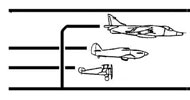A diary of the Sopwith Aviation Company and its products through 1917
The four-year-old Sopwith Aviation Company goes into 1917 as a significant designer and supplier of front line fighter aircraft to both the Royal Naval Air Service and the Royal Flying Corps. Over 400 of the innovative Sopwith ‘1½ Strutters’, ‘Pups’ and ‘Triplanes’ developed during 1916 have already entered service and there are a further 1,600 on order. With demand way outstripping Sopwith’s own manufacturing capacity in Kingston upon Thames most of those are being built by fourteen contractors spread all over the country. The French have also spotted the unique value of Sopwith designs buying an initial batch of ‘Triplanes’ and deciding to build ‘Strutter fighters’ and ‘Strutter bombers’ in France in large numbers, possibly thousands.
In Kingston whilst most of the company’s employees beaver away on existing orders, the Design and Experimental team are already engaged on the next generation of designs. Their first prototype two-gun single-seat ‘F1’ fighter is already under test at Brooklands and they are building at least two more. The first ‘F1’ has a 110hp Clerget but it has been designed around the 130hp engine. They are also developing a 130hp floatplane which, ordered as an ‘Improved Baby’, is evolving into a new type unsurprisingly looking much like the ‘F1’.
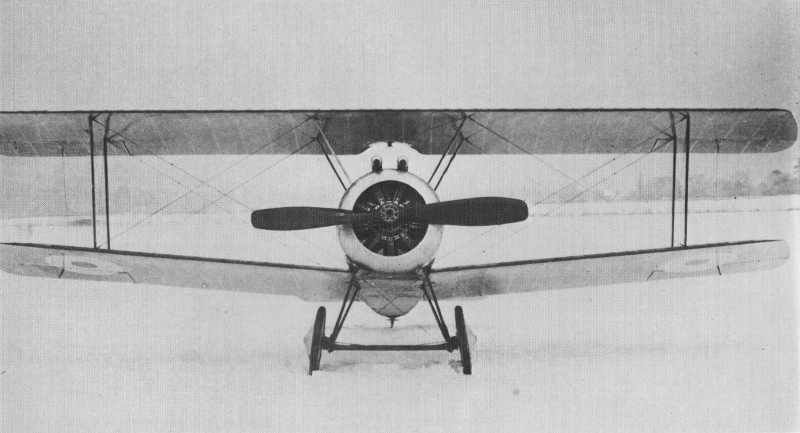
The photographs of the first ‘F1’ in the snow at Brooklands reveal some unique features. The flat one-piece top wing is contrasted by lower wings with considerable dihedral (5ᴼ up-sweep). A very short nose and shortened rear fuselage makes it much squatter than a ‘Pup’. The twin Vickers guns are right at the nose and are partially buried with their ammunition feeds under a hump fairing which is also intended to protect the pilot from the slipsteam. Inevitably with this unique hump it is soon nicknamed ‘Camel’.
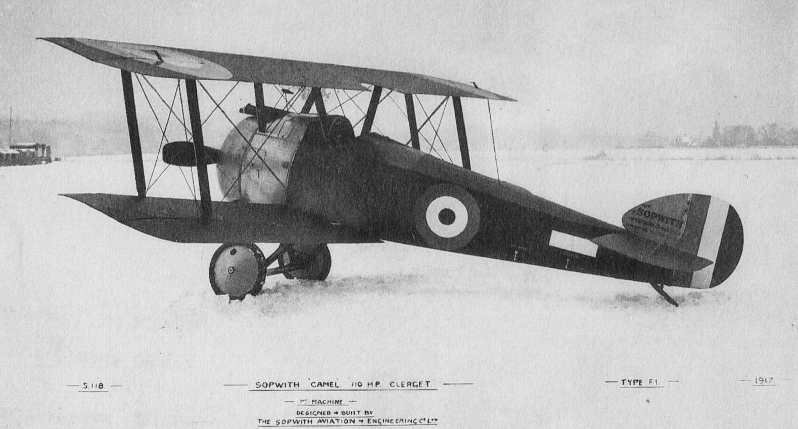
The Admiralty’s Commodore Murray Sueter continues to pursue his vision of transforming naval strategy with aerial torpedo attacks. Well aware of the limitations the large Sopwith and now even larger Short floatplanes developed for that work, he sent a personal letter to Thomas Sopwith on 9th October 1916 marked ‘Most Secret’ requesting “Will you please go into the question, with as little delay as possible re-Torpedo carrying aeroplane with 4 hours fuel and pilot (1) to carry 1×1,000lb locomotive torpedo (2) to carry 2×1,000lb locomotive torpedoes. Aeroplane will probably be discharged by catapult, giving an acceleration of 90ft/sec in 60 feet”. With the design complete the Sopwith experimental team are building a prototype large sturdy 200hp torpedo-carrying biplane alongside their smaller prototypes in the old Roller Skating Rink in Kingston.
On 1st January, almost a month after the RNAS confirmed arrangements are in hand to supply strengthened centre plane struts for all ‘Pups’, the RFC in France is advised by the War Office that “it has been decided to increase the size of the centre-section strut on the 80hp Sopwith to dimensions shown on attached drawings”.
On 2nd January RFC 45 Squadron continues its intensive two-seat ‘1½ Strutter’ training at Ste-Marie-Cappel with twenty-five flights, over twenty-three airborne hours practice at formation flying, four-aircraft formation reconnaissance, gunnery and photography. This training is starting to pay off, nobody broke anything.
On 3rd January the Eastchurch based experimental broader chord wing ‘Triplane’ N5423 fails to return from an altitude test. Fl Lt Johnston is picked up from the sea off Dieppe by a French trawler.
At the first meeting of the newly constituted Air Board on 3rd January President Lord Cowdray gains general agreement that the Air Board should be responsible for selecting the designs of aircraft and seaplanes with their engines and accessories. The Air Board, the Aeronautical Supply Department of the Ministry of Munitions and the Air Executives of the Army and Navy are all to move into the Hotel Cecil on the Strand to ensure the closest possible collaboration.
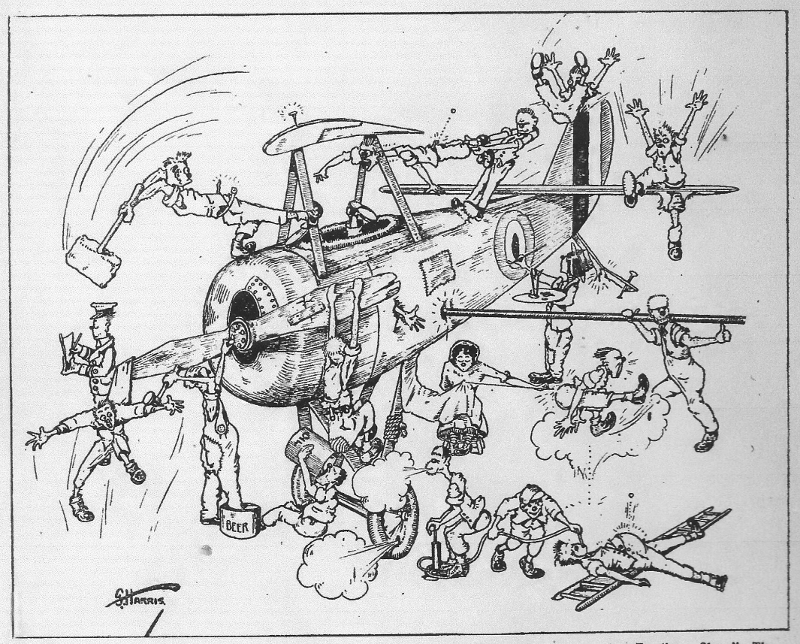
On 3rd January Aeroplane magazine publishes this cartoon “Work in the Erecting Shop” signed by S Harris which it received with a Christmas Greeting “from certain employees of the Sopwith Company”. In the hurly-burly of urgent production the workers and the Sopwith ‘Strutter’ suffer every imaginable mishap. Note an imperturbable fabric lady in their midst and the Admiralty Inspector on the left.
Having completed the first three of their Admiralty order for thirty two-seat Sopwith ‘Strutters’ in December, Mann Egerton is starting to complete the first of 20 single-seat ‘Strutter Bombers’. On 4th January N5204 is accepted at their Norwich factory probably with several others also due to go overseas.
8(Naval) Squadron at Vert Galand is now fully equipped with Sopwith ‘Pups’ but on 4th January Ft Lt Todd in ‘Pup’ N5193 is killed in Manfred von Richthofen’s first tangle with a ‘Pup’ whilst A626 is forced down after combat with seven enemy aircraft. The pilot is taken prisoner and A626 is captured largely intact. (below, unusually without wheel covers and possibly with Leutnant Mallinckrodt who claims the victory)
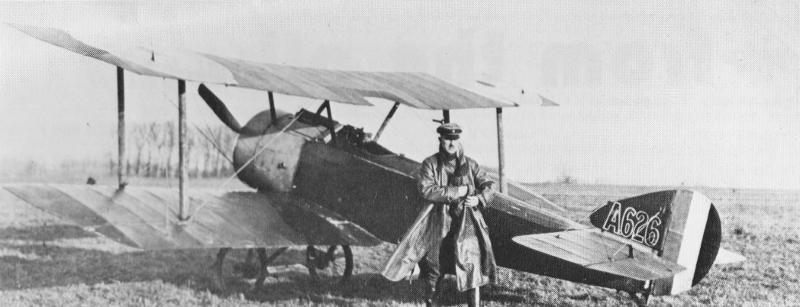
8(Naval) Squadron pilots claimed victories with ‘Pup’ N5194 on 4th January and on 7th January, the same day that pilots of N5198 & N5199 are shot and wounded in combat, N5189 crashes on a delivery flight just short of Vert Galand and RFC 45 Squadron ‘Strutter’ 7793 is wrecked in a forced landing.
Some of the newer Sopwith types are starting to arrive in the minor theatres of war most notably in the Aegean where RNAS 2 Wing has A, B, C and D Flights (now termed Squadrons). The mother-ship HMS Ark Royal is permanently moored by their Mudros main base on the island of Lemnos. B Squadron is at Thermi on the island of Mitylene for anti-submarine patrols and reconnaissance and bombing of Turkish supply routes. C Squadron is on Imbros for reconnaissance and bombing of the Gallipoli Peninsular, the Dardanelles, the Sea of Marmara and the Constantinople railway. Whilst A Squadron on the island of Thasos and D Squadron at Stavros on the coast of Salonika are responsible for reconnaissance and bombing in southern Bulgaria and the lower Struma.
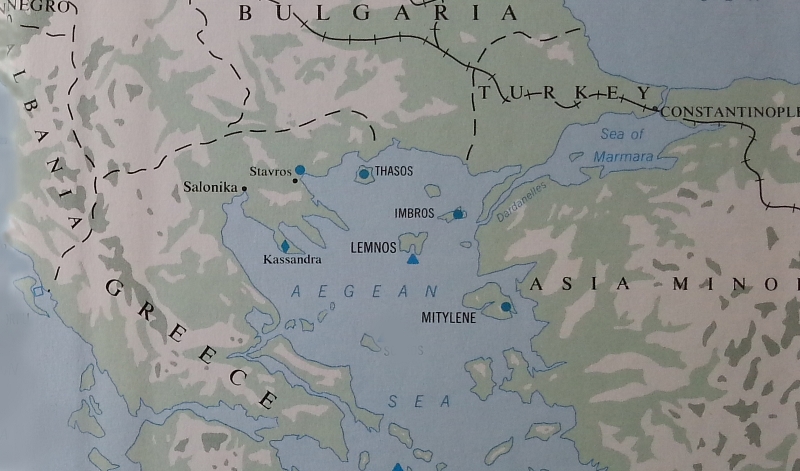
The first new Sopwith machines to arrive are a few single-seat ‘Strutter Bombers’ and two-seat ‘Strutter’ fighter escorts for A Squadron on Thasos. On 9th January N5110 escorted by N5086 flies a hundred miles to aim 4x65lb bombs at the railway station, river bridge and tented encampment at Tatar Bazarjik. Reconnaissance photographs are taken and they return unmolested by aircraft or ground fire. Next time N5086 goes out on reconnaissance they chase a train which stops and troops run out firing at them. They retaliate with their machine gun from 900 ft observing several men dropping before they can take cover.
On 9th January Commander Samson’s favourite Isle of Man steam packet turned seaplane carrier HMS Ben-my-Chree which has done such sterling service with the RNAS East Indies & Egypt Squadron (EI&ES) based at Port Said is hit by shells from 3 miles away on the Turkish mainland whilst in the harbour on Castelorizo the most easterly of the Greek islands. The fourth shell hits the hangar and an intense fire is started fuelled by petrol whilst further 6 inch or 17 pounder shells arrive at six or seven a minute hitting the bridge and underwater. The ship is abandoned after 35 minutes. One Officer and four men are injured but the whole crew reach the shore. Ben-my-Chree burns until the next morning and bomb explosions continue for three more days. ‘Schneider’ floatplanes 3770 and 3778 are got off damaged but repairable whilst ‘Baby’ 8188 is destroyed.
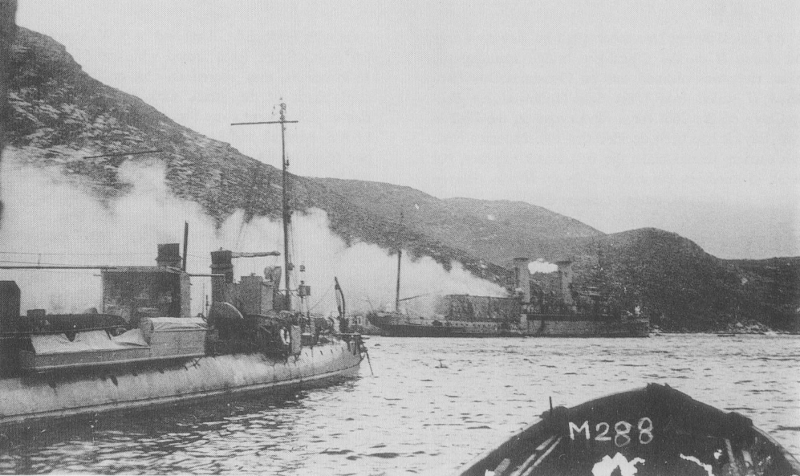
After the wrecking of ‘Schneiders’ 3744 at Yarmouth & 3761 off Westgate last week, there are now just 102 survivors of the 236 ‘Schneider’ and ‘Baby’ floatplanes built by the Sopwith Aviation Company. Ben’s ‘Baby’ is however one of very few that has perished as a direct result of enemy action. There are more machines to come. Blackburn are well underway with orders for 76 ‘Baby’ floatplanes including five for the French Government and the Admiralty has now decided to buy 120 with 130hp Clerget engines in place of 110hp. Blackburn are expecting an order for 40 this month whilst 80 are being ordered from Fairey Aviation and their contractor Parnall with the Fairey variable camber wings. For familiarisation with ‘Baby’ airframe construction Sopwith-built 8194 is being sent to long-established shopfitters & cabinet makers George Parnall & Sons Ltd. who are building Avro 504s in Bristol. Their aircraft erecting shop is in the Coliseum skating rink in Park Row.
On 10 January Sqdn Ldr Cave-Brown-Cave flies Beardmore-modified ‘Pup’ 9497 with its arrester hook off the dummy ship’s deck at RNAS Grain but the machine is to be dismantled and packed off back to Beardmore.
Meanwhile at Beardmore another Pup, taken from the production line and allocated the out of sequence serial number 9950, is being experimentally extensively modified for ease of shipboard stowage.
Aimed at replacing the ‘Baby’ floatplanes on HMS Campania, Beardmore have been working on this ‘Aeroplane Folding Scout S.B.3d Type for some months with help from the Sopwith design team. S.B. stands for Sopwith-Beardmore.
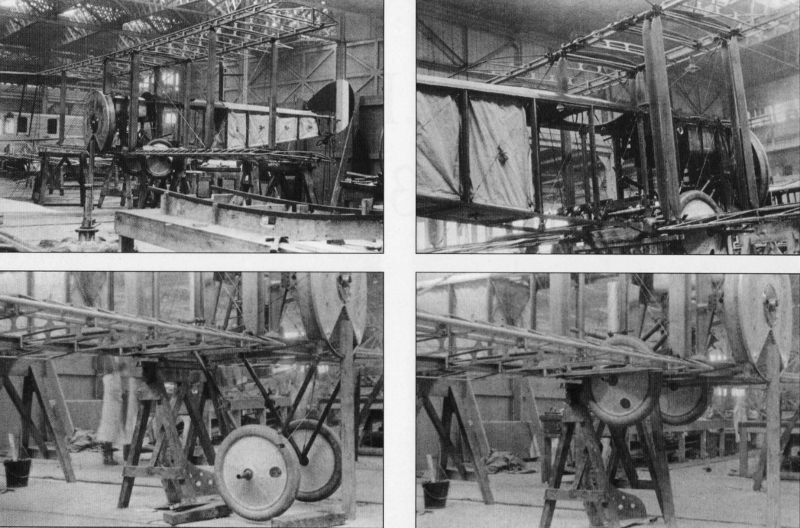
The photographs (above) show it to have un-staggered wings with extra paired interplane struts close to the fuselage to support the wing when folded back along the fuselage, an undercarriage which can be retracted to reduce the height for below-deck storage and air filled flotation bags down the rear fuselage to keep it afloat whilst it is recovered from the sea alongside the ship.
Six days ago the War Office issued an instruction to renumber twelve ‘Pups’ of 8(Naval) Squadron as RFC A6681 to A6692. On 10th January having realised that they do not belong to the Army the instruction is cancelled.
It seems there is no established procedure for telling the operators in France about modifications being incorporated in new build aircraft. On 12th January Officer Commanding 5th Army Air Park writes that more than half of 8(Naval) Squadron ‘Pups’ have variable incidence tailplanes and the necessary fin and the remainder have fixed tailplanes but the Navy Supply Depot are unable to supply spares for fixed tailplane machines. As a result he has started modifying variable incidence parts as spares for fixed tailplane machines. This immediately causes OC No.2 Aircraft Depot to write to RFC Headquarters in France to say it had not been realised that two types of tailplanes exist. They send a terse memorandum to the War Office in London asking which is to be standard. In fact all Pups are by now being built with the simpler fixed tailplanes.
On 14th January Dover based ‘Baby’ 8195 is crashed and wrecked on take-off from the English Channel.
On 14th January at St Pol, Quartier-Maître Le Garrec making his first flight in a Sopwith ‘Triplane’ takes off in No.4 with the tail too high. The propeller clips the ground and shatters throwing the aircraft several metres through the air before landing on its nose and destroying the undercarriage. (below)
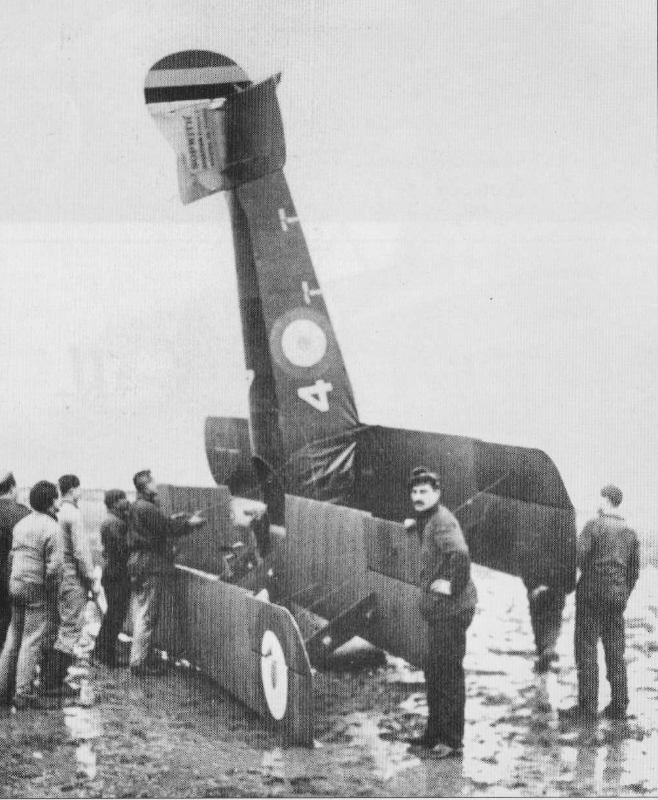
Le Lieutenant de Vaisseau de Laborde requests a replacement machine and does not have to wait long as the next day the fifth of the ten French ‘Triplanes’ ordered on Sopwith in August is delivered to St Pol where they fit Vickers guns and Alkan-Hamy or Scarff-Dibovsky synchronisation gear. British Sopwith ‘Pups’ and ‘Triplanes’ are now normally being fitted with Sopwith-Kauper gun synchronisation gear.
On 15th January RFC 54 Squadron ‘Pup’ is shot down on escort duty and the pilot killed whilst A644 suffers engine failure at 600ft and forced lands in a small field losing its undercarriage on a fence.
Strategic bombing raids by RNAS 3 Wing’s ‘1½ Strutters’ are being hampered by lack of men, machines and spares. Captain Elder has loaned machines to the French and is having to send his best pilots to the ‘Pup’ and ‘Triplane’ naval squadrons forming to support the RFC on the Western Front. Determined to press-on he writes to the Admiralty on 15th January “The shortage of engines and more than anything else the shortage of engine spare parts to put the engines I have in running order is chronic. Cannot something be done to supply the few necessary spare parts so that the material that is already available at least can be used. I am continually having rubbed into me by the French the benefit of this Wing and the necessity of largely increasing it”.
In October 1916 the first fifteen French-built Sopwith ‘1½ Strutters’ were operational, mostly with the bomber group at Luxeuil alongside those loaned by RNAS 3 Wing. At least two more Escadrilles, Sop29 and Sop123, are now fully equipped with French-built ‘Strutters’. Many more are on their way with orders for up to six hundred each being built by Amiot-S.E.C.M. in Colombes, Bessoneau in Angers, Hanroit in Billancourt, Loure et Olivier in Levallois-Perret, R.E.P. in Lyon and Sarazin Freres in Puteaux.
Following last week’s cartoon of work in the Sopwith aircraft erecting shop, Aeroplane magazine publishes this sequel also by S Harris depicting the perils of testing an engine.
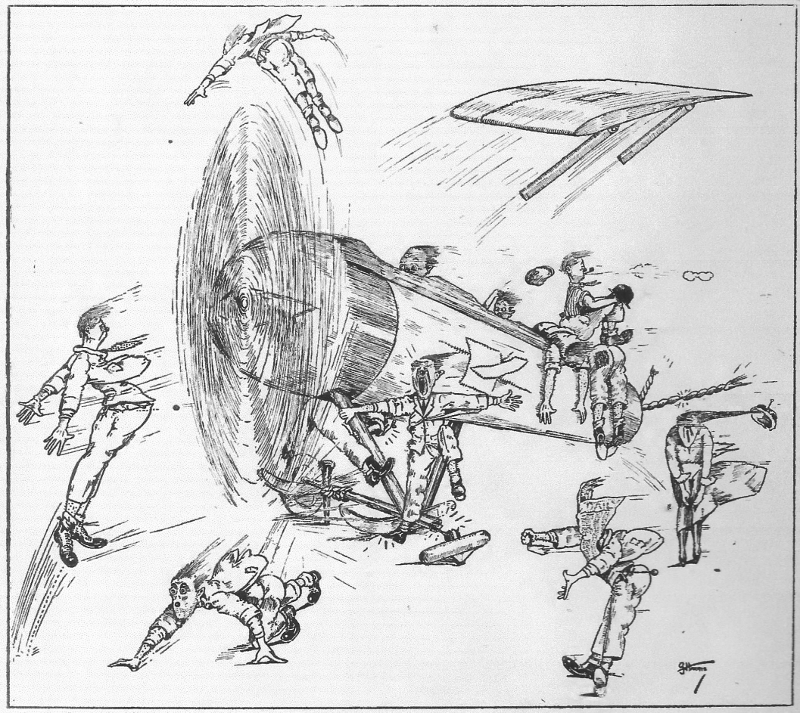
On 17th January three months behind the original plan as most of his trained crews had been diverted to squadrons already at the front, Major Sholto Douglas starts deploying his first command RFC 43 Squadron and its Sopwith ‘Strutters’ from Northolt to France. The first machine away stalls and crashes on take-off killing both crew. Then the weather breaks forcing one flight to fly down the Thames passing RFC Headquarters at Adastral House near Blackfriars Bridge below the height of the top floor windows. The squadron stops overnight at Lympne before crossing to St Omer and then flying ten miles south to their new base at Treizennes. They sleep on the floor of empty cold huts in snow and bitter cold. The weather has been like this over northern France for the last ten days severely restricting any flying.
On 18th January RFC ‘Strutters’ 7801 and A896 are wrecked at Castle Bromwich and North Camp Station.
On 21st January RNAS Grain based ‘Schneider’ floatplane 3756 is crashed and wrecked.
On 22nd January Ft Cdr Dallas, with an experimental oxygen set, takes ‘Triplane’ N5436 to 26,000ft but gets “drunk on the oxygen, hardly able to recognise the country beneath” and is badly frost bitten coming down. This is a height record for a Sopwith ‘Triplane’.
On 23rd January Sopwith ‘Triplane’ N5440 is delivered to RNAS Eastchurch with tailplane and elevators 2ft 1in shorter in span than the original ‘Pup’ type surfaces. These are intended to improve control response and allow the machines to be dived vertically with greater ease. Eastchurch reports: “The decrease in horizontal tail area has resulted in making the machine much more handy. The fore-and-aft stability is not so good but there is sufficient control to get the machine out of any position whilst fighting. The alteration has improved the machine from a war point of view.” All machines are to have the new tailplanes as they come available.
Sopwith’s Canbury Park Road factory in Kingston, still building ‘Strutters’ and ‘Pups’, is now in full flow with ‘Triplane’ production.(below) They are on plan to deliver sixteen to Brooklands this month and two more French machines without engines to Dover, a significant addition to the twenty-seven previously built.
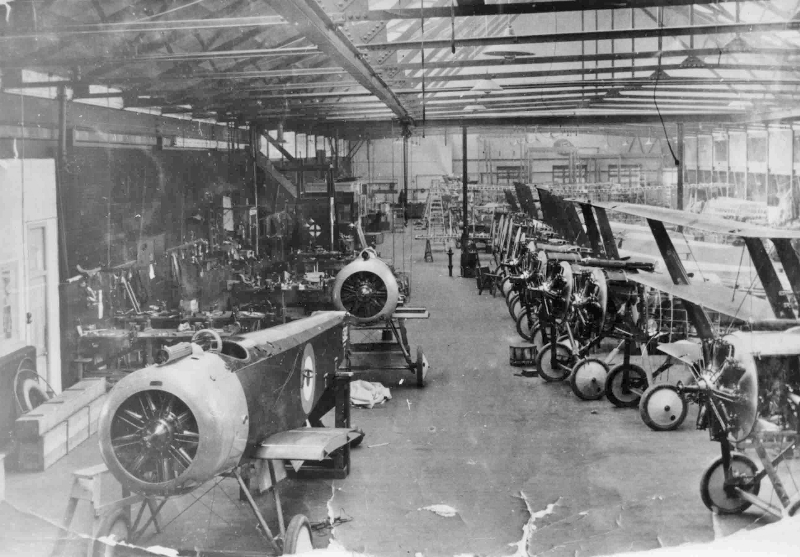
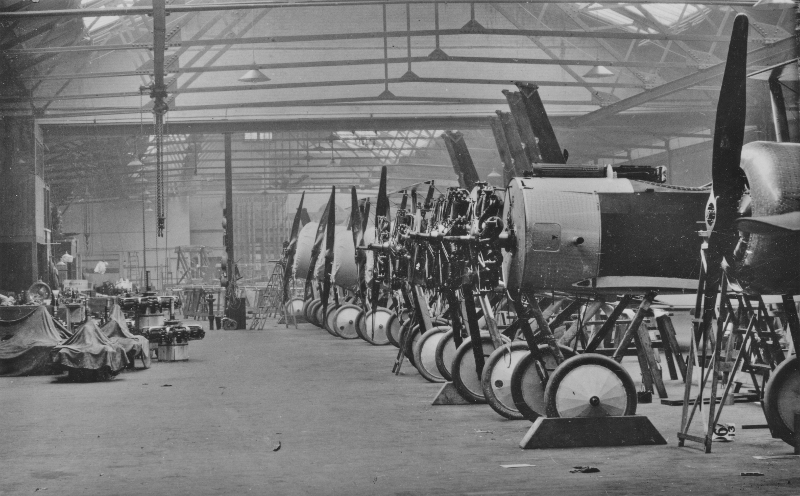
On 23rd January whilst RNAS 5 Wing ‘Strutters’ are out practising formation flying despite twelve degrees of frost, RFC 45 Squadron ‘Strutters’ have their first major engagement for three months. ‘Strutter’ A1078 is shot down killing both crew, the observer in 7792 is wounded in the leg whilst A1083 claims an Albatross sent down and two other enemy aircraft are damaged. The fourteen aircraft which fly include two formations of four making a first attempt at oblique camera photo reconnaissance but they are thwarted by the weather.
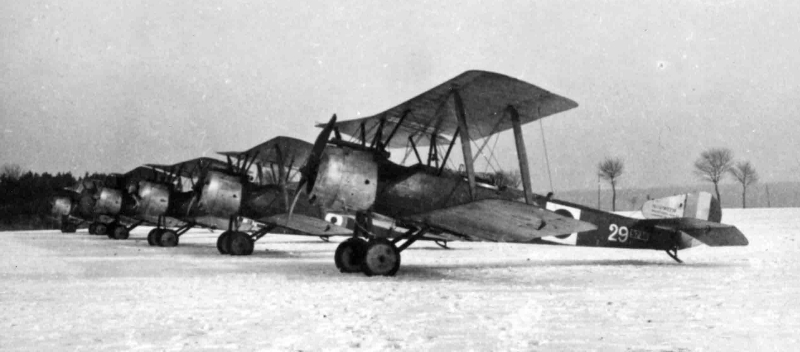
It has also been snowing further south at Ochey and Luxeuil, (above) but in the frigid cold on 23rd January thirty-two 3 Wing ‘Strutters’ set out to raid the Burbach blast furnaces. There is great difficulty starting the engines, there are accidents on the ground and many of those who do get airborne suffer engine failures or find difficulty in picking up their formation positions in the recently reorganised flights. Ten bombers reach the target escorted by five two-seat “Strutters” who fight off four enemy aircraft one of which is shot down. One of the bombers also claims a victory. In N5121 Fl Sub Lt Stevens thinks he has released his four 65lb bombs but one still hangs out of the rear left hand bomb door jamming it partially open. After landing Stevens gets out and attempts to free the bomb. Remarking to a mechanic that “it will need a crowbar to shift it”, he restarts the engine and taxis towards the hangar but the vibration is enough to loosen the bomb, which strikes the hard frosted soil and explodes with a blinding flash. Stevens is seriously injured with bomb splinters in his left leg and burns to his face, two mechanics are killed and an officer and three other mechanics are seriously wounded some of them apparently by bullets.
On 23rd January 8(Naval) Squadron ‘Pup’ pilots of N5181 and N5197 both claim aircraft shot down whilst the pilot in N5186 claims a two-seater down before he himself is shot down and injured.
On 24th January 8(Naval) Sqdn ‘Pup’ N5198 is shot down killing the pilot, 43 Sqdn ‘Strutter’ A2392 wrecked in a crash killing both occupants and 70 Sqdn ‘Strutter’ A1515 is wrecked in a forced landing whilst on photo escort.
Since Basil Watson’s first distance flight in his homebuilt Sopwith ‘Sparrow’ on 29th November he has made others and been giving flying displays. On 24th January he flies the machine from Point Cook, Melbourne 166 miles to Warrnambool in 5 minutes under two hours. The Warrnambool Standard reports this as a record non-stop cross-country flight for Australia, the first aeroplane ever to visit this part of the Commonwealth and the first airmail service to Warrnambool. Basil delivers three letters to the Mayor who greets him at the racecourse after he has circled over the town to give people a chance to see his machine. A letter from the Mayor of Melbourne concludes “I hope when this cruel war is over and victory crowns our efforts, we, all over the Commonwealth, will be able to fly from one State to the other”. Basil is to “loop the loop and perform other outstanding feats” in a flying display at the racecourse on Saturday.
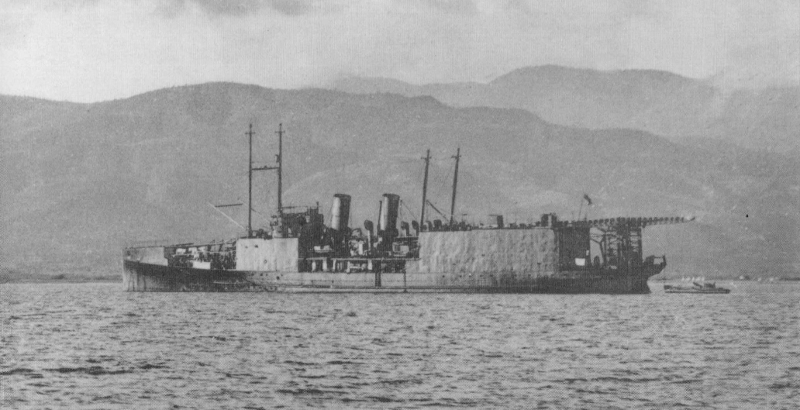
Another Isle of Man steam packet HMS Manxman (above) was commissioned last month as a seaplane carrier with a small forward hangar for two fast-response ‘Baby’ floatplanes using the short sloping bow ramp and a hoisting crane behind the larger stern hangar for big Short floatplanes. Fl Lt Rutland, often tagged ‘Rutland of Jutland’ as the only pilot to take any significant part in the Battle of Jutland, has consistently argued that only wheeled aeroplanes can hope to fly high enough and fast enough to attack a Zeppelin airship at its ceiling and that they should be flown from ships preferably with 600ft flush decks. As Manxman’s senior flying officer he has to make do for now with a 60ft foredeck ramp and makes two flights confirming that it requires a strong wind along the deck for a Sopwith ‘Baby’ on a wheeled trolley to become airborne. His view that Sopwith ‘Pups’ are a better proposition has been conceded and ‘Pups’ are soon to replace the ‘Baby’ floatplanes on HMS Manxman and HMS Campania despite the need to ditch in the sea and float long enough to be hoisted back aboard the ship.
After the bomb explosion at Ochey two days ago, twenty-two test drops have resulted in two bomb jams. On 25th January a Court of Enquiry hears evidence from witnesses of the accident and finds that the cause was the bomb jamming after being released allowing the arming vane to unscrew from the spindle making the bomb dangerous and free to function. The probable cause of the jam being the different type of rear bomb doors fitted on these Westland-built ‘Strutter Bombers’. “No blame is attributed to anyone for the bomb jamming but the accident might have been prevented if the pilot had reported the condition of the bomb before taxying his machine in.” It seems that the strengthening recesses stamped into the doors can lead to “an unequal fall of the bomb” as it pushes them open and a bomb fin getting jammed inside the bomb bay. It is recommended that the longerons are packed to allow these doors to lie flush and need no strengthening projections, recesses or cutaway portions. The underside of the stamped recesses can be seen on the open rear bomb door of 3 Wing ‘Strutter Bomber’ N5116. (below)
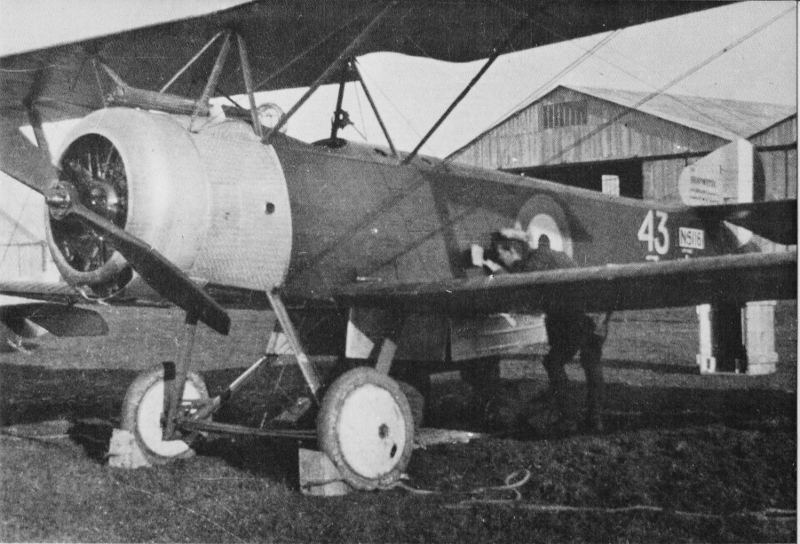
Interesting additions to the facilities at Brooklands are a pair of Bessonneau wooden-girder canvas covered portable hangars in front of the original Sopwith sheds in these recent images. (below) The aircraft appears to be Sopwith-built ‘Strutter Bomber’ N5112 back from Eastchurch before going off to 3 Wing at Luxeuil. Note the tail of a prototype ‘F1’ Camel sticking out of the Sopwith shed with the Byfleet footbridge behind and the 1915 Type RFC hangar and bell tents in front of the farmhouse.
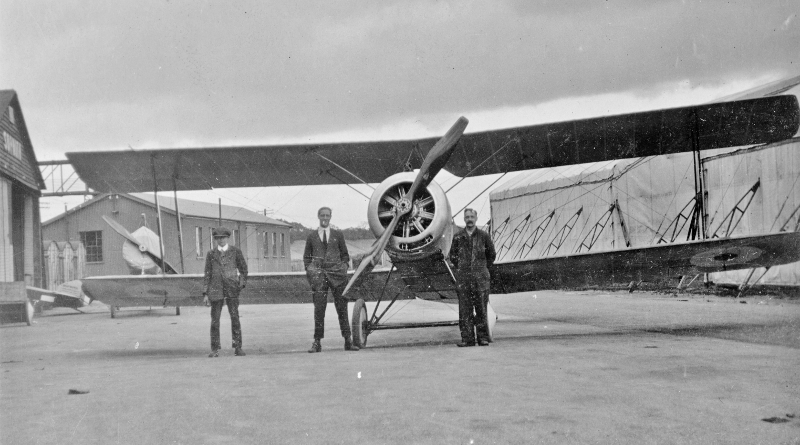
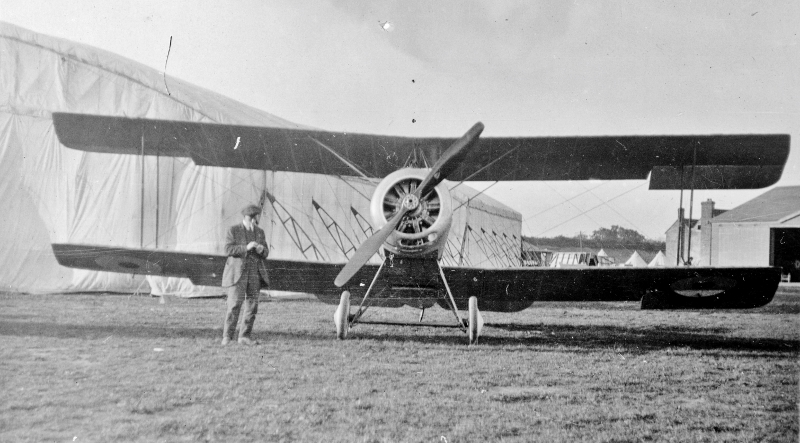
Bessonneau have not been able to keep up with the demand for their hangars in France let alone overseas but licensed manufacture of frames and canvas covers is now underway in Britain.
On 25th January Capt Lees in ‘Pup’ A635 achieves RFC 54 Squadron’s first victory, an Albatross DII destroyed.
On 26th January 45 Squadron ‘Strutter’ A1074 is shot down in flames killing both crew and 8(Naval) Squadron ‘Pup’ N5181, also on photo escort duty, is wrecked in a forced landing after damage in combat.
On 26th January the Sopwith Board Meeting seals a patent application for “improvements in means for synchronizing the firing of a gun with the rotation of the propeller” clearly associated with the Sopwith-Kauper gear and records that “Mr Sopwith having been requested by the Italian Government to allow them to build the old type Schneider Cup seaplanes, it was resolved that the plans should be handed over to Mr Sopwith to dispose of as he thinks fit”.
On 27th January I (Naval) Sqdn ‘Triplane’ N5436 claims a victory as does RFC 54 Sqdn ‘Pup’ A652 sending a two-seater into a spinning dive, the right hand top plane comes off. That day 45 Sqdn ‘Strutter’ A1076 crashes on take-off and 70 Sqdn A1922 crashes trying to avoid another machine when landing.
On 27th January the first Sopwith ‘Pup’ built by Whitehead Aircraft A6150, after trial assembly at their factory in Richmond upon Thames (below), is delivered to Farnborough for acceptance tests. The following day Whitehead ‘Pup’ A6151 arrives for a thorough quality check by the Aircraft Inspection Department (AID).
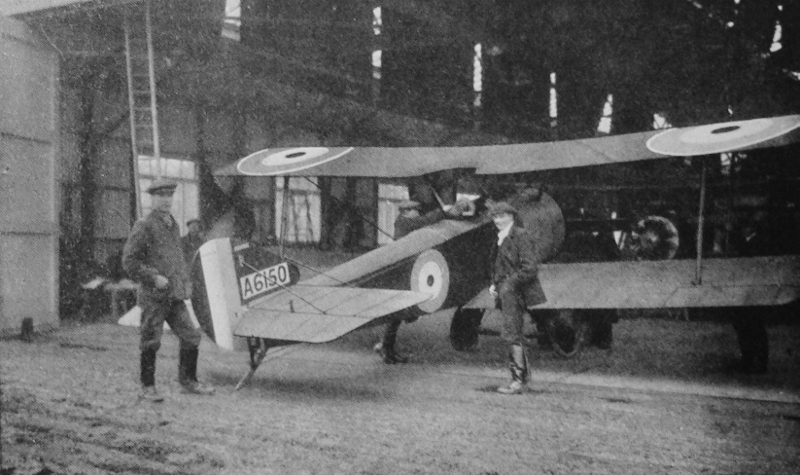
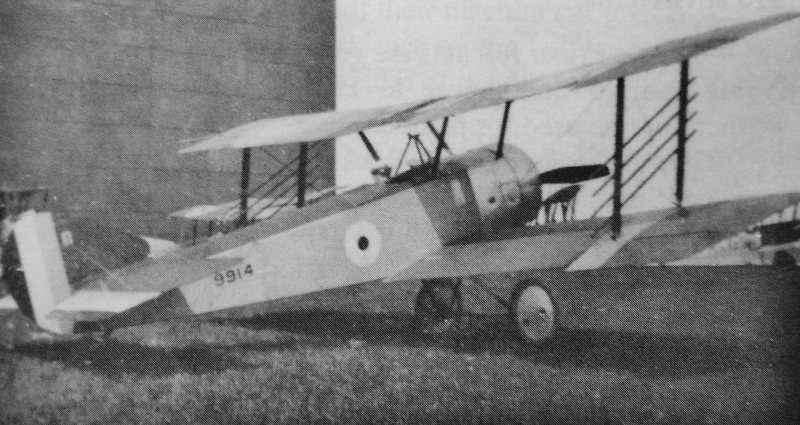
On 28th January 9914 is the second Beardmore-built ‘Pup’ to arrive at East Fortune this week (above) for service on HMS Manxman. Especially adapted for Zeppelin interception they have sheet metal protection on the wing surface behind the rocket rails and, in place of the Vickers gun, a tripod in front of the pilot for a Lewis gun firing up through the top wing aperture. They have the distinctive Beardmore tricolour striped elevators.
On 28th January a cylinder bursts on 45 Sqdn ‘Strutter’ A1071 as it is running up and flies off damaging 7780. 7788 damages its undercarriage on landing and the next day is wrecked in a forced landing after engine failure whilst three give chase to an enemy aircraft and get some rounds fired despite guns jamming, one pilot using the locally improvised “window in the top plane” to position his aircraft ideally for the rear gunner.
On 29th January six RNAS 5 Wing ‘Strutters’ leave Coudekerque in crystal clear weather to raid hostile shipping but as far as Ostend see nothing except frozen foam along the beach and way out to sea after four nights with temperatures as low as 22 degrees of frost. Bitterly cold at 12,000ft they turn and after five minutes driven by the raging easterly wind almost bomb their own destroyers before realising they are already off Malo.
On 30th January 54 Sqdn ‘Pup’ A640 crashes landing in a ploughed field after an engine failure.
On 31st January the French Minister for War writes to the British Aviation Supplies Depot in Paris thanking “the British Naval Aviation for putting an 80hp Sopwith at my disposal for examination and study. It has been decided it would not be suitable for the French Aviation to organize the manufacture of machines of this type at present. I will despatch it at once to the destination you desire”. (There is no known identity for this ‘Pup’)
On 31st January 8(Naval) Sqdn is withdrawn from Vert Galand to regroup and re-equip with Sopwith ‘Triplanes’. Since 26th October they have shot down 20 enemy aircraft but more crucially have played their part in keeping most enemy aircraft away from the battlefields allowing the RFC to continue their photo reconnaissance and artillery direction work relatively unmolested.
Commodore Murray Sueter’s proposals for floatplane torpedo attacks on the German Fleet at Wilhelmshaven are not thought likely to succeed but he is now put in command of a force based at Otranto on the heel of Italy to attack the Austrian Fleet at Pola and other naval targets in the Adriatic. In addition to 310hp Short Torpedo floatplanes he will have Sopwith “Strutters” as escort fighters with Short and Sopwith “Baby” floatplanes for work along the barrage protecting allied fleets in Otranto from enemy U-boats. Without Sueter’s direct support the Sopwith team stop further work on their experimental 200hp “T1” torpedo landplane and store the part completed fuselage in the factory roof.
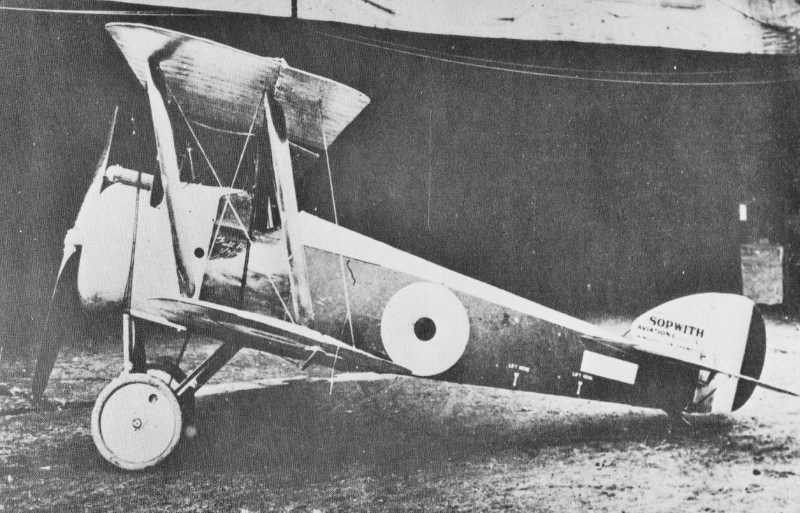
Development flying of the ‘F1’ Camel prototype continues at Brooklands. It apparently now has an cut-out in the centre of the top wing, possibly to compensate for the small rudder or tail-heaviness. (above) There are other ‘F1’ Camel prototypes under construction but by the end of January the Admiralty are so impressed by the potential of the design that they have already given Sopwith Aviation a production order for fifty machines. Other new orders in January have been 50 ‘Pups’ and 20 ‘Triplanes’ on Sopwith, another 50 ‘Strutters’ on Vickers, 40 ‘Baby’ floatplanes on Blackburn and 80 camber-wing ‘Baby’ floatplanes on Fairey and their contractor Parnall.
Sopwith has completed a record 52 new aeroplanes in January whilst overall production of Sopwith machines in the month has exceeded 160 easily beating last month’s record 97. That total includes 41 ‘Pups’: 16 from Sopwith, 23 from Standard Motors and 2 from Whitehead. Of the 101 new ‘Strutters’ 18 were from Sopwith (all bombers), 9 from Fairey, 14 from Mann Egerton (7 each fighters and bombers), 26 from Ruston Proctor, 22 from Vickers and 12 bombers from Westland. Sopwith also completed 18 ‘Triplanes’ including 4 for the French Navy whilst Blackburn delivered five or more ‘Baby’ floatplanes.
Ruston Proctor have recorded “Nieuport gun ring removed” against many of the “Strutters” delivered this month. The RFC might at last be getting better supplies of their much preferred Scarff gun rings.
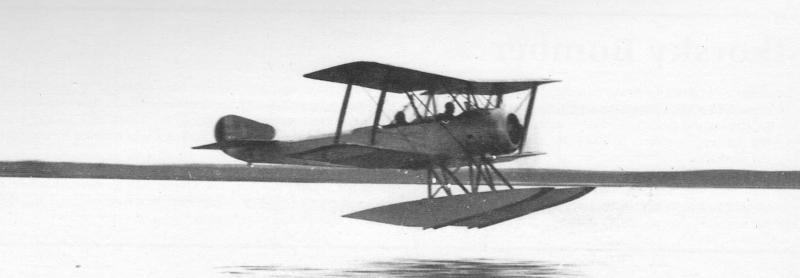
Strutters’ are the latest Sopwith type to appear as a floatplane. In mid January, the French Hanroit aircraft company delivered the first of seventeen it is building for the French Navy. (above)
From 1st February 1917 German U-boat commanders are permitted to wage unrestricted warfare. The plan to block Britain’s supplies of food and material from around the world is made easier by the discovery that the English Channel is not as well defended against submarine movements as they thought and they no longer have to go round the north of Scotland to get into the Atlantic. There are 49 U-boats based in North German ports and 33 in Belgian ports up to a third of which could be active at any time. Sopwith ‘Baby’ floatplanes and ‘Strutters’ are regular workhorses in RNAS Dover and Dunkirk’s work detecting and restricting U-boat movements and attacking Belgian port installation. On 1st February 1(N)Squadron ‘Strutter’ 9417 from St Pol photographs ammunition stores along the Bruges canal and U-boats in the harbour.
There is still only one RFC ‘Pup’ squadron in France but on 1st February the RFC gain the command of 3(Naval)Squadron when it officially replaces 8(N)Sqdn at Vert Galand. The English and Canadian pilots with an Australian, a New Zealander and an Irishman inherit twenty-one of 8(N)Sqdn’s ‘Pups’ but “many are verging on the worn-out”. That first day 3(N)Sqdn ‘Pup’ N6161 is shot down and captured with the pilot taken prisoner.
Elsewhere on 1st February Australian R S Dallas claims his third ‘Triplane’ victory downing an LVG in 1(N)Squadron’s N5436 whilst 2(N)Squadron ‘Strutter’ 9417 claims a two-seater down in smoke and RFC 45 Squadron’s A1072 suffers a seized engine and forced landing.
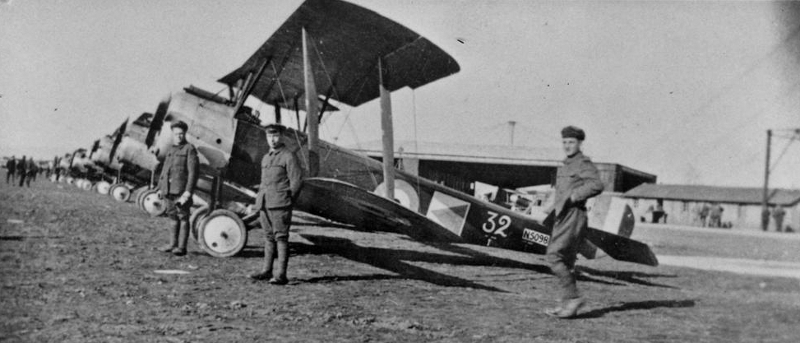
On 1st February RNAS 3 Wing in south-east France has a hundred aircraft, (above) 94 of them Sopwith types but only 34 are serviceable and the standard Type 9400S ‘Strutter’ fighters with a 37 gallon 275 mile range are of limited use even when based closest to enemy territory at Ochey. The priority has to be keeping the few Type 9400L long-range ‘Strutter’ fighters serviceable with their 57½ gallon 362 mile range for escorting the bombing missions of the 54 gallon 372 mile range Type 9700 ‘Strutter Bombers’. The unreliability and short life of the Clerget engines in their ‘Strutters’ is forcing 3 Wing to accept a squadron of inferior but more reliably engined American Curtiss R2s. They are however due to be amongst the first to get the huge Handley-Page 0/100 twin-engined strategic bomber.
On 2nd February 8(N)Squadron ‘Pup’ N5191 is shot down and the pilot killed.
It appears that Sopwith’s January output of eighteen ‘Triplanes’ included not two but four French machines delivered to Dover. Two of those now have their French engines installed, one was flown to St Pol last week, the seventh of the ten on order arrives there on 2nd February. Marked F7 & F9 they are actually SP.13 & SP.14. On 3rd February three French ‘Triplanes’ attack a large biplane over Ypres without a conclusive result.
On 3rd February in Australia Basil Watson flies his homebuilt Sopwith ‘Sparrow’ from Warrambool to Hamilton before giving a flying exhibition at the Show Ground. In unfavourable strong southerly winds he takes off in 50 yards and circles up to 4,000ft for a 25 minute display of “perpendicular diving and climbing, speed flights, somersaulting and rapid turning with the machine side on”. Taxying to park after landing, the propeller hits a hidden post lying in the long grass and is badly damaged.
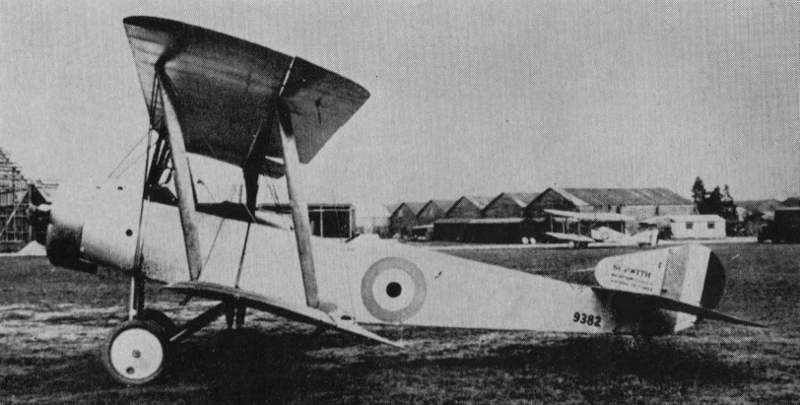
At 4.45am on 3rd February eight “Strutters” of RNAS 5 Wing, now 4 & 5(Naval)Squadrons, attempt to leave Coudekerque to bomb Bruges Docks and its U-boats. Veteran ‘Strutter’ 9382 (above) is one of only two machines to reach Bruges. The intense cold has frozen the “castor oil to a tallow consistency”, engines will not pull or fail altogether. One ‘Strutter’ crashes through two stout willow trees and the pilot walks away from “not much more than a pile of matchwood”. Another machine lands on the beach and, caught by the tide, is floating nearly vertically in 8ft of water before it is towed in but becomes stuck fast in the sand. Despite the efforts of 30 or 40 French soldiers to haul it out, they have to wait for the tide to recede to disarm it and dig it out.
On 4th February Dover-based ‘Baby’ floatplane 9405 “falls into the sea” and 7(N)Squadron ‘Strutter’ N5505 is crashed. Both are recorded “beyond repair”.
The second Whitehead-built ‘Pup’ A6151 has passed its inspection by a Sopwith team and the Government AID at Farnborough has been flown to Filton where RFC 66 Squadron is forming. It is joined in the snow there on 5th February by Standard Motors-built ‘Pups’ A663 & A674. (below)
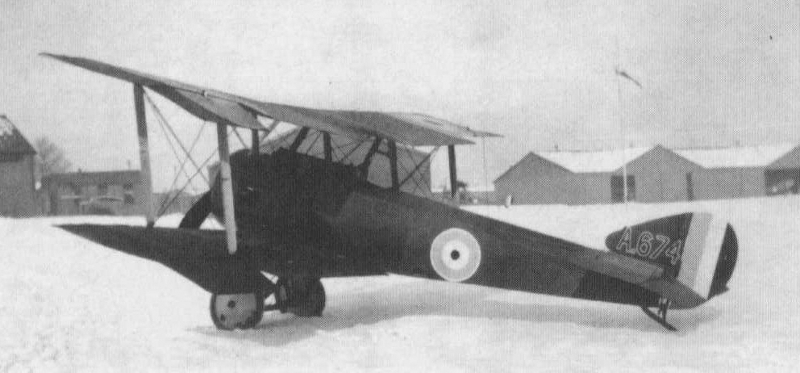
On 6th February RFC 45 Squadron are finally authorised to fly their ‘Strutters’ over the lines on the Western Front. On that day the clock in A1084 is reported to have indicated 160mph in a steep pursuing dive before expending all their ammunition and returning through a barrage of anti-aircraft fire. Like 70 Squadron, their role in the Headquarters Army Wing is to provide a permanent defensive umbrella for the Corps Wings’ vulnerable observation aircraft which are working directly with specific army units on the ground. Typically in formations of two or four aircraft at heights of 8 to 10,000 ft 45Sqdn undertake line patrols directly over the trenches, defensive patrols 4 or 5 miles behind the German Lines and offensive patrols some 8 miles beyond that. Any of these can include photo reconnaissance. On 7th February a five aircraft photographic patrol at 10,000ft ends after two of four “very fast” enemy single-seaters are sent down whilst ‘Strutter’ 7789 plunges to earth with the wings folded up with fatal consequences for the crew.
On 7th February, after six inches of snow at Coudekerque in recent days, five 4 & 5(N)Squadron “Strutter bombers” with two ‘Strutter’ escorts bomb Bruges harbour whilst 1(N)Squadron’s N5172 photographs German warships for the first time in the Darse. ‘Strutter’ N5102 is shot down killing both crew and the aircraft is captured. On 8th February they make another shipping raid despite their ground speed reduced to 40 mph by easterly winds and on 9th February nine more set out to raid Ghistelles aerodrome, five actually getting there.
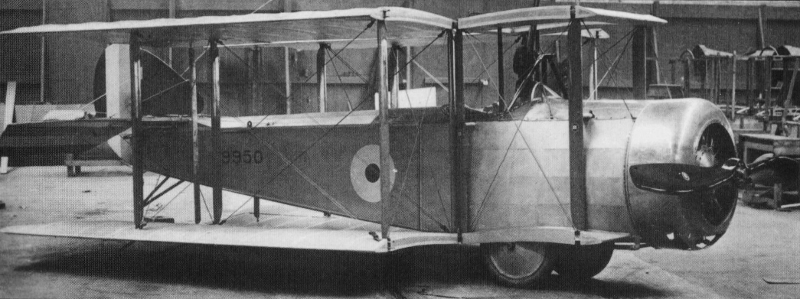
Beardmore-built SBIII prototype 9950 arrived at Eastchurch by rail from Glasgow on 2nd February. Despite the Sopwith ‘Pup’ fuselage it makes an unusual sight with its un-staggered folding wings and tucked up undercarriage. (above and below) Its extra weight precludes the carrying of rockets but it has the upward firing Lewis gun tripod in front of the pilot. On 7th February it is flown at Eastchurch for the first time by Sqdn Cmdr Busteed.
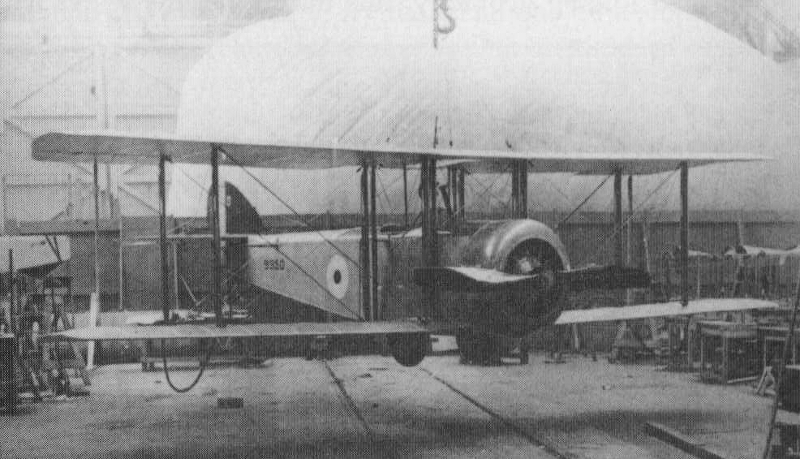
In the first week of unrestricted warfare German U-boats sink thirty-five vessels in the Channel and Western Approaches forcing the Navy to consider stationing more aircraft along the south coast to tackle this menace.
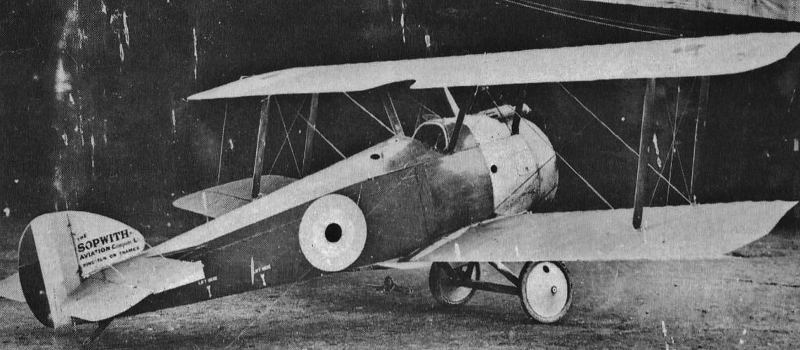
What is believed to be the second ‘F1 Camel’ prototype is photographed (above) looking very like the first but with a 130hp Clerget engine, a less steeply sloped hump and a small windscreen. It has no cut-out yet in the one-piece top wing and small square side panels to access the rear of the engine. The Sopwith experimental team are busy building more prototypes in the Skating Rink. Following closely behind this second ‘F1 Camel’ prototype are at least three more and the two similar ‘FS1 Improved Baby’ floatplanes ordered by the Admiralty in late December.
The issues with the Council over wall thicknesses, fire escapes, drains and acetylene workshops in the Sopwith factory extensions appear to be resolved as the third extension is occupied and construction of the fourth is underway including the three story offices on the corner of Canbury Park Road and Elm Crescent. However on 8th February a letter from the Kingston Borough Surveyor calls Sopwith’s attention to “the building erected along the forecourt of the third factory extension in Elm Grove which is in front of the building line and which is contrary to the building regulations and Act of Parliament”. The reply the next day from Company Secretary Musgrove simply states “We have been compelled to erect this on account of new War Office and Admiralty orders for the storage of ‘dope’ in a certain temperature which had to be carried out immediately”.
On 8th February 5(N)Squadron ‘Strutter’ 9385 is wrecked.
On 9th February 45 Squadron ‘Strutters’ on a photographic sortie get into a spirited fight. The pilot of A1084 with guns jammed desperately throws it into a loop but half of the tailplane collapses. With a gun un-jammed they pepper the pursuer who breaks off apparently badly damaged and survive to nurse their machine back over the lines to a crash landing. The machine has logged 68 flying hours and is “not worth reconstruction”.
On 9th February an Air Board conference concludes that a monthly output of 80 ‘Pups’ will be required. It views with concern that the record month of January still produced less than 50 and notes that Sopwith are expected in a few months to supplant ‘Pup’ production with ‘F1 Camels’ which will leave only Beardmore, Standard Motors and the fledgling Whitehead Company as ‘Pup’ suppliers.
On 10th February 43 Squadron ‘Strutter’ A1107 crashes with an injured pilot after being hit by AA fire, the crew of A2386 are both wounded in combat with seven enemy machines whilst A2388 glides back to safety with a shot-up engine but the observer dies of his wounds. ‘Strutter’ A2399 suffers an engine failure on delivery to 43 Squadron running into a ditch to be deleted after just five flying hours whilst veteran 5(N)Squadron ‘Strutter’ 9383 is crashed and also damaged beyond repair.
On 10th & 11th February ‘Baby’ floatplane 8150 goes out from Great Yarmouth after reports of enemy U-Boats as does 8150 from Dunkirk. The oddly-numbered Blackburn-built ‘Baby’ N300 joins others on HMS Campania.
On 11th February 54 Squadron ‘Pup’ A639 shoots an Albatross C which is last seen in a nose dive whilst A642 forces down a two-seater. The engine cowl of ‘Strutter’ N5090 comes off in flight and they make a forced landing in a ploughed field. The long-established patented Sopwith method of attaching cowls using an external wire clamping ring in interlocking groves around the fuselage and the cowl is very practical and has been much copied but some units are fitting additional external clips from the fuselage to the cowl. The aircraft depots in France are not just modifying ‘Strutters’ to improve the performance by fitting some with 130hp Clergets. They are about to test an alternative interrupter gear designed by Captain Ross of 70 Squadron. Recent trials with a smaller 12ft span tailplane to improve agility gave sluggish control and difficulties in recovering from dives. Also proving unsuccessful are current 46 Squadron trials with a ‘Strutter’ fitted out for artillery observation.
On 12th February two C Squadron ‘Strutters’ of RNAS 2 Wing from Imbros in the Aegean escorting a Henri Farman F27 on an anti-submarine patrol up the Dardanelles are caught in a surprise attacked by a Fokker Eindekker which they chase away but it manages to fire at the Farman which is forced to land near Kephez Point. The crew burn the aircraft before being taken prisoner.
On 13th February an RFC 54 Squadron ‘Pup’ sends an enemy machine down in a nose dive. While 5(N)Sqdn ‘Strutters’ are patrolling the Belgian coast, two ‘Pups’ dive into their formation causing an observer to open fire. It is noted that “the Germans have very similar aircraft on this coast”.
On 14th February 5(N)Squadron go out in the dark at 3.20am to follow the coastline and bomb Bruges where they are caught by searchlights and subject to AA fire. At midday enemy aircraft bomb the RNAS St Pol Depot killing one man, seriously injuring sixteen and destroying several aircraft.
On 14th February the French fly their eighth Sopwith ‘Triplane’ to St Pol from Dover. Marked F6 this one is actually SP.15.
On 14th February the pilot of 54 Squadron’s A642 becomes first RFC ‘Pup’ pilot lost in action when attacked returning from an escort duty with a failing engine. His controls are hit and he crashes into a building to become a prisoner of war with a wounded arm. 3(N)Squadron ‘Pup’ N6172 drives down a two-seater but the attrition continues when N5186, N5195 & N5197 crash on landing as does 8(N)Squadron’s N5183 at Rue by the Somme. (below)
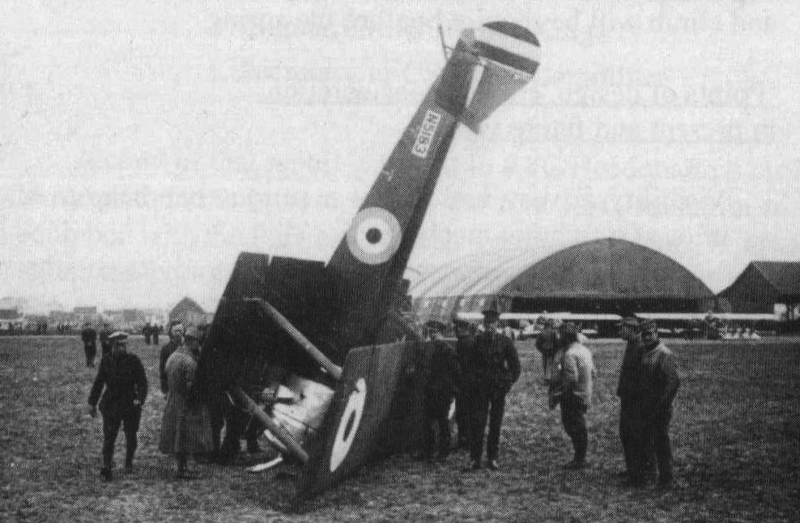
With Sopwith’s Kingston factory breaking output records, the RNAS perceives a bottleneck in Sopwith’s final assembly operations at Brooklands and a shortage of ferry pilots. On 14th February the Assistant-Director of Air Services issues a directive to the Captain Superintendant, Central Supply Depot, White City: “Owing to the necessity of getting machines to Dunkirk as soon as possible….the Fifth Sea Lord has approved of all Triplanes and Pups being sent direct by naval motor lorries to Dover for erection and trial from Sopwith’s works. They will be erected by naval ratings at Dover and tested by Lt Andrew. Any ratings now at Brooklands should be sent to Dover. Procedure to come into force forthwith.” Sopwith are not at all keen on this arrangement.
Among the new Knights in the Honours announced this week are Sir William Ashbee Tritton who played such a prominent part in the development of the tank, Sir George Buckham Vickers’ chief gun designer and Sir William Douglas Weir, Chairman of Scottish pump (and now ammunition shell) manufacturer G & J Weir, successful Director of Munitions for Scotland and the Ministry of Munitions’ Controller of Aeronautical Supplies on the new Air Board. Flight magazine reflects the general welcome for the overarching new powers of the Air Board with this cartoon depicting their key role in co-ordinating the supply of new aircraft to the fighting forces. (below)
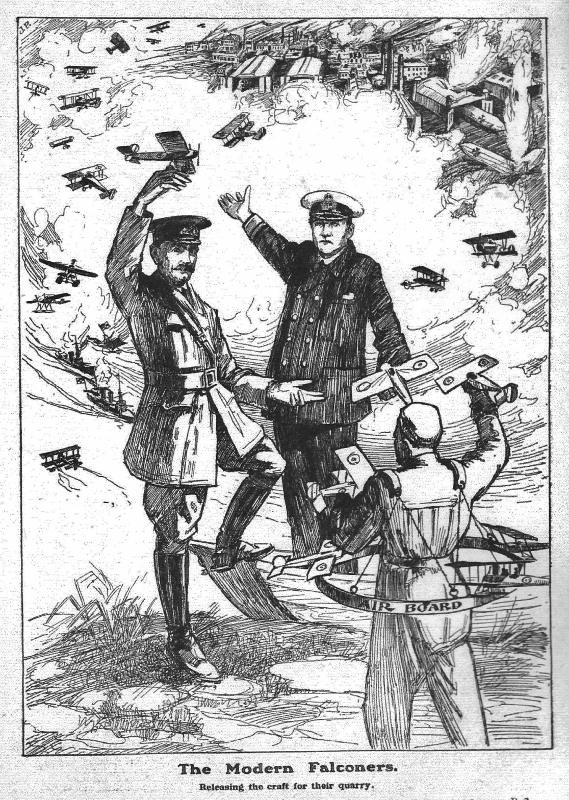
With two additional divisions from England the British Commander-in-Chief Sir Douglas Haig is taking over more of the French front line south of the Somme to release French resources for the major allied joint offensive planned to start on 1st April but Haig now tells the War Cabinet the RFC will not be fully ready and the air situation is even worse than he feared after continual postponements of the arrival of new squadrons and replacement aircraft through the winter. There will be a shortage of four to seven fighting squadrons below what was promised and seven to ten below what he had asked for and a further shortage of two new-type corps squadrons whilst five squadrons scheduled for re-equipment would remain unconverted. “Our fighting machines will almost certainly be inferior in number and quite certainly in performance.” This is despite the RNAS secondment of 3(N)Squadron’s ‘Pups’ attached to RFC 22 Wing and on 15th February the sixteen Sopwith ‘Triplanes’ of 1(N)Squadron attaching to RFC 14 Wing, with the promise during March of the return of 8(N) Squadron re-equipped with Sopwith ‘Triplanes’ and 6(N) Squadron with Nieuport Scouts.
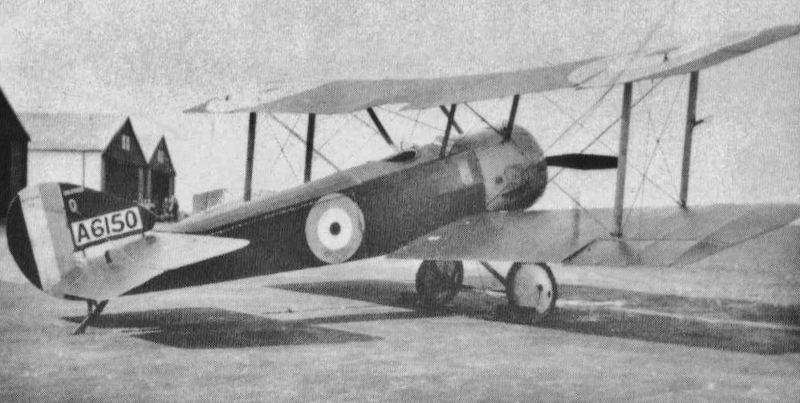
After just six days at Farnborough the first Whitehead-built ‘Pup’ A6150 (above) went not into active squadron service but to the RFC Central Flying School at Upavon where this photograph shows it to be unarmed and built with the now outdated adjustable incidence tailplane.
The promoters of Basil Watson’s barnstorming tour of Western Victoria in his homebuilt Sopwith ‘Sparrow’ have received approval from the Postmaster General’s Department to carry official experimental airmail some 300 miles from Mt Gambier in South Australia back to Melbourne. Only specially issued souvenir letter cards marked “Australian Aerial Mail” are carried which sell for 1/- each plus penny postage. On 15th February he loops-the-loop twice over Mt. Gambier Town Hall before setting out with a sealed mail bag on a 26 minute flight to the racecourse at Casterton.
The recent decision to launch ‘Pups’ not ‘Baby’ floatplanes from the foredeck ramps of His Majesty’s Ships has triggered Admiralty orders for two extra batches of thirty ‘Pups’ from Beardmore, N6100 to 29 & N6430 to 59. This brings Beardmore’s total orders for ‘Pups’ to one hundred and ten of which about twenty are delivered including four pictured in the snow at East Fortune with their rocket rails and Lewis gun tripods. (below) They are preparing to operate from HMS Manxman.
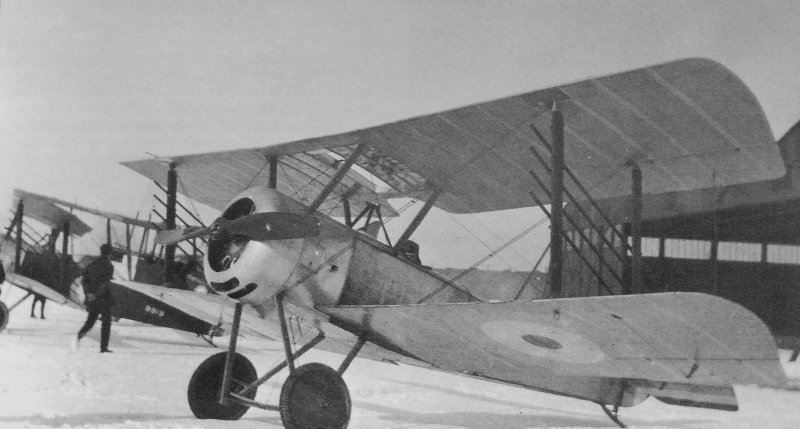
On 15th February 3(N)Squadron ‘Pup’ N6160 sends a scout down in a spin. The pilots of RFC 54 Sqdn ‘Pups’ A645 and A654 are killed one in combat and the other apparently by anti-aircraft flak whilst A647 is damaged and has to make a forced landing. 45 Sqdn ‘Strutter’ A1072’s engine chokes and it forced lands in fog whilst in England N5166 is crashed and wrecked on its delivery flight from Westland Aircraft at Yeovil to RNAS Cranwell.
On 16th February French Triplanes F1 & F7, now SP9 & SP13, intercept two German bombers over Dunkirk and send a German aircraft down pouring smoke whilst Manston-based Triplane N5424 is one of six machines sent up unsuccessfully to intercept a German Sablatnig SF 5 floatplane attacking shipping off the east Kent coast for the second time in two days. 3(N)Squadron ‘Pups’ N5188 & 9898 share a victory shooting down a Roland over Bapaume. 9(N) Squadron ‘Strutter’ 9897 goes out for the first time from Dunkirk with wireless telegraphy to report sightings of naval siege guns and 5(N) Squadron ‘Strutters’ bomb Bruges again. 43 Squadron ‘Strutter’ A959 is wrecked in a forced landing during a Defensive Patrol whilst eight month old prototype ‘Triplane’ N500 now with 8(N)Squadron gets tail high on take-off damaging the propeller and coming to a halt on its nose. (below)
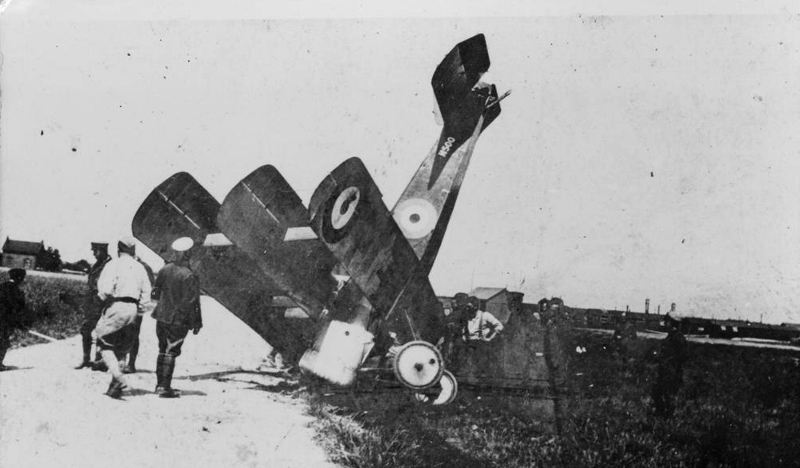
There are now ten ‘Strutters’ in the Aegean and on 17th February one from C Squadron on Imbros aims two bombs at an enemy gunboat and one on the seaplane hangar at Kusa Burna but its Bristol Scout escort never returns. By now three Sopwith-built ‘Strutter Bombers’ 9715, 18 & 27 and a Mann Egerton-built two-seat “Strutter” N5223 have arrived at Otranto in southern Italy for Commander Sueter’s Adriatic attack force.
On 17th February the Sopwith Board approve the accounts for the 1915/16 and seal patent applications for improved axle arrangements, wind brakes, windscreens, adjustable seats and operation of the empennage.
The RNAS have always been willing to accept the relatively lightweight construction of Sopwith’s machines to take advantage of their exceptional performance. The RFC are more cautious. Following their Central Flying School recommendation that the strength of ‘Pups’ be “checked for dive and sharp flatten out”, structural strength tests on ‘Pup’ A631 have been completed by the Royal Aircraft Factory at Farnborough by progressively loading the wings of the inverted machine with sand-bags. Various ‘Pup’ factors of safety from 6 and 7.95 are being officially quoted meaning the aircraft’s structure can support 6 or perhaps 7.95 times the standard flying loads during extreme manoeuvres.
When a 43 Squadron ‘Strutter’ broke up shortly after they arrived in France, Sholto Douglas concluded that they are rather fragile if roughly or clumsily handled. To reassure his pilots he does thirteen continuous loops with his adjutant in the back who has not strapped in and is hanging on for dear life. Douglas is angry with himself for not warning him. His delighted pilots think it is an enormous joke and are somewhat reassured.
On 19th February a French pilot at Luxeuil in a Sopwith-built ‘Strutter’ makes “several pretty sharp turns, descends very steeply with full motor and levels the machine out very sharply”. The right wing separates from the fuselage and the machine dives motor full on vertically into the ground. The French view is that it broke up in the pull-out through structural weakness and ‘Strutters’ must be strengthened by modifications. The RNAS observers’ views are that in such a sharp pull-out from a steep power dive any aircraft would be overstressed.
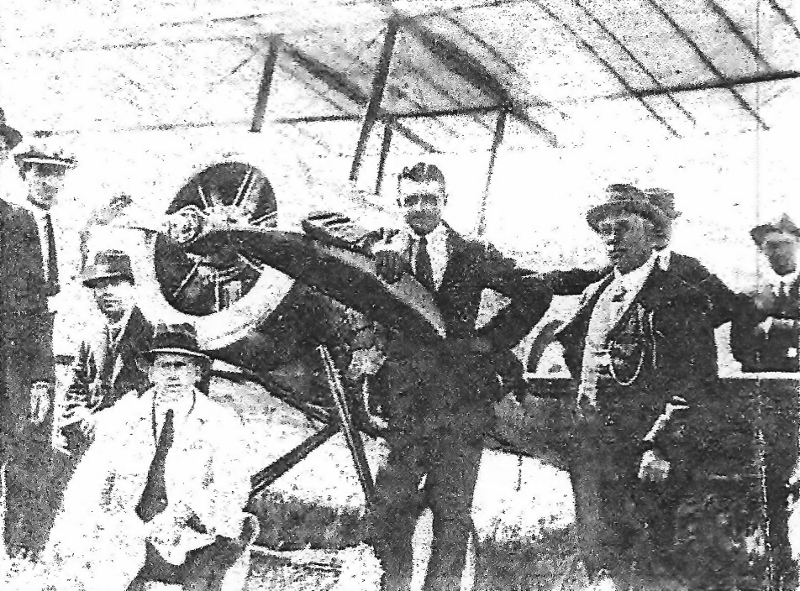
Basil Watson remains in Casterton five days until the 20th February when he leaves for Hamilton and Warrnambool picking up more mail bags for Melbourne. He is photographed (above) leaning on the propeller of his home-built Sopwith ‘Sparrow’ at Warrnambool with well-wishers and his tour promoters who are travelling in motor cars carrying emergency cans of fuel, although fuel and oil have been sent to the planned destinations well in advance. He continues the same day to Camperdown landing at the race course where a flying exhibition has been arranged for Saturday 24th February before he goes on to complete the air mail delivery to Melbourne.
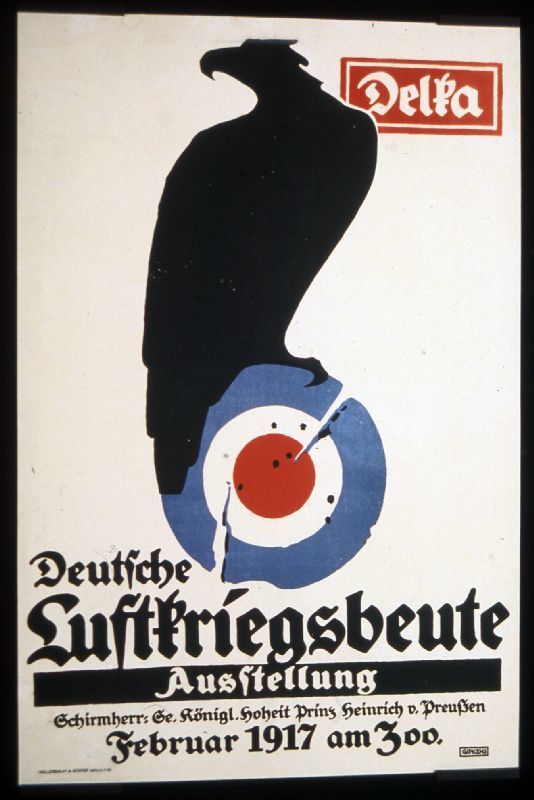
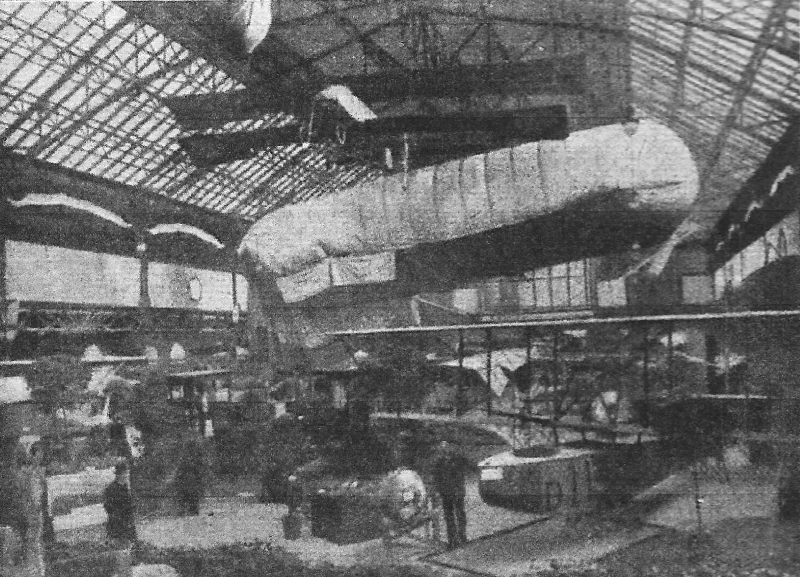
During February the Deutsche Luftkreigsbeute Ausstellung (Exhibition of German trophies from war in the air) is being held “am Zoo”, presumably Berlin Zoo. Using the acronym DELKA, the poster by Julius Gipkens declares the Patron to be His Royal Highness Prince Henry of Prussia.
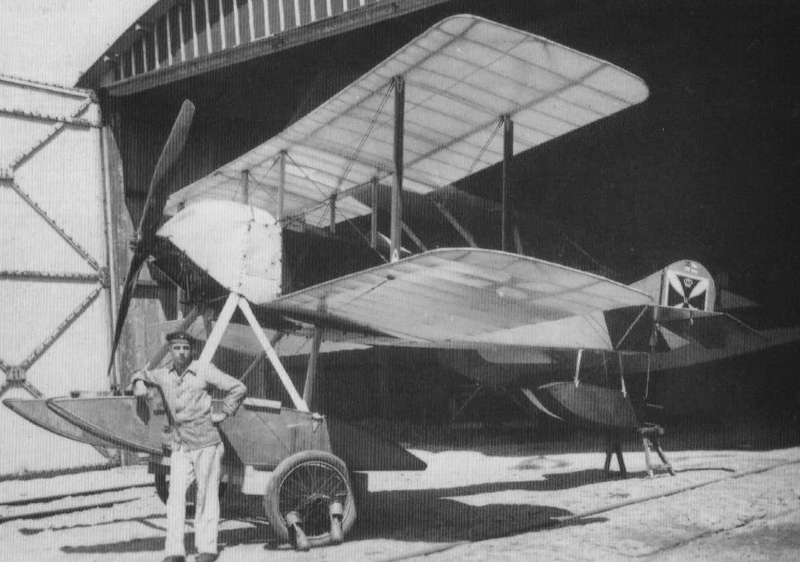
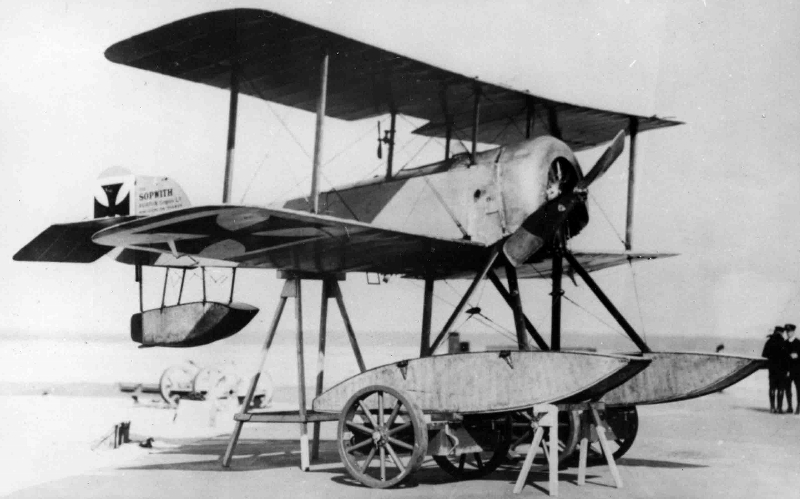
Amongst the aircraft displayed at the exhibition is Sopwith ‘Schneider’ 3717 which has seen active service at Zeebrugge since being captured there in August 1915. (above left) Sopwith ‘Baby’ 8153 has also been in German service since being captured returning from dropping bombs on the Hoyer Airship Base in March 1916.(above right)
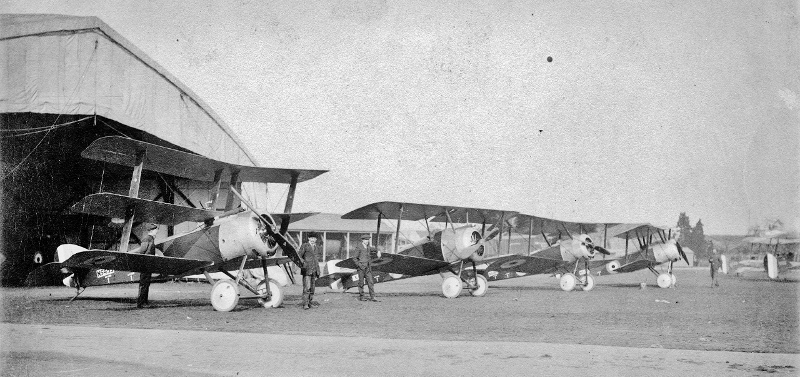
The above unique image of three ‘generations’ of brand new Sopwith single-seat fighters lined up outside a Bessaneau hangar at Brooklands is taken before ‘Triplane’ N5455 (left) is delivered to France on 23rd February. The two ‘Pups’ appear equally ready for service and what looks like a prototype ‘F1 Camel’ in the centre is in fact N5, the newly completed prototype “FS1 Improved Baby” floatplane fitted with wheels. The parallel design and development of these two new 130hp single-seat types has lead to very similar external appearance but this ‘FS1’ differs in many ways from the ‘F1 Camel’ prototypes. The flat top wing and steep dihedral lower wing are 13ins shorter than the ‘F1’ and the top one is not one-piece but three pieces, a centre section with two outer wing panels. Like the ‘Baby’ floatplanes the rear fuselage contains floatation bags and can be detached for ease of transport and shipboard stowage. It has only a single Vickers synchronised gun, a gap through the top wing centre section for access to a Lewis gun and large oval side panels to access the rear of the engine. The other ‘FS1 Improved Baby’ N4 is being built as a floatplane and is nearing completion.
On 24th February, quite separate from these two ‘FS1’ prototypes, the Admiralty purchase from Sopwith Aviation the two ‘F1 Camel’ prototypes which have recently arrived at Brooklands for testing. To be numbered N517 & N518 they have single piece top wings like the first two prototypes but in place of small square access panels on the nose (see first prototype below left) they have large oval ones like the ‘FS1’ (below centre). On N517 & N518 the hump over the Vickers guns is now flat-topped. (below right) The best way to install the side-by-side right hand feed guns and enclose their ammunition belt feeds under a hump is still being refined.
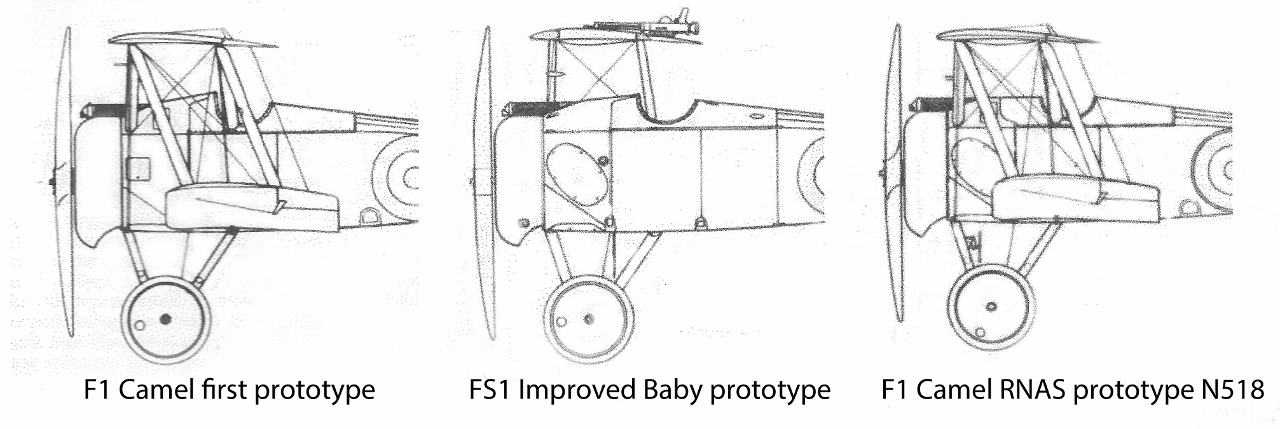
In addition to the first two private-venture ‘F1 Camel’ prototypes, the two RNAS ‘FS1s’ and these two new RNAS ‘F1 Camel’ prototypes the Sopwith experimental team are well advanced with another ‘F1 Camel’ prototype probably for RFC testing, followed by one for the French and at least one more.
On 23rd February 45 Squadron ‘Strutters’ use a fixed camera through a hole cut in the fuselage floor for the first time, probably a Type E it is operated remotely. Even with hand held cameras observers have been taking 50 or more plates on a single sortie which are immediately developed and rushed to the intelligence specialists.
On 24th February Yarmouth-based ‘Baby’ floatplane 8133 operating anti-submarine patrols from torpedo gunboat HMS Halcyon runs out of petrol but is towed into Harwich by submarine hunter HM Patrol Boat No.20.
No operational flying has been possible in Somme for the last eight days due to adverse weather. On 25th February C Flight of 3(N)Squadron fed up with the fog risk going out escorting FE8s in their ‘Pups’ but with cloud at 1,000 ft they get disorientated and all land at different aerodromes.
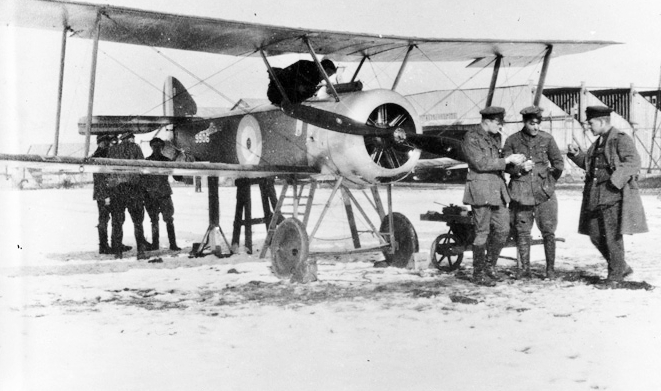
Two days ago RNAS 3 Wing at Luxeuil received their first Sopwith ‘Pup’, Beardmore-built 9906 unusually with an 80hp Clerget engine.(above) On 25th February Fl Cmdr Draper takes it out on a fighting patrol but the transparent celluloid in the centre of the top wing ruptures. Meanwhile one of his ‘Strutters’ 9739 is shot down during a bombing raid on Brebach with the loss of both crew, N5088 claims a Fokker Eindekker but is damaged, 9735 late for the raid is damaged in combat with four aircraft and finally ‘Strutter Bomber’ 9733 landing from the raid a crashes into N5124. (below)
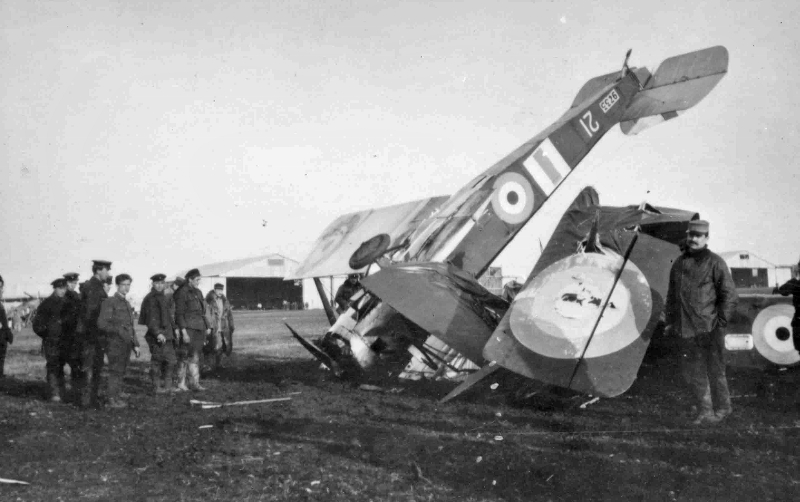
The 26th February is at last fine and breezy to help dry up the mud and slush on the aerodromes. 5(N) Sqdn ‘Strutter’ 9897 gets photographs of new defence emplacements, batteries and seaplane sheds in Belgium before being attacked by three machines and staggering home with a longeron completely shot through. Another taking-off with a choked engine hits a large tree, snapping it in half and severely bruising both crew. 43 Sqdn ‘Strutter’ A2418 also crashes during take-off injuring the pilot and 8(N)Sqdn prototype ‘Triplane’ N504 crashes near Furnes. ‘Pup’ 9913 is totally wrecked on HMS Manxman and ‘Pup A664 forced lands near Oxford.
On 26th February Sopwith delivers the last of ten French ‘Triplanes’ to Dover for the French engine to be fitted whilst the prototype 130hp Clerget engined ‘F1 Camel’ N517 makes its first flight at Brooklands. Tests are successful enough for it to go straight to the RNAS Aeroplane Depot Dunkirk (ADD) at St Pol for service evaluation. Sister aircraft N518 with its 110hp Clerget engine is also ready but is likely to remain under development at Brooklands for some time, probably until a 130hp engine is available.
Elsewhere on 26th February the agreement on urgent RNAS resources for the RFC in France is modified by the RFC taking over Admiralty orders for 200 French designed SPAD VII fighters on Mann Egerton , British Caudron and Nieuport. In exchange the Admiralty take over the RFC orders for 206 Sopwith ‘Triplanes’ on Clayton and Shuttleworth who, new to aircraft work, are only just starting to deliver their initial Admiralty ‘Triplane’ orders.
On 27th February a mixed group of RNAS A Squadron machines bomb the seaplane base at Gereviz in the Aegean and intercept a low flying floatplane forcing it to land. The crew beach it and hide ashore whilst a ‘Strutter’ fires three trays of ammunition into it.
On 27th February in France ‘Triplane’ N5441 overturns landing on soft ground, ‘Strutter’ A2396 is wrecked in a collision on the aerodrome and N5114 is wrecked crashing and overturning.(below)
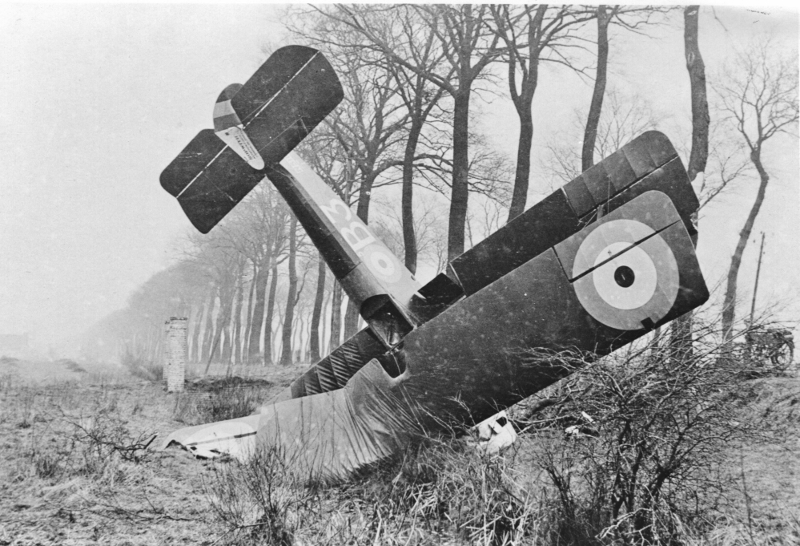
Bad weather at Camperdown in Australia last Saturday 24th February made it impossible for Basil Watson to perform his “aerial feats” in his homebuilt Sopwith ‘Sparrow’. On 27th February he leaves Camperdown at 2.25 p.m. on the final 120 mile leg of his experimental air mail flight to Melbourne carrying five bags of letter cards. He lands in Middle Park at 3.45 p.m. where the mail is handed to the Deputy Postmaster General. Following this success Basil’s promoters begin negotiations with the authorities in other parts of Victoria and with the Postmaster General’s Department to carry mails further afield. The Camperdown Chronicle reports that Mr Watson “intends to make a non-stop flight from Melbourne to Sydney at a later date” a journey of over 400 miles.
On 27th February a D Squadron ‘Strutter’ from Thasos escorting a bombing raid shoots down an enemy aircraft.
On 28th February RNAS Sopwith ‘F1 Camel’ prototype N517 arrives at ADD, St Pol for evaluation and service trials with 6(N) Squadron whilst 80hp Clerget engined modified ‘Pup’ 9497 back from repair (wrongly marked N9497) makes its first three landings on the circular dummy deck at Grain trailing its fragile hook. (below)
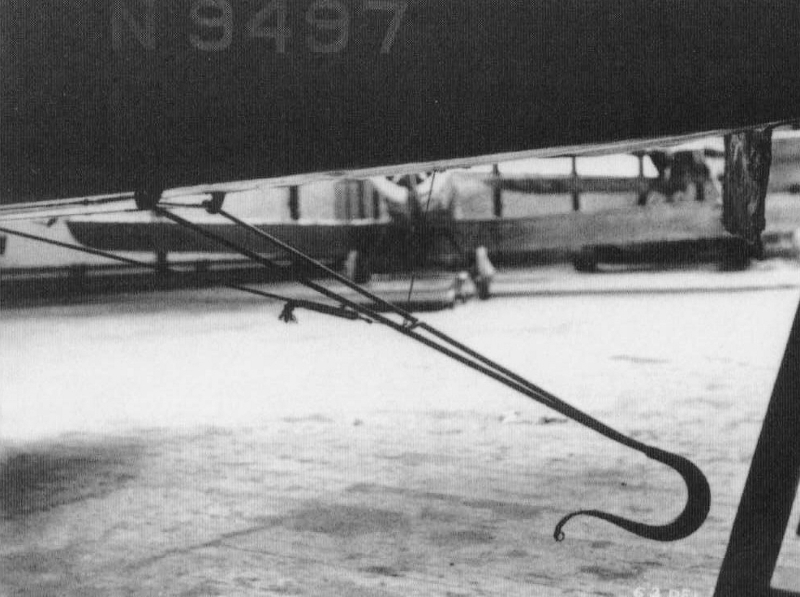
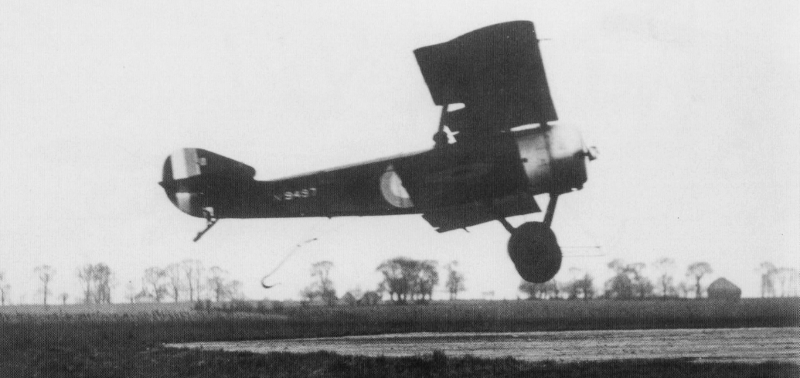
Elsewhere on 28th February Blackburn-built ‘Baby’ N1017 escorts a Short from Dunkirk to investigate U-boat sightings whilst at Upavon the pilot of RFC Central Flying School ‘Strutter’ 7810 is killed in a flying accident. 54 Squadron express concern that Standard Motors ‘Pups’ are still arriving in France without the stronger centre section struts and Alan Fenn, Sopwith’s man in Paris, leaves for urgent talks with Fred Sigrist in Kingston about the French insistence on design modifications for Sopwith ‘Strutters’ as a result of the recent structural failure.
During February Admiralty Wing Commander Longmore has seen the ‘T1’ torpedo bomber fuselage with its wide spread undercarriage suspended from the roof of the Sopwith factory and instigated the revival of the project abandoned when Murray Sueter left for Italy. Plenty of suitable V8 Hispano Suiza engines are expected to be available for the ‘T1’ following £2m British funding for the construction of a new factory in France, large orders on other French companies and Wolseley manufacturing them under licence in Britain (as the 150/180hp Python and geared 200hp Adder). With steel cylinder liners screwed into cast aluminium cylinder blocks these V8 water-cooled engines have a high power-to-weight ratio and low fuel consumption. Herbert Smith and his team are already designing a ‘B1’ bomber very similar to the ‘T1’ torpedo bomber, and Smith is developing radical new ideas for a Hispano Suiza powered Sopwith high-altitude fighter.
The Admiralty have recently ordered a further sixty ‘Ships Pups’ from Beardmore, N6100 to N6129 & N6430 to N6459 and surprisingly on 27th February give Sopwith an order for seventy more ‘Pups’ N6460 to N64129 despite Sopwith already building higher performance ‘Triplanes’ and the first production order for ‘F1 Camels’.
There is now a single consistent source for aircraft ‘output’ each month compiled by the Ministry of Munitions which shows February output of Sopwith designed machines as 92 ‘Strutters’ (from seven contractors), 41 ‘Pups’ (7 from Sopwith, 9 Beardmore, 14 Standard Motors and 11 from Whitehead in Richmond now coming on stream) and 7 ‘Triplanes’ (5 from Sopwith and 2 Clayton & Shuttleworth). There were probably also a few more of the first 20 ‘Baby’ floatplanes from Blackburn before they switch to wings with a modified airfoil section.
It is now clear that since the first four two-seat ‘Strutters’ were delivered to France from Hooper in Chelsea back in October and November 1916 they have completed 37 more and are about to make that 46 all of which are to be transferred to the Imperial Russian Air Service. Mann Egerton ‘Strutter bomber’ N5219 & two-seat ‘Strutter’ N5244 are heading the same way possibly as sample machines for future Russian manufacture.
The current Admiralty confidential “Disposition of Aircraft” report lists 388 Sopwith aircraft in service (114 ‘Schneider/Baby’ floatplanes, 183 ‘Strutters’, 54 ‘Pups’ and 37 ‘Triplanes’) at 18 locations and on 4 ships making up 24% of their 1642 machines and 40% of their “War Machines”, as opposed to “School and Experimental machines”. Of the 91 ‘Strutters’ in the 3 bomber Wing at Luxeuil 30 are under repair and 20 awaiting erection.
On 1st March two Westgate ‘Baby’ floatplanes are amongst 24 aircraft sent up too late to stop a German floatplane dropping four bombs on Broadstairs injuring 6 people. Damaged 9(N) Sqdn ‘Pup’ N6164 comes down in the sea off Cadzand in Holland overturning and damaging the engine with sea water. The Dutch inter the pilot and their Luchtvaart Afdeling acquire the machine for a rebuild for active service. ‘Strutter’ 9422 attacked by five enemy aircraft claims one sent out of control before returning damaged whilst N5105 crashes and burns at a French aerodrome and ‘Pup’ 9903 crashes at Cranwell.
The French now have all their nine surviving Sopwith ‘Triplanes’ in service and defiantly lined up in front of the recent German bomb craters at St Pol. (below)
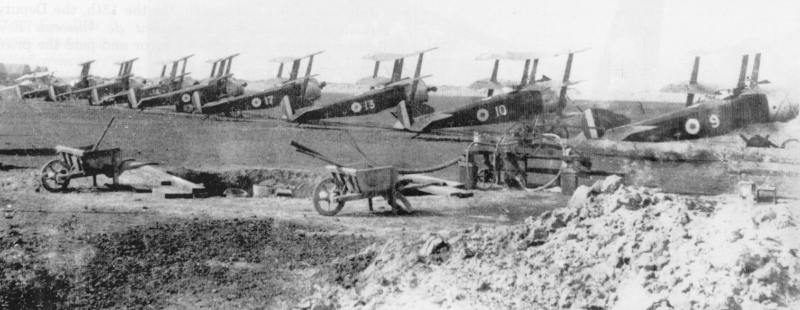
On 2nd March in an urgent bid to update their now outclassed Sopwith ‘Strutter’ fighters and before they even have their own prototype, the RFC orders 250 Sopwith ‘F1 Camels’ from Ruston Proctor.
On 3rd March the RNAS’s prototype ‘FS1 Improved Baby’ N5 moves to Hendon. The second RFC ‘Pup’ Squadron No.66 starts its move to France via St Omer whilst at Imbros in the Aegean a ‘Strutter’ is damaged seeing off two German floatplanes who were only trying to drop a note with news of a captured Canadian airman.
With growing indications that the Germans are planning a withdrawal to a stronger shorter front line fuelled by news from German prisoners, the RFC increase the intensity of escorted photo-reconnaissance missions.
On 4th March on a 3 Wing bombing raid on Brebach ‘Strutters’ N5173 & 9410 each claim an aircraft shot down. Over the Western Front ‘Strutter’ A961 claims 43 Squadron’s first victory but they lose A1108 & A1109 with all four crew. 54 Sqdn ‘Pup’ A633 escorting photo-reconnaissance missions over new German positions is shot down with the injured pilot taken prisoner. 3(N) Squadron ‘Pups’ 9898, N5199 & N6160 all claim victories but 3(N) suffer their first losses with three pilots shot down in N6165, 66 & 70 whilst N5185, 88 & 94 crash on landing. After overnight snow and in a howling gale General Trenchard makes a surprise visit to compliment 3(N)Sqdn on protecting all his reconnaissance machines the day before but makes little mention of their losses.
On 5th March two more dummy deck landings are made at Grain in ‘Pup’ 9497 whilst they delete from service the last Sopwith ‘Type 860’ floatplane 852 latterly used for high-lift wing trials, triggering Sopwith to dismantle the remaining two undelivered machines 931 & 932 stored at Woolston. That day ‘Pup’ A671 has its engine cut out at 12,000ft well over enemy lines but glides back to a crash landing in allied territory whilst ‘Triplane’ N5352 crashes on its delivery flight from Clayton & Shuttleworth to Cranwell and is taken to Dover for repair.
On 6th March ‘Strutter’ A978 is shot down in flames killing both crew, A1097 sends an enemy aircraft down in combat before being shot down and both crew killed, the observer in A1072 is fatally wounded when surprised to be hit by Siemans-Schuckert D1s (German Nieuport copies) whilst struggling home with engine trouble, A1082 forced lands after being shot up, as does A1919 after being hit by shellfire, A882 forced lands with an engine failure, 7782 is wrecked returning from a photo sortie and A1075 is damaged on a practice flight.
The Sopwith ‘FS1 Improved Baby’ floatplane N4 is almost ready to go to RNAS Grain for testing. In Sopwith’s re-traced General Arrangement Drawing (below) it is much like the wheeled ‘FS1’ N5 but with pontoon floats, jettisonable wheels and a circular section tail float with a tiny rear wheel or bumper. Like N5 the single Vickers gun is on the port side and the Lewis gun is inverted to aid re-loading through a Vee cutout in the three part top wing. The rear fuselage is attached by turnbuckles at the bulkhead just behind the trailing edge of the wing.

It now seems unlikely that ‘FS1’ floatplanes will be needed. The recent decision to use wheeled landplanes not floatplanes from the decks of naval ships is already being implemented. Rocket-equipped Beardmore built ‘Ships Pup’ 9918 is pictured (below) being flown off the foredeck ramp of HMS Manxman piloted by Sqdn Cmdr Rutland.
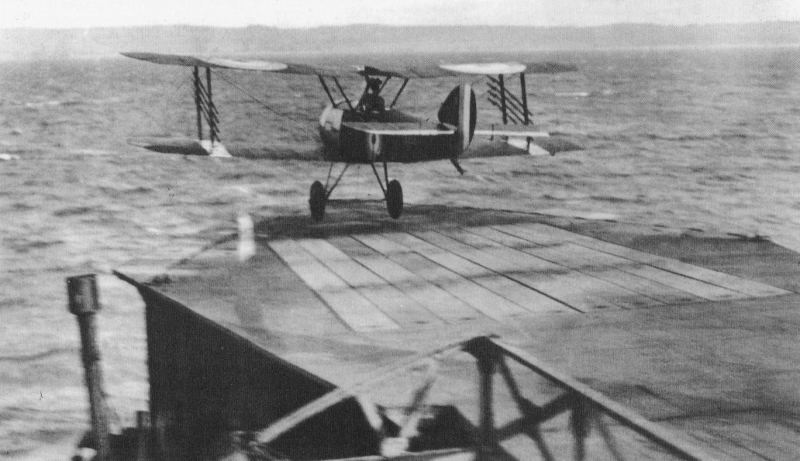
Meanwhile at Grain hooked ‘Pup’ 9497 makes two more landings on their dummy ship’s deck although their testing of the retractable-wheel folding-wing stowable ‘SBIII’ Pup 9950 is halted on 10th March when it needs repairing after a forced landing.
On 11th March 8(N) Triplane N5351 crashes on take-off and ‘Pup’ N5197 is damaged going back to France from repair and overhaul at Dover. 43Sqdn ‘Strutter’ A972 is wrecked crashing after being hit by AA fire and 45Sqdn ‘Strutters’ A1071 & A1082 are sent down with the loss of all four crew by Albatross DIIIs whilst on Line Patrol, the wings on A1071 folding during uncontrolled violent manoeuvres probably after the pilot is shot through the head. Five invaluable photographic plates are salvaged from the wreckage. It is becoming clear that ‘Strutters’ are no match for these latest German fighters and should not go out in twos or threes but in larger formations. However 3(N)Sqdn ‘Pups’ N6169 & N6175 each claim an Albatross sent out of control and 54Sqdn ‘Pup’ A673 downs a two-seater.
The RFC in France, used to less agile but sturdier machines, are reporting that Sopwith ‘Pups’ are past their best after 40 flying hours putting the “soggy wings” down to “the extremely light construction of the planes themselves”. 54Sqdn have reported that the spruce bearers for the pilot’s seats are weak and if they fail the seat falls onto and jams the elevator cables, they recommend ash. No one seems to like the Sopwith padded windscreen neatly mounted on the rear of the gun (below with non-standard Aldis sight) as it obscures critical areas of the pilot’s field of view, gets misted up with engine oil and despite the padding could cause facial injuries in a crash. Some have replaced the screen with an Avro one or a rounded screen faired into the top of the cowl giving more draught protection and better gun sighting, some have also devised their own gun sights.
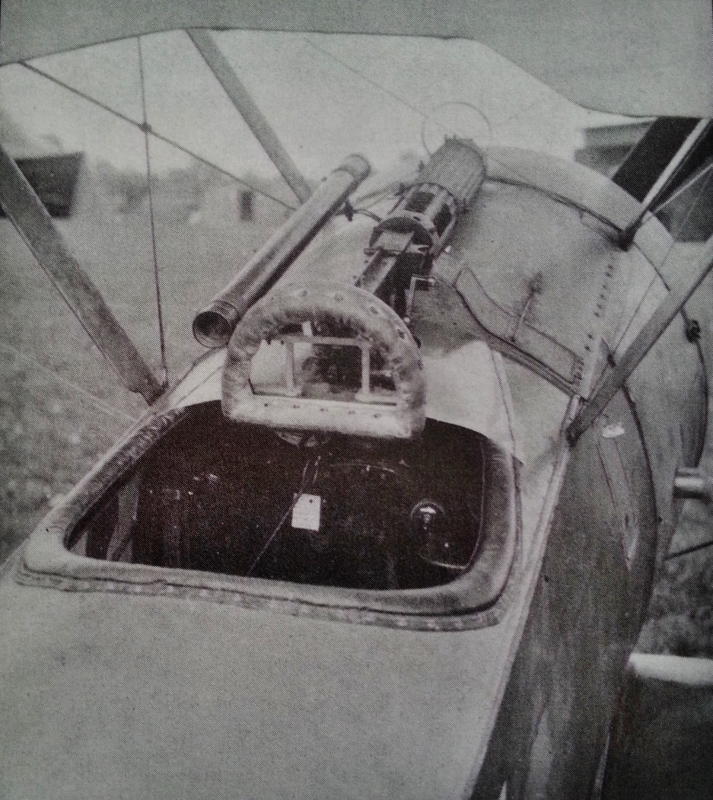
On 12th March In France 43Sqdn ‘Strutter’ A962 crashes landing from an observation patrol and the next day ‘Strutter’ A882 is damaged on a contact patrol and forced to land with engine failure.
On 12th March after just four days at Scapa Flow ‘Baby’ floatplane N1027 is wrecked by the drifter Volturno alongside HMS Campania and “the remains are hoisted in”. The next day new ‘Baby’ floatplane N300 arrives for HMS Campania where 12 are allocated to her War Flight and 6 to instructional flying from her deck and gunnery practice although the actual complement is presently less than 10.
The latest large naval vessel with a foredeck flying platform is HMS Furious a fast, shallow draught heavily armed battle-cruiser. On 13th March, from experience with Campania, a decision is made to remove Furious’ forward 18inch gun turret to fit a larger 228ft by 50ft flying deck in front of the superstructure on top of a workshop and hangar for eight seaplanes accessed via a hatch served by two 40ft wooden derricks.
On 13th March the two-week-old Admiralty order on Sopwith for another 70 ‘Pups’ is reduced to 20 and their RFC order for 100 ‘Triplanes’ recently taken over by the Admiralty is cancelled altogether. With the promise of large volume ‘F1 Camel’ orders to follow the fifty on order, Sopwith should now be able to complete their orders for 95 ‘Triplanes’ and 90 ‘Pups’ in April and switch the whole factory to ‘F1 Camel’ production from May.
Meanwhile another ‘Pup’ has been specially adapted for dummy deck landing trials. On 14th March 9933 fitted with skid undercarriage and an upward firing Lewis gun is accepted after its first flight. It is reasoned that landing with sprung wooden skids on a wooden deck will offer more braking friction than wheels.
At the end of February when a German mobile bombing force appeared on the Dojran Front in Macedonia help was sought from the Royal Naval Air Service. The Admiral commanding the Eastern Mediterranean agrees to form mobile fighting and bombing E squadron drawing four Sopwith ‘Strutters’ and a ‘Triplane’ from C and B Sqdns at Mudros and Mitylene. Initially at Hadzi Junas in Salonica, E Squadron has the Aegean’s only Sopwith ‘Triplane’ N5431, pictured (below) with its regular pilot Ft Lt Jack Alcock.
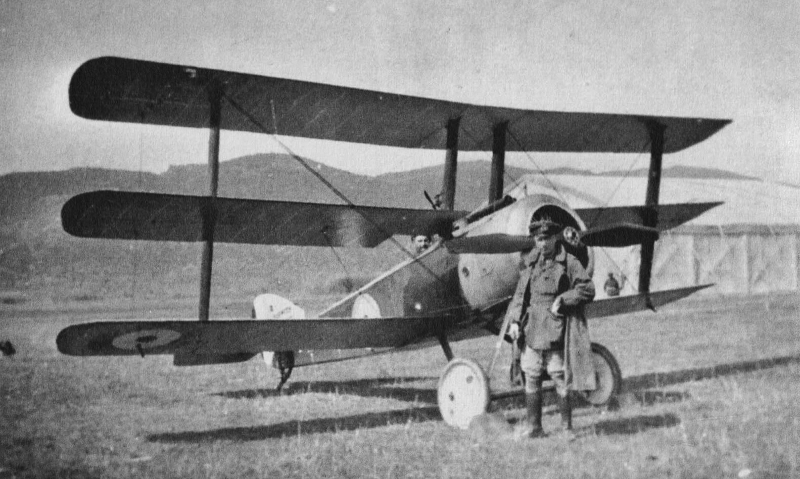
On 15th March prototype Sopwith ‘FS1 Improved Baby’ landplane N5 is at Martlesham Heath for testing.(below) Note the large sloping gun hump, inverted fixed Lewis gun on the top wing and detachable rear fuselage break just in front of the roundel.
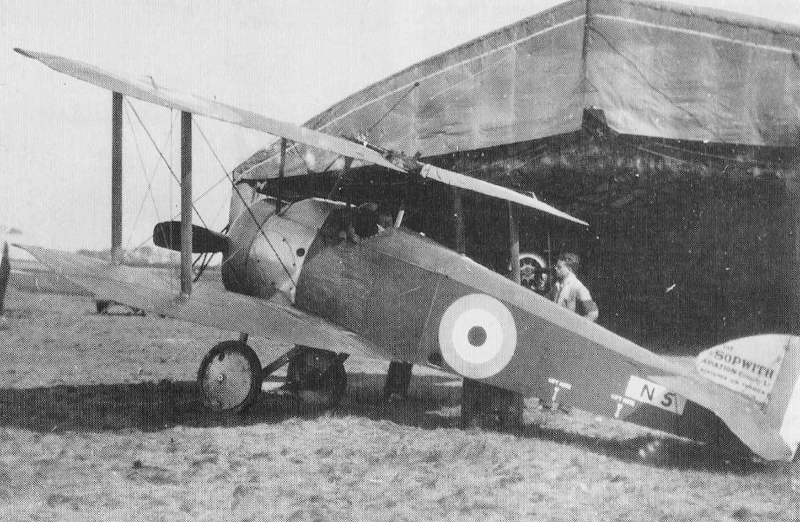
In France on 15th March 43Sqdn’s Major Dore collects ‘Strutter’ A2411 from St Omer but a piston connecting-rod breaks on arrival forcing a crash landing. There are signs that German troops are starting to withdraw from some of their front lines.
On 16th March 43Sqdn ‘Strutter’ A960 claims an enemy two-seater sent out of control whilst A2407 forced lands at Auchel with engine trouble but runs into a ditch and is not worth reconstruction. ‘Strutter bomber’ N5134 on loan to the French is shot down and the aircraft captured. It is bundled onto a lorry (below) with landing gear trailing showing its circular Westland Aircraft makers logo and the access panels to the internal bomb racks.
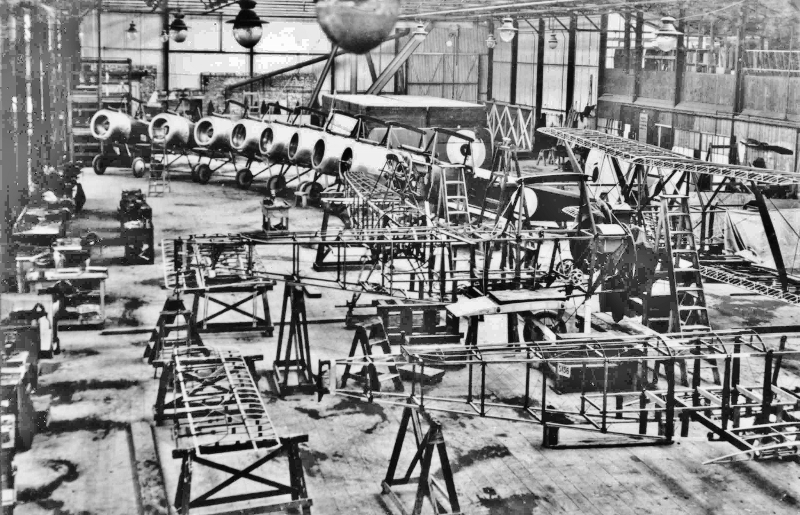
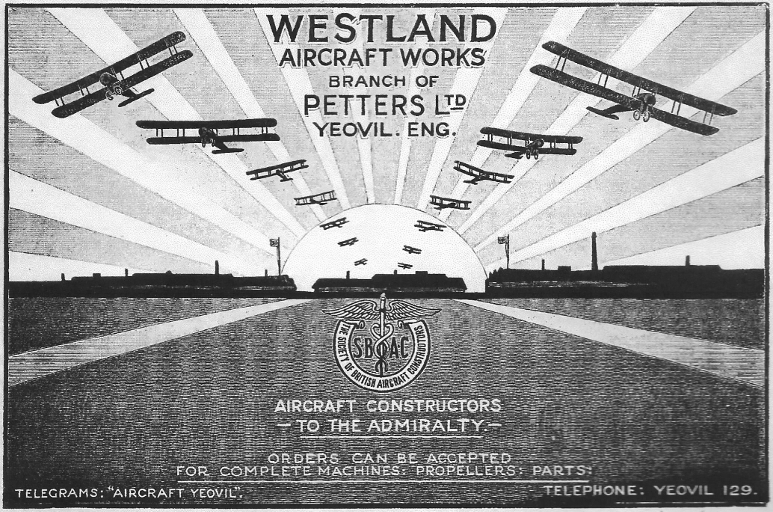
Westland Aircraft are coming to the end of their Admiralty orders for 75 ‘Strutters’ including 55 ‘Strutter bombers’. The internal flat frame to support the vertical bomb racks can be seen inside their bare fuselages.
On 16th March Westgate and Manston ‘Baby’ floatplanes are amongst seven aircraft trying unsuccessfully to catch a German floatplane which inaccurately aims twenty bombs at Westgate airfield.
On 17th March French ‘Triplane’ SP13 claims a photo reconnaissance machine driven down. Kitto & Ward in RFC 43Sqdn ‘Strutter’ A960 claim an enemy two-seater sent out of control for the second day running whilst 3(N)Sqdn ‘Pup’ 9898 sends two down as does N6169 whilst N6175 claims one and RFC 54Sqdn ‘Pups’ A649 & A669 share another. Eight “Sopwith” victories in one day but 43Sqdn ‘Strutter’ A1097 is shot down in flames and A1111 gets into a spin during a combat and “crumples pulling out”, all four crew are killed whilst the observer in another is shot in the foot. 3(N)Sqdn ‘Pup’ N6163 is wrecked in a forced landing after combat damage and 70Sqdn ‘Strutter’ damages the undercarriage landing in a cross wind.
By 17th March the RNAS’s recently purchased Sopwith ‘F1 Camel’ prototype N517 is already appearing in 6(N)Sqdn daily reports, the first of this new type to be evaluated in service in France.
On 17th March ‘Ships Pups’ 9926 & 27 arrive by rail at Felixstowe for HMS Vindex’s flying-off deck. Meanwhile, practice landings on the dummy ship’s deck at Grain with “Pup” 9497 have progressed to experiments with transverse wires strung from wooden stands and weighted with sandbags. The images (below) with the hook pulled right back by the first wire illustrates the need for the propeller guard in front of the landing gear. Unless the wire is caught dead centre the aircraft is slewed round. It all has to be done directly into wind hence the portable arrester wire equipment on a circular wooden deck and the wind flag.
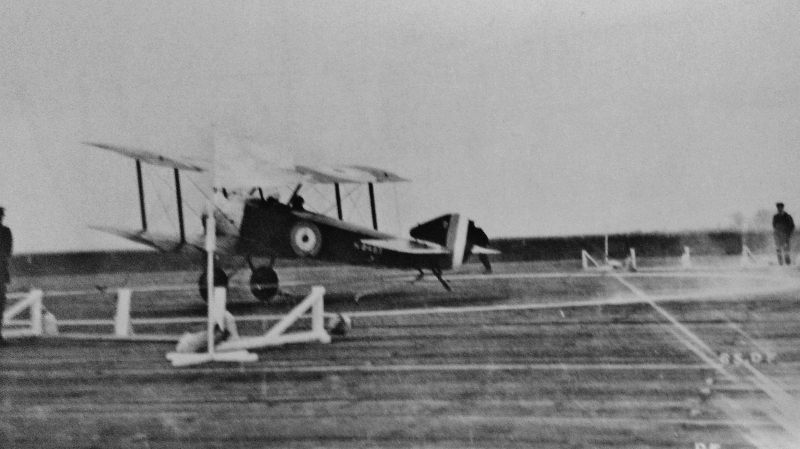
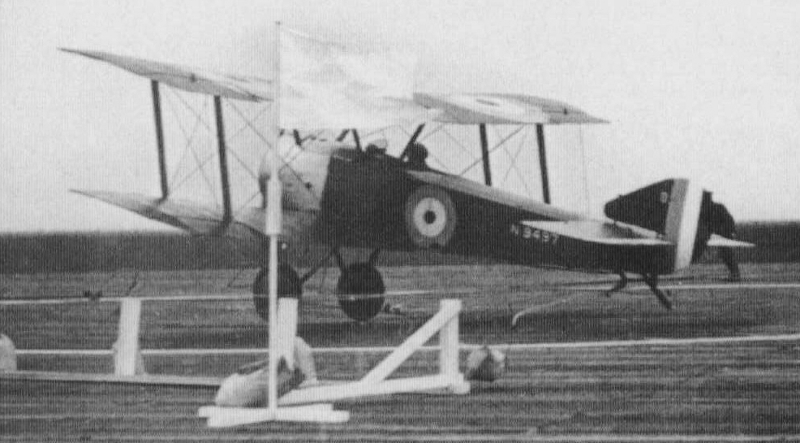
By 18th March the first 12 of RFC 66 Sqdn’s ‘Pups’ are at Vert Galand, 3(N)Sqdn make room for them by moving to Bertangles. 45Sqdn ‘Strutter’ A2384 shoots an enemy two-seater down in flames but A883 and A1514 are wrecked in forced landings whilst A878 makes a forced landing after getting lost in cloud. In England an RFC 34 Reserve Squadron pilot is killed in an accident at Turnhill in ‘Strutter’ 7807.
On 19th March 54Sqdn ‘Pup’ A7308 and another share a victory sending a two-seater down in flames. ‘Triplane’ N5438 finally arrives in France two months after being damaged at Brooklands before delivery.
On 20th March 3(N)Sqdn ‘Pup’ N6169 sends a blue Halberstadt DII out of control whilst 54Sqdn’s A634 landing gear collapses taxying in from an escort mission.
In the Aegean there is a surprise Zeppelin raid on Mudros before midnight. A ‘Schneider’ floatplane is sent out in an attempt to intercept but loses sight of it in the dark.
On 21st March in Macedonia the ‘Strutters’ at Hadzi Junas are escorting Henri Farmans to bomb Xanthi after dropping pamphlets there the day before.(below E Sqdn ‘Strutter’ N5111)
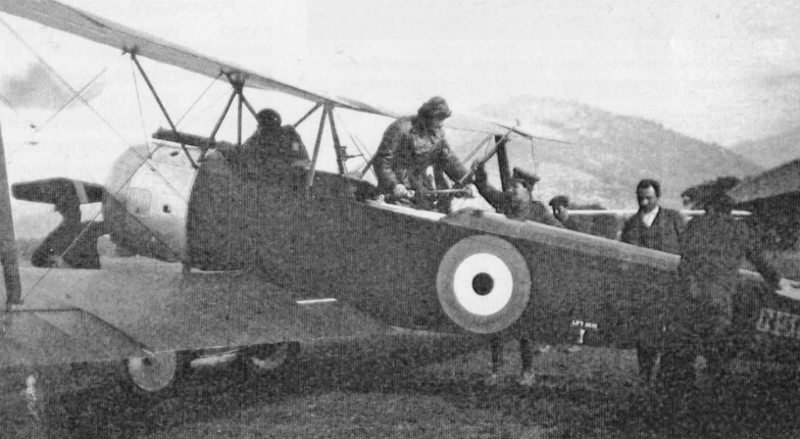
In France both crew of 43Sqdn ‘Strutter’ A2390 are injured in combat and make a forced landing with the fuel tank on fire before the aircraft is burnt out whilst A2395 is wrecked in a forced landing after engine trouble.
On 22nd March RNAS 3 Wing make their first raid since 4th March dropping 1,560lb of bombs on Burbach in the Saar Valley. Only ‘Strutters’ are used as their new Curtiss R2’s have been found totally unsuitable. 9708 smashes its undercarriage in a forced landing after its engine is damaged in combat returning from the raid.
The Port Victoria ‘PV1’ 3742 has recently been photographed with its latest modification, a four bladed propeller.(below) The ‘PV1’ is Sopwith ‘Schneider’ 3742 which the Port Victoria Experimental Construction Depot at Grain fitted with their own design of high lift wings last year. The under wing roundel is partly obscured by the extreme curvature of the wing section. There are reports that the ‘PV1’ has been flown off a railway truck in the sidings at Grain and might be used to investigate the problems associated with catapulting aircraft.
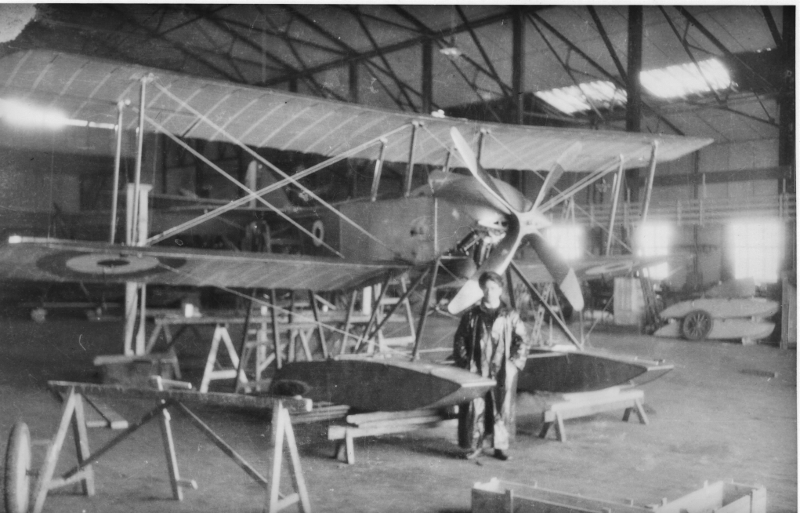
On 23rd March with the army capturing Bapaume and other villages and a push by allied cavalry, aircraft patrols over the Western Front are even more intensive. 3(N)Sqdn ‘Pups’ are out escorting FE2Bs on this deceptively cold day, at 16,000ft several pilots suffer frost bite to their faces. For one who had refused to smear his face with whale oil it was severe enough to be rushed to hospital and two weeks before he could fly again. ‘Strutter’ 7800 is wrecked when the propeller bursts whilst running up the engine on the ground. 1(N)Sqdn ‘Triplane’ N5432 suffers a failure of its 130hp Clerget and crashes near the aerodrome. This machine has been used for testing the C P O Pott’s promising “automatic carburettor”.
Over Macedonia a ‘Strutter Bomber’ suffers damage from a surprise attack by a Halberstadt which is driven off by the escorting ‘Strutter’ fighter whilst at the RFC Central Flying School Upavon ‘Strutter’ A1089 is wrecked and its pilot killed when the propeller of ‘Pup’ A6150 hits its tail during fighting practice.
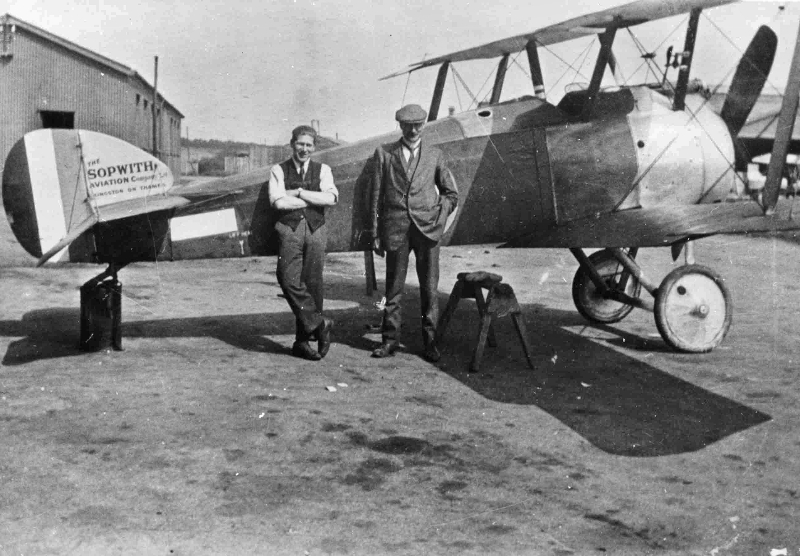
The latest ‘F1 Camel’ photographed at Brooklands with Sopwith workers has a one-piece top wing with centre aperture, twin Vickers guns under a flat topped hump and square engine rear access panels.(above) It is probably prototype F1/3 which arrives at Martlesham Heath as B381 on 24th March for testing for the RFC who have already ordered 250 ‘F1 Camels’. Also on 24th March ‘Improved Baby’ floatplane N4 is test flown by Harry Hawker at RNAS Grain.
On 24th March seven 70Sqdn ‘Strutters’ are attacked by twelve German fighters whilst on reconnaissance over Cambrai and Douai. Both crew of downed A957 are fatally wounded, A956 & A1925 are damaged and the observers wounded one fatally, A2983 is damaged and the pilot wounded, A1907 is hit in the fuel tank and brought down with the crew taken prisoner. German twelve victory ‘ace’ Ltn Renatus Thieiller is killed. 43Sqdn ‘Strutters’ A1903 on line patrol & A2985 on escort duty are wrecked in crash landings, A1903 after an engine failure. Meanwhile 3(N)Sqdn ‘Pup’ N6174 claims a two-seater and 9(N)Sqdn’s N6177 claims a seaplane at Weduyne. 54Sqdn ‘Pups’ A646 and A652 are turned over by gusts of wind after landing as is 66Sqdn’s ‘Pup’ A7309 whilst A7316 crashes on landing after an engine cowl comes off in flight.
Dover-based Triplane N5473 breaks up in a dive from 2,500ft killing the Canadian pilot. This restarts rumours about the strength of Sopwith ‘Triplanes’ which have been through ‘factor of safety’ structural tests at Farnborough including a test to measure the bending load required to break the fragile looking fuselage structure.(below)
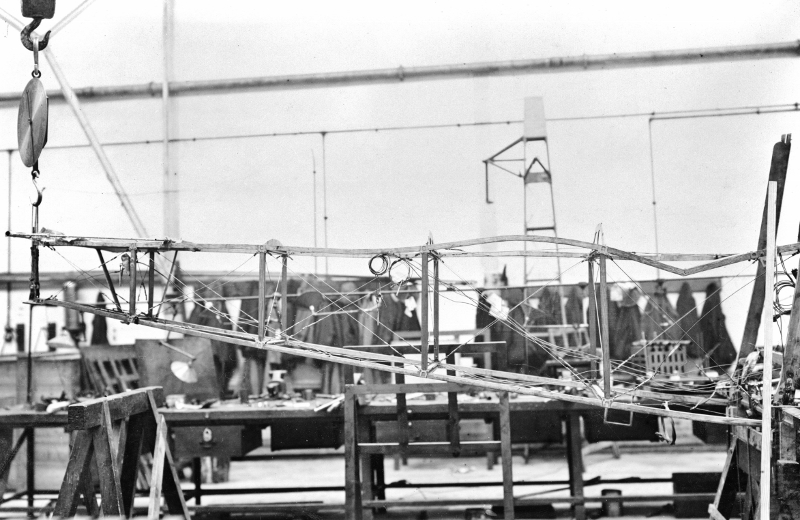
25th March is even worse than yesterday for 70Sqdn. In France since mid 1916, 70Sqdn was the first RFC Sqdn with Sopwith ‘Strutters’, at that time the best two-seat fighter but now out-classed despite some retro-fitting of 130hp engines. Five ‘Strutters’ 7763, A884, A954, A958 & A2986 are lost and their crews killed or fatally injured in a combat with nine enemy aircraft whilst A2984 is wrecked in a forced landing after engine failure. 54Sqdn ‘Pup’ A630 is also shot down this day whilst on escort duty and its pilot killed. (70 Squadron’s Fairey-built Sopwith ‘Strutter’ A954 reported above as shot down here has earlier been photographed (right) with a pair of RFC Morane parasol monoplanes and a Royal Aircraft Factory BE2E.)
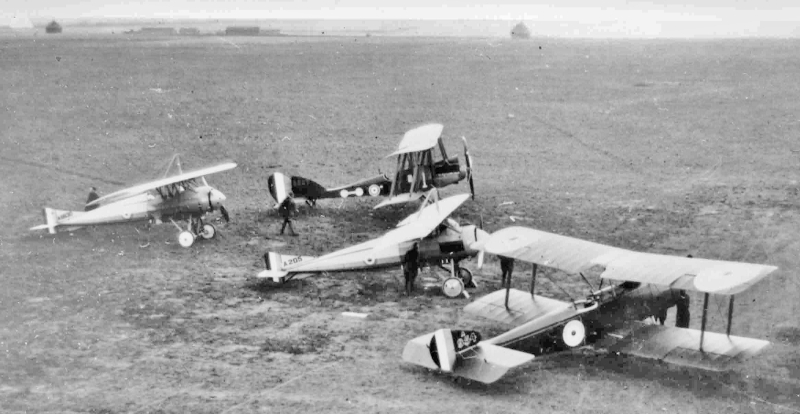
On 26th March Lt Alcock runs ‘Triplane’ N5431 into a ditch at Mikra Bay airfield in Salonica flipping it onto its back and breaking its fuselage in two. (below) Amazingly he escapes unhurt and the only ‘Triplane’ in the Aegean is to be taken to Mudros for repair. Many replacement parts will need to be shipped out from England.
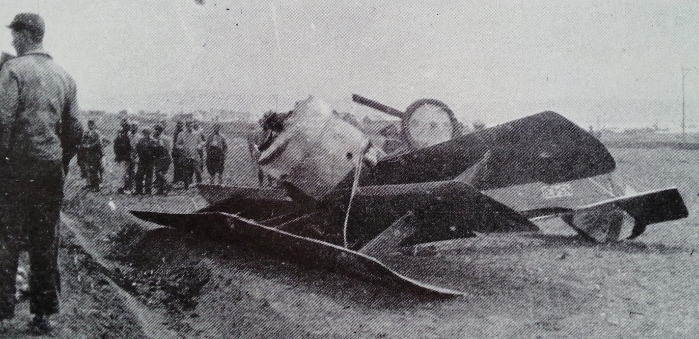
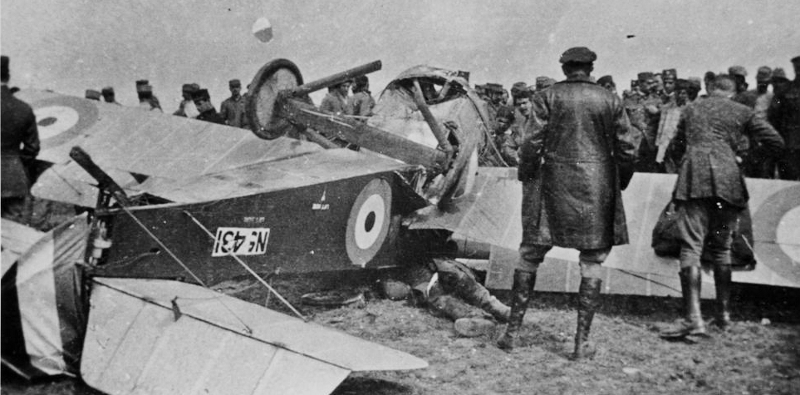
On 27th March the pilot of 66Sqdn ‘Pup’ A6163 is killed practising a spiral dive when the wings “fold up” at 50ft. 8(N)Sqdn ‘Triplane’ N5447 stands on its nose on landing..
27th March is a disastrous day for the new 130hp Sopwith ‘FS1 Improved Baby’ prototypes. After just three days at Grain the floatplane version N4 is wrecked and may not be rebuilt. The landplane version N5 crashes on its second test flight at Martlesham Heath but is repairable to resume testing as a successor to ‘Ships Pups’.
On 28th March the RFC are strengthened by the arrival of 8(N)Squadron ‘Triplanes’ although N5475 overturns in a muddy field after a forced landing. RFC 43 & 45Sqdn ‘Strutters’ A979 & A1086 are wrecked in crash landings. From Hadzi Junas in Macedonia RNAS ‘Strutter’ N5086 attacks an enemy aircraft but is badly shot up.
Since his recent tour and airmail flight Basil Watson has made repairs to his homebuilt Sopwith ”Sparrow” and on 28th March makes a test flight from Albert Park to Point Cook in preparation for a flying exhibition over Caulfield racecourse in Melbourne tomorrow. The flight which includes aerobatic manoeuvres goes smoothly enough and attracts considerable attention on the ground at Point Cook, from men in the camp, some bathing on the shores of Port Phillip Bay and Basil’s father James, who has driven out to pick his son up after he lands. Over the airfield, Basil loops the loop several times and then goes into an almost vertically banked turn when watchers see the plane tremble before the left wing snaps and falls away, swiftly followed by the right wing before the plane goes into a nosedive into shallow water near the shore. (recovered wreckage below) Basil is killed instantly at the age of 23 in Australia’s first fatal flying accident. A witness reports in the Argus newspaper “I should think that, from the time that the wing collapsed to the time that the machine struck the water, about seven seconds would have elapsed”.
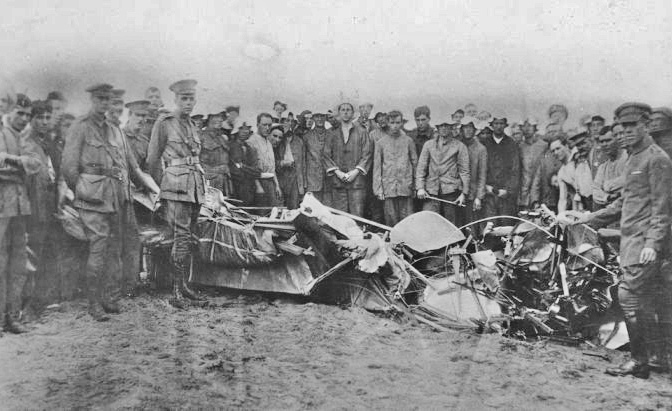
The editor of Aeroplane C G Grey bemoans the passing of Brooklands’ Blue Bird café with the following words:- “It is reported in the Press that a row of hangars and a canteen in the Brooklands aerodrome were destroyed by fire in the early morning of 28th March, the outbreak having, it is supposed, originated in the canteen. All the aeroplanes are believed to have been saved. The local fire brigade prevented the fire from reaching the large workshops and offices. When one remembers how one smoked, and ran brazing lamps and even engines, and used plain oil lamps in the old sheds at Brooklands, regardless of open cans of petrol, and even pans full of petrol for the washing of parts, it seems a miracle that the whole place was not burned out years ago. And now the poor old “Blue Bird” disappears in flames under a strictly regulated military control. So passes the scene of what were the happiest days in the lives of many of the old hands in aviation.” (Photo below: Blue Bird cafe and sheds pre-war)
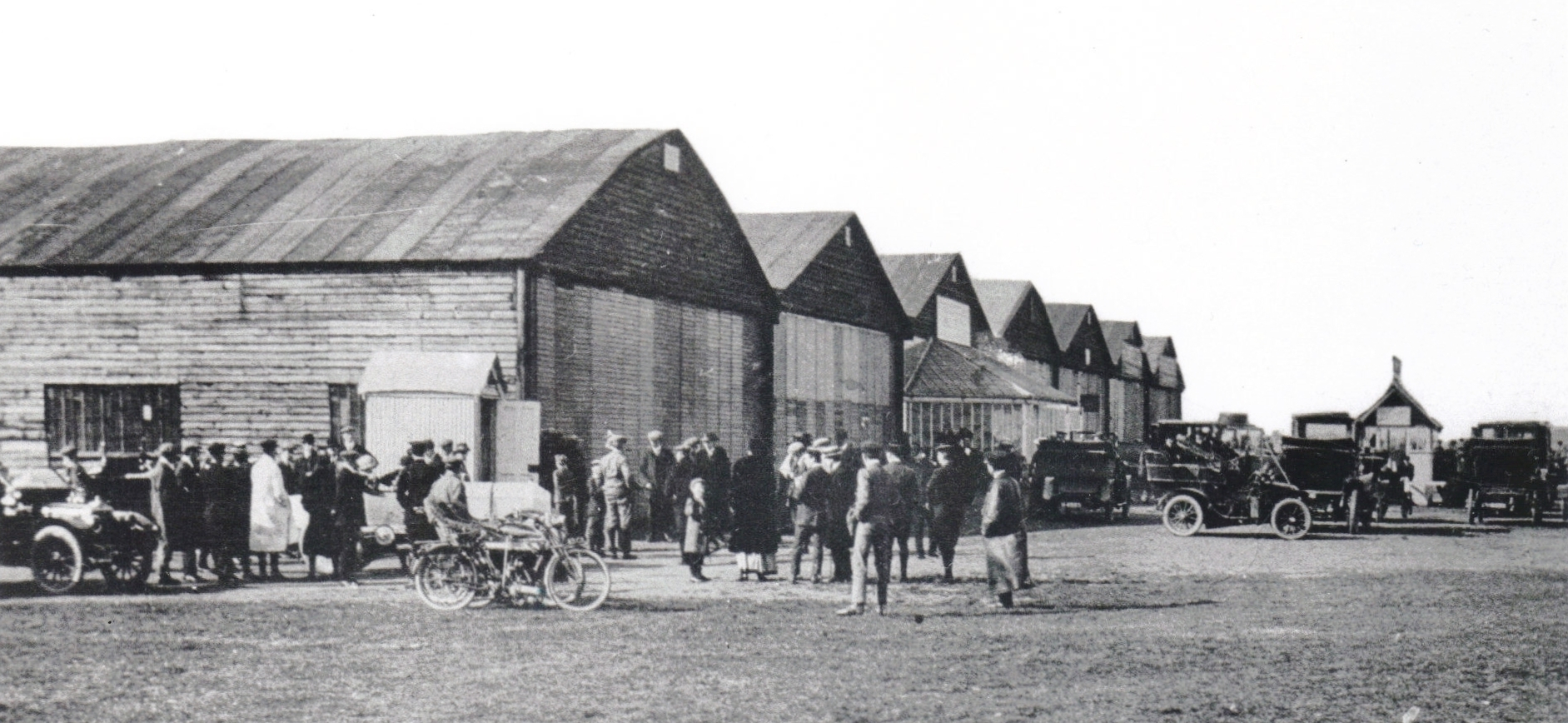
On 29th March 3(N)Sqdn ‘Pup’ N6186 crashes on a test flight before ever going into action and needs repairs.
On 30th March in France RFC 43Sqdn ‘Strutter’ A2417 is wrecked hitting a hedge after an engine failure on take-off and the following day 70Sqdn ‘Strutter’ A975 is wrecked with a smashed undercarriage on landing as is A980 landing with a failed engine. RNAS ‘Strutter’ N5223 on a reconnaissance flight from Thasos in the Aegean is shot down by Ltn Rudolph von Eschwege near Xanthi and both crew killed. The wreckage makes a sorry sight. (below)
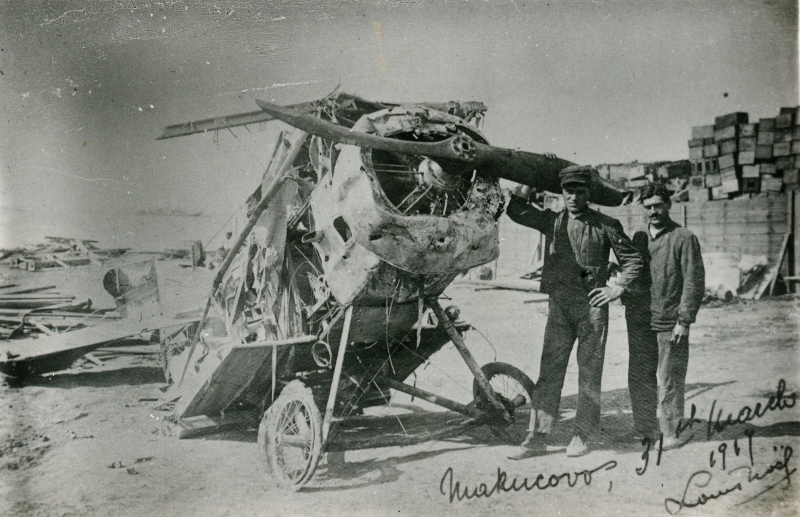
On 31st March nearly 7,000 people are gathered along the route of Basil Watson’s funeral procession through Melbourne and at the Boroondara Cemetery in Kew. His coffin is carried by officers of the Australian Flying Corps along a drive lined by members of the Corps. At the same time as the funeral, the bells of St Paul’s Cathedral in his birthplace Bendigo play the hymn Rock of Ages; the fire bell, which had rung on 29th November to alert Bendigonians to his arrival in his homebuilt Sopwith ‘Sparrow’ also rings to mourn his passing. There are many special floral tributes from family and friends, members of the Flying Corps and the Australian Aero Club.
In March for the first time the total of new Sopwith designed aircraft from all suppliers has exceeded 200 : 102 ‘Strutters’, 71 ‘Pups’, 28 ‘Triplanes’ & 6 ‘Baby’ floatplanes. Sopwith’s own output in March is a record 44 comprising 3 ‘Strutters’, 19 ‘Pups’ & 22 ‘Triplanes’. The Admiralty have now cancelled the last 12 ‘Strutters’ on Sopwith leaving them just thirty each ‘Pups’ and ‘Triplanes’ to complete, clearing the way for ‘F1 Camel’ production. The strange Admiralty fill-in order for 20 ‘Daily Mail’ floatplanes has never been started. Despite firm orders for only 50 ‘F1 Camels’, Sopwith knows that larger orders are on the way. With the fourth extension to their Canbury Park Road factory bringing the total floor area in Kingston to 142,000 sq ft, they are planning to almost double their output rate by the middle of this year to over 20 new aircraft a week.
In the drawing office they are finalising the 130hp ‘F1 Camel’ production drawings with a more practical three-piece top wing than the one-piece on the prototypes and with longer ailerons. In the experimental shop they are finishing several machines including the prototype ‘B1’ bomber and ‘T1’ torpedo bomber and an ‘F1 Camel’ prototype with very different tapered wings. They will soon be working on a prototype of Herbert Smith’s next Sopwith fighter, a V8 Hispano-Suiza powered high-altitude machine with its focus on better all-round visibility. The relentless pressure felt by the small drawing office team is captured in another of S Harris’ whimsical cartoons. (below)
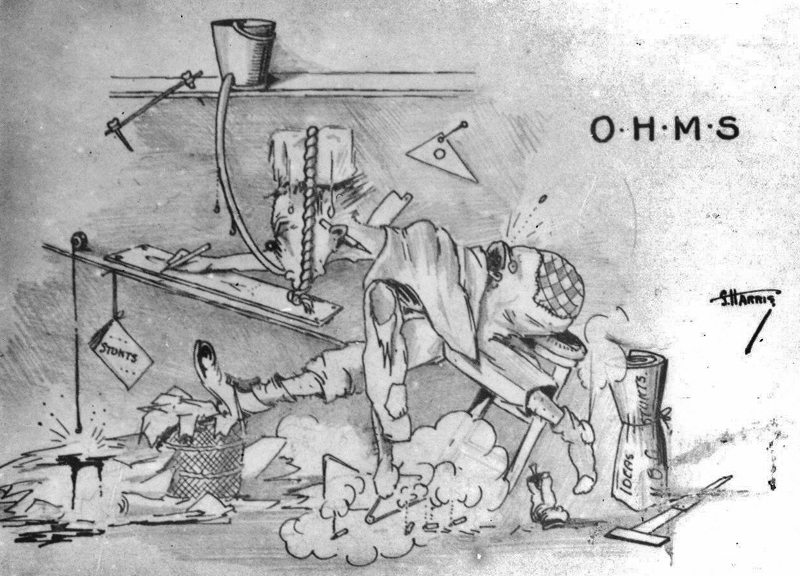
The RFC’s pleas for more RNAS support on the Western Front are one factor in the Admiralty signal last week to disband the RNAS 3 Wing at Luxeuil and release its considerable resources especially aircrew. The French plan to continue the strategic bombing of German industrial facilities from Luxeuil and 3 Wing will be transferring some 67 RNAS “Strutters’ to the French including 25 without engines.
Whilst the French authority’s instructions to strengthen certain ‘Strutter’ parts is delaying high-volume French manufacture, manufacture of ‘Strutters’ in Britain is reaching its climax. The Admiralty’s remaining 40 of their 150 from Mann Egerton and Westland are almost complete. The last 150 of the 550 RFC machines from Fairey, Ruston Proctor and Vickers should be completed in the next four months along with an extra 50 just ordered from Ruston Proctor. However with only 50 of the 400 ordered from new RFC aircraft manufacturers Hooper, Morgan and Wells yet delivered, the Morgan order is halved to 100 whilst Wells are now only likely to build the first 25 of their 100. With no more front-line ‘Strutter’ Squadrons being formed many ‘Strutters’ that are being built are going to our allies. 30 brand new RFC ‘Strutters’ purchased from Vickers, Fairey and Ruston Proctor are joining the many ex-RNAS ones in French service. 46 of the first 50 ‘Strutters’ from Hooper are amongst 190 being allocated to the Imperial Russian Air Service. At least 10 new ‘Strutters’ are being allocated to the Romanian Government, 16 to the Belgian Government and 17 to the Japanese.
During March Blackburn Aircraft have finished fitting engines to previously stored ‘Schneider’ and ‘Baby’ floatplanes 3707, 3709, 3765, 3806, 8197 & 8204, 8209 all of which are to go to the Royal Canadian Air Force.
By 1st April for the first time there are more Sopwith ‘Triplanes than ‘Pups’ in naval fighting squadrons in France, 46 against 37, with another 11 and 18 respectively in reserve in the depot at St Pol.
On 2nd April 43Sqdn ‘Strutter’ A2401 is attacked by five enemy aircraft and shot down by von Richthofen, the crew are taken prisoner but the observer dies of his wounds. 54Sqdn ‘Pups’ A637 & A661 both claim victories, A639 breaks a propeller on a stake taking off from a forced landing whilst N6174 & N6175 crash on landing.
On 3rd April 43Sqdn ‘Strutter’ A970 claims an Albatros D.III. 70Sqdn’s A2413 is wrecked when a DH4 runs into it on the airfield whilst 45Sqdn’s 7792 with an engine failure stalls on landing injuring the crew. Major Read of 45Sqdn sees the mostly newly trained pilots he is getting as a pretty poor lot and he sends home some “on the absolute edge in rottenness – as pilots”. Many have not been taught to loop, roll, initiate and recover from a spin, fly in formation or use bank angles greater than 45ᴼ. General Henderson sums it up by observing that “the loss rate is high because the training is short and the training is short because the loss rate is so high”.
On 4th April around the Aegean ‘Strutter’ 9748 sends a Halberstadt into a vertical dive and ‘Baby’ floatplane N1018 goes missing on a flight to Thasos from HMS Ark Royal at Mudros. Another ‘Baby’ eventually finds it and it is towed to Thasos by a launch. At home ‘Baby’ 8198 is wrecked after eight months in service at Felixstowe.
Beardmore has now had 39 ‘Ships Pups’ accepted at Dalmuir including 9936, 7 & 8. (pictured below) The subsequent disassembly, packing and delivery by rail to Felixstowe is taking up to three weeks.

It is not so easy to get these ‘Pup’ landplanes out to ships in harbour as it is ‘Baby’ floatplanes. At Felixstowe they are towing them out to HMS Vindex on a whaler with a pair of Short seaplane floats as outriggers before hauling them aboard with a ship’s derrick. Presumably to save weight, 9927 (pictured below) now has just a single rocket rail on each pair of wing struts and provision for an over-wing Lewis gun but it is not fitted.
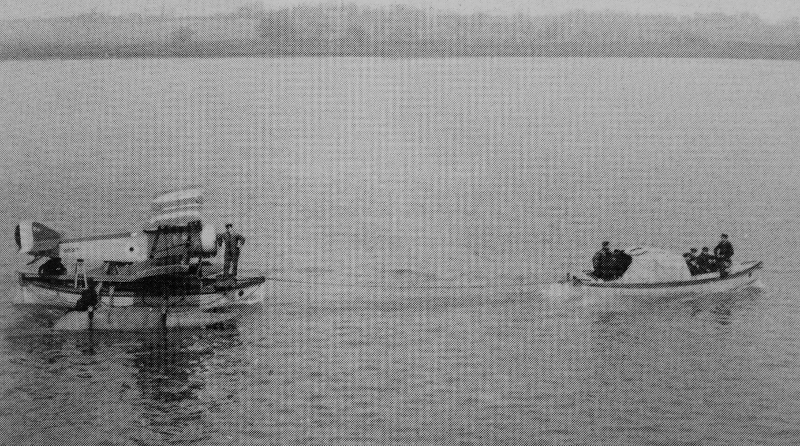
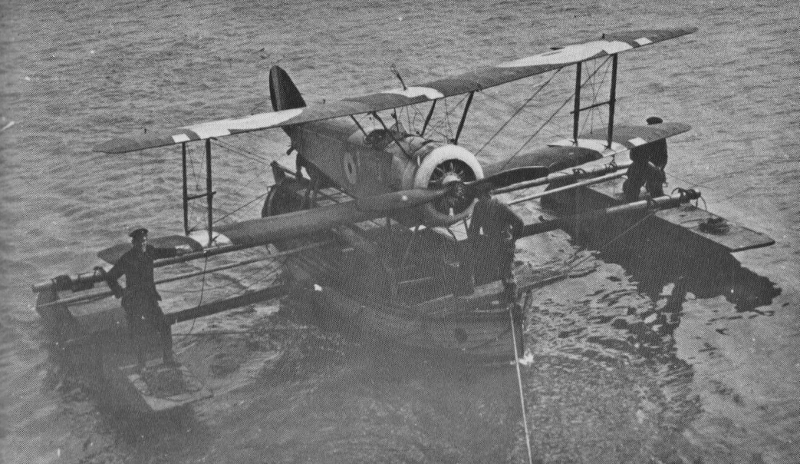
The Battle of Arras begins on 4th April with mostly Canadian soldiers aiming to capture Vimy Ridge supported by four squadrons of BE2s, a squadron each of FE2s and Nieuport scouts, 43 Sqdn with Sopwith ‘Strutters’ and 8(N)Sqdn with Sopwith ‘Triplanes’. Of 17 other squadrons along the Arras battle front the only other Sopwith Squadron is 70 with its ‘Strutters’. On 4th April 43Sqdrn ‘Strutter’ A2398 crashes on take-off, A2410 runs into a Nieuport on landing, 45Sqdrn ‘Strutter’ A1095 is wrecked on take-off and 1(N)Sqdn ‘Triplane’ N5439 overturns.
In northern France ‘Strutter’ equipped RNAS 4 & 5 Squadrons originally A & B Squadrons of 5 Wing at Coudekerque are now separated with 4(N)’s fighters at Bray Dunes and 5(N)’s bombers at Petite Synthe mostly for night bombing. “The ‘Strutter’ is a delightful aircraft for night bombing, being so stable and having an adjustable empennage, one can fly hands off ad lib in the quiet, bump free conditions usually experienced at night.” On 5th April 5(N)Sqdn ‘Strutter bombers’ start night raids on a rail junction near Bruge. Several never get off the ground in the mud (below) breaking more propellers. In the first three days at Petite Synthe fifteen propellers are split attempting take-offs in the appalling mud.Most fail to find the target in the poor visibility and bring bombs home. One bombs Bruges.
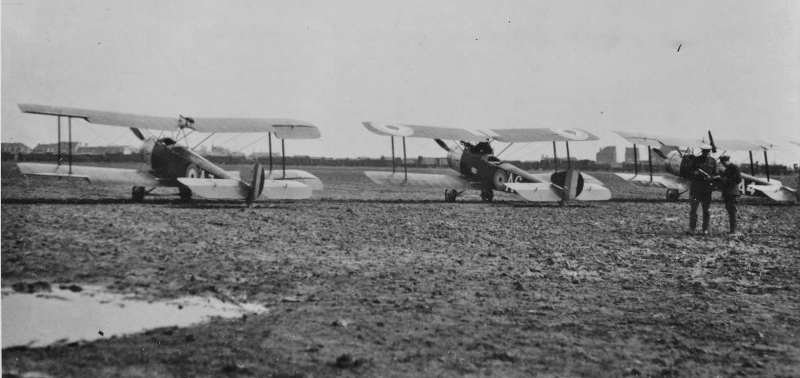
In the Aegean four ‘Strutters’ of RNAS E Sqdn from Hadzi Junas intercept 12 German twin-engined bombers, pursuing and harrying them for 45 minutes. ‘Strutter’ N5111 is damaged and put out of action.
On the Western Front the first Bristol F2A two-seat fighters enter service. With their 190hp Rolls Royce engines they are a step forward from 110/130hp ‘Strutters’. However, depending solely on their rear gunners for defence, their first patrols are a disaster with four shot down on the first day.
70Sqdn ‘Strutter’ A385 is wrecked in a forced landing whilst A2412 crashes on take-off. 43Sqdn ‘Strutter’ A1073 has its controls shot away in combat with several enemy aircraft whilst on a special mission. The observer is fatally injured and the pilot taken prisoner from the captured aircraft. (below surrounded by German soldiers, two still wearing pickelhauben).
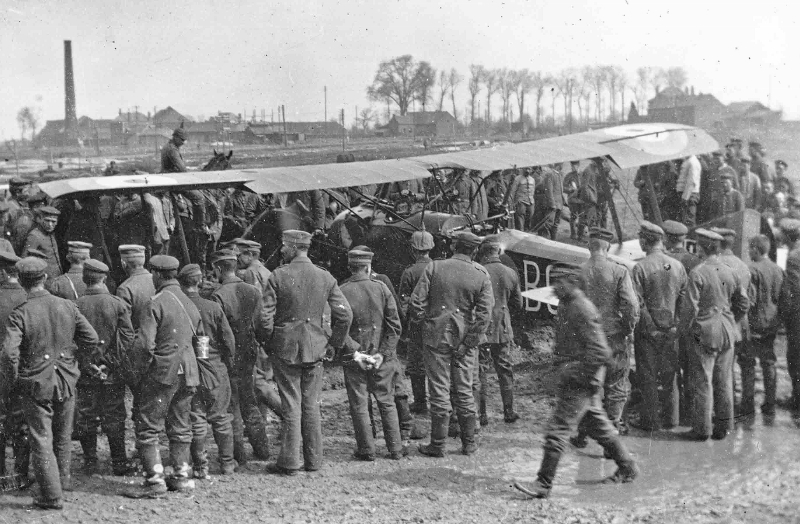
54Sqdn ‘Pups’ A636, A668, A672, A673 & A6166 share the downing of a kite balloon in flames and start a new tactic of low level strafing enemy ground troops on their way home. They hit a cavalryman and his horse and scatter a group of 100 soldiers unloading a freight train. 3(N)Sqdn ‘Pup’ A6158 claims a victory whilst N6209 is forced to land with an engine failure. 1(N)Sqdn ‘Triplane’ N5436 claims an Albatros victory but N5450 overturns on landing.
By 5th April the Germans have withdrawn from part of their front lines to the 25 miles shorter, heavily fortified Hindenberg line. They have flattened and destroyed everything to leave behind a barren wasteland.
On 6th April the USA declares war on Germany triggered, not least, by U-Boats sinking ten American ships.
Twelve ‘Strutters’ are being added to anti-submarine forces around the western approaches, four each at Prawle Point and Mullion on the southern tips of Devon and Cornwall and four at Pembroke in south west Wales. ‘Strutters’ might be able to go out in weather unsuitable for the existing floatplane and airship patrols.
On 6th April 45Sqdn ‘Strutter’ A1075 claims two victims before it is hit by AA fire and wrecked on landing whilst 7806 is lost in combat and both crew killed. A1093 is seen to lose its wings in a collision at 10,000ft with A2381, three crew are killed and the fourth dies of his wounds. A1077 is wrecked crashing after its propeller is hit. There are reports that 70 Sqdn’s 9421 is shot down.
3(N) Sqdn ‘Pups’ including A6158, N5199, N6160 & N6178 escorting a BE bombing formation, attack and shoot down all four Halberstadts manoeuvring to dive on the bombers.
One month after setting out for France RFC 66Sqdn ‘Pups’ go into action driving off three enemy machines from attacking artillery spotting aircraft and shooting one observer out of his cockpit. Meanwhile 54Sqdn ‘Pups’ A6156 & A6158 claim a victory each whilst A6165 gets rather shot up but survives.
1(N) Sqdn ‘Triplanes’ N5422 & N5444 each claim a victory. N5448 is shot down and the pilot killed after being saved in earlier combat by N5444 whilst N5457 is forced to land after combat at 12,000ft and the pilot is taken prisoner. These are the first losses of any 1(N)Sqdn ‘Triplanes’.
On 7th April 8(N)Sqdn ‘Triplanes’ N5455 & N5469 each claim a victory whilst 43Sqdn ‘Strutter’ A977 crashes landing from gunnery practice. Two flights of escorted 5(N)Sqdn ‘Strutter bombers’ raid Zeebrugge Mole and one has a cylinder blown off his engine by a high explosive AA burst. It jams inside the engine cowl but with a strong following wind he is able to glide back to Petite Synthe.
Surviving 100hp Sopwith ‘Schneider’ floatplanes are steadily being deleted, this week it is 3748, 3753 & 3791.
Prototype ‘SF1 Improved Baby’ landplane N5 has been rapidly repaired. It is at Eastchurch on 7th April when an instruction is raised on Sopwith to fit floats and a split fuselage like the wrecked N4 to continue the sea trials.
On 8th April the controls of 43Sqdn ‘Strutter’ A2406 are hit in combat during a Line Patrol. They glide down through cloud and crash land near Vimy Ridge, the observer is killed and the pilot taken prisoner. 7779 stalls and crashes on take-off. A8214 is crashed and deleted at the RFC Depot at St Omer after just 4hrs 15mins flying from new. 66Sqdn ‘Pups’ A6155, A7305 & A7314 each claim a victory whilst A675 is wrecked forced landing in a shell hole and A6162 is wrecked after an engine failure. 3(N)Sqdn ‘Pups’ N6169, N6174 & N6182 all claim victories as do 1(N)Sqdn ‘Triplane’ N5436 and 8(N)Sqdn ‘Triplane’ N5458.
Also on 8th April and three days after the previous engagement with German twin-engined bombers over Salonica, ‘Strutter’ N5224 of E Sqdn forces down a Friedrichshafen and the three crew are captured.
On 9th April 8(N)Sqdn ‘Triplane’ N5469 claims a victory whilst N5478 crashes on landing and 9(N)Sqdn ‘Pup’ N6201 crashes on take-off.
On 10th April in England 71(Australian) Squadron ‘Strutter’ A1113 suffers a bad crash and the Australian pupil is killed with his instructor from 28 Training Squadron. In France 3(N) & 8(N)Sqdn ‘Pups’ N5184, N5186 & N5187 are all written off in ground accidents, N5184 apparently hitting a plough.
On 11th April Canadian Joe Fall in A6158 claims three victories, the third by throwing his badly shot up ‘Pup’ into a loop at low altitude to get onto the tail of his pursuer. N6166 claims a victory and N6181 claims two. Quite a day for 3(N) Sqdn but N5199 is badly shot up, 9898 is blown over after landing and N5185 is wrecked.
Some RFC ‘Pup’ pilots are still complaining of tail heaviness, apparently accentuated by the introduction of ash for spruce longerons. Sopwith have slightly altered the stagger of the wings, others have gone further and are planning to increase the incidence of the tailplane. They are told that there is great danger of the aircraft becoming uncontrollable in a steep dive and are advised to cut a hole 10-12 inches wide and 12-14 long in front of the rear spar in the centre of the top wing although nobody has tested the effect on performance at altitude. Interchangeability of ‘Pup’ spares is becoming a real problem for repairers in the field. There are variations of 1½inches in the length of interplane struts between Standard-built and Sopwith-built machines and ½inch difference in Whitehead and Beardmore rear interplane struts from Sopwith and Standard ones, all impacting on the length of the interplane wires. It has also been discovered that Standard built engine bearer spares will not fit Whitehead ‘Pups’. Those are arriving with single rudder cables needing to be doubled in the field.
On 12th April French Sopwith ‘Triplanes’ SP10 (F3) & SP19 (F10) jointly claim an Albatros C destroyed and 3(N)Sqdn ‘Pups’ are in the thick of the action again whilst protecting FEs from attack by groups of up to eight hostile aircraft. A6158 claims three victories before getting badly shot up and forced to land, N6171 shares two victories with N6178 and the pilot of N6172 shoots down an Albatross DII before being shot down himself and taken prisoner. Meanwhile ‘Baby’ floatplane 8213 is badly damaged landing at Calshot and will be deleted.
On 13th April 43Sqdn ‘Strutter’ A1100 is damaged landing from a Line Patrol with jammed rudder controls whilst A961 has its engine choke during formation practice and is wrecked. 45Sqdn’s 7774’s propeller hits the ground on take-off and 70Sqdn’s A8210 crashes on take-off with just 2hrs 22mins flying. All but A1100 are considered “not worth reconstruction”. 66Sqdn ‘Pup’ A7305 claims a two-seater driven down whilst A7320 collapses its undercarriage taking-off downhill and slightly cross-wind in another aircraft’s slipstream.
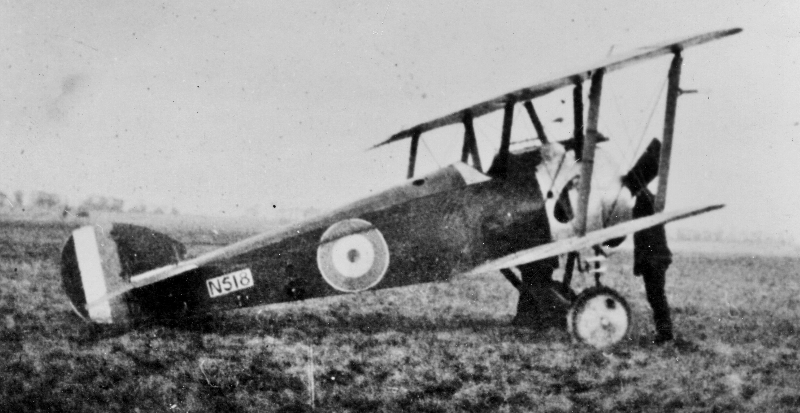
On 13th April the second of the Admiralty purchased 130hp Clerget ‘F1 Camel’ prototypes N518 which arrived at Hendon from Brooklands two days ago arrives at Martlesham Heath for performance testing. (above) Apart from the one-piece top wing N518 appears very similar to the drawings for the 300 production ‘F1 Camels’ already on order from Sopwith and Ruston Proctor.
RNAS 3 Wing at Luxeuil has had its disbandment postponed to allow it to make a bombing raid on the German town of Freiburg in reprisal for recent U-boat torpedoing of two hospital ships. On 14th April twenty five British and fifteen French aircraft make two attacks aimed at the centre of the town. ‘Strutters’ 9667, N5117 & N5171 are all shot down, the three observers are killed in action and the three pilots taken prisoner, one dying of his wounds. N5501 is hit by AA fire and wrecked in a forced landing.
A German analysis concludes that the effect of the comparatively infrequent Anglo-French strategic bombing raids from Luxeuil should not be judged by the material results. “They went some way to shake the morale of the industrial population and had an effect on the output of munitions, but chiefly they compelled the Germans to divert aeroplanes, labour & material to the beginnings of widespread schemes of home defence.”
On 14th April 5(N)Squadron ‘Strutters’ are out early bombing Zeebrugge Mole but one crashes on landing and two land out with engine trouble. 43Sqdn ‘Strutter’ A970 crashes on take-off after its propeller strikes a ridge. Over the Western Front 1(N)Sqdn ‘Triplane’ N5440 claims a victory as does 8(N)Sqdn’s N5482 and N5464 claims two. 54Sqdn ‘Pup’ A6168 claims a two-seater out of control whilst A661 is shot up and the pilot wounded. 3(N)Sqdn ‘Pup’ N6171 is caught by the wind in front of the sheds and overturned but not badly damaged.(below)
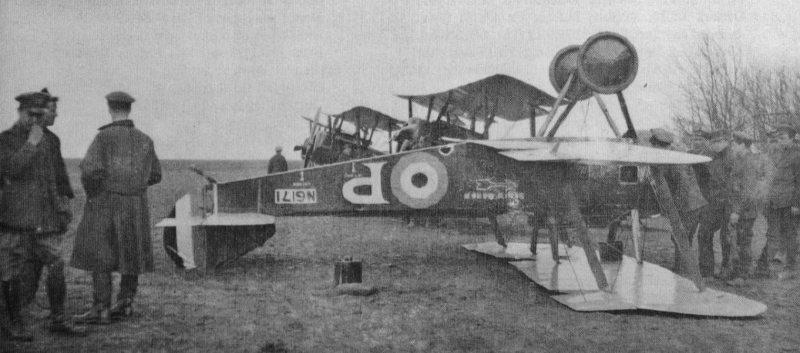
On 15th April ‘Pup’ A653 is at Martlesham Heath for performance trials. It has been retro-fitted by the RFC with a 100hp Gnome Monosoupape engine. Like most popular engines the 80hp Le Rhône has always been in short supply, 253 were obtained during last year, 142 from French sources and 111 from W H Allen of Bedford but they are now concentrating on the 110hp Le Rhône. With 250 ‘Pups’ still on order some alternative engines are clearly needed. Weighing 303lbs against the Le Rhône’s 268lbs, the Monosoupape tests show the same climb rate and a slightly lower top speed at 10,000ft despite the 25% higher nominal power rating.
This week the now 300 plus workforce at Morgan & Co in Leighton Buzzard finally deliver their first ‘Strutter Bomber’ A5950 to the RFC having had an order for 200 since June 1916. With only a three month head start on Morgan, Ruston Proctor have built over 200 of their 350 ‘Strutters’ for the RFC and are rewarded on 16th April by a 100 increase to their follow-on ‘F1 Camel’ orders now also amounting to 350 machines.
The first Fairey ‘Hamble Baby’ N1190 arrives at RNAS Grain, it has been built by George Parnall & Co in Bristol.
On 16th April from Great Yarmouth, 9910 is one of the first Beardmore-built ‘Ships Pups’ to go out on a hostile seaplane patrol.
In France 43Sqdn ‘Strutter’ is “lost in action” whilst on a reconnaissance mission, the observer killed and the pilot taken prisoner. The pilot of 66Sqdn ‘Pup’ A6170 is injured in a forced landing whilst the pilot of A7321 is unhurt when he forced lands out of fuel running into a barbed wire fence and overturning. Rolled back upright his ‘Pup’ is a write-off.(below)
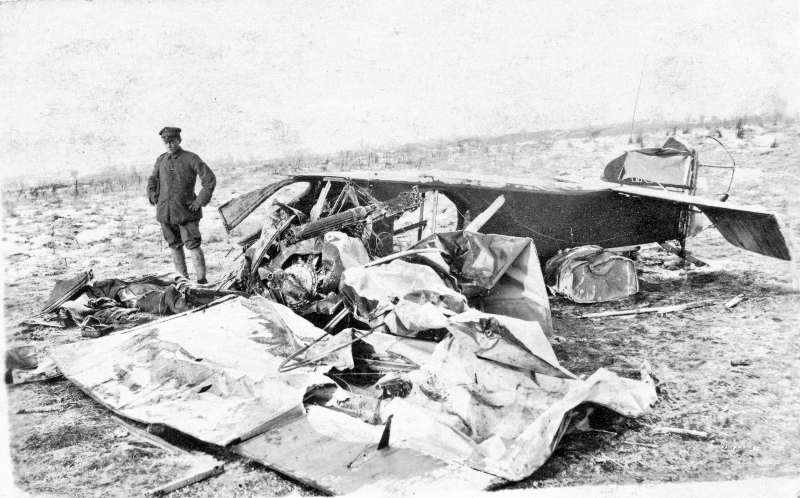
The 17th April Sopwith Board Meeting fixes the Company Seal to conveyances and assignments of leases for the purchase of 48 to 100 Canbury Park Road, a terrace of twenty-six properties along the south side of Canbury Park, backing onto the railway and immediately opposite the existing aircraft factory. (The current occupiers of these properties include a wardrobe dealer, a tailor, three confectioners, a bootmaker, a cycle maker, a hairdresser and a fishmonger. There is also a laundry and Powell’s Dining Rooms.) It is agreed that there will be an Extraordinary General Meeting 25th April to pass a retrospective resolution that “Directors are authorised to borrow or raise such sums as they deem necessary for the purpose of the Company otherwise than by the issue of share capital notwithstanding that the amount remaining undischarged may at any time exceed the issued share capital of the Company”. Mr H S Musgrave, already Company Secretary, is appointed “Secretary and Organising Manager” from 17th March 1917. Preference shareholders will be paid an interim dividend of 6% per annum for the half year to 31st March 1917. The meeting also authorises powers to apply for patents in Italy, Russia, Argentina and Brazil for seven existing Sopwith British patents, for four of those in Australia, New Zealand and South Africa, and for two in France and Belgium. The patents involved are 15617/16 to 15621/16 covering ‘Axle Design’, ‘Wind (Air) Brakes’, ‘Empennage Operation’, ‘Windscreens’ and ‘Gunner’s Seat’ plus those for ‘Attachment to Cables’ and ‘Kauper Gun Gear’. There is also approval for the assignment to the company of “Patent 13501 K.F. Relief Valve”.
On 18th April at Grain ‘Ships Pup’ 9901 is tested with airbags inflated in preparation for ditching experiments.
On 18th April Aeroplane journal announces that Thomas Tyrer and Co Ltd are shortly to open a new works on Petersham Road in Richmond upon Thames to cope with increased demand for their Cellon cellulose aircraft dope and dope coverings. “The output will be many times greater than their current Stratford Works”. This is just two miles from the Sopwith Works in Kingston upon Thames.
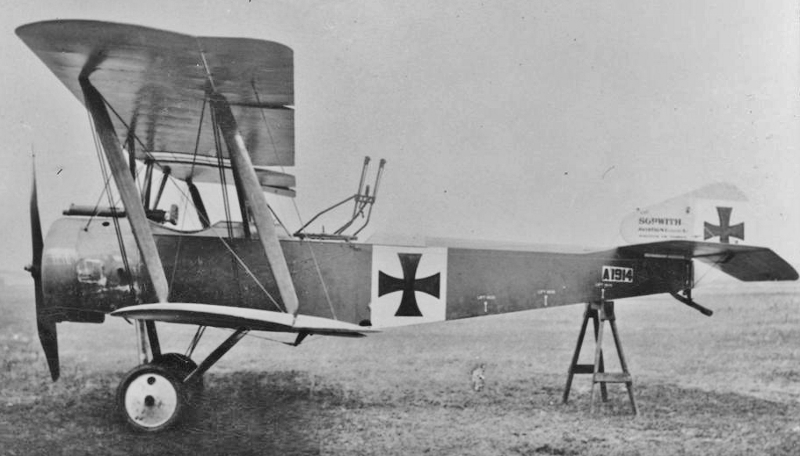
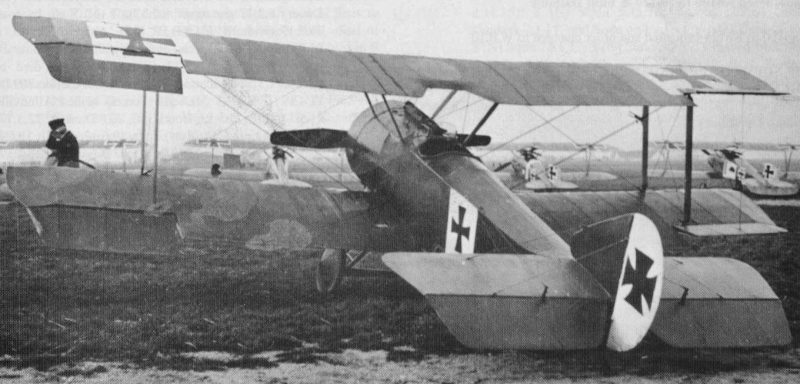
Photographs (above) have emerged of captured Sopwith aircraft in German markings – ‘Strutter’ A1914 at Alderschof after it was captured last September when the pilot got lost on its delivery flight, ran out of fuel and landed in German territory and 3(N) Sqdn ‘Pup’ N6161 shot down 1st February this year. Both pilots are prisoners of war.
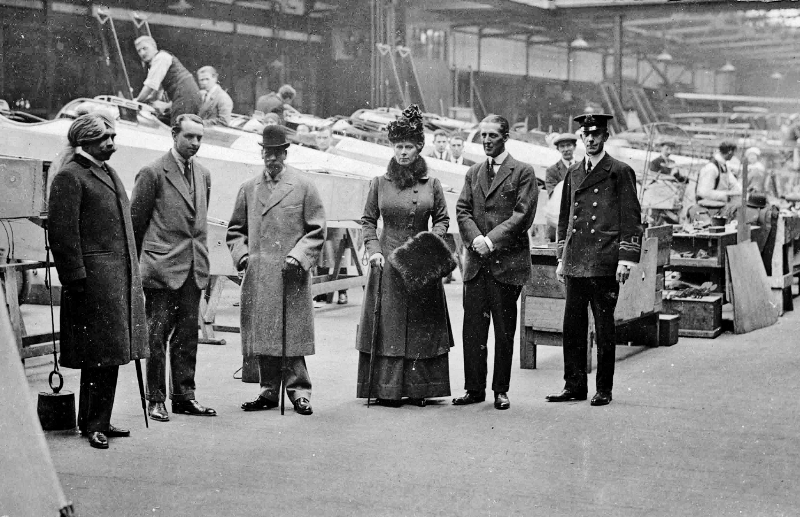
On 19th April 1917 King George V and Queen Mary visit the Sopwith factory in Canbury Park Road with the Maharaja of Bikanir and Cpt Forbes Davison who accompany them in the drive over from Windsor. They spend an hour and a half touring the workshops guided by Chairman Thomas Sopwith, General Manager Reg Cary and Works Manager Fred Sigrist. Most of the photographs are taken with the Sopwith ‘Triplanes’ in the main aircraft erecting shop which runs the full length of the south side of the factory.
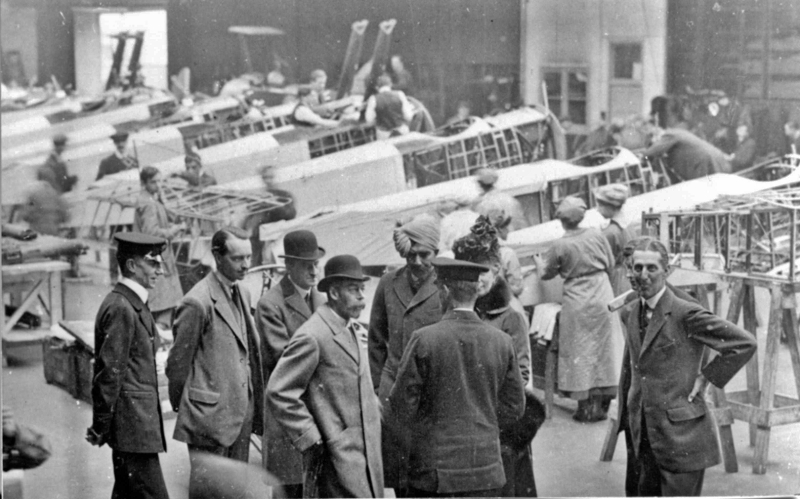
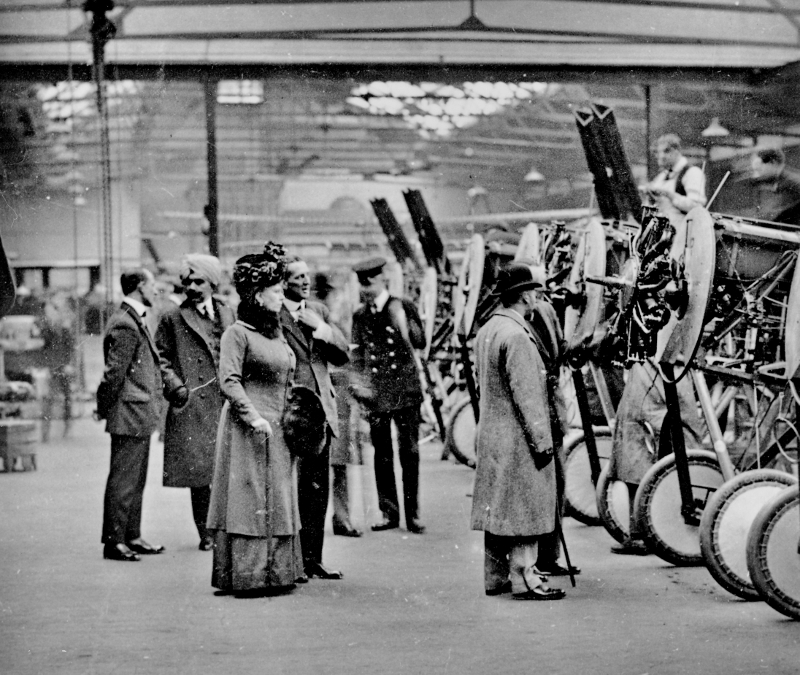
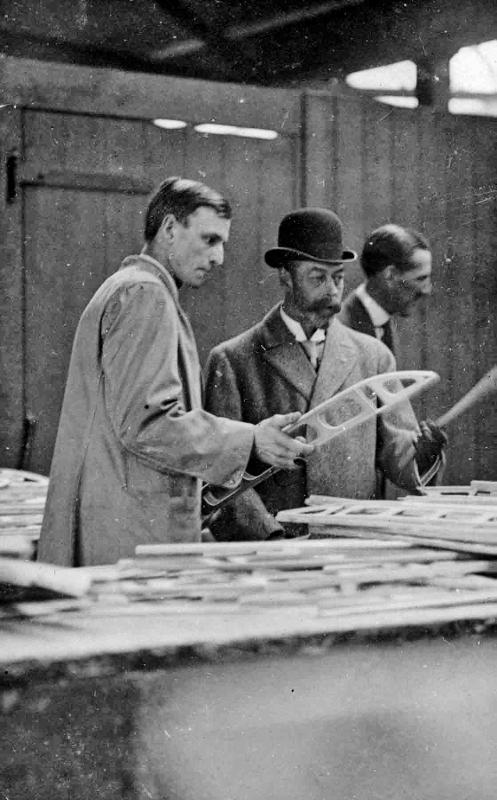
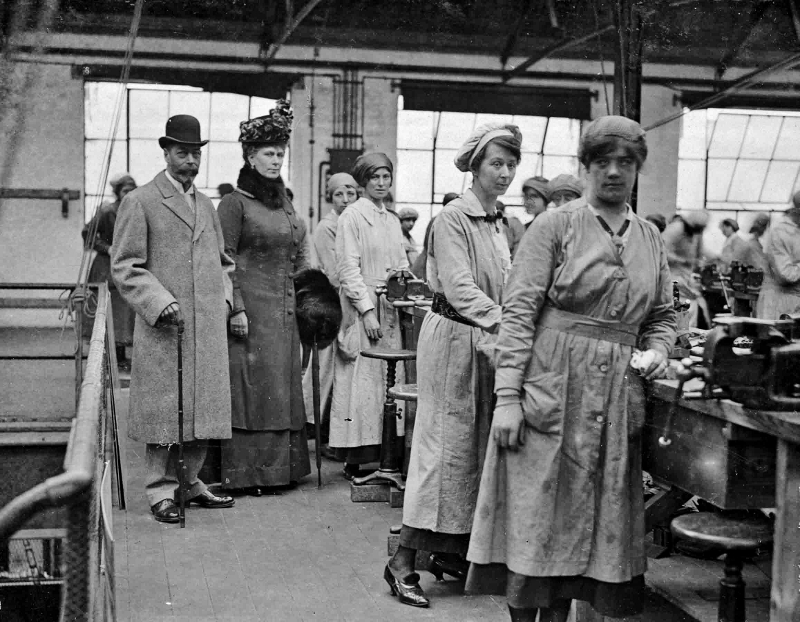
There is time to visit the even larger, two-storey component workshops behind, where photographs upstairs show the wing rib shop and large numbers of women at workbenches each with a vice and adjustable height stool. 20-year-old Edith Brockwell who works with her two sisters making wing ribs and whose blacksmith father works in the metal fitting shop says “We are told not to look up, just carry on. But I happen to notice that Queen Mary has long, narrow feet with pointed shoes. She is wearing a lovely heliotrope toque with flowers on”.
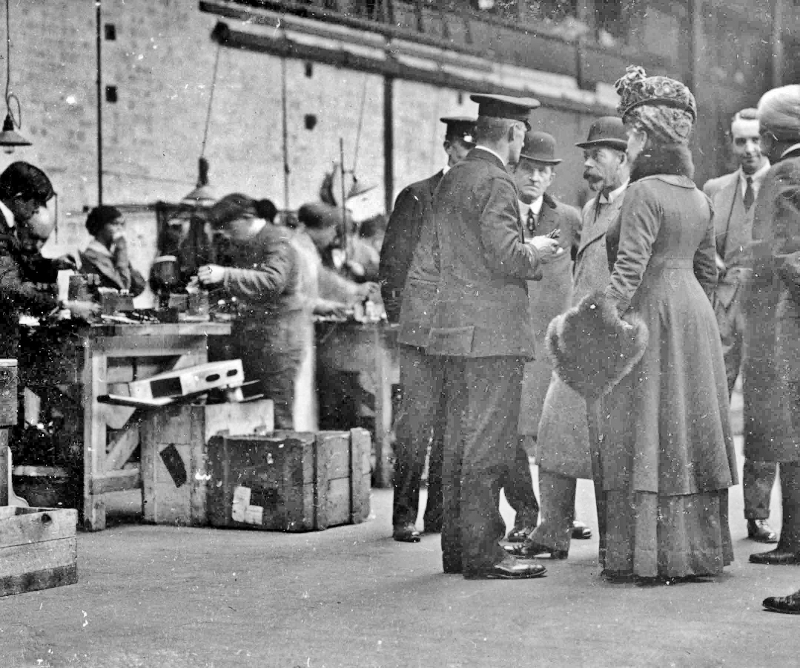
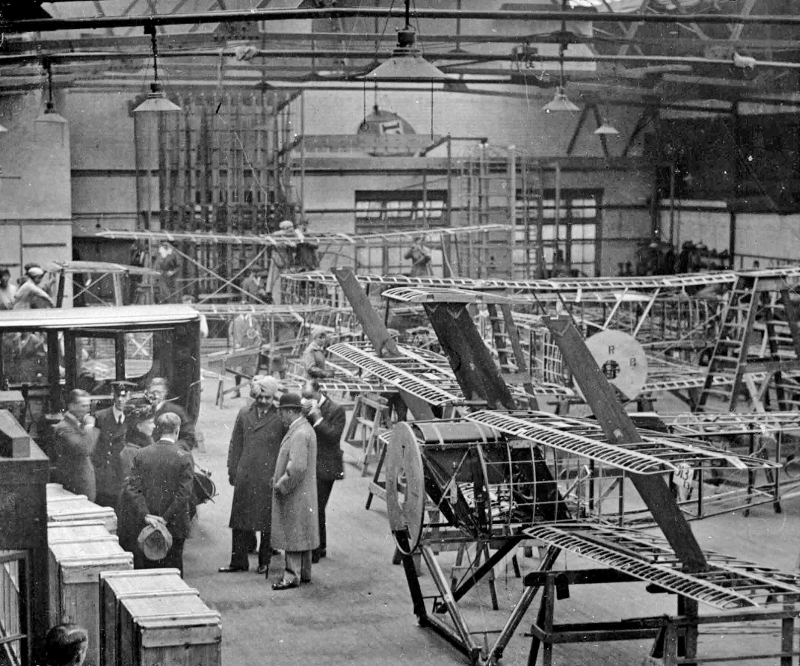
With the royal limousine backed right into the factory ready to leave, the royal party are shown the start of the new ‘Camel’ production line and on the spur of the moment Thomas Sopwith asks the King if he would like to see one flying on his way back to Windsor. The KIng agrees and Sopwith leads the way to Brooklands were Harry Hawker gives “an active demonstration of the remarkable capabilities of the machine”.
This same day Sopwith submit plans to Kingston’s Borough Surveyor for a 15,000sq ft timber shed on the site of fifteen of the recently acquired properties backing on the railway line on the south side of Canbury Park Road.
Aeroplane journal continues to publish S Harris’ caricatures of life in the factory. This recent one shows the satisfied proprietor in front of his production line whilst employees struggle and race around, and groups of military inspection officers engage in heated theoretical arguments.
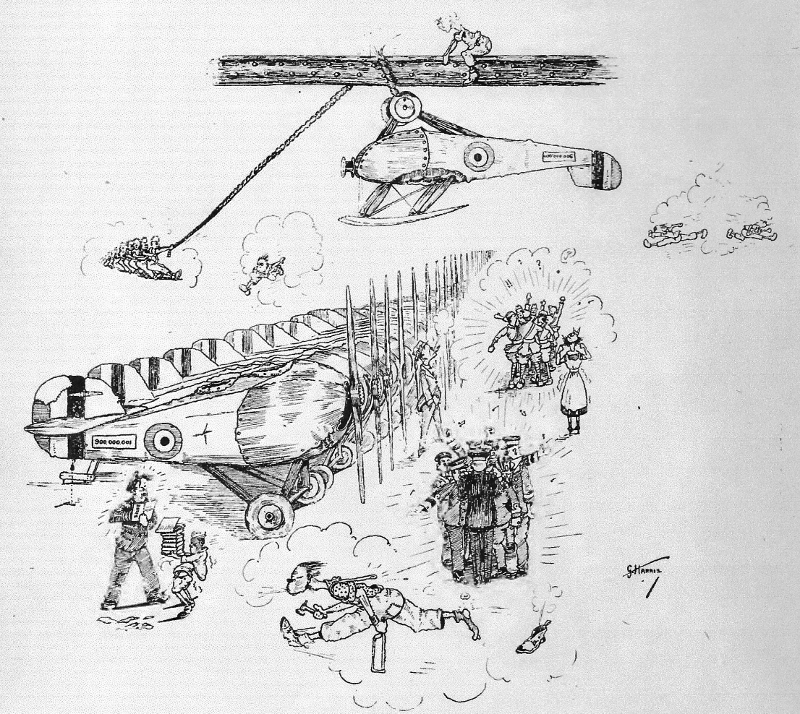
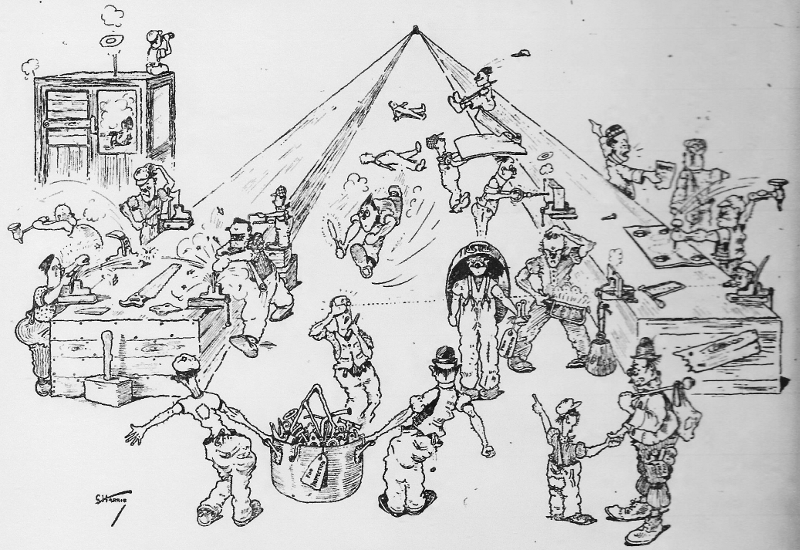
Another recent S Harris cartoon shows the endless benches of a metal fitting shop. On the left a woman files gently whilst the massive filer opposite her whistles loudly in a cloud of sparks. On the other bench the puzzled worker with the red hot saw has the blade teeth the wrong way round. In the foreground workers carry a tub of fittings for inspection and another returns, empty tub on head, with just one good one. They all need to watch out for the man with the red hot soldering iron. A shop-boy is accurate with his pea-shooter, another is keeping a look out on top of the locked office whilst the foreman has a quiet snooze and a smoke.
In Melbourne on 19th April the Coroner asks James Watson whether he has a theory on what happened to cause his son Basil Watson’s homebuilt Sopwith ‘Sparrow” to fail. He replies “We discovered that one of the main clips of the centre plane had given away. Extra wires had been attached to strengthen the centre plane, and I have come to the conclusion that if the eye bolt had not been put though the clip, and the lug which was put there for the purpose had been used, the centre plane would not have lifted”. Once the clip broke the wires slackened and there was no hope. The Coroner records a verdict of Accidental Death.
On 19th April at Port Said EI&ESS ‘Baby’ N1028 is damaged in a collision. In bad weather in France ‘Strutters’ 7762 & A971 are wrecked as is new ‘Triplane’ N5362 just two days from arriving at Chingford.
On 20th April 43Sqdn ‘Strutter’ A1098 is hit by ground fire, both crew are wounded and taken prisoner. 7791 crashes near Calais on delivery from England whilst 1(N)Sqdn ‘Triplane’ N5459 is wrecked in a collision with an RE8 whilst taking-off at Bellevue.
On 21st April 5(N)Sqdn ‘Strutter’ 9395 is wrecked. 3(N)Sqdn ‘Pup’ N6169 claims a DFW and an Albatros, N6182 & N6203 an Albatros each and N6208 a two-seater. 8(N)Sqdn ‘Triplane’ N5458 sends an Albatros DIII with wings folding and breaking off, N5469 claims a Halberstad DII whilst 10(N)Sqdn’s N5357 is damaged landing.
French ‘Triplane’ SP12(F2) disturbed by a violent gust of wind from the surrounding dunes, bursts a tyre, collapsing the landing gear damaging the machine beyond repair The following day the same happens to SP9(F1). (below left with the pilot still in his cockpit)

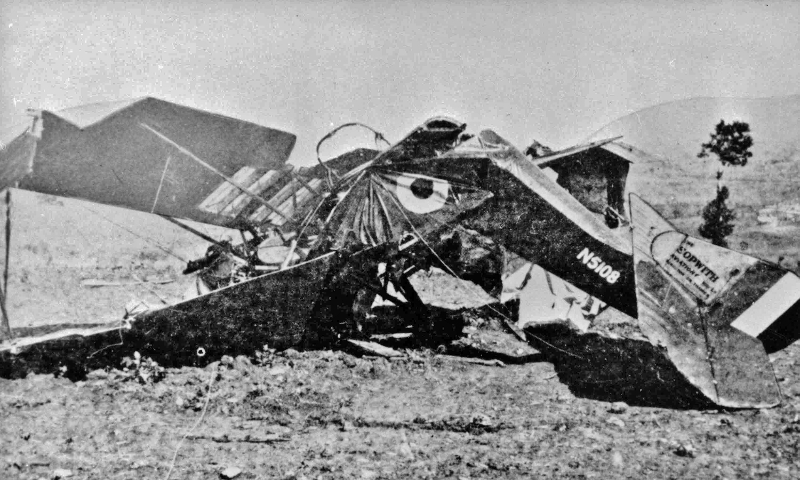
On 22nd April in the Aegean ‘Strutter’ N5108 is shot down, Von Eschweger’s fourth victory. (above right) The mechanic/observer in E Flight’s N5087 is wounded in combat on a raid on troop bivouacs.
In France 5(N)Sqdn ‘Strutter’ 9376 forced lands in Zeeland with an engine failure and the pilot is interned by the Dutch. 43Sqdn’s ‘Pup’ A2388 is wrecked on the ground by a propeller burst. 66Sqdn’s ‘Pup’ A7303 claims an Albatros as do 3(N)Sqdn’s N6160 & N6171, 1(N)Sqdn’s ‘Triplanes’ N5436 & N5444 and 8(N)Sqdn’s N5477.
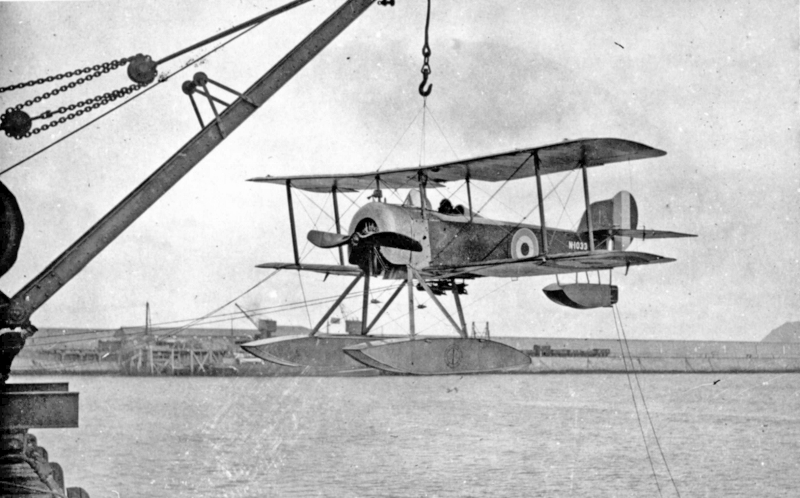
At home N1033, one of the latest Blackburn-built ‘Baby’ floatplanes with a revised wing section was delivered to the new RNAS anti-submarine station at Milford Haven yesterday. (above) Today it banks on take-off and strikes a cliff, the pilot being badly burnt when the two 16lb bombs underneath him explode.
On 23rd April ‘Baby’ 8171 is shot down six miles North East of Dunkirk. 70Sqdn ‘Strutter’ A878 is wrecked in a crash landing. 4(N)Sqdn ‘Pup’ 9929 also forced lands whilst 66Sqdn’s A663 claims two Albatros victories and A7303 & A7329 one each. 3(N)Sqdn’s ‘Pups’ N6179 & N6208 claim two Albatros each, N5194, N6160, N6171, N6181, N6194, N6202 & N6205 one each whilst N6169 shares one with N6182 & N6208. N6181 ‘Happy’ also forces a twin engined Gotha bomber down and the crew are captured. 1(N)Sqdn’s ‘Triplanes’ N5426 & N5436 claim an Albatros each but N5356 hits a tree and N5432 crashes after an engine failure.
On 24th April 70Sqdn ‘Strutter’ A1002 goes down in flames killing the crew and 43Sqdn’s A1076 crashes on take-off. 54Sqdn ‘Pup’ A669 stands on its nose and falls on its back when civilian helpers run away from holding back the machine the moment the engine re-starts whilst A7312 claims an Albatros, 3(N)Sqdn’s N6169 shares one with N6184 & N6208 and 4(N)Sqdn’s N6200 claims Fokker DII. 66Sqdn ‘Pup’ A670 is damaged forced landing, A6152 & A7305 are badly shot-up whilst the wounded pilot of A6175 is taken prisoner after being brought down with damaged engine and his controls shot away. (below, note all ailerons hanging down)
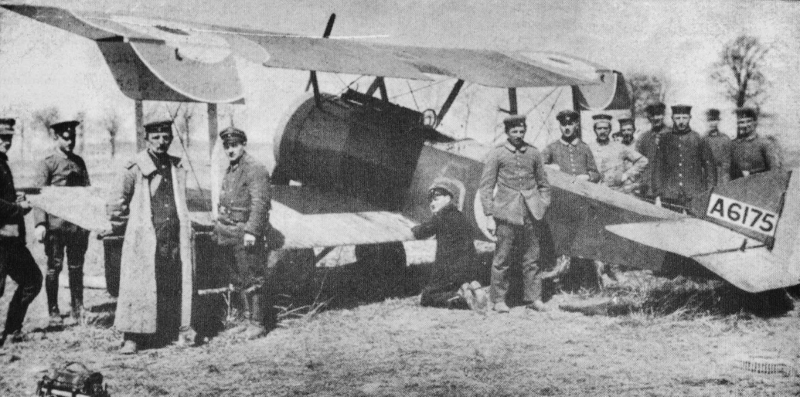
1(N)Sqdn ‘Triplane’ N5440 claims two Albatros and N5436 claims one as does 8(N)Sqdn’s N5460. N5469 claims an Aviatik but N5467 is shot down by three Albatros and the pilot killed. French ‘Triplanes’ SP10 & SP16 share a victory near Nieuport. At home HMS Campania’s ‘Baby’ 8172 is wrecked.
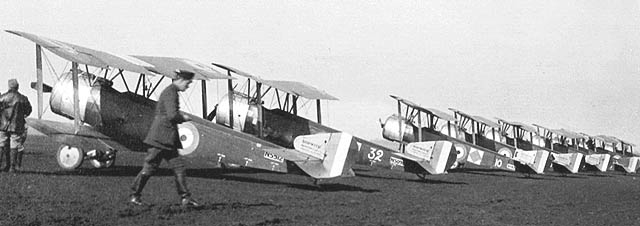
Over the past week as RNAS 3 Wing end their strategic bombing mission at Luxeuil they have transferred fifty-eight more of their ‘Strutters’ mostly bombers to the French. (above) Twenty-five are without engines.
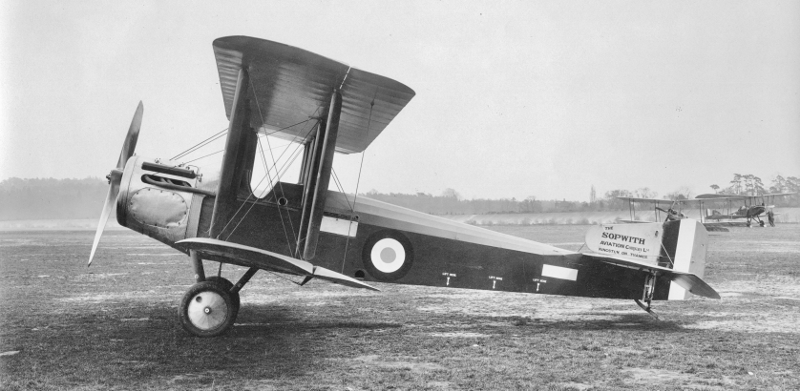
A new Sopwith designed and built prototype is photographed at Brooklands. (above) The Sopwith ‘B1’ is a higher powered direct replacement for the single-seat ‘1½ Strutter Bomber’ clearly aimed at the French and already displaying French national markings. The 200hp geared V8 Hispano-Suiza engine is installed behind a circular radiator like the Sopwith Hispano-Suiza Triplanes this time last year. (Radiator not yet fitted in photo below left).
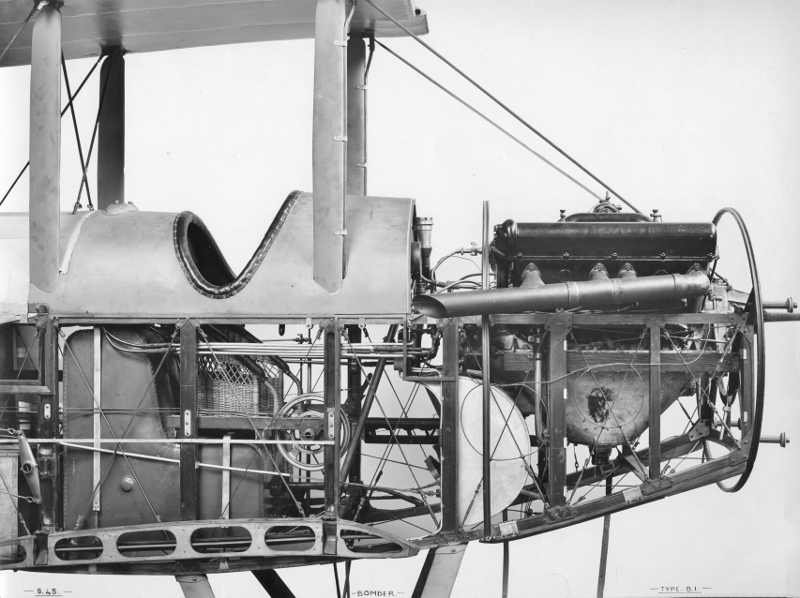
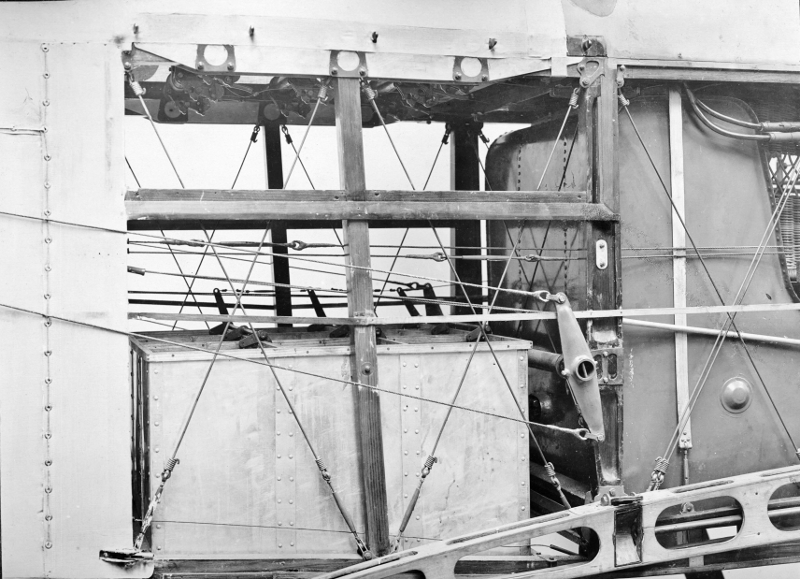
The pilot sits well forward to assist bomb aiming, his wicker seat mounted on the long-range ‘L’ shaped fuel tank. Behind that a bomb bay (photo above right) has vertical racks for nine British 50lb bombs carried nose up with the option of carrying twenty 28lb French ‘liquid-anilite’ bombs which mix liquids from two containers into a highly sensitive explosive during their decent. The overall length is only 2ft 6in greater than the ‘Strutter Bomber’ but with the heavier engine and 200lb extra bomb load the ‘B1’ has 40% more wing area achieved with a more conventional two-bay wing structure of 7ft greater span. Initial tests indicate 30% reduction in time to reach 10,000ft compared with 130hp ‘Strutter Bombers’ and speeds there of around 110mph against 97mph. The prototype has an adjustable tailplane for weight balance but carries no gun. (below)
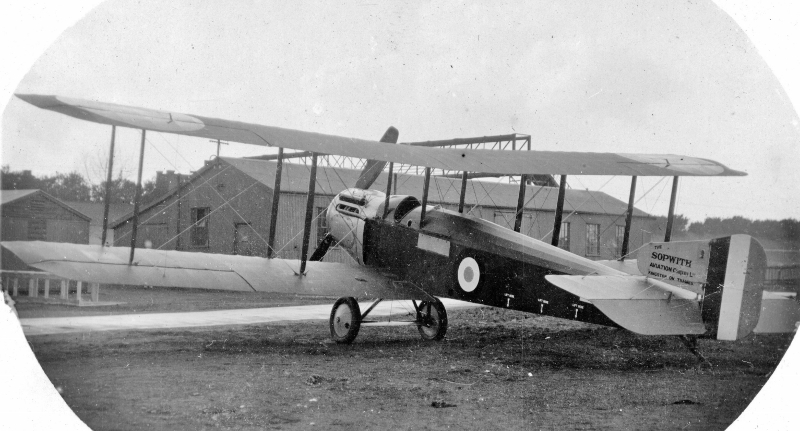
On 25th April 43Sqdn ‘Strutter’ A993 is lost in action with both crew taken prisoner whilst 7799 stalls and crashes on take-off killing the pilot and injuring the observer. 10(N)Sqdn ‘Triplane’ N5350 ditches off Boulogne with a failed engine, pilot and aircraft are retrieved by the French patrol boat Joyeuse. RFC 46Sqdn recently arrived at Boisdighem on the Western Front is starting to get ‘Pups’ and handing its Nieuport 20 two-seaters over to 45Sqdn as stop gaps for more ‘Strutters’ but they are 20mph slower with “leaden” controls response and considered only suitable for training.
On 26th April ‘Strutter’ N6503 is wrecked after just two days at Prawle Point in Devon injuring the pilot. Dunkirk based ‘Baby’ floatplane 8171 is shot down but the pilot survives. 4(N)Sqdn ‘Pup’ 9899, 54Sqdn’s A672 & A6156 all claim a victory as do 3(N)Sqdn’s N6202 & 4(N)Sqdn’s N6185 although N5183 crashes on landing. 8(N)Sqdn ‘Triplanes’ N5465 & N5482 also each claim an Albatros.
On 26th April the Dutch Luchtvaart Afdeling flies interned sea-water damaged 9(N)Sqdn Pup N6164 after repairs and borrowing an engine from a Nieuport. (below) Obviously patched up, the only distinguishing markings are fuselage bands and a plain painted rudder.
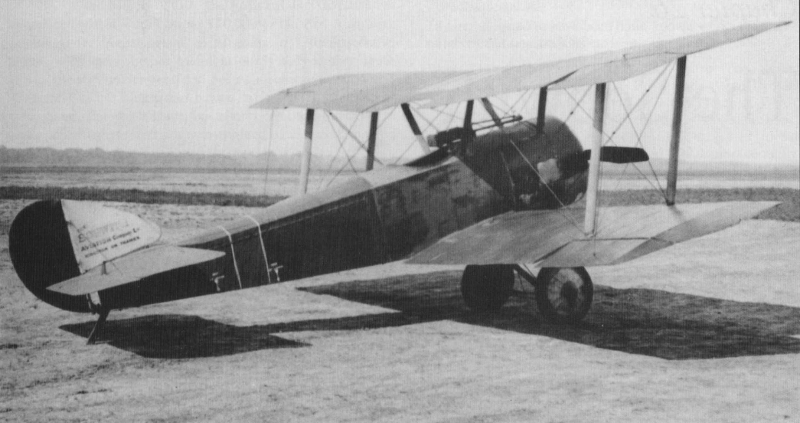
Five 5(N)Sqdn ‘Strutters’ resume their raids on Zeebrugge, one landing on a beach shot in the engine by a seaplane.
Over Salonica Strutters of E Sqdn intercept a mass raid by 16 German twin-engined bombers one of which is sent down.
Following the royal visit to Sopwith’s the editor of Aeroplane adds “It is eminently satisfactory that the King should have the opportunity of seeing the performances of some of the best British aeroplanes, as hitherto his attention has been directed with so much care to the alleged super-excellence of officially designed machines”.
Now, on 27th April, the King and Queen visit Martinsyde’s factory at Woking “passing through all departments as aeroplanes circle overhead including Mr Raynham on a new type performing manoeuvres”.
Elsewhere ‘Schneider’ 3738 is wrecked after a nose dive from 1,000ft over Gorleston, injuring the pilot. The pilot of 43Sqdn ‘Strutter’ A8235 is also injured after an engine failure over Vimy Ridge and a forced landing.
On 28th April 43 Sqdn ‘Strutter’ A993 is lost in action with the crew taken prisoner, A982 runs into A2405 which is “not worth reconstruction” and 45 Sqdn’s A992 is wrecked after an engine failure. The pilot of 10(N)Sqdn ‘Triplane’ N5438 is killed side slipping and crashing after take-off whilst 8(N)Sqdn’s N5493 claims a victory. Over Salonica ‘Strutters’ of E Sqdn again intercept a raid by German twin-engined bombers. They empty whole drums of Lewis gun ammunition into three of the four apparently without effect.
At Grain ‘Pup’ 9950, converted by Beardmore into the prototype S.B.III with folding un-staggered wings and retractable undercarriage has been rebuilt with other ‘Pup’ parts but without an engine. On 28th April it is subjected to experimental floatation tests with Mk1 inflatable underwing air-bags and Mk4 rear fuselage air-bags. (below)
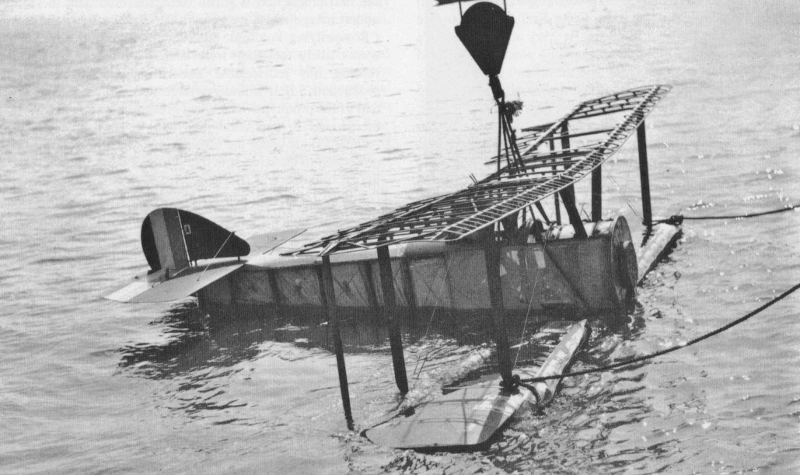
By adding a raised elevated platform behind the flying deck of HMS Manxman Fl Cdr Rutland has reduced ‘Pup’ take-off runs by half to less than 20ft. As a result the Admiralty approve the fitting of a short flying deck to light cruiser HMS Yarmouth. Meanwhile on 29th April Rutland flies ‘Pup’ 9918 from Manxman on a Zeppelin patrol but with compass trouble runs out of petrol before finding his ship and ditches off the Danish coast. His ‘Pup’ floats for 20 minutes, he is interned and repatriation will take time. Manxman’s 9920 is also lost at sea that day. Its pilot is recovered by HMS Patrician whilst Manxman’s 9917 & 9919 are badly damaged.
On 29th April In France 43Sqdn ‘Strutter’ 7799 stalls on take-off injuring the observer, A1000 crashes on take-off and catches fire, 70Sqdn’s 9683 is shot down and A976 is wrecked on landing. 5(N)Sqdn’s ‘Strutter’ 9896 is also wrecked. There are victories for 3(N)Sqdn ‘Pups’ N6179, N6181, N6182, N6203 & N6205 but the pilot of A6160 is killed in combat whilst N6162 is damaged by an explosive bullet. 1(N)Sqdn ‘Triplanes’ join in the same prolonged combat action, N5440 & N5427 claim victories, N5425 shares one with N5437 before overturning in soft ground on landing, N5446 claims one and shares another with N5493, N5484 claims one before an engine failure and forced landing, a fate also suffered by N5441 which is burnt by the pilot who believes he is behind enemy lines. The pilot of 8(N)Sqdn ‘Triplane’ N5463 is shot down and killed attempting to assist some BE2s.
On 30th April in France the observer in combat damaged 45Sqdn ‘Strutter’ A1080 is killed and A1064 is wrecked on landing. 3(N)Sqdn ‘Pup’ N6175 is shot down and the pilot killed whilst N6170’s has his seat shot away but survives a crash landing. 4(N)Sqdn ‘Pup’ N6185 claims a victory as does 54Sqdn’s A649 and 66Sqdn’s A7314 & A6177. A7329 is wrecked in a forced landing whilst the pilot of A7323 is injured crashing after colliding with a Bristol F2b at 2,000ft, the Bristol’s crew are both killed. 1(N)Sqdn ‘Triplane’ N5436 claims two victories, six in the month. 8(N)Sqdn ‘Triplane’ N5471 claims three victories on the day and N5493 another one. 10(N)Sqdn’s N5482 claims another one and N5490 its first whilst 9(N)Sqdn’s N5475 has an engine failure and forced landing.
At Dundee ‘Baby’ N1039 is wrecked whilst at Calshot one of the oldest surviving ‘Schneider’ floatplanes 3726 is finally deleted from service. Over a year ago it was one of the first fitted with a Lewis gun. (below)
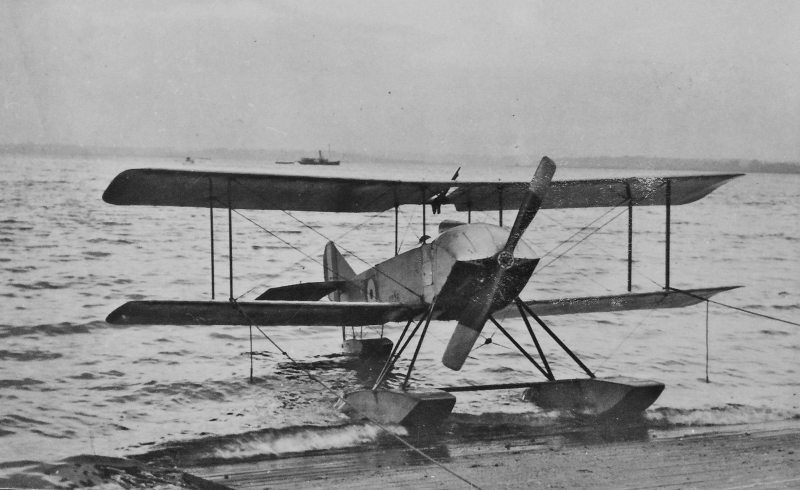
In April 1917 the total of new Sopwith designed aircraft from all suppliers is 226 : 102 ‘Strutters’, 80 ‘Pups’, 33 ‘Triplanes’ & 11 ‘Baby’ floatplanes. Sopwith’s production (excluding prototypes) in April is a record 53 machines comprising their very last ‘Strutter’ (after the last 12 are cancelled), 24 ‘Pups’ and 28 ‘Triplanes’. The other 173 Sopwith machines delivered in April are made up of 101 ‘Strutters’ (11 from Fairey, 12 Hooper, 9 Mann Egerton, 1 Morgan, 46 Ruston Proctor, 20 Vickers, 7 Westland and the first two from Wells), 56 ‘Pups’ (10 from Beardmore, 25 Standard Motors and 21 Whitehead), plus 5 ‘Triplanes’ from Clayton & Shuttleworth with 10 ‘Baby’ floatplanes from Blackburn and a first Fairey ‘Hamble Baby’ from Parnall.
The seven ‘Strutters’ from Westland Aircraft complete their orders for 75. Originally all to be bombers, these photographs (below) on their own new airfield at Yeovil show one of the last 20 which are all built as two-seaters.
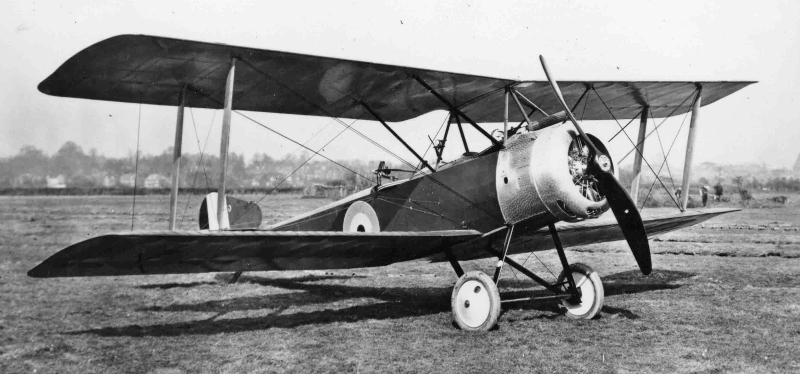
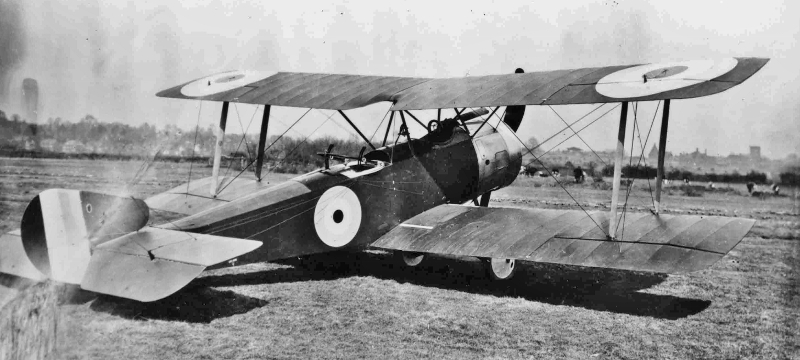
Sopwith are left with just 3 ‘Pups’ and 13 ‘Triplanes’ to complete in May alongside the first batch of ‘F1 Camels’. Since the Admiralty cancelled the order for 100 ‘Triplanes’ taken over from the RFC, Sopwith have been focussed on high-volume ‘F1 Camel’ manufacture. They are racing to complete the whole initial Admiralty order for 50 in May and carry straight on with another 200 despite the lack of a confirmed order.
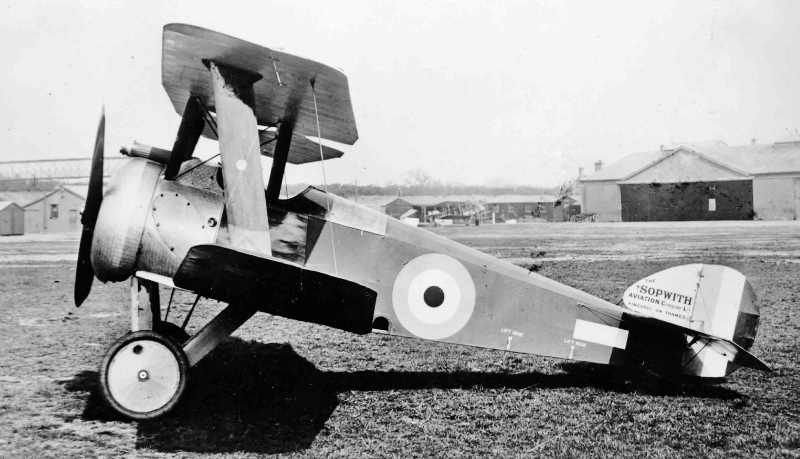
On the experimental side in addition to delivering the prototype ‘B1’ bomber to Brooklands in April another experimental ‘F1 Camel’ has appeared outside the Sopwith sheds at Brooklands. (above and below) It has twin Vickers guns under the latest flat-topped hump like B381 but this one has tapered wings, 5ft chord at the centre tapering to 3ft6in at the tips with single broad chord interplane struts thought to improve performance. The top wing is three-piece like the ‘FS1s’ and has an aperture. It has sturdier undercarriage struts.
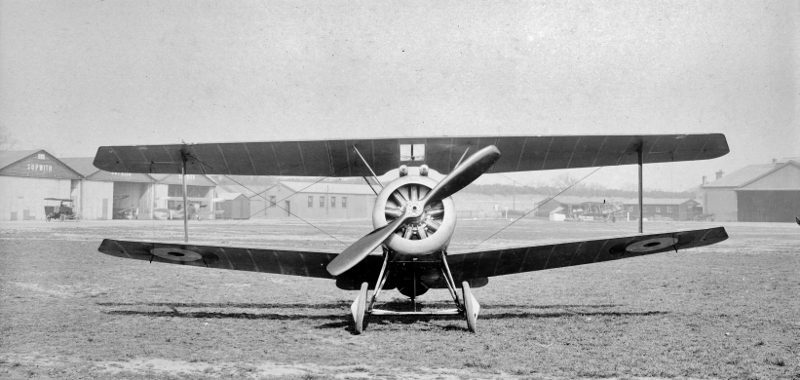
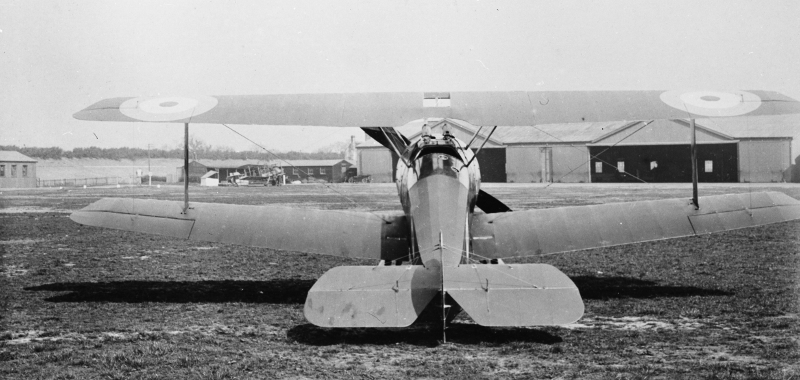
The two portable Bessonneau canvas hangars have disappeared from this location possibly because Sopwith’s final deliveries of ‘Pups’ and ‘Triplanes’ have recently started going directly from Kingston to RNAS Dover for erection and acceptance.
In the experimental shop in Kingston Sopwith are finishing the ‘T1’ torpedo bomber and the prototype V8 Hispano-Suiza powered ‘Dolphin’ high-altitude fighter. In the drawing office they have completed as a private venture the drawings for a 200hp Clerget-engined two-seat ‘Strutter’ replacement with the hope of French orders. They may be considering that engine for the new Air Board specification for “Aeroplane Type A1(a)” for a 135mph fighter for the RFC which demands much more power than existing rotary engines. Another contender might be the 200+hp Bentley BR2 rotary air cooled engine, an order for three prototypes has now been placed with Humber where Lt W O Bentley has been working since developing his largely aluminium alloy 150hp AR1 with Gwynnes of Chiswick. “Admiralty Rotary” AR1s now known as “Bentley Rotary” BR1s are in production at Humbers to go into Sopwith-built Camels for the RNAS in place of standard 130hp Clergets.
The Air Board specification “Aeroplane Type A1(a)” for a next generation of RFC fighters is quite a challenge for designers like Herbert Smith at Sopwith. It includes: “Speed 135 mph at 15,000 feet. Climb from 10,000 to 20,000 feet in 10 minutes. Limiting altitude not less than 25,000 feet. Landing speed not more than 50 mph. Stability not required. Required to dive practically vertically without exceeding 200 mph. Two synchronised guns to fire through propeller and 750 rounds with controls on pilot’s control lever. If possible, a third pivoted gun firing upwards and 250 rounds. Aldis gun sight. Oxygen apparatus (about 15 lbs). Arrangements to be made for carrying armour behind pilot, capable of stopping armour piercing bullets at point blank-range. This armour will not be carried on performance tests. ½ hour fuel ground level and 2½ hours 15,000 ft full out with a gravity tank of about ½ hour at economical speed is required. Engine preferably air cooled”.
During April the RFC have increased Ruston Proctor’s order for ‘F1 Camels’ by another 100 to 350 and, despite these higher performance new types, ordered a second 100 ‘Pups’ from Whitehead in Richmond.
On 1st May 43Sqdn ‘Strutter’ A8252 on a photo recce is downed in combat and both crew taken prisoner whilst A974 crashes on take-off. 3(N)Sqdn ‘Pup’ N6205 claims a victory whilst the pilot of N6186 is taken prisoner after being shot down and somehow escaping from the crash landing.(below) 8(N)Sqdn ‘Triplanes’ N5434 & 74 are shot down, one pilot is killed, the other hides in a shell hole between the front lines.
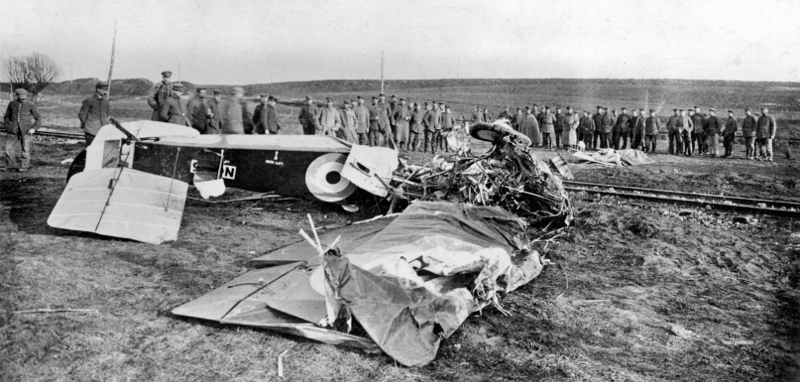
On 2nd May ‘Strutter’ N5602 is wrecked at Mullion whilst both crew are killed when ‘Strutter’ 9748 is hit by AA fire flying over Macedonia. 9(N)Sqdn ‘Pup’ 9916 shares a victory with N5188 which then suffers a forced landing on a beach near Calais. 4(N)Sqdn’s N5196 shares a victory with N6462, 3(N)Sqdn’s N6182 claims one whilst N6171 shares one with N6178 & 94. 8(N)Sqdn ‘Triplanes’ N5460 and N5493 also claim victories.
On 3rd May 43Sqdn ‘Strutter’ 5719 spins in from 5,000ft killing the pilot and 45Sqdn’s A1008 crashes on take-off. 66Sqdn pilot in ‘Pup’ A6155 is killed when he hits a hangar landing from an offensive patrol. 8(N)Sqdn ‘Triplanes’ N5449 & N6290 claim victories whilst N5472 is damaged in combat. At home the first Morgan-built ‘Strutter Bomber’ A5950 (below) arrives at Farnborough for its AID checks.
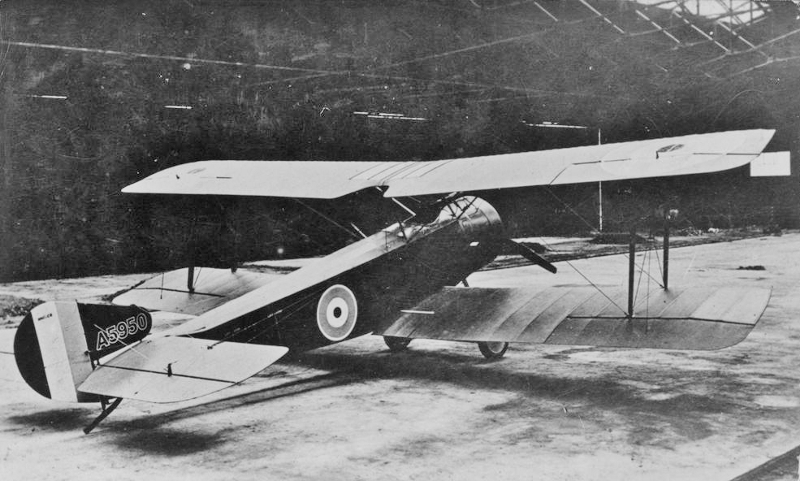
On 4th May 70Sqdn ‘Strutter’ A8211 claims an Albatros, A1001 is wrecked in a forced landing after combat and both crew fatally wounded whilst 43Sqdn’s A3431 is damaged by AA fire and the observer killed. 66Sqdn pilot in ‘Pup’ A7303 is wounded in combat and 3(N)Sqdn pilot of N6207 is sent down and taken prisoner. 8(N)Sqdn ‘Triplane’ N5482 claims a victory. At home ‘Strutter’ N5604 has been fitted with floatation bags for its anti-submarine patrols from Prawle Point whilst 61Training Sqdn’s B1706 suffers a fatal crash at South Carlton.
On 5th May 45Sqdn ‘Strutter’ A8239 crashes on take-off injuring the air mechanic and the pilot of 54Sqdn ‘Pup’ A663 is injured forced landing with an engine failure. 1(N)Sqdn ‘Triplanes’ N5436 & N5444 claim victories.
On 6th May 45Sqdn ‘Strutter’ A8226 claims an Albatros. 3(N)Sqdn ‘Pup’ N6178 shares a victory with N6465 which also claims a second whilst N6171 crashes on landing. 1(N)Sqdn ‘Triplane’ N5479 claims a victory. ‘Baby’ N1103 on delivery to Felixstowe forced lands on Breydon Water out of fuel.
On 7th May 45Sqdn ‘Strutter’ A8260 claims a victory, A1075 crashes after being hit by AA fire whilst both crew of 43Sqdn’s A1010 are injured crashing on take-off and 3(N)Sqdn’s 9654 is crashed in transit,. There are victories for 66Sqdn ‘Pups’ A7304, A7309, B1703 and 4(N)Sqdn’s N5196 whilst 9(N)Sqdn’s N6191 makes an unsuccessful attack on a U-boat off Ostend. 1(N)Sqdn ‘Triplanes’ N5426 & N5476 and 8(N)Sqdn’s N5481 all claim victories.
At home Sopwith’s first production ‘F1 Camel’ N6330 has completed testing at Brooklands and is delivered to the RNAS. The main differences from the prototypes are the three-piece top wing and longer ailerons on all four wings. It has the flat hump over the machine guns first seen on prototype N517 presently with 10(N)Sqdn.
The 8th May Sopwith Board Meeting sets the date of the AGM for 17th May and approved applications for four more patents: “Improved tool for extracting propeller fixing bolts, Improvements re. attaching engine cowl to fuselage, Improvement in mounting wings to fuselage, Improvement in electric couplings”.
On 8th May 70Sqdn ‘Strutter’ A8211 forced lands with an engine failure, 43Sqdn’s A8232 is wrecked in a crash landing whilst 66Sqdn ‘Pup’ A6154 is damaged forced landing on soft ground. ‘Triplane’ N524 originally loaned to the French is now with RNAS 9(N)Sqdn whilst ‘Pup’ 9933 fitted with a skid undercarriage and an upward firing Lewis gun has finally reached HMS Campania in Scapa Flow for erection.
On 9th May 45Sqdn ‘Strutters’ A963 & A6269 each claim a victory as does A8260 before sharing another with A8225. 70Sqdn’s A994 is shot down and the crew killed as is the observer in A8174. 45Sqdn ‘Strutter’ 7803 and 43Sqdn’s A887 are lost in action and the three crew taken prisoner whilst 43Sqdn’s A8219 & A8238 suffer crash landings. 54Sqdn ‘Pups’ A7306 & A7330 claim victories as do 9(N)Sqdn’s N6167 and 4(N)Sqdn’s N6187 whilst N6168 drives down a kite balloon before sharing a victory with N6200. 54Sqdn ‘Pup’ A6174 is chased down in a flat spin overturning on landing (below) and the wounded pilot is taken prisoner. 10(N)Sqdn ‘Triplane’ N5490 and 8(N)Sqdn’s N5493 claim victories whilst N5458 is shot up and the pilot wounded. 10(N)Sqdn’s ‘Triplane’ N5352 crashes on take-off.
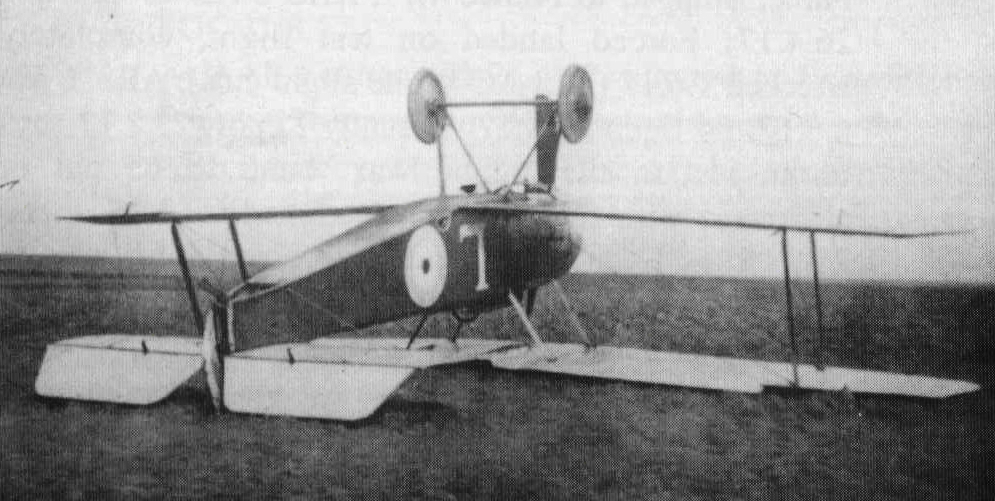
On 10th May 70Sqdn ‘Strutter’ A8174 is wrecked in a crash landing with the observer killed in action. The pilot of ‘Pup’ N6185 ‘ANZAC’ (recently photographed with other 4(N)Sqdn machines at Bray Dunes above) is shot down and killed as is the pilot of 66 Sqdn ‘Pup’ A7303 whilst A6178’s pilot is injured and taken prisoner. 54Sqdn’s A668 after a 15 minute fight from 9,000ft down to 50ft sees his opponent crash into a house but is set upon by enemy aircraft and ground fire. After crossing the lines a lower wing buckles flipping the aircraft into a shell hole from 50ft, the pilot is slightly injured. 8(N)Sqdn ‘Triplanes’ N5442, N5471 & N5482 claim victories but N5464 is brought down in the lines by flak and the pilot wounded. A 28 Training Sqdn observer in ‘Strutter’ A1113 is killed in a crash.
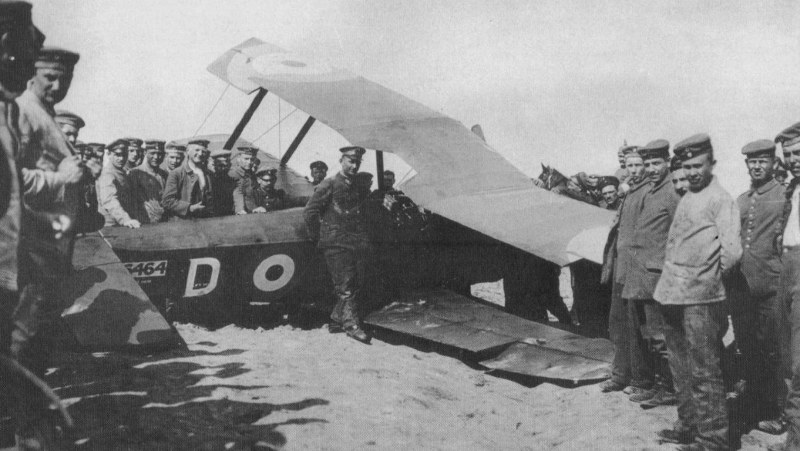
On 11th May 70Sqdn ‘Strutter’ A1009 & 45Sqdn’s A1069 crash taking-off on practice flights whilst A8750 crashes landing from a patrol. 54Sqdn ‘Pup’ A6165 shares a victory with six other ‘Pups’ but the pilot of A7308 dies when it spins down in flames after a combat with three enemy aircraft and A7307 crashes after being shot up by AA fire. 66Sqdn’s A6176 crashes on a test flight after being sent into a spin by the slipstream of another aircraft. 3(N)’s N6464 is shot down (above) and the wounded pilot taken prisoner whilst N6205 “Betty” is damaged landing. (below)
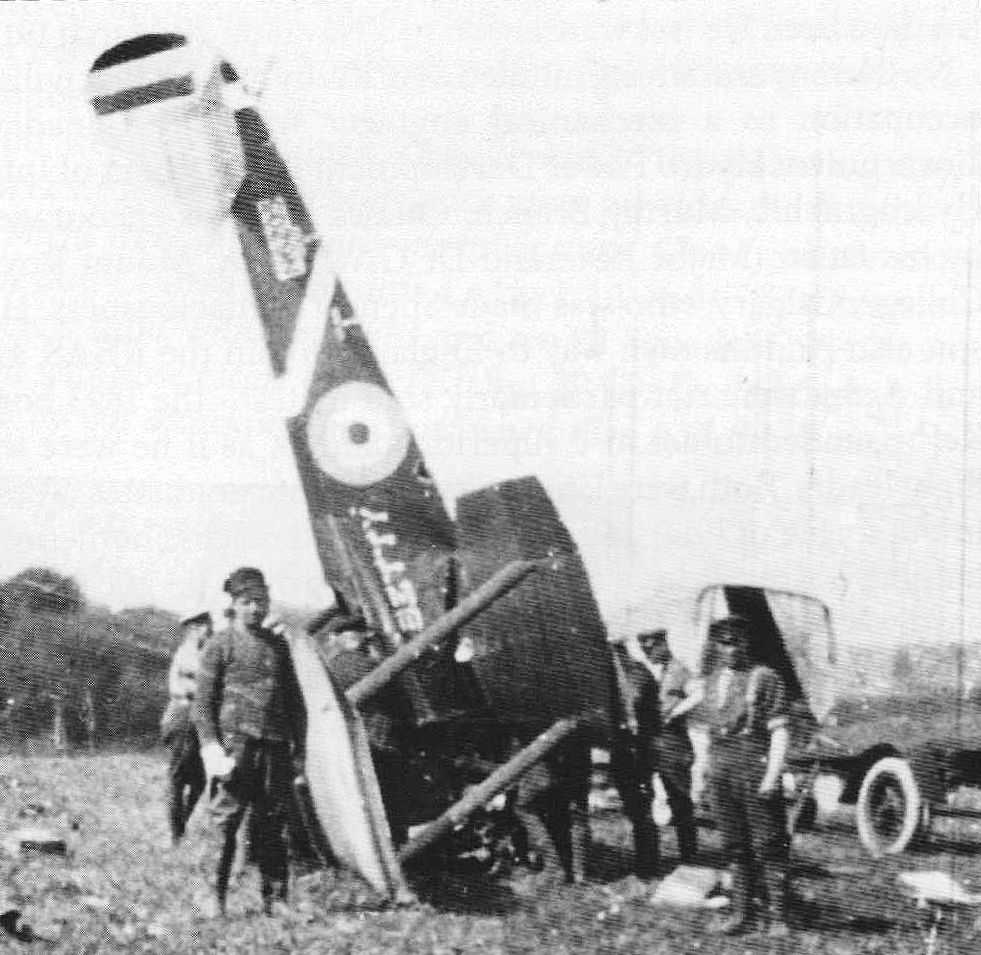
1(N)Sqdn ‘Triplane’ N5446 shares a victory with N5488 but N5484 forced lands with engine trouble. 8(N)Sqdn’s N5460 claims two victories and N5490 forces a seaplane to crash into the sea off Ostend.
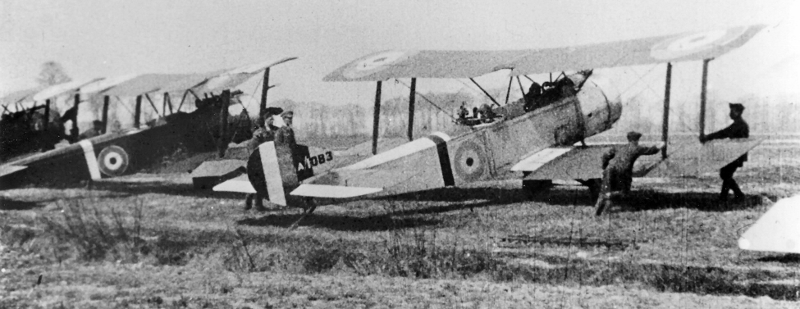
On 12th May 45Sqdn’s ‘Strutter’ A963 captures an Albatros whilst A1083 (above) crash lands after damage on a line patrol, A8225 also crashes on landing and A2385 crashes on take-off. 70Sqdn’s A1005 crashes on take-off and A1006 on landing. 2(N)Sqdn’s 9897 is wrecked whilst N5154 on wireless duty for an RN bombardment of Zeebrugge lock gates lands with engine failure in Holland and the crew are interned. 54Sqdn ‘Pup’ A6168 claims a victory but 66Sqdn’s A664 is shot down killing the pilot. 4(N)Sqdn ‘Pup’ 9899 sends down a Siemens-Schuckert D1 but gets shot up, N5196 claims a seaplane as does N6177, N6168 claims an Albatros and 9(N)Sqdn’s N6193 gets a Halberstadt. 8(N)Sqdn ‘Triplane’ N5455 claims an Albatros but 10(N)Sqdn’s N5456 is shot down by AA fire over Zeebrugge killing the pilot.
Meanwhile at Grain Harry Busteed continues trials to develop a standard form of floatation gear after discovering that airbags in the rear fuselage left the machine nose down. He now has a Beardmore-built ‘Ships Pup’ fitted with a special jettisonable undercarriage and extra 9ft6in long by 16in diameter airbags stowed folded along the underside of the leading edge of the lower wings. These are inflated with a standard air bottle. On 12th May he lands this machine on the sea but the covering of the fuselage underside is ripped off and the aircraft fills with water. He now plans to fit a stiff plywood planing surface between the undercarriage fixing points and, to help hold the tail down during ditching, add a small duralumin hydrovane to the tailskid.
Sopwith are racing ahead with ‘F1 Camel’ production. On 12th May the sacrificial bare structure of N6340 goes to Farnborough for their standard structural strength testing by progressive loading with sandbags whilst photographs are taken of the second completed machine N6331 at Brooklands (below) clearly showing the now standard three-piece top wing and the longer ailerons extending inboard of the interplane struts.
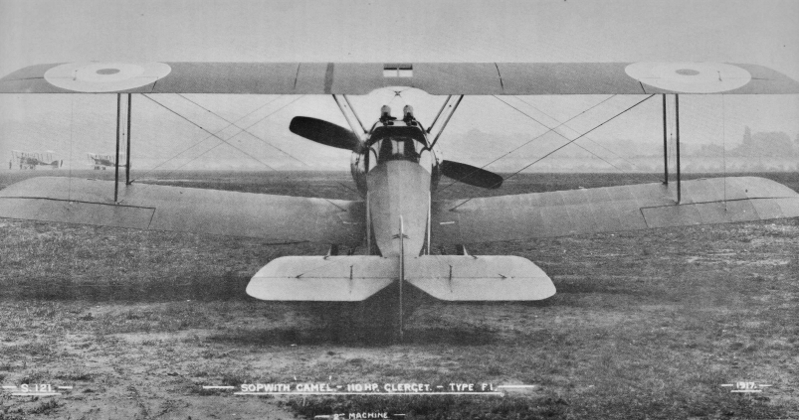
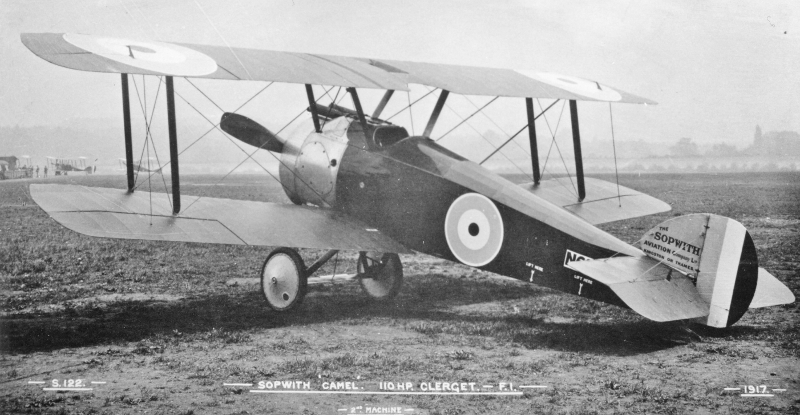
On 13th May 2(N)Sqdn ‘Strutter’ N5080 crashes wrecking its undercarriage and damaging the wings, 45Sqdn’s A1092 is also wrecked landing. 3(N)Sqdn’s ‘Pup’ N6169 claims a victory as does 66Sqdn’s B1703 whilst A7304 crashes and overturns and 46Sqdn’s A6164 has an engine cut out on landing ending on its nose. 9(N)Sqdn ‘Triplane’ N5475 forced lands at Manston with engine trouble.
On 14th May 3(N)Sqdn ‘Pup’ A6158’s propeller is hit before being shot down and the pilot taken prisoner.
On 15th May N6331 is the first production ‘F1 Camel’ to arrive in France, via Dover yesterday to St Pol today
Calshot based ‘Baby’ floatplane 8170 is completely wrecked.
At Dalmuir, Glasgow on 15th May the first Beardmore order for fifty ‘Pups’ is completed with the first flight and acceptance of 9949. It is to join 9948 at RNAS Hendon for catapult launching experiments.
16th May 45Sqdn ‘Strutter’ A1017 with no engine pressure is wrecked in a forced landing whilst 66Sqdn ‘Pup’ A7303 is shot down and the pilot killed.
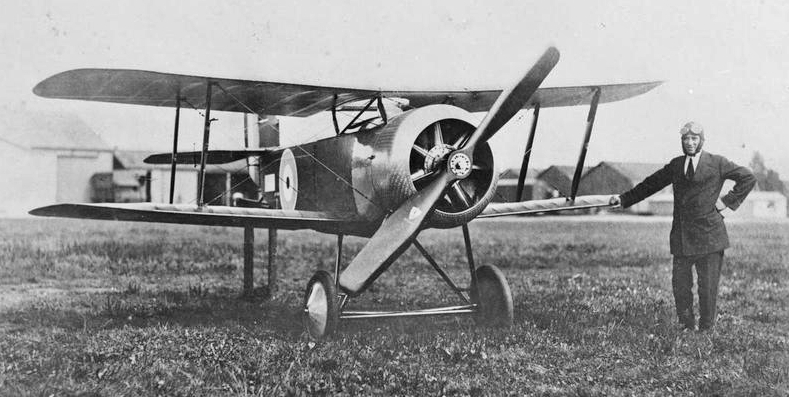
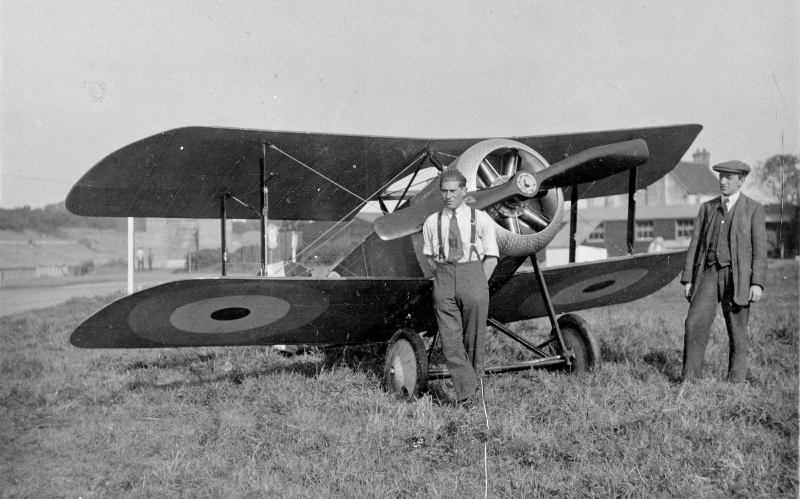
At some stage in recent months Harry Hawker and the experimental team have found time to devise and build him a new 50hp runabout using many ‘Pup’ components. (above and below) They appear proud of it. Known as the Sopwith ‘Bee’ it is much more compact than his 1915 50hp SLTBP runabout which evolved into the ‘Pup’. The short fuselage gives a steep ground attitude which accentuates the broad-chord of the remarkably short wings as do the huge roundels. The low top wing follows current Sopwith design thinking about good all round visibility over the wing. It has a large horn balanced rudder but retains Harry’s favourite wing warping, no ailerons.
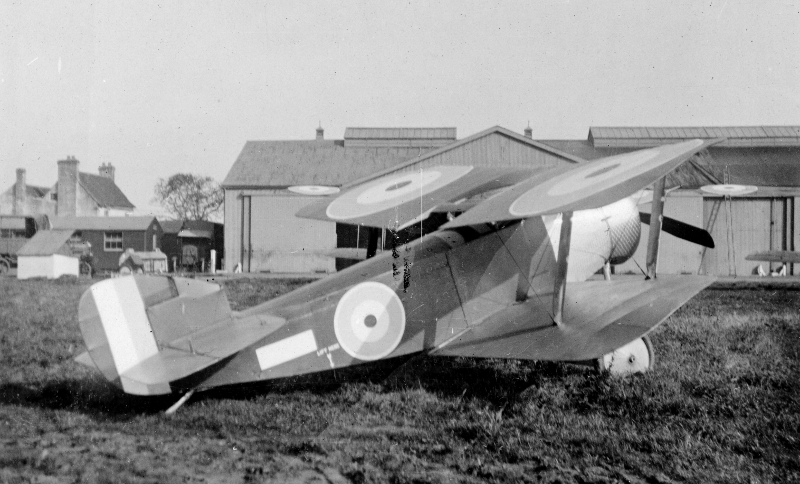
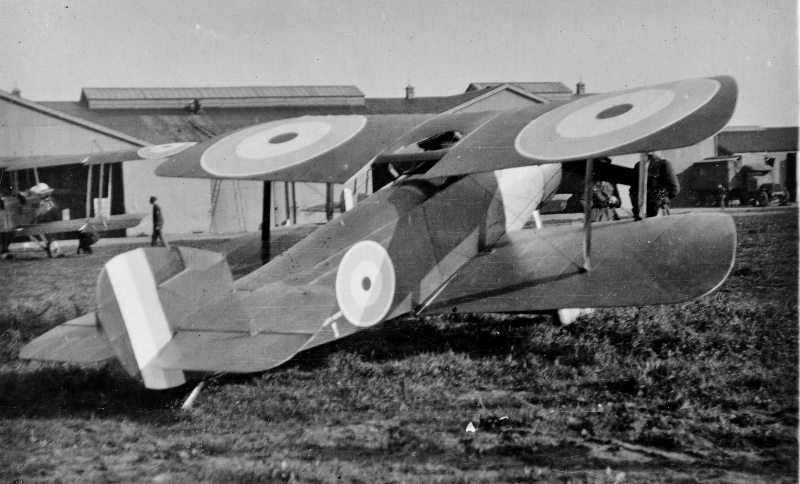
RNAS support for the RFC over the Western Front grows again on 15th May with the arrival of the Sopwith ‘Triplanes’ of 10(N)Sqdn, thirteen of its fifteen pilots are Canadian.
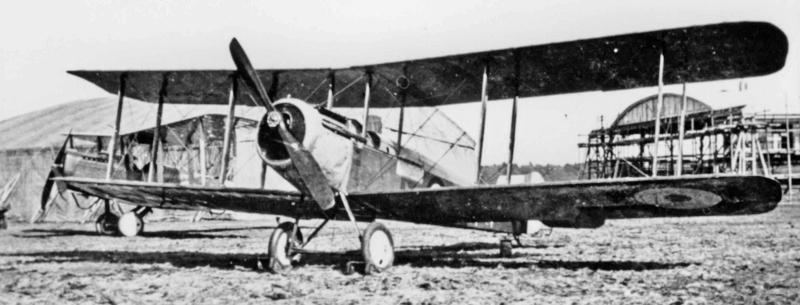
The sole prototype 200 hp Hispano Suiza powered Sopwith ‘B1’ bomber N50 has arrived with 5(N)Sqdn for evaluation against the De Havilland DH4 (behind the B1 above on the left) and is now photographed (below) fitted with a forward firing Lewis gun possibly being swung to re-set the compass.
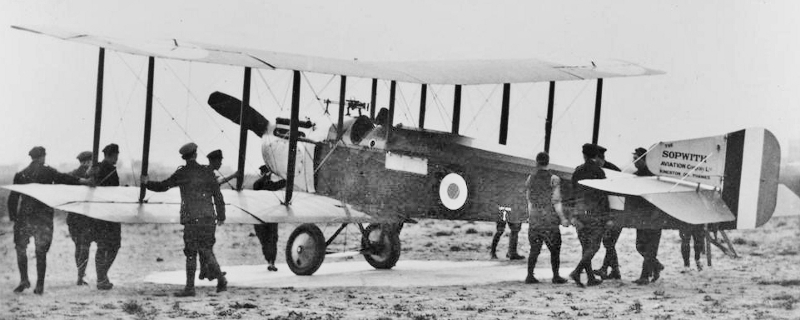
The weather is really too bad for flying on 16th and 17th May, 45Sqdn ‘Strutter’ 7800 is wrecked in a crash.
By 17th May prototype ‘F1 Camel’ N517 in France since 3rd May and recently with 10(N)Sqdn moves across to 9(N)Sqdn and the first two production ‘Camels’ N6330 and N6331 have reached Dunkirk. Those were assembled and flown at Brooklands which is the plan for the first eight machines but the subsequent machines are going by road from the Kingston factory to Dover for final assembly and testing like the final deliveries of ‘Pups’ and ‘Triplanes’. N6339 arrived by road at Dover on 16th and on 18th May six more are delivered, N6341, 2, 3, 5, 6 & 7. Three of these are to get the RNAS’ much preferred new 150hp BR1 engines.
Despite these more powerful machines, engines are still needed for the hundreds of ‘Pups’ still in production. On 18th May Gordon Watney of Weybridge receives orders for 200 80hp Le Rhône engines to supplement slow supplies from France and from W H Allen of Bedford who are now concentrating on 110hp Le Rhônes.
In France on 18th May a 45Sqdn observer is wounded in a ‘Strutter’ whilst 54Sqdn ‘Pups’ A7312 & B1712 are both overturned by the wind on landing. 8(N)Sqdn ‘Triplane’ N5493 claims a victory and that evening some 1(N)Sqdn ‘Triplanes’ cross the lines at 20ft to attack German balloons four of which were brought down.
On 19th May 70Sqdn ‘Strutter’ A1007 is wrecked crash landing and a 43Sqdn observer is killed in action. The pilot of 66Sqdn ‘Pup’ A6169 is injured in a forced landing and 4(N)Sqdn’s N6199 lands 4 miles out to sea with an engine failure but is towed into Dunkirk by the French destroyer ‘Oriflamme’. 1(N)Sqdn ‘Triplanes’ N5426, N5440, N5444, N5446 & N6296 each claim a victory as does N5488 but it is then shot down in flames killing the pilot. The pilot of N5461 meets the same fate. 8(N)Sqdn’s N5447 has its engine damaged in combat.
On 19th May the Admiralty convert Beardmore’s order for 30 ‘Pups’ N6100-29 to Sopwith-Beardmore SBIIIs with folding or dropping undercarriage and folding wings, followed by a provisional order for a further 70.
On 20th May 45Sqdn ‘Strutter’ A8226 scores a victory before the crew are killed in action, the wounded pilot of A8246 dies after a forced landing whilst A8282 crashes on take-off. 3(N)Sqdn ‘Pup’ N6461 claims an Albatros whilst 4(N)Sqdn’s 9899 forced lands on a beach. 1(N)Sqdn ‘Triplane’ N5444 and 10(N)Sqdn’s N6297 claim victories as does N5366 but it is damaged and the pilot wounded in the shoulder. N5365 & N5485 both crash.
On 21st May four more unassembled Camels N6348, 9, 50 & 51 are delivered to Dover from Kingston and seven more N6352 to 4 & 6365 to 7 are sent to the Admiralty Depot at White City for shipping to the Aegean. At Brooklands outside the Sopwith sheds two more assembled ones N6332 & 4 are leaving for Dover.(below)
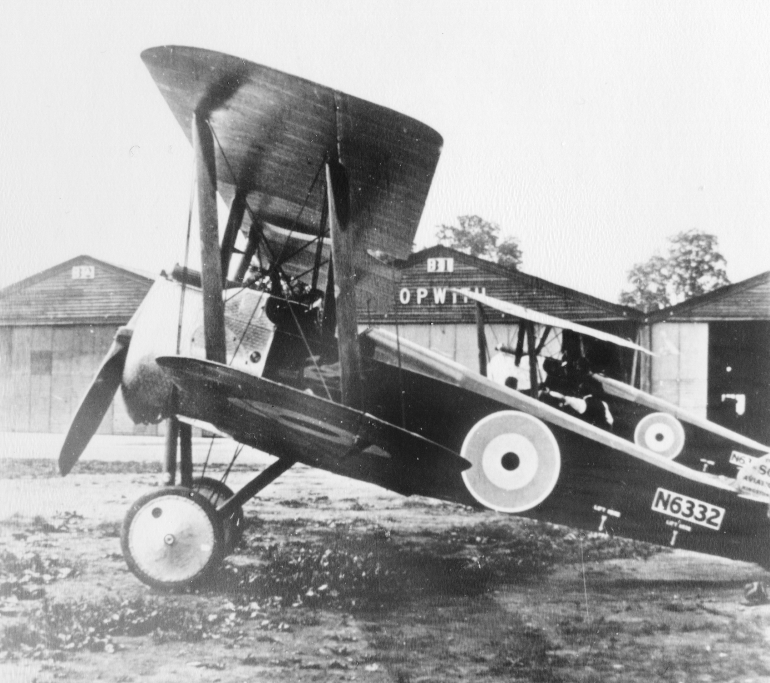
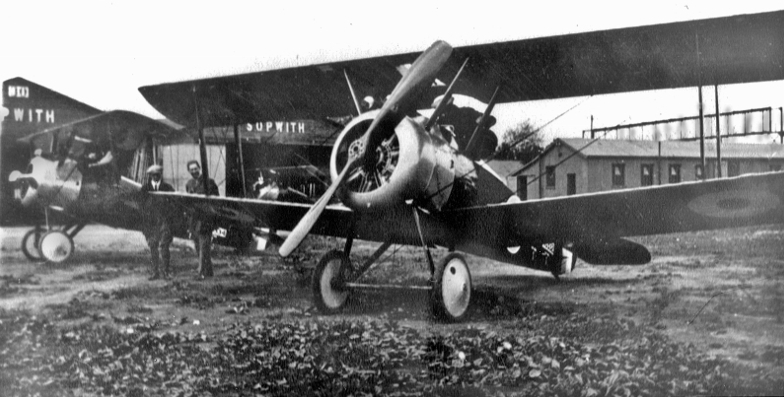
On 21st May the pilot of 5(N)Sqdn ‘Strutter’ 9384 is killed during a raid whilst 70Sqdn’s A997 & 45Sqdn’s A8216 are wrecked. 10(N)Sqdn ‘Triplane’ N5492 claims an Albatros whilst N6297 in comparison tests with a captured Albatros scout and a Baby Nieuport “handles equally quickly” and is “superior in speed and climbing power”.
On 22nd May 66Sqdn ‘Pup’ A6186 claims a victory whilst the pilot of A7332 is killed in a mid-air collision with an RE8. 9(N)Sqdn’s 9928 damages an enemy machine which lands in Holland but then crash lands itself.
RFC orders for Sopwith ‘Camels’ on Ruston Proctor of Lincoln are increased by 200 to 550 machines.
It is reported that 29-year-old Thomas Sopwith is on the Government’s new Civil Aerial Transport Committee “enquiring into aerial civil communications after the War”. Chaired by Lord Northcliffe, others include H G Wells, the Duke of Atholl, Lord Montague, G Holt-Thomas, M O’Gorman, J D Siddeley, F W Lanchester, Brig Gen S Brancker, Capt Vyvyan and senior representatives from the Post Office, Foreign Office, Treasury and Customs, Board of Trade, Colonial Office, various Colonial High Commissions and the Meteorological Office.
At Brooklands yet another new design has appeared from the Sopwith experimental shop with a 200hp V8 Hispano-Suiza engine behind a huge propeller and large but narrower and taller radiator than the B1.(below)
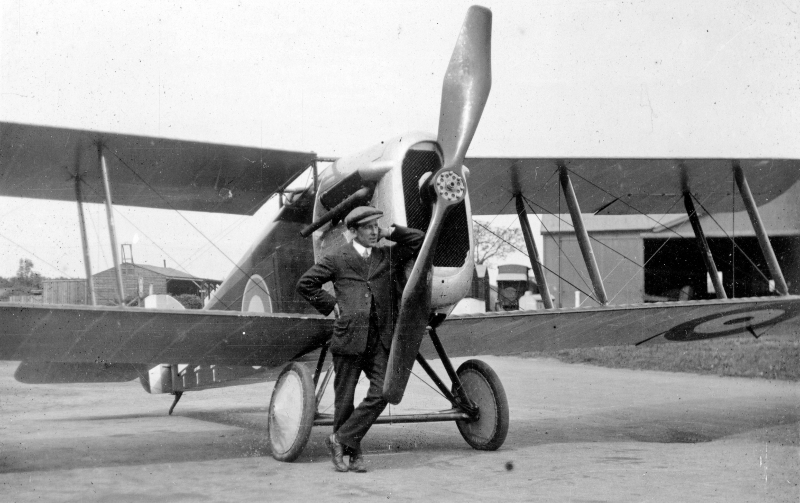
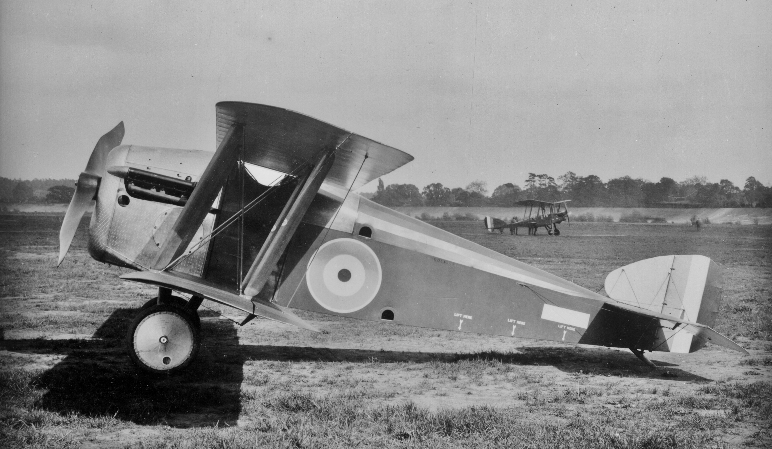
Harry Hawker appears nonchalant about his new charge, the first prototype Sopwith ‘5F1 Dolphin’ high altitude fighter. Having an in-line engine it is 3ft6in longer than the ‘F1 Camels’ now in production and has 4ft6in longer two-bay wings to lift the extra engine weight. Although it is the same overall height, only the undercarriage and tail bear any resemblance to the Camel. By making the fuselage much deeper Herbert Smith is raising the pilot’s head up through a rectangular steel tube frame to which the top wings are attached, providing an uninterrupted view all around, above and ahead. This improves on previous Sopwith biplanes but positions the wing behind the heavy engine the balance being achieved by setting the lower wing further forward creating a very definite 13in reverse stagger. The wings have the same chord as the Camel but have 2½ᴼ of dihedral (below) compared with the Camel’s steep 5½ᴼ dihedral on the lower wing only. Cowled above the engine are two forward-firing Vickers machine guns with the latest Constantinesco hydraulic synchronising mechanism. Officially tested at Brooklands on 22rd May, remarkable speeds up to 146mph are recorded at 5,000ft.
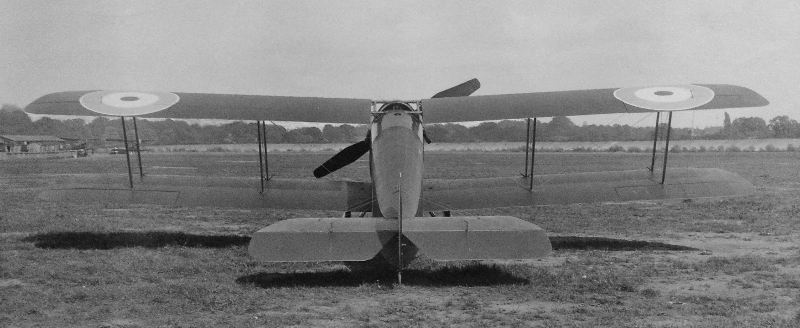
On 23rd May Killingholme ‘Baby’ 8141 overturns on the water and is wrecked and newly assembled ‘Strutter’ A1018 is wrecked on its first test flight at St Omer. There are victories for 66Sqdn ‘Pup’ B1703 and 3(N)Sqdn’s N6183, N6194, N6197 and N6479 whilst 46Sqdn lose their first pilot when A665 is shot down. 8(N)Sqdn ‘Triplane’ N5460 claims a victory, 10(N)Sqdn’s N5482 shares one with N5493 but 8(N)Sqdn’s N5421 & N5481 are shot down one pilot killed in action and one wounded whilst N5454 crashes on landing.
Overnight on 23rd/24th May the German Navy again meet adverse winds and cloud on a six Zeppelin airship raid, none get closer than 40 miles to London, scattering 60 bombs across East Anglia from over 16,000ft. The RNAS and RFC put up 76 sorties including eight ‘Baby’ floatplanes and the first ‘Pup’ used for home defence but to no avail. Westgate ‘Baby’ N1065, damaged in a forced landing at sea, is towed to Grain by Hopper 15.
On 24th May as three more unassembled ‘Camels’ arrive at Dover by road from Kingston, two completed ones N6335 & N6355 fly from Brooklands to Dover whilst N6334 goes across from Dover to St Pol.
On 24th May RFC ‘Pup’ A653 with the experimental installation of a 100hp Gnome Monosoupape has a second set of tests at Martlesham Heath, now with its cowling crudely cut away. (below) It takes 2mins less than the 80hp standard ‘Pup’ to climb to 10.000ft (12min25secs) but has just 3mph more speed up there.
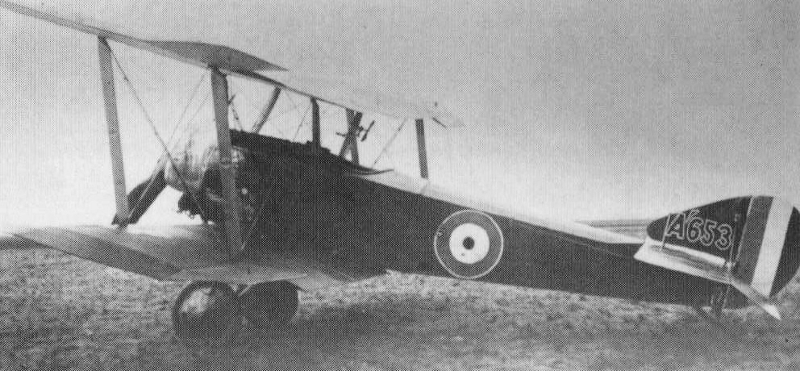
On 24th May 43Sqdn ‘Strutter’ A973 and crew are lost on a Line Patrol when it is shot down in flames whilst A8347 is wrecked after an engine failure. Three observers receive leg wounds in combats. 66Sqdn ‘Pup’ A6194 is forced down and the wounded pilot taken prisoner whilst A7340 claims a victory as do 54Sqdn’s A6156 and A6183 which damages a wing colliding with the enemy aircraft which brakes up. 8(N)Sqdn ‘Triplane’ N5482 claims two victories but N5450 is shot down and pilot killed.
On 25th May 45Sqdn ‘Strutter’ A963 is forced to land after being hit in the fuel tank, the crew are taken prisoner, one wounded. A2384 & A2413 are wrecked in forced landings. 66Sqdn ‘Pup’ A7315 & 46Sqdn’s A7327 claim victories as do 4(N)Sqdn ‘Pups’ N6475 & N6176 and 10(N)Sqdn ‘Triplanes’ N6297 & N6306.
On the afternoon of 25th May the Germans attempt a first massed daylight bombing raid on London with twenty-one twin-engined Gotha bombers but are thwarted by cloud cover. Turning south they drop most bombs from 15,000ft on Folkestone killing 95 and injuring 195. Seventy-seven RNAS & RFC sorties include Sopwith floatplanes and ‘Pups’ and the first use in home defence of the Sopwith 150hp ‘Hispano Suiza Triplane’ N509 and a Sopwith ‘Camel’ N6348. The Gothas are not intercepted in 90 minutes over England but one is damaged over the Channel by ‘Pup’ prototype 3691 from Dover before Dunkirk ‘Pups’ and ‘Triplanes’ including two French ones claim hits and two Gothas downed. During this raid ‘Baby’ N1025 (below) has an engine failure at sea but is towed to Burnham.
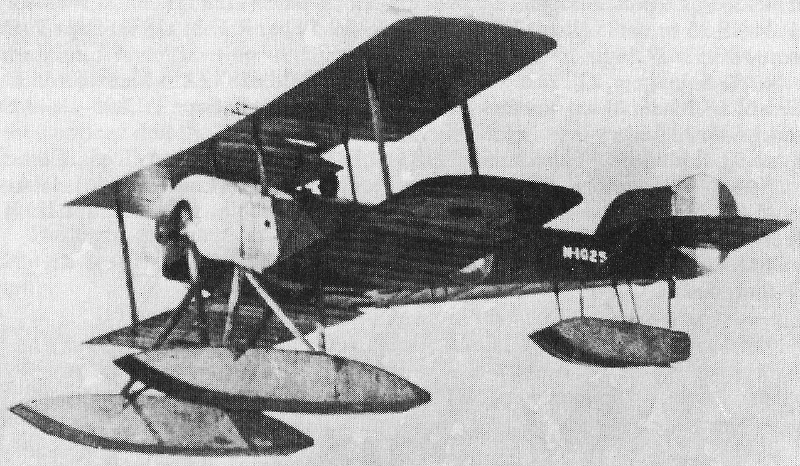
Three more ‘Camel’ kits arrive at Dover whilst N6332 ‘Camel’ delivered from Brooklands yesterday flies on, not to RNAS St Pol but to the RFC at St Omer. Two Dover assembled machines N6347 & 8, allocated new BR1 rotary engines, also reach France but N6339 has been damaged on a lorry on its way and is back for repairs.

On 25th May the 200hp Hispano Suiza powered Sopwith ‘B1’ single-seat bomber N50 (above left) is tested by 5(N)Sqdn on a bombing raid alongside their fairly new 230hp two-seat DH4s. The ‘B1’ has an internal bomb bay like the ‘Strutter bomber’. The DH4 carries bombs in external racks but has the added protection of a rear gunner. The ‘B1’ loaded with 20 Le Pecq 22lb bombs takes 26 minutes to get to 10,000ft where the speed has dropped back from 98mph to 78mph, it is “slightly faster than the DH4 but no marked difference”. The similar prototype ‘T1’ torpedo bomber is “nearly ready, waiting a French 200hp Hispano Suiza engine”.
At the Sopwith Aviation Board Meeting on 25th May in amongst the sealing of many Patent applications for the UK and the Colonies, the directors resolve to award Herbert Smith, Chief Designer and H P Musgrave, Secretary & Organising Manager, large bonuses of £769 & £384 in “high appreciation” of their services.
On 26th May 45Sqdn ‘Strutter’ A8260 is wrecked. 66Sqdn ‘Pup’ A7314 forces two Albatros down, 4(N)Sqdn’s N6187 shares a victory with N6176. 54Sqdn’s A6168 is shot down with the pilot wounded as is 66Sqdn’s A6186 with the pilot taken prisoner. 46Sqdn’s A6188 is shot up wounding the pilot whilst A6195 crash lands as does 9(N)Sqn’s 9915 but their ‘Triplane’ N5459 claims a victory whilst 1(N)Sqdn’s N5440 is damaged in combat.
Also on 26th May three more ‘Camels’ arrive at Dover from Kingston, N6347 joins 4(N)Sqdn and N6332 goes to the RFC at Candas. Trenchard is informed by the Air Department that the plan for Camel squadrons in the RFC by the end of 1917 has been increased from six to ten. They will all have 130hp Clergets not the 110hp Le Rhône now fitted to RFC’s prototype Camel B381, and three squadrons may have to use Clergets from ‘Strutters’ being replaced. The Air Department confirm that all the Bentley BR1 engines are to go to the Navy.
Following an enquiry from RFC Depots in France, they are told that no parts of the Camel gun synchronising gear will be interchangeable with the ‘Pup’ as RFC ‘Camels’ are being fitted with Sopwith-Kauper gear.
The test results from the Martlesham Heath trial of the prototype “Taper Wing Camel” show no improvement in performance. With the more complex wing to manufacture it is decided to abandon this development.
On 27th May two more ‘Camels’ N6346 & N6356 reach St Pol but the RNAS are not happy reporting that two of the Clerget machines at Dover take 13minutes to get to 10,000ft when the original tests showed under 7mins and four machines have been received with engine bearers in no fit state to have engines installed. Sopwith have only sent three fitters to Dover creating friction that has reached the Fifth Sea Lord. “Three fitters is far less than if they were erecting the machines at Brooklands, we give them every assistance, in fact the greater part of the erecting is being done by Naval ratings. They have always been dead against having to erect machines at Dover and have constantly placed difficulties in the way. It is seldom that a machine arrives complete for erection and some essential parts have to be supplied from the Dover Stores. They constantly lack flying wires. Now that there are a good many ferry pilots and not such great urgency for machines due to the lack of pilots, I am prepared to have all machines accepted at Brooklands, but cannot spare my pilots to go there since once in London they are beyond my control and I never know what happens.”
In service on 27th May 45Sqdn ‘Strutter’ A1016 claims a victory. 45’s A8226 is lost in action with both crew, A8218 is wrecked as is 70Sqdn’s A8172 after engine trouble. 66Sqdn Pup B1726 claims a victory as do 3(N)Sqdn’s N6465, N6474 & N6183 (photo below, illustrating its light weight). 4(N)Sqdn’s N6176 shares one with N6187. 66Sqdn’s A7340 is shot down and the pilot taken prisoner and 46Sqdn’s B1704 is shot up and the pilot wounded. 1(N)Sqdn ‘Triplane’ N5480 is shot down the pilot dying of his wounds and 8(N)Sqdn’s N5472 is damaged and crash lands. In England at Prawle Point ‘Strutter’ N5624 is completely wrecked.
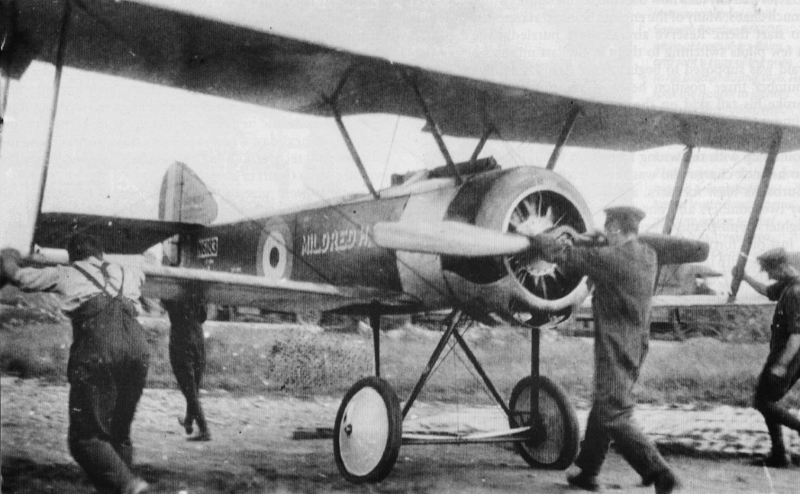
In Macedonia RNAS 2 Wing’s ‘F’ Squadron of ‘Strutter bombers’ has been under RFC control at Marian since 29th April on daily raids on ammunition dumps, forts and the German bomber base. On 27th May 2 Wing’s ‘E’ Squadron are bombing up for their last raid on the Struma Front before returning to Thasos to refit when the accidental explosion of a bomb sets off sympathetic detonations killing four air mechanics, injuring many others and wrecking at least eight ‘Strutters’, drastically reducing the British air fighting force in the area.
On 28th May ‘Camel’ N6333 flies from Brooklands to Dover, one more kit is delivered and N6346 gets to France where 45Sqdn ‘Strutter’ A8299 claims a victory as do 66Sqdn ‘Pups’ A6190 & B1703, 9(N)Sqdn’s N6193 and 4(N)Sqdn’s N5196 (shared with N6462). 66Sqdn’s B1715 is shot down and the pilot taken prisoner. In another remarkable day for 8(N)Sqdn ‘Triplane’ N5468 Angel (below) claims a victory as do N5472, N5477, N5482 & N6290. 11(N)Sqdn’s N6293 crashes into a ditch on landing and the following day 10(N)Sqdn ‘Triplane’ N5355 crashes on landing.
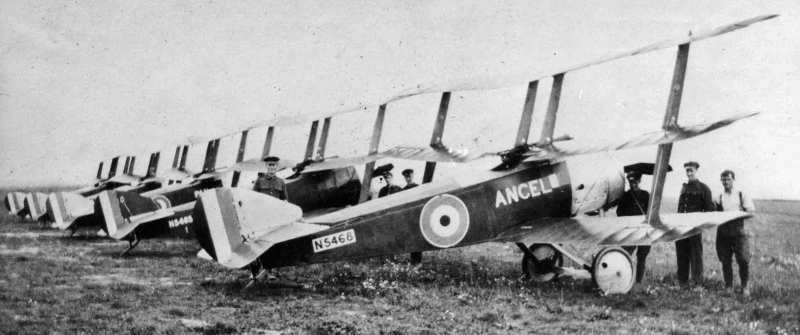
There are unconfirmed reports that the second ‘Camel’ prototype is on loan to the French. Whether it is that machine or another, a French pilot has now wrecked their only ‘Camel’. (photo below, note a French ‘Strutter’)
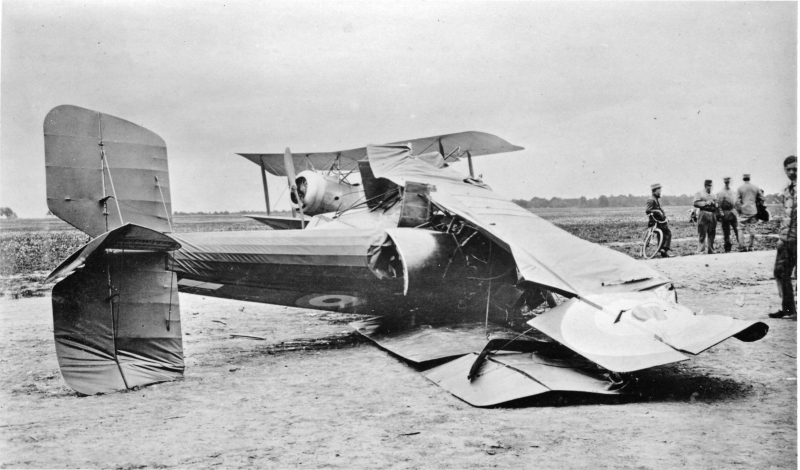
Trenchard urgently requests another ‘Camel’ for the French “as they have a large number of 130hp Clerget engines on order which could be used in French-built ‘Camels’ for American pilots without interfering with the supply of other types and engines which is most important”.
On 30th May four more ‘Camel’ kits go to Dover by road and the first two 150hp Bentley BR1 engined ‘Camels’ are delivered from Brooklands, N6335 to Dover and N6336 to Martlesham Heath. The BR1 engine is slightly larger than the 130hp Clerget requiring a larger diameter cowl at the front which tapers back to the fuselage.
In France on 30th May 43Sqdn’s ‘Strutter’ 7775 is wrecked in a ditch landing after an engine failure whilst the engine fails in 54Sqdn ‘Pup’ B1721 in combat, it is captured (right) and the pilot taken prisoner. There are now four ‘Strutters’ A5951 & 2, A6917 & 8 at Mullion for anti-submarine patrols and four more A6919 to 6922 at Pembroke.
Whilst many businesses have successfully engaged in aircraft manufacture, some are struggling to get going. On 30th May with no deliveries yet from Oakley & Co of Ilford against its five-month-old order for 25 ‘Triplanes’ their order is reduced to 22, the three which were to go to the French being taken from next month’s Clayton and Shuttleworth deliveries along with a fourth.
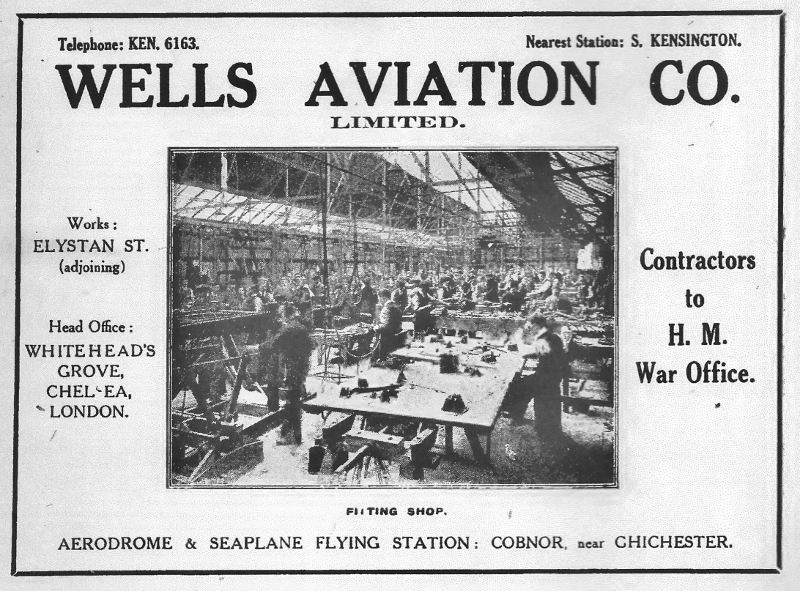
That same day a large meeting of creditors approves the voluntary liquidation of the Wells Aviation Co of Chelsea. Wells have apparently taken on too much work including an RFC order for 100 Sopwith ‘Strutters’ nine months ago only two of which have yet been delivered. They have been borrowing money, some from the War office, to fund a rapid growth in the business and have many assets which will now be liquidated.
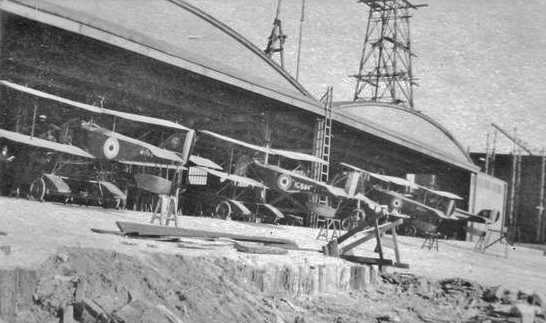
During May ‘Triplane’ N5486 has been despatched to the Russian government from the RNAS Depot White City and nine more ‘Baby’ floatplanes fitted with over-wing Lewis guns have gone to Dunkirk (above) to maintain the anti-submarine and anti-Zeppelin standby patrols plus essential escorting of two-seat floatplanes. Phyllis (below)has two Lewis guns. The French also operate their Sopwith ‘Baby’ floatplanes from Dunkirk. Older ‘Schneider’ floatplanes are still active in the Aegean: 3784 now on HMS Peony, 3787 at Mudros & 3793 at Suda Bay.
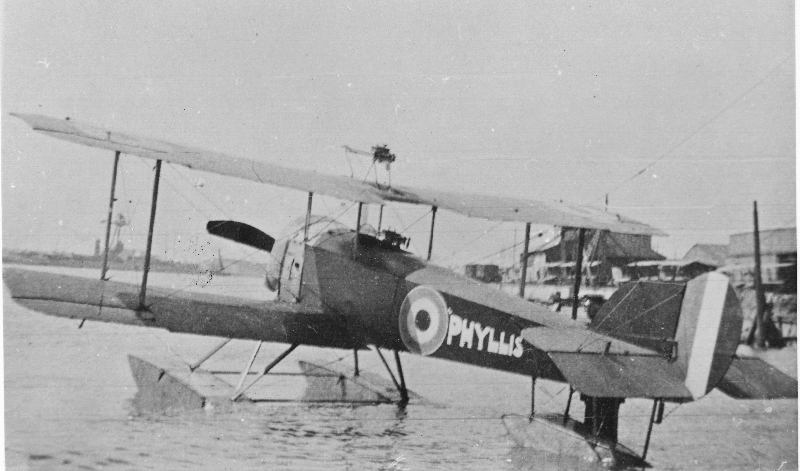
On 31st May ‘Pup’ 9916 shares a victory with N6188 & 93. Also that day the RFC in France test 130hp Clerget ‘Camel’ N6332. With full tanks and 500 ammunition rounds they are disappointed it takes nearly 10mins to reach 10,000ft, only managing 92mph at that height and 80mph at 15,000ft and a maximum height of 18,100ft. They conclude that “the engine is not a very good one”. “It is impossible to correct the simplest jams on the right hand gun with a right hand feed block. We had to cut away the cowling far forward of the breech cover hinge and fit a new celluloid windscreen in front of the feed blocks. If any more machines are coming here with right hand feed on both guns we can alter the cowls providing Triplex glass windscreens to our design can be constructed and sent from England with each machine.”
Elsewhere on 31st May four more Camel kits reach Dover from Kingston and BR1 ‘Camel’ N6335 reaches France. By also delivering three kits at the last minute to the RNAS Depot at White City, Sopwith can claim a remarkable 49 ‘Camels’ delivered in their first month of production. Nine of these have been assembled and tested at Brooklands. Of the rest, one has gone to Farnborough for structural testing, one to Ruston Proctor as a pattern aircraft for their production, four are crated at White City for shipment to the Aegean and most of the others have gone to Dover, at least ten of which are at RNAS St Pol, Dunkirk to go on to 4 & 6(N)Sqdns.
Along with the 49 ‘Camels’, Sopwith has delivered their last 3 ‘Pups’ and last 13 ‘Triplanes’ to Dover in May making another record month’s output of 65 machines plus three prototypes and an unconfirmed 6 ‘Pups’ for the Belgians. There is an outstanding order for 50 ‘Pups’ but that is to be cancelled once a few are supplied as spares. Sopwith still has no firm order for the 200 ‘Camels’ they are building for delivery through June & July.
The 321 total of new Sopwith aircraft from all suppliers in May is 25% up on April, comprising 125 ‘Strutters’ (3 Morgan, 9 Wells, 13 Vickers, 15 Fairey, 17 Hooper, 17 Mann Egerton & 51 Ruston Proctor), 97 ‘Pups’ (3 Sopwith , 20 Beardmore, 35 Whitehead & 39 Standard), 27 ‘Triplanes’ (13 Sopwith & 14 Clayton & Shuttleworth), 49 ‘Camels’ from Sopwith, 22 ‘Baby’ floatplanes from Blackburn and the first Fairey-built ‘Hamble Baby’.
Aeroplane prints this photograph of Clayton & Shuttleworth ‘Triplanes’ “all tested by Clifford B Prodger for official acceptance in a single day”.

On 1st June ‘Strutter’ A2393 is wrecked after being hit by AA fire. ‘Pup’ N6188 claims a victory as does A6183 before sharing another with A7330 whilst A6189 breaks a wheel landing and overturns. A6182 is wrecked in a forced landing and a pilot is injured crash landing A7331. ‘Triplanes’ N5483 & N5490 each send an Albatros down in flames and N5359 shares an Aviatik with N6294.
On 2nd June ‘Strutters’ 7794, 8000 & A8222 are wrecked. 46Sqdn claims its first victory with ‘Pup’ B1709 but A6204 is shot down and the pilot taken prisoner. N6194 is shot up and the pilot fatally wounded whilst N6197 crashes on landing. ‘Triplane’ N5483 shares a victory with N5490, 87 & 92 but the pilot of N6294 dies when the aircraft is hit and breaks up. At home the pilot of Killingholme ‘Schneider’ floatplane 3800 is drowned when it spins into the water after an engine failure and ‘Baby’ N1062 is wrecked on landing at Newlyn. At Grain Sqdn Cmdr Rutland continues his experiments into recovering ship-launched landplanes now by flying ‘Strutter’ 9377 fitted with inflatable floats.
On 3rd June the crews of ‘Strutters’ A8272 & A1012 are killed in action whilst the observer in A981 is fatally wounded and the pilot taken prisoner. ‘Pup’ N6176 claims a victory and A640 shares one with five other ‘Pups’. A6204’s engine and fuel tank are hit and the pilot burns the aircraft before being taken prisoner.(below) The pilot of N6194 dies after being shot in combat. N6198 is overturned by the wind after landing. ‘Triplanes’ N5483, N5490 & N6306 claim victories but the pilot of N6297 is shot down and killed after his engine fails in combat.
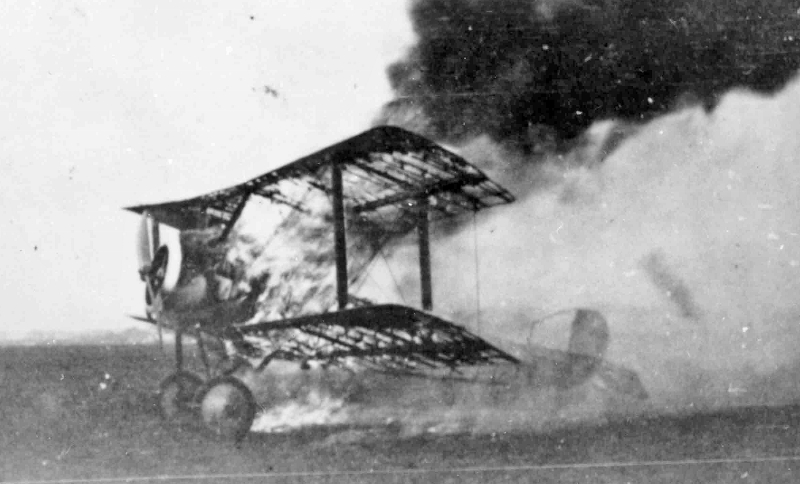
On 4th June 4(N)Sqdn’s N6347 is the first production ‘Camel’ to go into combat forcing an enemy to dive away. ‘Strutter’ A8223 is wrecked with its engine hit by AA fire & A8269 after engine failure. ‘Pups’ A673 & A7334 claim victories whilst A6207 shares one but the pilot of B2151 is killed in action. N6474 hits a kit balloon rope at 300ft crashing on its back without injuring the pilot. ‘Triplane’ N5440 claims a victory and shares one before a forced landing badly shot up, N5442 shares a victory with two others, N5487 claims one but N5492 is badly shot up as is another machine wounding the pilot. At Croydon the pilot of ‘Pup’ A7350 is killed after he loops too close to the ground, stalls and dives in. At Pembroke ‘Strutter’ N5612 smashes its propeller & landing gear.

On 4th June reports of the trials of the Sopwith ‘B1’ with 5(N)Sqdn DH4s in France are submitted to the Director of Air Services. A technical report cites problems with the cooling water circulation pipes and no insulation on ignition HT wires. The Senior Officer Dunkirk concludes: “Owing to: (a)extreme difficulty of accurate bomb sighting, (b)the fact that it is unable to protect itself, (c)the weight of bombs carried per horsepower is very small and (d)the extreme heaviness of the controls, this machine cannot be recommended for reproduction”.
On 5th June N6347 has the first confirmed victory for a Sopwith ‘Camel’. 45Sqdn ‘Strutters’ on photo reconnaissance are attacked by up to 17 enemy aircraft, A8279 and another claim victories but A1925, A8268 & A8280 are lost in combat with four crew killed and two wounded are taken prisoner. A8291 & A8293 are badly shot up with two crew wounded as is A995 whilst A2414 & A2417 crash on take-off. The combats continue with ‘Pup’ A7325 claiming a victory whilst N6168 sends down a kite balloon. The pilot of B1729 is taken prisoner after being forced down and burning his aircraft, A6216 crashes with the controls shot away and A7315 is run into by an SE5 when lined up for take-off. ‘Triplane’ victories include one each for N5459 & N5462 with two more shared between N5466, N5478, N5490 & N6302.
In the evening 22 Gotha bombers make a second 15,000ft daylight raid, this time on Sheerness killing 13 and injuring 34. A few home based aircraft get close enough to fire at them without result. One Gotha crashes into the sea after being hit by AA fire. RNAS Dunkirk machines claim two returning bombers, both unconfirmed, as ‘Triplane’ N5469 & ‘Pups’ N6187 & N6193 each claim one escorting enemy single-seater off the Belgian coast.
On 6th June ‘Pups’ 9899, N6168 & N6199 claim two victories each, N6192 shares one with N6476. N6193 is badly shot up. A6156, 65, 67, 83 & 92 share three victories between them but the pilots in A7306 & B1730 are both killed in the combat. To the ten ‘Pup’ victories this day are added ten by the ‘Triplanes’ of 10(N) Sqdn: N5490 claiming three, N5492 two and one each for N5483, N5487, N5359, N5361 & N6307, almost all in a frantic 15mins over Polygon Wood east of Ypres.
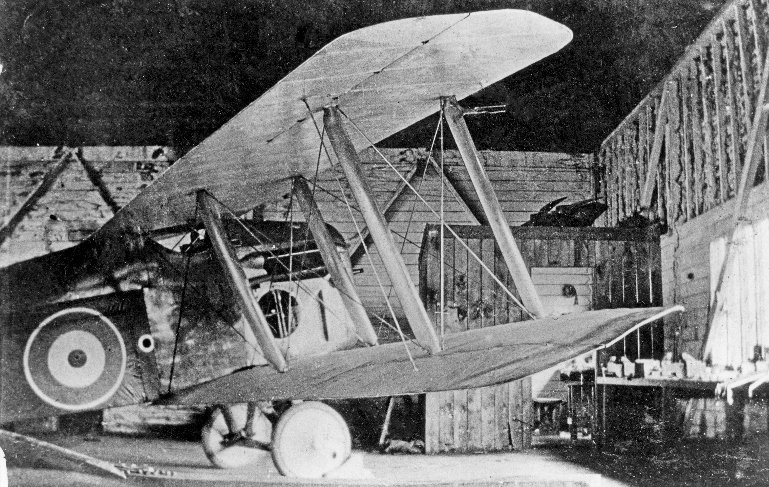
The prototype ‘Dolphin’ is being modified in Sopwith’s sheds at Brooklands.(above) Vertical slots have been added to the side panels behind the radiator to help with cooling and the plywood top decking behind the cockpit is being extended to protect the structure as the pilot climbs aboard. Crucially, 20lbs of lead is being fitted in the tail to counteract the nose heaviness which should allow continued testing whilst Herbert Smith significantly alters the design of the second ‘Dolphin’ prototype to correct the imbalance.
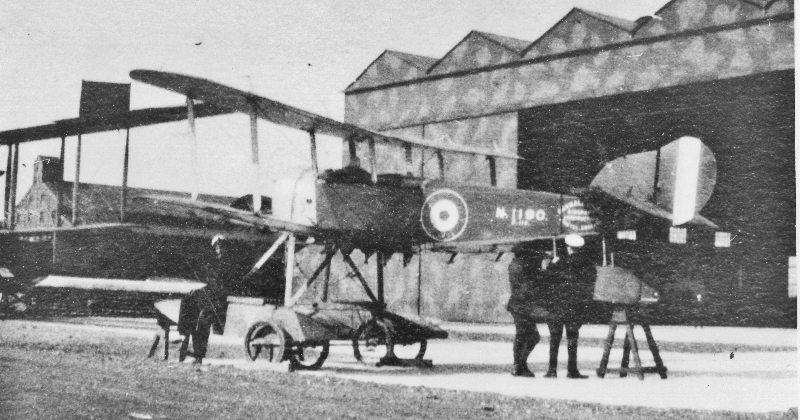
After tests at Grain the first Parnall-built ‘Fairey Hamble Baby’ N1190 has arrived at Felixstowe(above) still with a 110hp Clerget. The first Fairey-built ‘Hamble Baby’ N1320 has now been flown at Grain a month after arriving by road from Hamble.(below) The photographs show the over and under-wing levers to operate the full span flaps/ailerons and N1320’s distinctive Fairey fin shape. It has a standard 130hp Clerget.
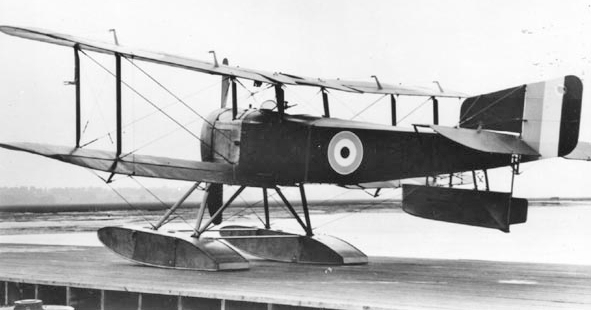
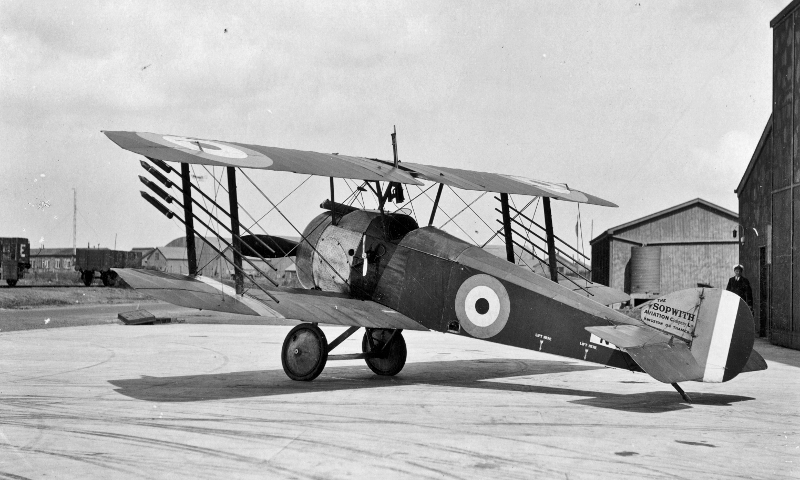
It seems that the landplane version of ‘SF1 Improved Baby’ N5 never had any floats fitted as it is now photographed(above) fitted with wireless telegraphy powered by a wind generator on the fuselage side, rocket rails and a pull-down top gun mounting to allow reloading in flight. The Admiralty are impressed and are ordering fifty production versions from Sopwith now designated ‘2F1 Camels’ to operate from ships. Despite the similar external appearance and common parts it is a different design to the ‘F1 Camel’ with shorter span wings, detachable rear fuselage containing floatation bags, single Vickers gun and a Lewis gun on top. All are to have 150hp Bentley BR1 engines.
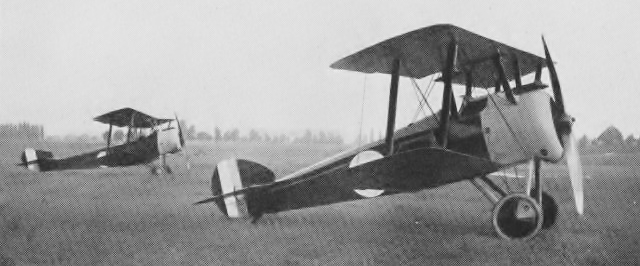
On 6th June first Sopwith ‘Camel’ for the RFC B3751 arrives at Brooklands fitted with a French-built 130hp Clerget 9B. Meanwhile the first Ruston Proctor-built RFC ‘Camel’ B2301 (above) is posed at the Lincoln airfield with a new ‘Strutter’. Ruston Proctor plans to complete the last of their 350 ’Strutters’ and start volume delivery of their orders for 550 ‘Camels’ in July. B2301 has been built ahead of that mass manufacture and has a now outdated one-piece top wing.
On 7th June the crew of ‘Strutter’ A8221 are killed by ground fire whilst attacking troops near Ypres. The crew of A8296 are also lost in action and the pilot of A8248 is wounded before crashing whilst A8788 is wrecked. There are victories for ‘Pups’ A6200, A7309, B1709 & B1726 but A7314 & A6157 are shot down with the pilots taken prisoner and B1719 crashes after being shot up. There are also victories for ‘Triplanes’ N5465, N5470, N5483, N5490, N5492 & N6291 whilst N6307 claims two down. N5484 claims one before a forced landing with damage. The pilot of N5361 is wounded and forced lands and N5443 crashes on landing. The pilot of N6298 is killed side-slipping and nose-diving in after a choked engine on take-off.
On 8th June the pilots of ‘Pups’ A6207 & B1745 are killed when they collide in combat, the pilot of B1726 is injured in combat. A6181 is also badly shot up whilst A6196 & B1725 both crash. ‘Triplane’, N5451 claims a victory but has its rudder controls shot away the injured pilot being forced to land. N5491 & N6293 are shot down and the pilots killed, N5372 is damaged forced landing as are N5490, N5466, N5351 and prototype ‘Triplane’ N504 which has been with 1, 8, 9, 10 & 11 (Naval) Squadrons since last November.
On 9th June ‘Strutters’ A8307 & A8783, ‘Pup’ N6191 (below) and the other prototype ‘Triplane’ N500 all crash on landing.
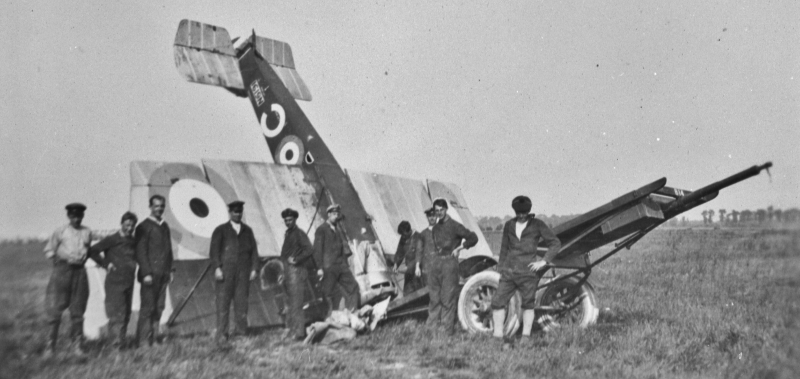
On 10th June the prototype Sopwith ‘B1’ bomber N50 is back at Dover from the unpromising trials in France. Its sister prototype 200hp Hispano Suiza powered ‘T1’ torpedo bomber N74 (below) is now ready for testing at Brooklands. To straddle the 18inch torpedo and carry its 1099lb weight, it has a sturdy divided undercarriage and 3 bay wings of 6ft greater span than the B1.
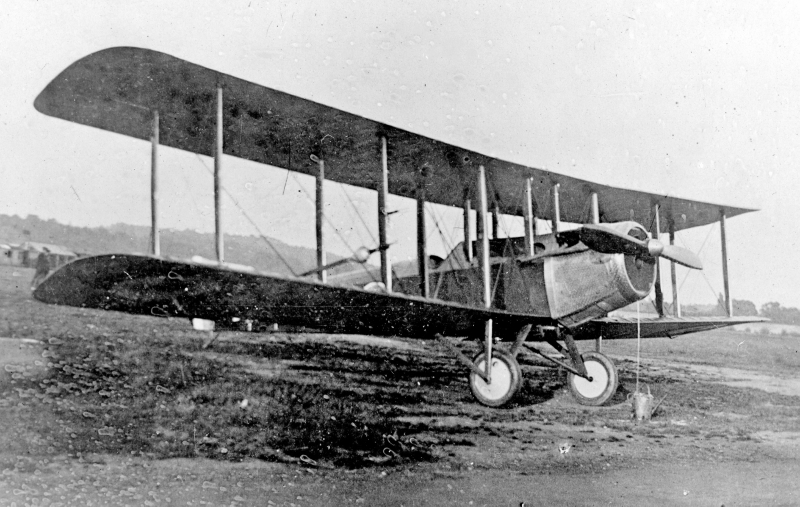
On 10th June the pilot of 6(N)Sqdn’s brand new ‘Camel’ N6359 dives at 45ᴼ from 1200ft and test fires his guns at the ground target outside the perimeter of their Guizancourt airfield in France. At 800ft he “strikes a bump” and stops firing but sees his bullets reach 300yds beyond the target to a grass cutter on the airfield. Driver Webster doing the grass cutting is shot in the side and dies of his wounds. The two Courts of Enquiry put no blame on the pilot who was diving into wind as directed but find the gun practice procedures to be unsafe.
On 11th June ‘Strutters’ A2408 & A8273 & ‘Triplane’ N5360 crash on landing as does N5425 after engine failure.
On 12th June the Canadian pilot of 4(N)Sqdn’s N6362 dies in the first combat loss of a ‘Camel’ when it breaks up whilst intercepting Gotha bombers. Returning ‘Strutter’ A8299 collides with A8244 which has just taken off and all four crew are killed whilst A8284 is wrecked after being hit by AA fire. ‘Triplanes’ N5446, N6292, N6299 & N5465 all claim victories and N5482 shares one with N5468 & N6292. In the Aegean three RNAS ‘Strutters’ go out to bomb a Bulgarian airfield and continue the petrol bomb raids which in the strong winds have already burnt over 50 acres of crops. One ‘Strutter’ is shot in the fuel tank and forced to land on the sea. The pilot is rescued by boat but the observer is lost.
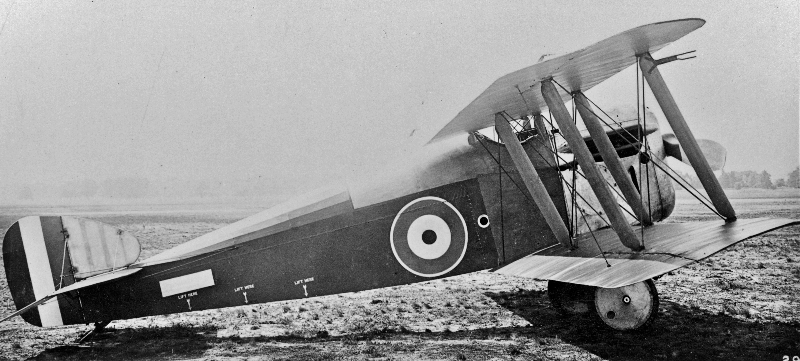
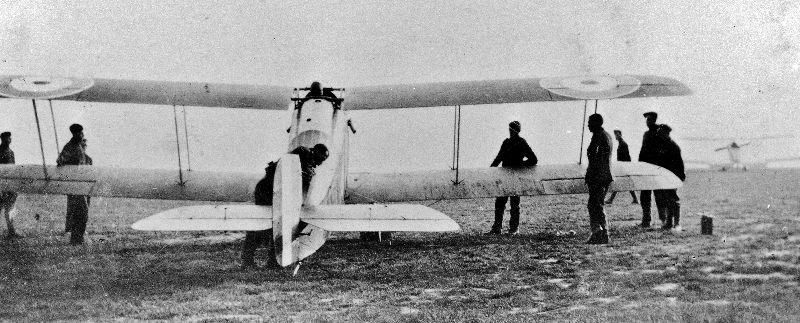
The modified ‘5F1 Dolphin’ prototype has emerged at Brooklands (above) with 20lb of lead in the tail, the extra cooling slots and the extended plywood top decking for the pilot to climb onto before lowering himself though the steel tube frame to sit with his head exposed above the upper wings. It is now given a brief performance assessment at Martlesham Heath returning figures of 123.5mph at 10,000ft, 110mph at 18,000ft, 44secs to 1,000ft, 9mins25secs to 10,000ft and 24mins50secs to 18,000ft with a ceiling of about 23,000ft. Controllability is “good in all axes” with a slight tendency to spin turning to port but it is tiring to fly “all out” needing “strong left rudder”. The radiator is found to be inefficient. It is recommended that the cooling system be redesigned, the lower wings be moved forward and a balanced rudder fitted. There are concerns about the inaccessibility of the carburettor, troublesome magnetos, oil spraying over the pilot and the lack of protection for his head if the machine overturns on landing. Despite all this Capt Henry Tizard flies the machine to France for further evaluation on 13th June attracting anti-aircraft fire from British gunners who think to be an enemy machine.
On 13th June 20 Gotha bombers set out for London succeeding in dropping 128 bombs killing 162, including 16 young children in a school in Poplar, and injuring 432. All return to base despite 94 sorties by Home Defence aircraft, 31 by various Sopwith machines including the RFC’s only ‘Triplane’ N5430.(below) ‘Pup’ 9940 is shot up attacking the Gothas over Southend and 9907 is damaged landing.
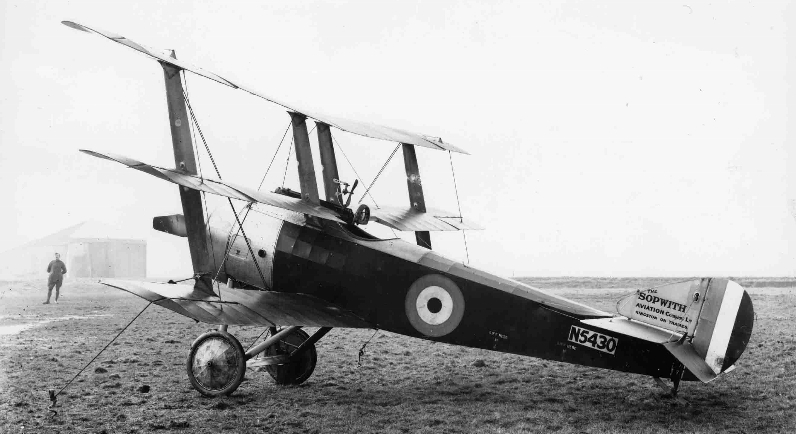
In France ‘Strutters’ A8283, A8213 & A8306 are wrecked, one after being hit by AA fire, one on take-off and one colliding with an aircraft on landing. ‘Pup’ N6169 claims a victory. ‘Triplanes’ N5468 N5477 & N6290 claim victories but N5374 spins in killing the pilot, N5469 suffers an engine failure in mid-Channel but gets to dry land and N5478 has a forced landing.
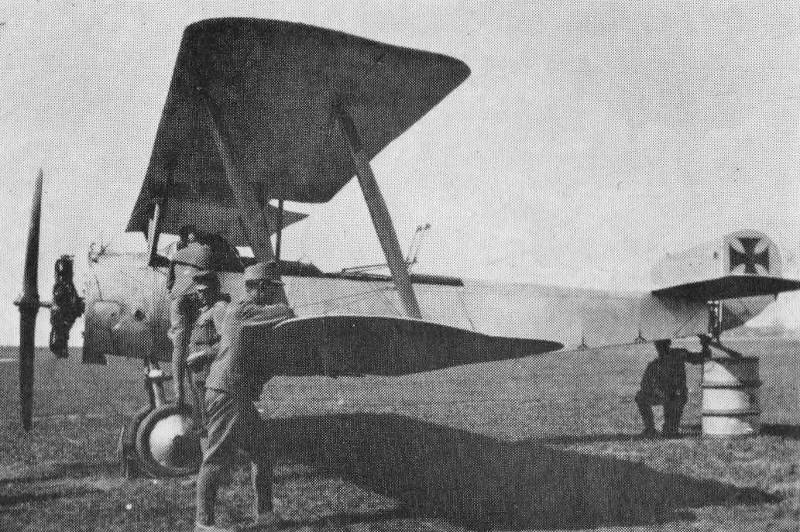
In Macedonia the Austro-Hungarians are now operating at least one captured French ‘Strutter’.(above) The other images captured aircraft (below) show French-operated ex-RNAS ‘Strutter’ 9706 and ‘Pup’ A6194 on a German rail wagon.
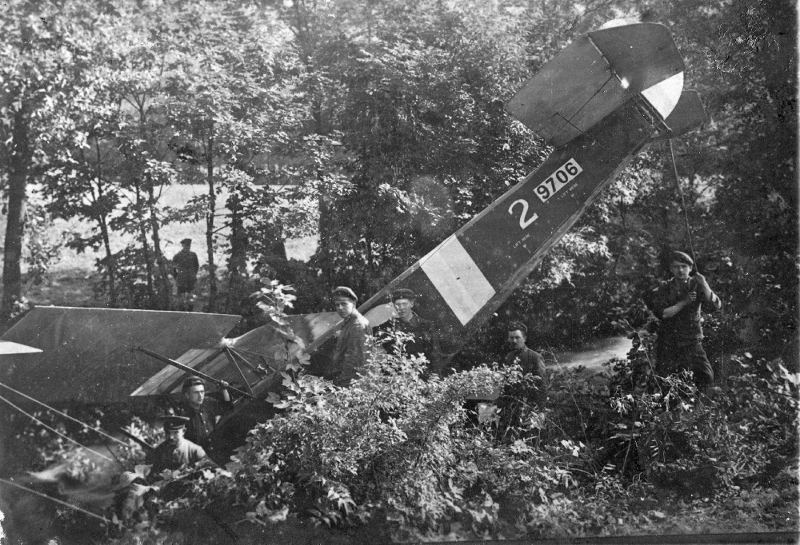
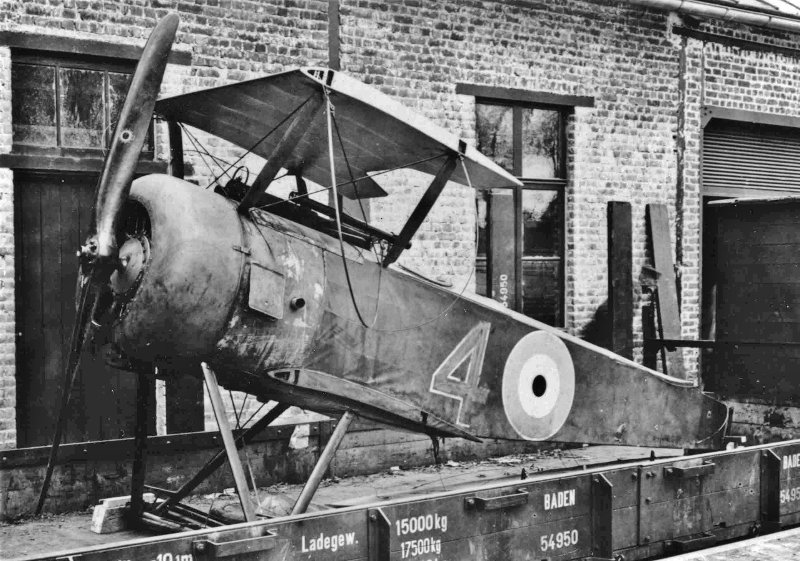
On 14th June ‘Strutter’ A2410 is wrecked crashing on take-off. ‘Triplanes’ N5482, N5359, N5479, N6291 & N6307 all claim victories, N5470 is shot down and the pilot killed whilst N5372 crashes after an engine failure.
The day after it arrives in France, the prototype Sopwith ‘Dolphin’ is test flown by RFC Capt Billy Bishop who finds the view “exceptionally good” and the aircraft “extraordinarily quick in turns and very handy”. His comments are sent to Trenchard who prefers it to the SPAD 13. (The photograph below, possibly taken at this time, provides an interesting comparison with ‘Camel’ N6336)
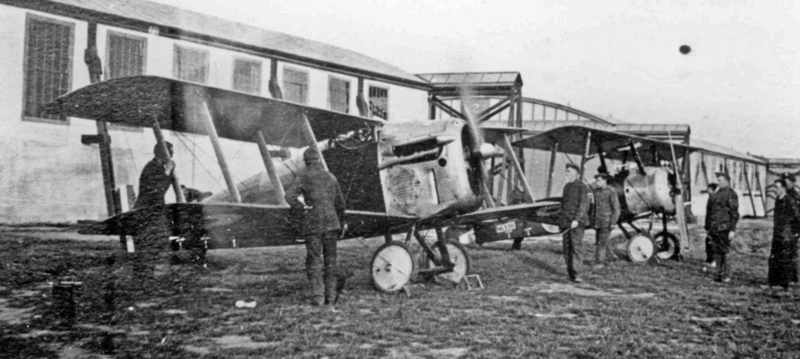
4(N)Sqdn which only switched from ‘Strutters’ to ‘Pups’ in early March already has nine ‘Camels’ alongside twelve ‘Pups’. 12(N)Sqdn is acting as an RNAS pilot “finishing school” in France with its ‘Pups’. 3(N)Sqdn’s ‘Pups’ complete their secondment to the RFC front line as the RFC’s own ‘Pup’ production continues apace; both Standard Motors and Whitehead Aircraft have already passed Sopwith’s total output of ‘Pups’. The RFC now has enough ‘Pups’ to be equipping Nos. 6, 40, 45 & 63 Reserve Squadrons for pilot training at Catterick, Port Meadow (Oxford), South Carlton and Joyce Green. Like Whitehead-built B2152 on a visit to Brooklands (above) many training machines have no gun fitted.
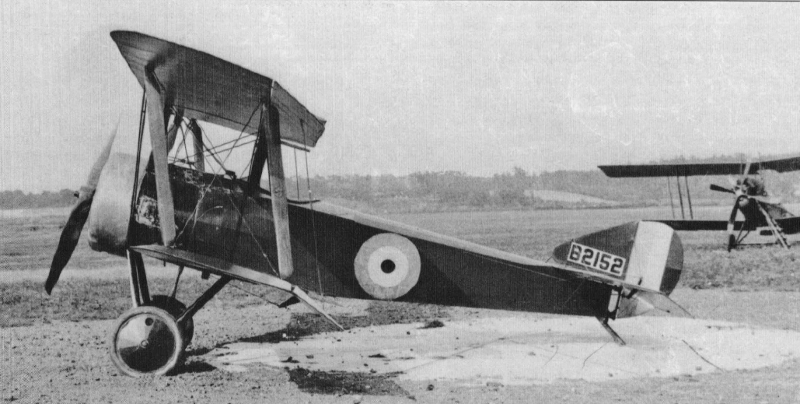
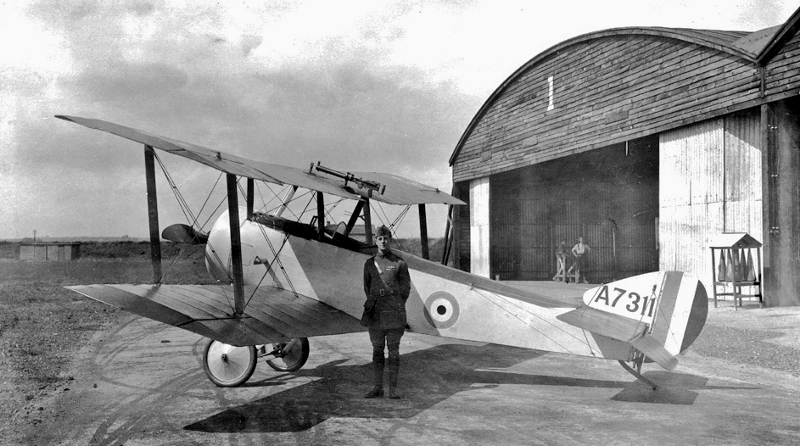
22-year-old James McCudden (above), already with five victories in DH2s and at present a fighting instructor at Joyce Green, has had his ‘Pup’ A7311 fitted with an over-wing Lewis gun which he can pull down to fire upwards if required. Yesterday he raced to the airfield to give chase to the Gothas but too late to get close enough. James writes glowingly about his ‘Pup’.
The supply of 80hp ‘Pup’ engines is a problem with Gwynnes of Chiswick and W H Allen of Bedford moving on to more powerful Clergets and Le Rhônes respectively. Gordon Watney & Co of Weybridge, previously only engine repairers, now takes an order for 200 80hp Clergets in addition to their recent order for 200 Le Rhônes. 100hp Gnome Monosoupapes are a possible but less favoured future alternative for ‘Pups’. The dearth of larger Clerget engines also continues. Many of the RFC’s new Ruston Proctor built ‘Strutters’ are leaving Lincoln without engines, going by rail to depots at Ascot or Hammersmith Brook Green.
At Grain a ‘Ship’s Pup’ with a plywood planing surface under the fuselage and a small hydrovane on the tailskid, jettisons its undercarriage before successfully ditching. It is not structurally damaged but has to be stripped and recovered. The engine runs again after a good wash out with paraffin and copious injections of castor oil.
‘Pups’ 9948 & 9 are now at Hendon fitted with catapult gear for more ground-breaking RNAS experiments.
On 15th June the observer dies of his wounds after ‘Strutter’ A1019 is shot up and crash lands, A1021 & A8230 are also hit and wrecked on landing whilst A971 & A980 crash on landing. ‘Pups’ A7309 & A7327 claim victories as do ‘Triplanes’ N5359, N5444, N5458 & N6307 whilst N5492 claims two but N5367 is wrecked landing too fast on uneven ground. At home ‘Pup’ 9935 is wrecked during training at RNAS Cranwell.
On 16th June both crew of ‘Strutter’ A381 are killed, A1021 is wrecked after being hit, A1016 is wrecked after an engine failure whilst A1003, A8308 & N5512 are wrecked landing. The pilot of wrecked ‘Pup’ B1708 is “badly shaken” after a spinning nose dive and A640 is wrecked landing. ‘Triplane’ N5483 claims a victory as does N5465 and then shares the capture of an intact DFW with N6299, N6295 shares one with N5493 whilst N5432 is hit and badly damaged, N5371 suffers an engine failure and N5378 crash lands.
Just three days after the devastating Gotha bomber attack the German Navy decides to bomb London with six airships. Two cannot leave their hangars due to high winds and two turn back with engine failure. One of the remaining two is L48, the latest five-engined U-Class Zeppelin designed to operate at 20,000ft. Abandoning hope of reaching London in the strong winds it bombs Ramsgate, a 660pounder hitting an ammunition store causing considerable damage, and then bombs Harwich but engine problems reduce it to 33mph and 14,000ft. Attacked by three home defence aircraft it is shot down in flames over East Anglia. Soon after dawn Yarmouth based 130hp Blackburn-built ‘Baby’ floatplane N1064 (below) gets up under the other airship on its way home at 11,000ft over the North Sea and fires a whole drum into it from 100ft but L42 then shoots up to 16,000ft. Yarmouth ‘Pups’ 9904 (below again) & 9905 take up the chase but cannot catch it at that height.
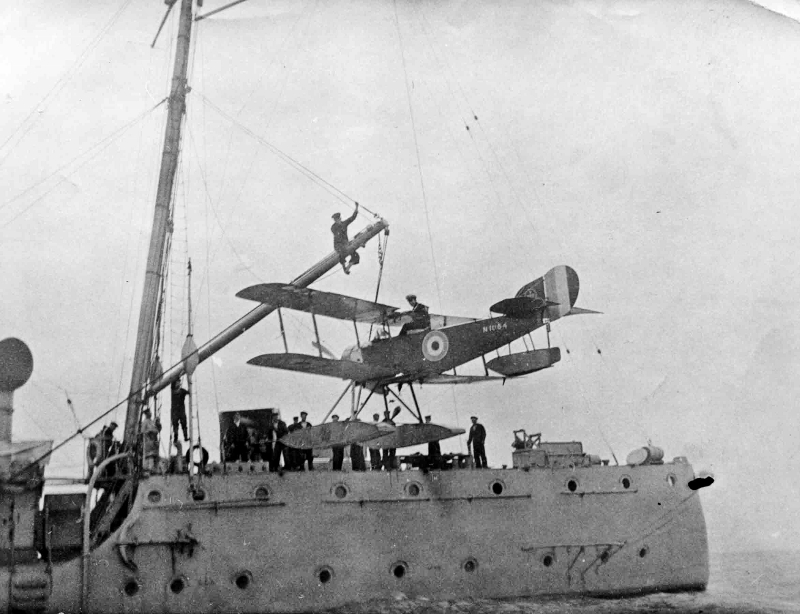
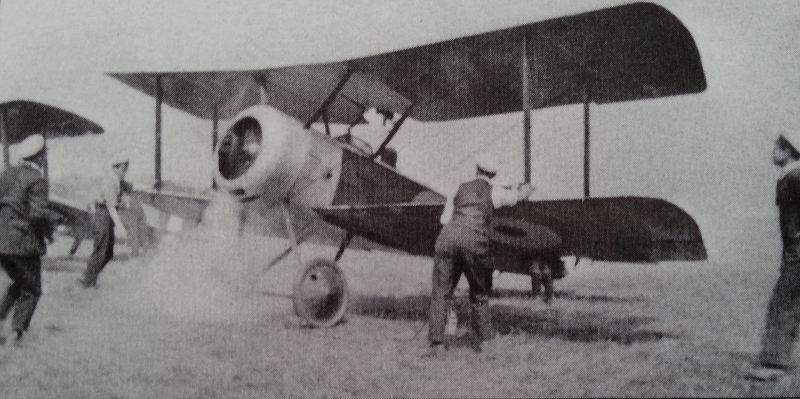
On 17th June ‘Strutters’ 9401, A8297, A8782 & A8789 are wrecked in landing accidents. ‘Pups’ A7327, B1709 & N6479 claim victories as do ‘Triplanes’ N5483 & N5492 whilst N5489 overturns “landing on bad ground”.
On 18th June ‘Strutter’ A2398 is wrecked as is ‘Baby’ 8207 whilst ‘Triplanes’ N5458 & N5359 claim victories.
On 19th June the pilot of ‘Baby’ floatplane N1015 is killed shot down by an enemy seaplane off Nieuport. 3(N) Sqdn ‘Pups’ run into a lot of “Archie” between Zeebrugge and Nieuport and then a hail storm, N6202 & N6466 land on a beach, N6202 is badly damaged. ‘Triplane’ N5459 smashes a propeller on rough ground.
On 20th June ‘Strutter’ N5173 is wrecked and ‘Pup’ N6169 crashes. After 5 months with 1(N)Sqdn ‘Triplane’ N5444 claims its seventh victory but is returned to depot to be deleted due to “general fatigue”. The only ‘Triplane’ in the Aegean N5431 claims a Halberstadt driven down.
‘Triplane’ N5431, rebuilt by the RNAS depot at Mudros in the Aegean after its crash in March, has since been returned “warped” and again reconditioned. That depot is very busy currently converting three ‘Strutter’ bombers to fighters to replace those recently lost and erecting the first of the ‘Pups’ arriving to replace the ‘Baby’ floatplanes as higher speed interceptors to counter the modern machines in use by the Germans. Now they are getting F Sqdn ‘Strutters’ back from Thasos for new engines and reconditioning.
On 20th June the Cabinet War Policy Committee decides that the home defence forces must be strengthened with fighter squadrons from the Western Front. The following day RFC 66Sqdn’s ‘Pups’ move to Calais with plans to intercept enemy bomber formations and Zeppelins over the Channel.
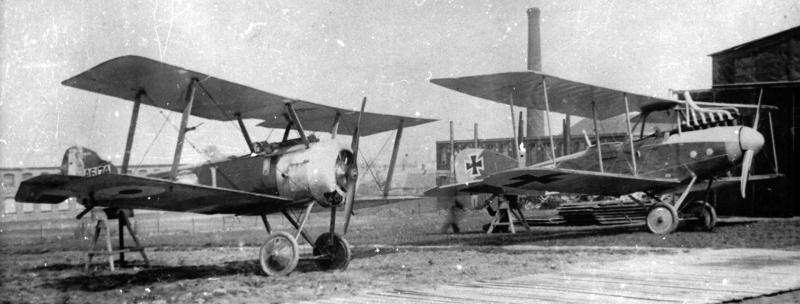
RFC 54Sqdn ‘Pup’ A6174 chased down in a flat spin a month ago and landing inverted, is photographed by its captors with a battered fin alongside an Albatros CX.( above) Their cockpit shot (below) shows it to have an Aldis gun sight mounted to the port side of the Vickers machine gun which has the original Sopwith padded windscreen behind it. This machine unusually has “CANADA” boldly painted across the top wing.
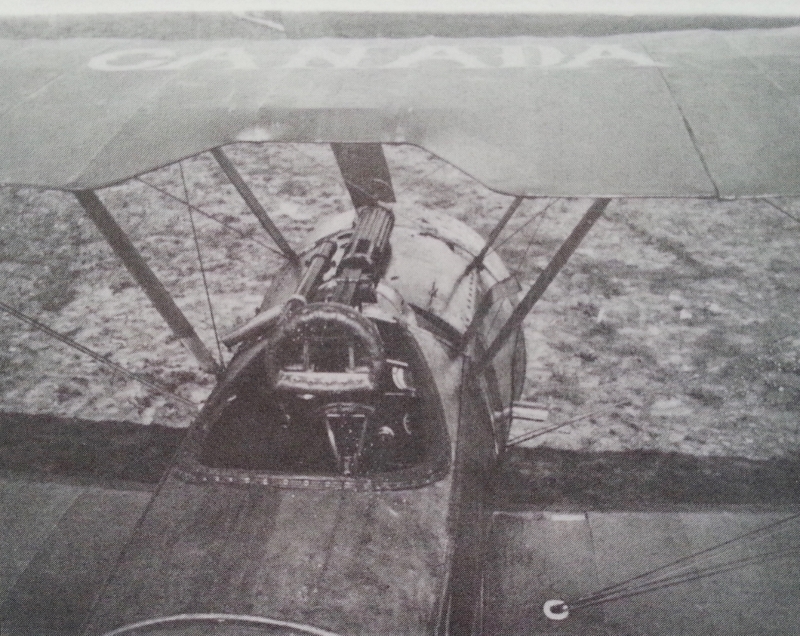
The Admiralty are cancelling the order they took over from the RFC for 166 ‘Triplanes’ from Clayton and Shuttleworth to free them up to build ‘Camels’, having long since done the same with the 100 on Sopwith.
On 21st June ‘Strutter’ A8278 is wrecked landing. The Australian pilot of ‘Pup’ B1709 is recorded lost in action when it fails to return. ‘Triplane’ N5493 claims a victory whilst N5376 forced lands after being hit by flak.
On 22nd June ‘Strutter’ A8289 is wrecked landing in France. Off Prawle Point the pilot of ‘Strutter’ N5604 on an anti-submarine patrol is killed when it plunges into the sea from 1,500ft.
On 23rd June the pilot of ‘Triplane’ N5442 is killed when it crashes after a wing collapses during a spin. 4(N)Sqdn get their eighth and ninth ‘Camels’ and record that event with a line-up.(below)
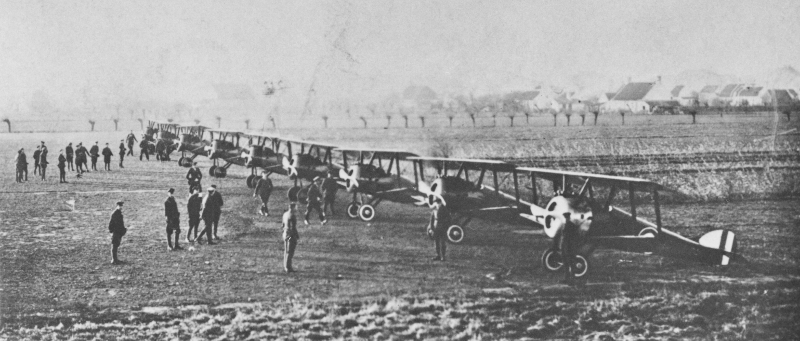
At Grain ‘Pup’ 9901 with added under-wing airbags successfully survives being anchored afloat for six hours. Their Port Victoria PV1 modified Sopwith Schneider floatplane 3742 is declared “beyond repair”.
On the evening of 23rd June “under the auspices of the Sopwith Cricket and Lawn Tennis Clubs an al fresco concert and dance takes place on the O.K’s sports ground. Unfortunately the temperature is most uncongenial for an open-air function, but in spite of the cold wind a good number patronise the concert, the majority occupying seats in the shelter of the stand. Mr. Alfred Smith secured the services of his Penrhyn String Orchestra. At a late hour the evening dancing commences, and many devotees enjoy a full programme”.
On 24th June ‘Strutter’ A8301 is wrecked on landing. Canadian Raymond Collishaw in ‘Triplane’ N5492 “Black Maria” claims his twenty-fourth victory and all in Sopwith aircraft: two each in ’Strutters’ and ‘Pups’ and twenty in ‘Triplanes’, sixteen of those this month. ‘Triplanes’ N5366 & N6307 also claim victories today but N5358 is shot down and the pilot killed (below with Q code marking) as is N6306 with the wounded pilot taken prisoner whilst N5483 is damaged in a forced landing.
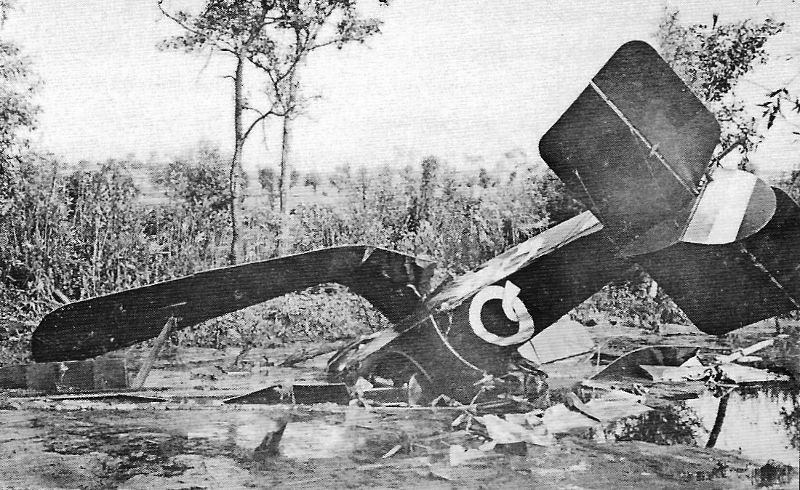
At home ‘Pup’ B2153 bends an axle landing in bumpy weather training at Croydon and N6445 collapses its undercarriage during further deck landing trials at Grain.
On 25th June ‘Strutter’ A8790 is wrecked as are A2412 and ‘Triplane’ N5359 after engine failures whilst ‘Pup’ A6208 crashes after getting into a spin during tests. ‘Triplane’ N5376 is shot down, the wounded pilot taken prisoner. 4(N)Sqdn claim two victories in ‘Camels’ including the first with a Bentley BR1 engine. Sopwith have already surpassed their initial output of forty-nine ‘Camels’ in May. The fifty-fifth of the second batch B3805 is at Brooklands( below) ready to go to RNAS Dover.
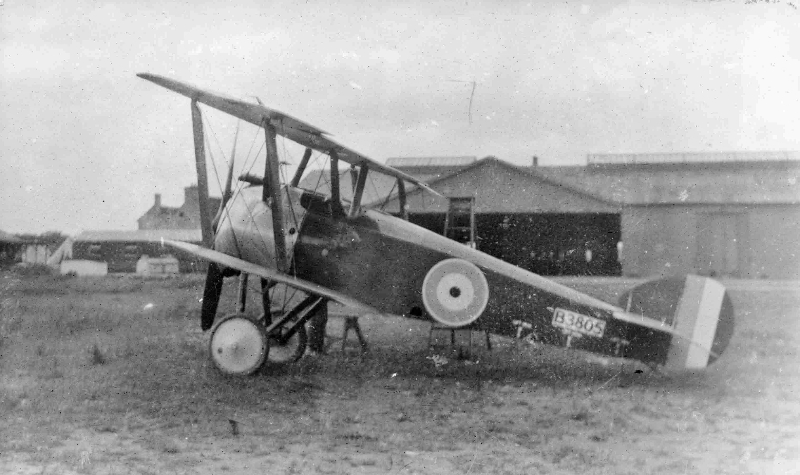
On 25th June the Whitehead Aircraft Company’s pilot H Sykes is injured when a ‘Pup’ engine fails during a test flight from Hanworth Park Aerodrome. Jack Whitehead has bought the 300 acre Hanworth Park and its mansion, currently a military hospital, and built a large wood and corrugated iron single storey assembly factory. Aircraft have been arriving by lorry(below) from his Richmond factory five miles east but sub-assemblies are also now being manufactured at Hanworth.(below again) Jack Whitehead is planning to open a Whitehead Flying School this year and develop the aerodrome as a commercial airport once the war ends. The Longford River which feeds the lakes at Hampton Court divides the park and German prisoners of war are involved in the massive task of taking it underground to expand the usable airfield area.
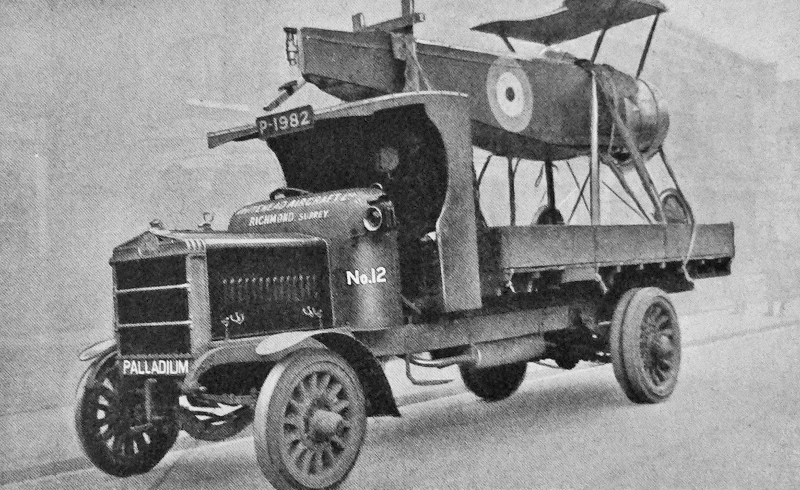
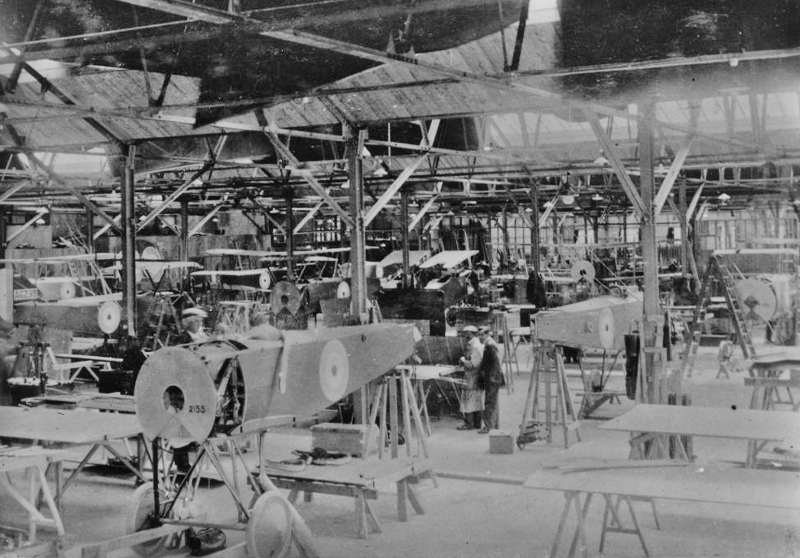
Despite Admiralty instructions to Beardmore to concentrate their efforts on rigid airships, their first production folding-wing, fold-up undercarriage Sopwith-Beardmore SBIIIF version of the Sopwith Pup N6100 is test flown at Dalmuir on 25th June and is officially accepted on the 26th June.
On 26th June the RFC in France test the improved MkIII version of the Sopwith-Kauper synchronising gun gear on ‘Camel’ N6332 and the aircraft goes straight on to 70Sqdn. They consider the MkII gear unusable due to stiff firing levers and constant need for adjustment and demand MkIII gear for all RFC ‘Camels’ despite noting the area of fire varies considerably with engine rev changes and it needs regular adjusting. They have also got news of stronger undercarriages being fitted to ‘Pups’ used for training at home and demand some of those.
On 26th June ‘Strutters’ A1904 & A1011 are wrecked as is ‘Pup’ A7325 overturning in a forced landing in a wheat field. ‘Triplanes’ N5493 & N5366 both claim victories.
On 27th June the RFC send their first Ruston Proctor-built ‘Camel’ B2301 to the French in Paris as a replacement for the ‘Camel’ they crashed late May.
On 27th June the air gunner in ‘Strutter’ A8334 is hit by machine gun fire from the ground and dies of his wounds whilst A1027 & A1033 are wrecked. The pilot of ‘Pup’ B1728 dies of his injuries after failing to recover from a spin during tests whilst 9905 overturns on landing. The photograph of 9905(below) probably after a previous crash shows it fitted with an over-wing Lewis gun and RNAS officers playing the fool.
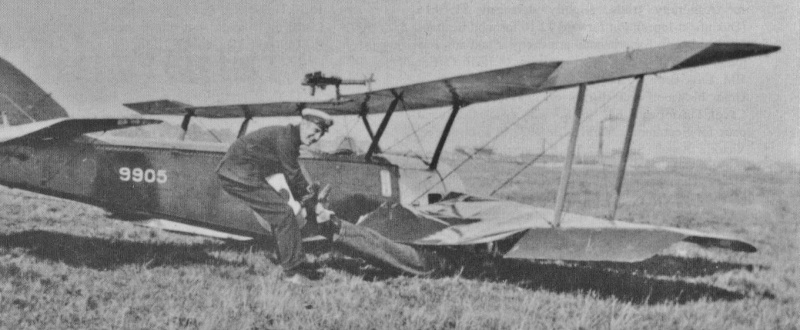
There is the first victory for an RFC 70Sqdn ‘Camel’ and one for ‘Triplane’ N6292. RNAS DH4 N5981 lands on top of the starboard wings of French ‘Triplane’ F8/SP17 at St Pol wrecking both machines.(below)
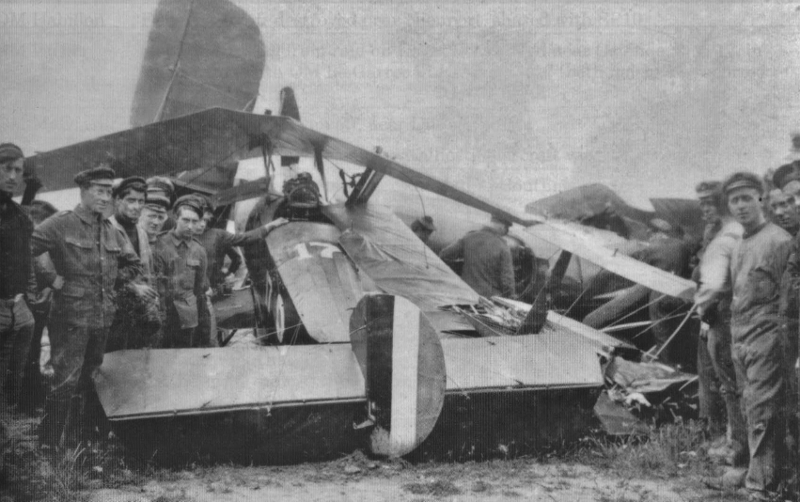
Having previously lost three machines in crashes, the French have just this week received their first three replacement ‘Triplanes’ F11 to F13 confusingly to be marked with pre-used St Pol numbers SP9, SP12 & SP13. Built by Clayton & Shuttleworth as N5384 to 6 they have the latest small area tailplane clearly seen in the photograph of F11/SP9(below) in comparison with SP17 above. The halo around the pilot’s helmet is the Sopwith patent padded windscreen on the back of the single Vickers gun.
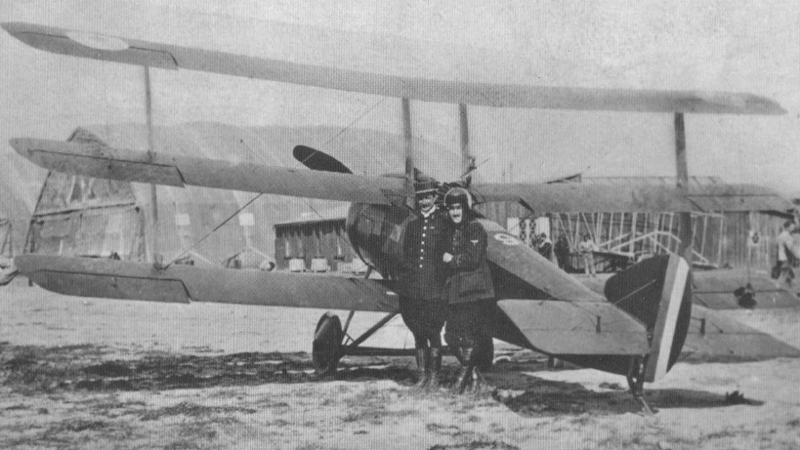
Fl Cdr Rutland has just arrived back via Sweden from internment in Denmark after ditching ‘Pup’ 9918 on the fruitless anti-Zeppelin flight from HMS Manxman on 29th April. Before that he had convinced the Navy that he could fly a ‘Pup’ off an even shorter 15ft deck and they have had one built on the cruiser HMS Yarmouth. Other pilots think it a crackbrained scheme and believe Rutland should be the first to try it. On 27th June he successfully flies a ‘Pup’ from a 15ft6in demonstration deck built above the normal flying deck of HMS Manxman. With the ship steaming at 19knots the wheels leave the deck almost immediately. On 28th June he is on the short fixed deck of HMS Yarmouth in the Firth of Forth in ‘Pup’ N6431. With the wheels chalked to mark the length of run and the ship’s speed regulated to give an air speed of 25 knots he makes the first flight from a fixed platform on an operational battleship using 14ft9in of the deck (below) with the machine fully loaded for a Zeppelin interception with a Lewis gun through the top wing, two 97 round ammunition trays, twelve Very Lights and a Very pistol.
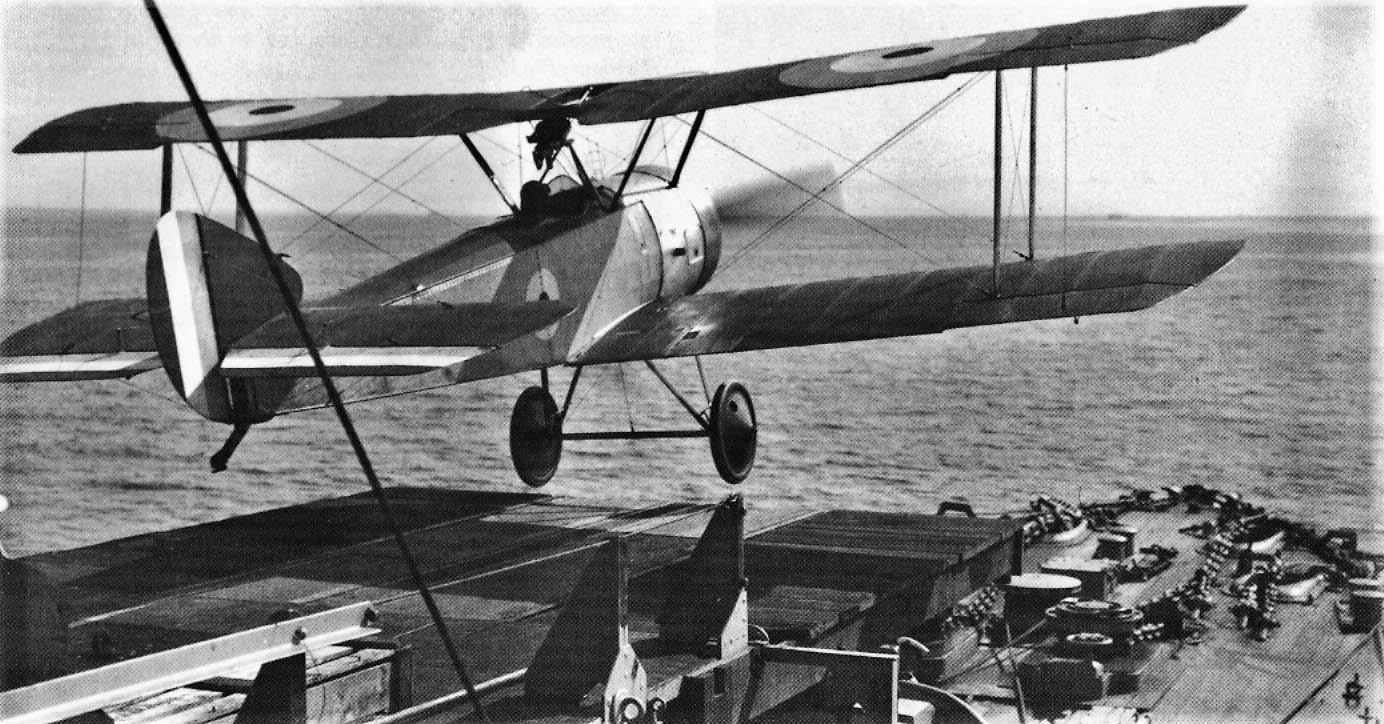
On 28th June ‘Triplane’ N5471 is hit by machine gun fire and makes a forced landing in the front-line trenches.
On 29th June ‘Strutter’ A8229 is wrecked after an engine failure on take-off as is ‘Pup’ A6192 injuring the pilot whilst N6176 forced lands lost in mist. ‘Triplane’ N5493 shares a victory with N6292. The pilot of the RNAS’ first prototype Camel N517 is killed when it is wrecked.
On 29th June Sopwith’s order book reaches an amazing 1,000 machines with an RFC order for 500 ‘Dolphin’ high-altitude fighters to follow on from their current orders for 500 ‘F1 Camels’ and 50 ‘2F1 Ships Camels’. The ordering of so many of this 200hp Hispano Suiza engine design before the much revised second prototype has flown shows great confidence in the Sopwith team. Uniquely for any design team this brings six (seven?) of their types into volume manufacture at the same time: Baby, Strutter, Pup, Triplane, Camel/Ship’s Camel & Dolphin.
Parnall Aircraft in Bristol who are currently building thirty Fairey Hamble Baby versions of the Sopwith Baby on sub-contract from Fairey Aviation have now received a direct Admiralty order for a further one hundred.
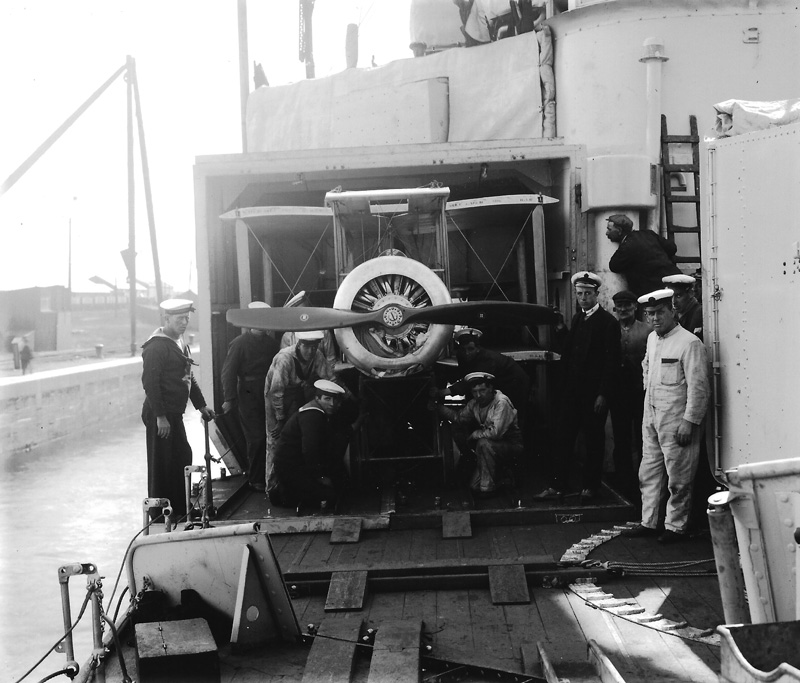
Beardmore’s first 80hp ‘SBIII Pup’ N6100 with folding wings and drop undercarriage has gone straight to the Vickers shipyard at Barrow Docks for a trial fit into the tiny hangar they have built on the cruiser HMS Cassandra. The photographs(above and below) taken on 29th June illustrate the snug fit in the hangar and N6100 on the Cassandra’s troughed take-off ramp.
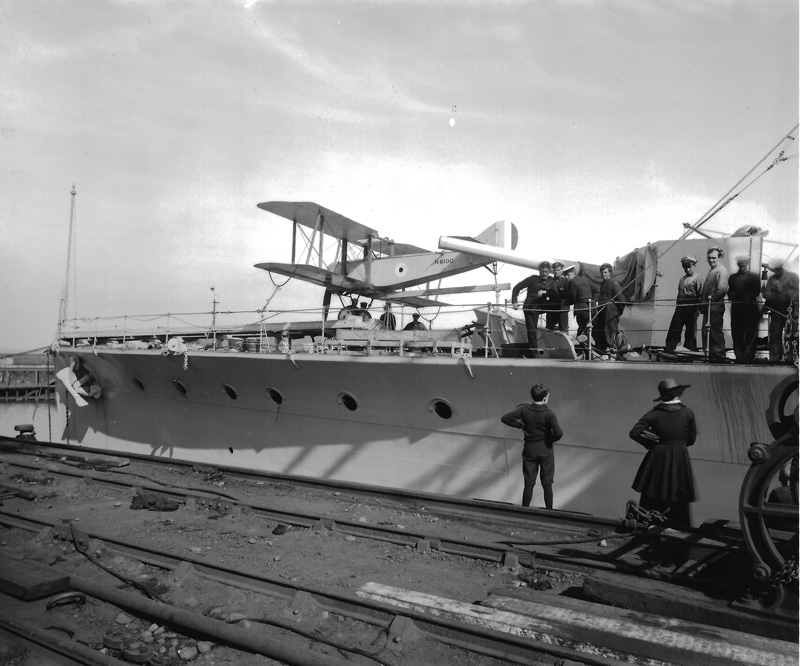
By 30th June the anti-sub bases along the western approaches at Mullion, Prawle Point and Pembroke are receiving twelve new Strutter bombers transferred to the RNAS from outstanding RFC orders, two from Morgan A5951 & 2 and ten from Hooper A6910 to 13 and A6917 to 22. These are supplementing the existing RNAS ‘Strutters’ like this one (below) pictured outside the airship sheds at Mullion on the Lizard peninsular. (below again)
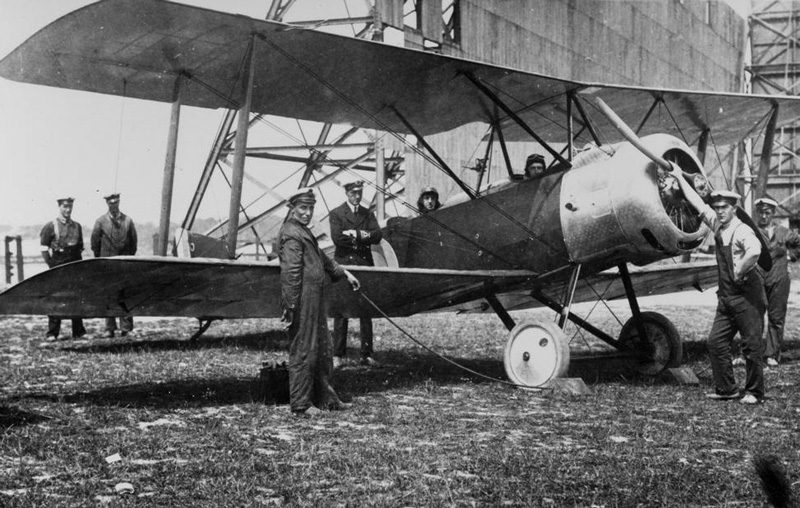
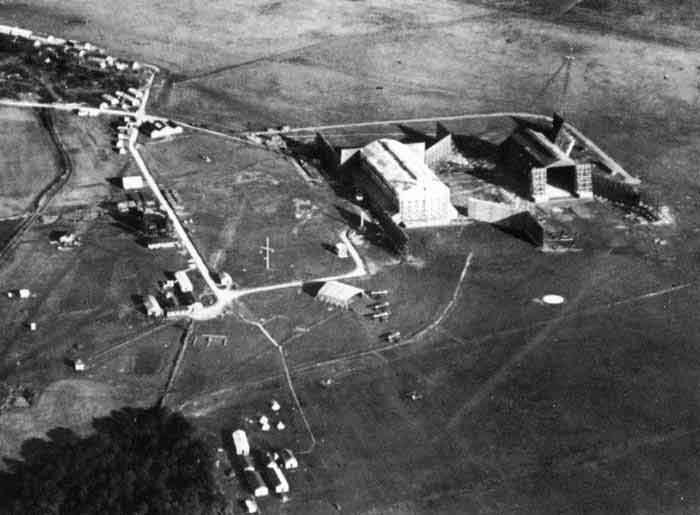
Through June RFC 45 Squadron have also been getting replacement ‘Strutters’ with 130hp engines but the slightly better performance at altitude is no advantage whilst they continue to photograph the German trenches opposite the British 2nd Army. Although combats with the German fighter formations only occurred on four days and they claimed eleven victories, June has been 45 Squadron’s worst month suffering twenty-one casualties, seventeen of those fatal.
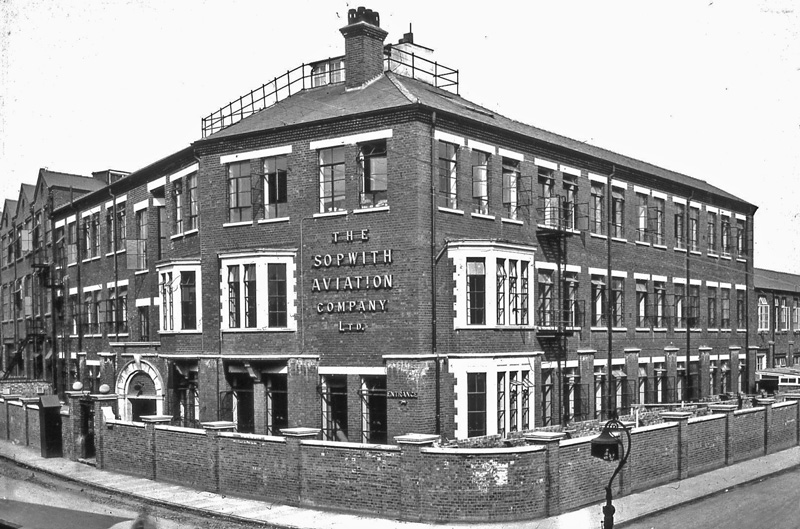
The fourth extension to Sopwith’s factory in Canbury Park Road, Kingston is complete including the fine three-storey office building on the corner of Elm Crescent. (above) The original factory is can be seen to the right and the new factory extension to the left. The first floor offices with bay windows are the Board Room and Thomas Sopwith’s office. The railings on the roof lead to a look-out post. The outer walls hide cycle sheds and other storage. The factory now covers 5½ acres, apart from the aircraft assembly area all two-storey workshops with three storeys along the north and west edges. With these enhanced facilities and a total focus on one type, Sopwith’s output in June is up a further 30% to a record 85 machines, all ‘F1 Camels’.
The total of new Sopwith designed aircraft from all suppliers in June is 288. The 203 Sopwith machines from other manufacturers are 87 ‘Strutters’ from Fairey (8), Hooper (14), Mann Egerton (5), Morgan (12), Ruston Proctor (39) and Wells (9); 80 ‘Pups’ from Beardmore (11), Standard Motors (40) and Whitehead (29), 14 ‘Triplanes’ from Clayton & Shuttleworth, 1 ‘Camel’ from Ruston Proctor with 21 ‘Baby’ floatplanes from Blackburn (13), Parnall (7) and Fairey (1).
Beardmore have completed their orders for 80 ‘Pups’ and move on to build 100 SBIII/WBIII folding wing variants.
This week’s Aeroplane journal records T O M Sopwith, F Sigrist and W G Carter (from the Sopwith Drawing Office team) in a long list of recently elected Associate Fellows of the Aeronautical Society of Great Britain.
On 2nd July ‘Triplane’ N5492 claims a victory in France whilst ‘Pup’ A7338 (below) stalls and crashes on top of a mess hut at Castle Bromwich ending its brief spell at 43 Training Squadron.
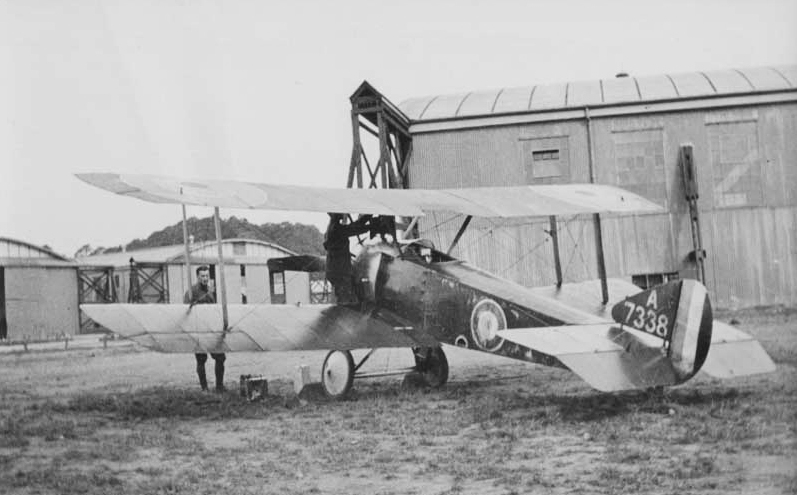
On 3rd July ‘Strutter’ A8173 is wrecked and ‘Pup’ A7327 claims a victory whilst N6461 hits another aircraft on take-off and crashes into a ditch. ‘Triplane’ N6291 claims two victories, N5373 & N6292 each claim one, N5493 & N6292 share a victory, N6299 forces down two Aviatiks and N5380 overturns forced landing with an engine failure. ‘Pup’ 9943 is damaged operating from HMS Manxman.
Over Macedonia a newly trained ex-observer pilot flying a ‘Strutter’ for the second time gets N5211 into a spin at 6,000ft whilst making a vertical bank and loses 800ft getting out of it. Over the Aegean ‘Schneider’ 3792 is damaged landing from a nosedive.
At 7.20am on 4th July eighteen undetected Gotha three-seat twin engine bombers start dropping bombs on the “soft target” of Harwich naval installations and the RNAS Station at Felixstowe on opposite sides of the Orwell estuary killing 17 and injuring 30. One ‘Baby’ floatplane is destroyed but many bombs fall in the water. The AA gunners are hampered by low coastal cloud. The Home Defence Group eventually sends up 103 pursuers having assumed that the raid is going on to London. Inexplicably the RFC 66Sqdn ‘Pups’ at Dunkirk are not notified for 50 minutes by which time the bombers are already back through the Pup’s designated search area. ‘Pup’ B1744 overturns on landing. Five 4(N)Sqdn ‘Camels’ from Dunkirk do find the Gothas thirty miles north-west of Ostend. N6337, 47 & 63 claim that they send one down out of control, one on fire and two more damaged. At Castle Bromwich ‘Strutter’ A1056 on a training flight lands in a tree. (below)
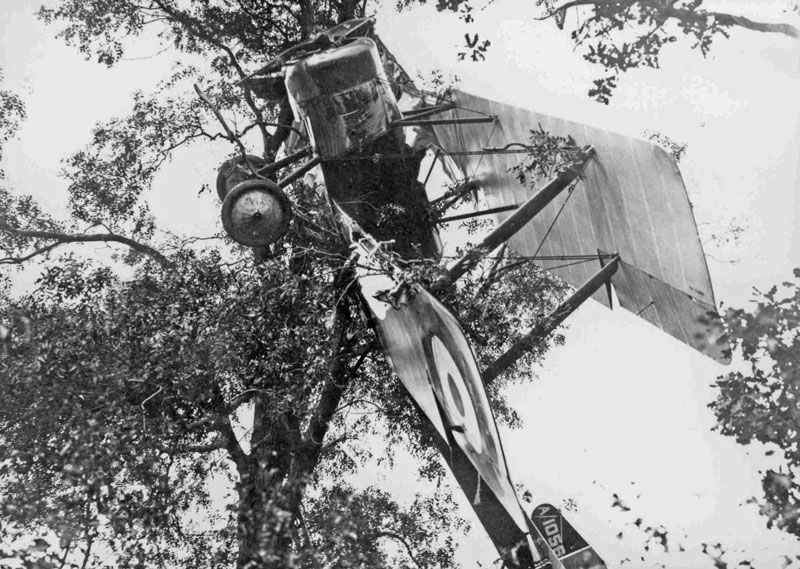
There are no records of RNAS ‘Camel’ N6338 since it was built in May until yesterday when it was flown as B3977 to RFC 65Sqdn at Wye. Today there are reports it has crashed.
On 4th July Clayton and Shuttleworth receive an order for one hundred ‘Camels’ to replace their cancelled large repeat order for ‘Triplanes’. On 5th July Hooper receive a second order for fifty ‘Camels’. 1,600 ‘Camels’ have now been ordered.
The RFC’s prototype ‘Camel’ F1/3 B381 fitted with a 110hp Le Rhône has recently been undergoing engine performance comparisons at Martlesham Heath with Sopwith’s first RFC ‘Camel’ B3751 fitted with a French-built standard 130hp Clerget 9B. B381 is now testing a long-stroke higher-compression 140hp Clerget 9Bf. B3751 has now had its gun “hump” cowling removed to reveal the gun breeches for firing tests. (below)
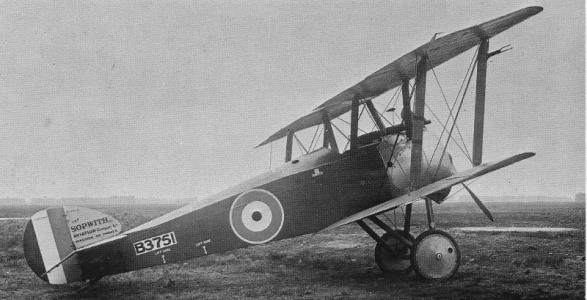
On 5th July Trenchard is informed that 24 of the 54 ‘Camels’ he is expecting in France in July are being diverted to Home Defence as a result of Zeppelin and Gotha bombing raids, as are some of his ‘Pup’ Squadrons.
On 5th July the pilot of ‘Strutter’ A8262 is killed and the mechanic injured in a side-slip crash on take-off. ‘Pup’ A6215 forced lands with magneto trouble and B1732 stalls from a misjudged landing.
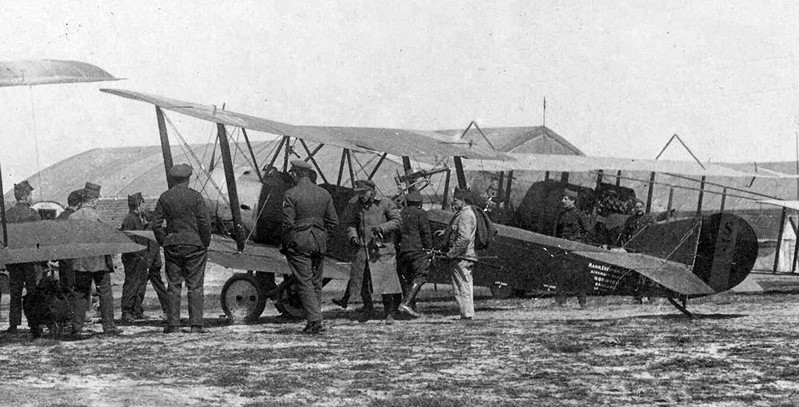
With significant numbers of ‘Strutters’ already gone to Russia, eight Mann Egerton RNAS ‘Strutters’ N5235 to 42 have now been transferred to the Belgian Aviation Militaire re-numbered S1 to S8 (above), they are also having ten Ruston Proctor ‘Strutters’ A8173 to 81 and four Fairey-built ones A1034 to 6 & A1046. On 6th July King Albert of the Belgians is flown over the lines in a ‘Strutter’ by Belgian pilot Jacques de Meeûs. (below)
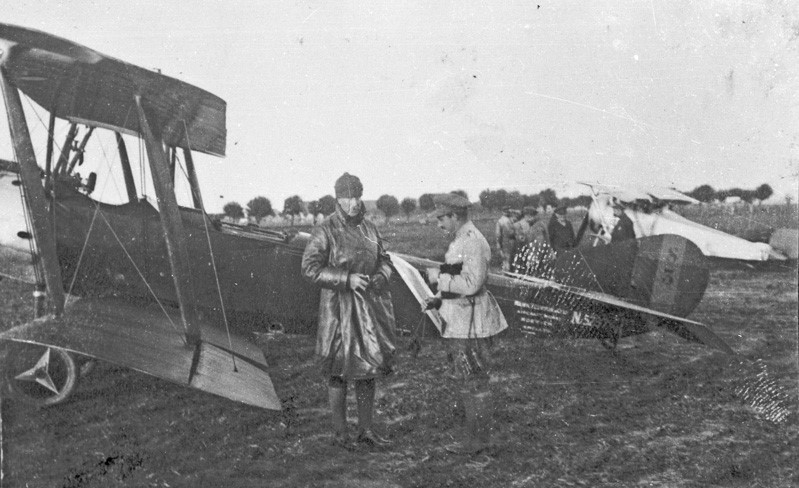
Also on 6th July the crew of ‘Strutter’ B714 are killed in combat during a photographic mission whilst A1023 loses a wheel taking-off and is wrecked on landing. The pilot of ‘Pup’ N6181 is killed when it dives into a wheatfield. ‘Triplane’ N5492 claims two victories, N5483, N5487 & N6292 one each whilst N5435 is shot down killing the pilot and N5375 is wrecked in a forced landing. ‘Camels’ N6337 & N6370 share a victory.
At 10.20am on 7th July 21 Gotha bombers make a daring bombing raid on London one with engine trouble already having peeled off to bomb Margate. The bombs drop between Kentish Town, Hackney and Tower Hill killing 57 and injuring 193 and causing considerable damage. The 108 home defensive sorties include 37 by Sopwith machines. Hampered by engine problems and gun jams they only manage to shoot down one home going Gotha although several are badly damaged. The crew of ‘Strutter’ A8271 die apparently after being hit by British AA fire, the pilot of ‘Pup’ A6230 receives a fatal head wound, A653, A7311 & B1764 are shot up and damaged whilst B1747 is wrecked landing. Manston based ‘Triplane’ N5482 & ‘Camel’ B3774 both claim a Gotha and ‘Triplane’ N5424 an escort fighter whilst N5483 crashes on landing and ‘Camels’ B3761 & 73 crash with engine failure. ‘Baby’ 8186 taking off in rough seas bursts its propeller cutting the floats and overturning. ‘Pup’ A653 with its trial 100hp Gnome Monosoupape engine is one which flies from Stowe Maries. It now has an additional overwing Lewis gun but that considerably reduces the performance. Dunkirk ‘Pups’ N6162, 83, N6465, 77 & 79 and ‘Camels’ N6337 & 47 claim four of the seaplanes sent out to escort the returning Gotha bombers.
Over France on 7th July the crews of ‘Strutter’ A1029 & A8281 are lost in combat whilst A1026 is badly damaged by AA fire. ‘Pups’ A6206, A7347, N6174 & N6485 claim a victory each as does N6462 before sharing another with two other ‘Pups’ and then spinning in with fatal consequences. B1725 & B1758 are shot up and crash with both pilots wounded, one fatally. Five 54Sqdn ‘Pups’ are damaged at Bray Dunes by enemy bombing aimed at depleting Allied resources on the coastal sector before a planned German land offensive. ‘Triplanes’ N5429, N5479, N6296 & N6300 all claim victories but N5480, N6291 & N6309 are shot down and the pilots killed.
In the Aegean on 7th July the repaired ‘Triplane’ N5431 escorts a ‘Strutter bomber’ and a two-seat ‘Strutter’ on a night bombing raid on Smyrna Harbour.
On 8th July ‘Strutter’ A8236 is crashed on its delivery flight after extensive repairs in England.
On 9th July ‘Strutter’ A8334 is wrecked forced landing with engine problems whilst the pilot of ‘Pup’ A7319 is killed when it breaks up in the air.
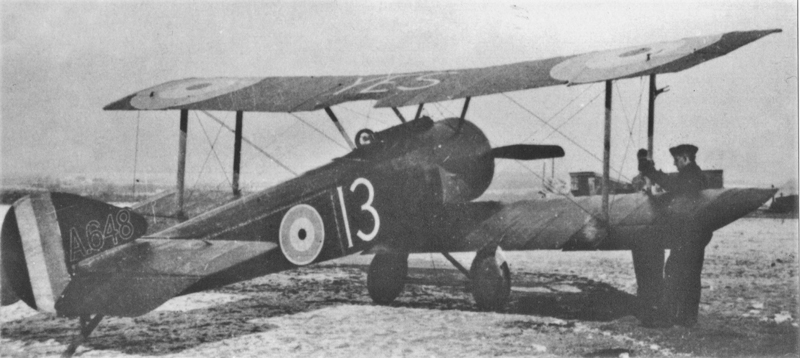
On 10th July one crew is killed and two injured in ‘Strutters’ A8204 & A5242 in training accidents in England. ‘Pup’ A648 “YES” (above) is one of the 46 Squadron machines which return to England for Home Defence duties although A6202 crashes taking-off in France and A7348 ditches in the Channel. In France ‘Camel’ N6368 shares a victory with N6369 whilst N6361 is shot down and the pilot killed.
The first production Beardmore ‘SBIII/WBIII Folding Pup’ N6100 which was flight tested and accepted on 26th June has gone to Vickers. The second N6101 was accepted on 6th July and is on its way to East Fortune for HMS Manxman. On 10th July N6102 & 03 are flown and accepted ready to be packed and sent by train to RNAS Grain. All have folding wings. The first three have a fold-up undercarriage, the other has a dropping undercarriage saving 50lb and reducing head resistance and it has just been decided that this will be fitted to all machines.
On 11th July ‘Strutter’ A977 is wrecked in a forced landing with engine failure. ‘Pups’ A6240 & B1703 claim victories whist N6177 crashes. ‘Triplanes’ N5487 & 92 claim victories, N5460 shares a captured two-seater with N6292 whilst N5357 is shot down and the pilot taken prisoner. The pilot of N5426 is wounded in combat, N5382 & N5422 crash on landing and N5494 crashes on take-off with a choked engine. ‘Camel’ N6335 crashes on take-off, B2344 & N6346 crash when landing with engine problems and N6331 is wrecked overturning on landing. At Scampton the engine cowl comes off ‘Pup’ A6226 and “attempting a flat turn” it nose-dives injuring the pilot.
On 9th and 11th July five ‘Pups’ N6450 to 54 from Beardmore arrive at Armstrong’s shipyard in Newcastle for HMS Furious which now has a longer 228ft by 50ft flying deck in front of the superstructure. It has a centre guide rail for the seaplane launching trolley. (below left) Around the edge of the flying deck is a retractable windbreak palisade. Served by the two 40ft wooden derricks, access to the workshop and hangar is through a hatch which is narrow even for Sopwith ‘Pup’ N6454. (below right)
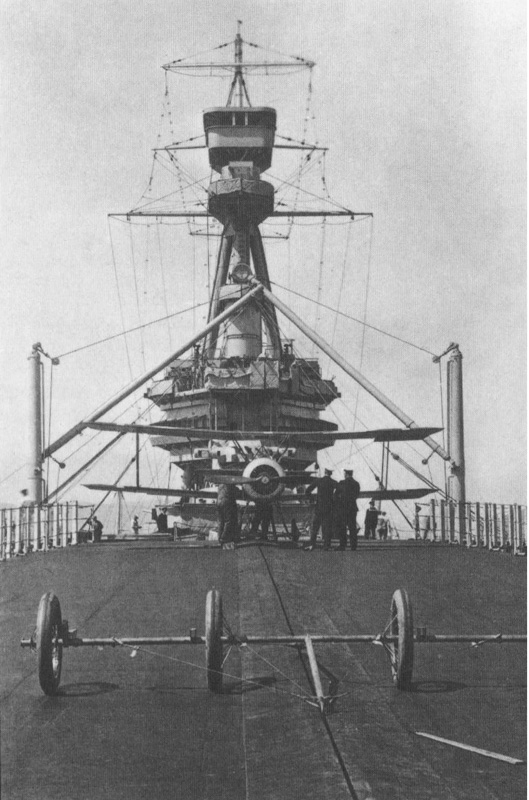
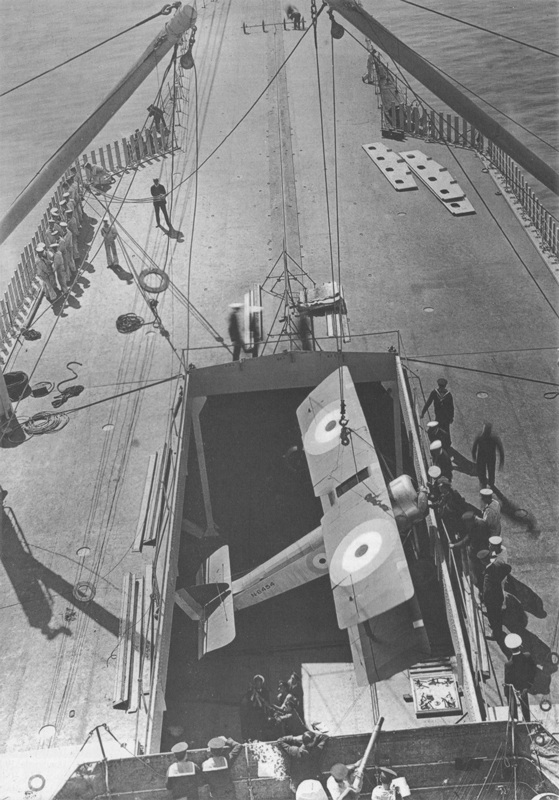
The positioning of up to eight aircraft inside the hangar is achieved by moving them fore-and-aft loaded sideways on a central rail-mounted handwheel-powered platform. (below)
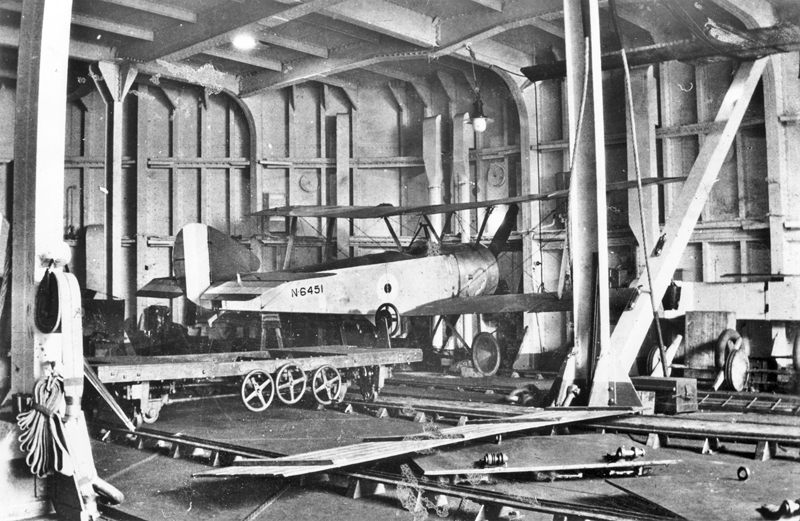
In April and May Manfred Von Richtofen and General von Hoeppner publicly declared the Sopwith Triplane to be the best allied fighter. In June the Germans started testing a captured Sopwith Triplane at Aldershof (below) and German aircraft manufacturers have been invited to examine the machine and design a triplane fighter. Fokker’s Reinhold Platz has designed a diminutive triplane prototype around a Swedish licence-built 110hp Le Rhône rotary engine. It has no interplane struts and suffers from vibration in flight. Its successor, the Fokker F1/Dr 1 now going into production will have single outboard struts like the Sopwith triplane.
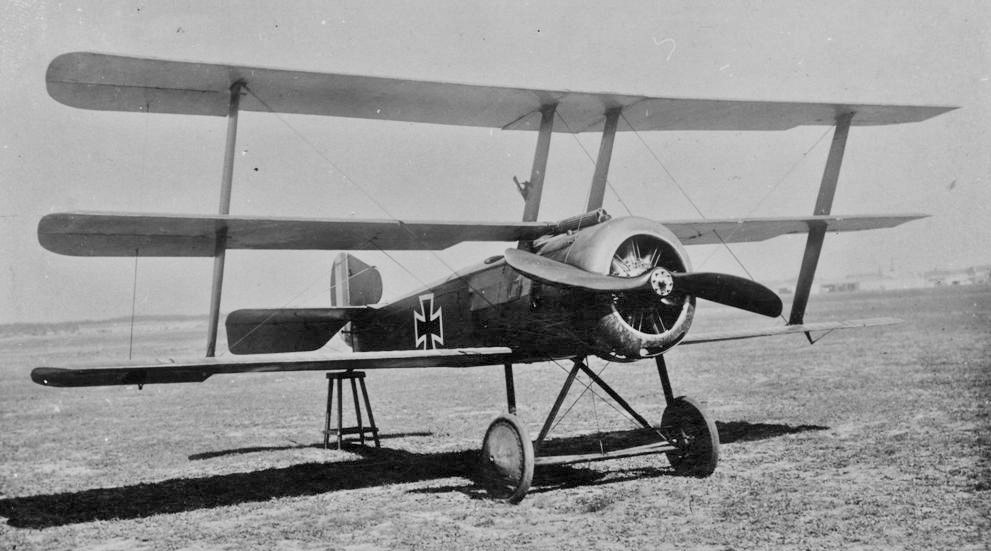
Meanwhile Sopwith Aviation push ahead with the development of their second-generation high-altitude fighter. The second prototype 200hp Hispano Suiza powered Sopwith Dolphin retains the back staggered wings and the deep fuselage with the pilot sitting high up in the steel tube frame which connects the top wings.(below) To tackle nose heaviness and the pilot’s restricted forward vision the large radiator at the front has been replaced by small triangular ones in the roots of the top wings close to the aircraft’s centre of gravity, allowing the top and bottom longerons to curve round the engine giving it a streamlined nose. The poor downward vision has been addressed by leaving open panels in the lower wings just outboard of the undercarriage and there is a smaller fin but larger rudder with a horn balance to address the control issues.
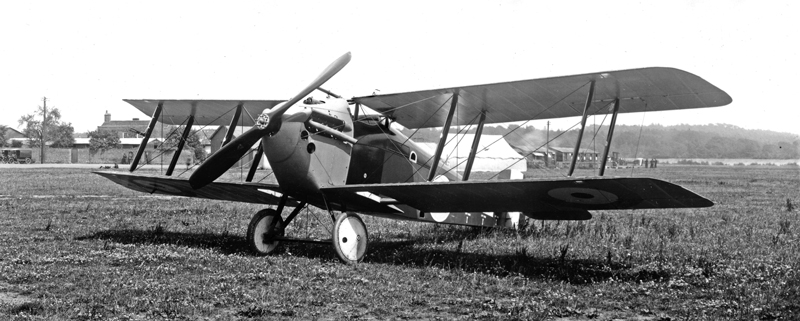
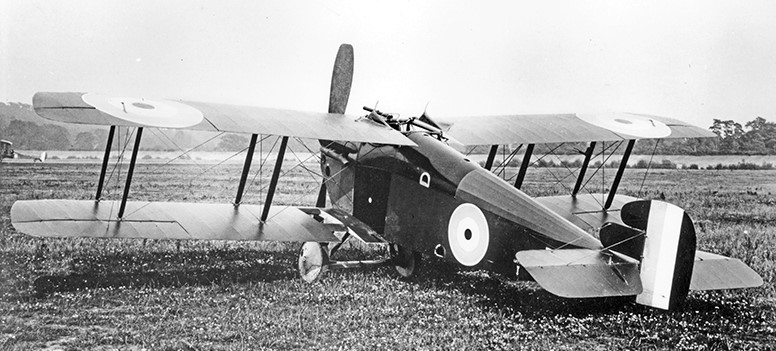
It has already been back to Kingston and now re-appears at Brooklands with a spinner on the propeller and larger triangular radiators in the wing roots. (below) The cooling is still inadequate and it is going back again to have tall 5in wide rectangular block radiators installed on either side of the cockpit.
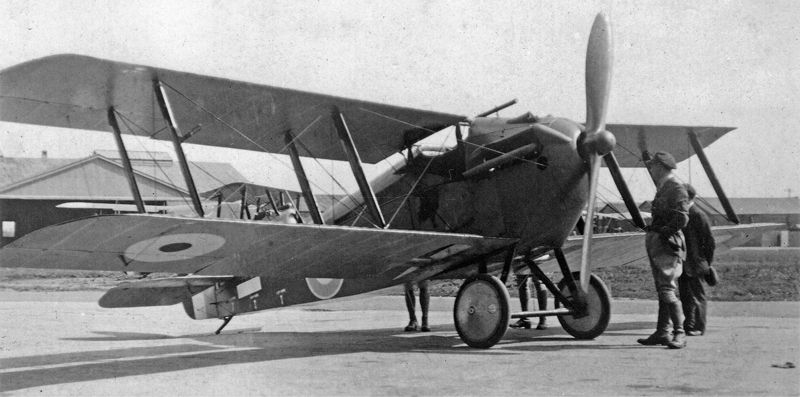
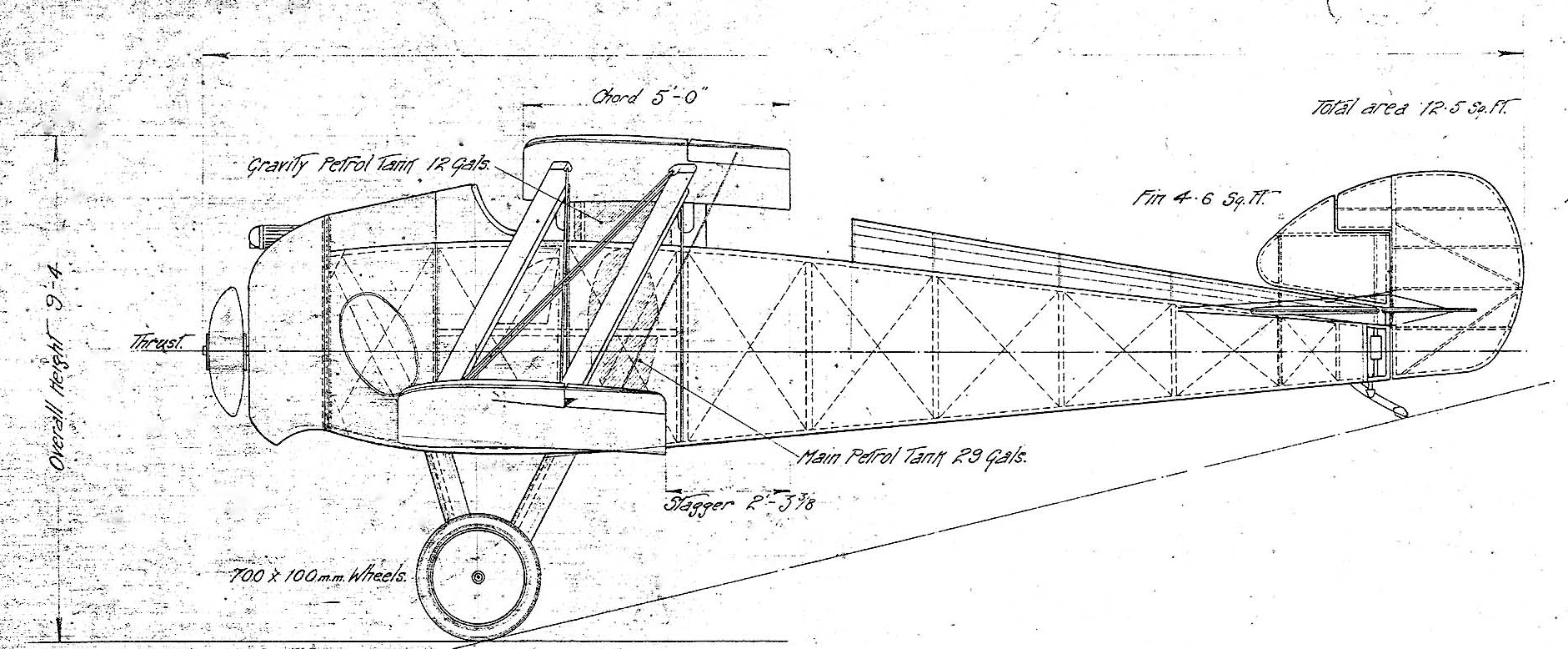
In parallel with the Dolphin design back in April Herbert Smith was working on a two-seat fighter aimed primarily at French orders. The GA Drawing (above) dated 30/4/17 shows that despite using a large rotary engine it is a very similar configuration to the Dolphin with back staggered wings and the crew high up in a deep fuselage. There was no French interest and they continue to build thousands of Sopwith ‘Strutters’ but the design remains an option for any new competition for a British two-seater.
On 12th July ‘Strutter’ A1036 claims a victory whilst A1025 crashes after combat with the pilot killed and the observer wounded. A956 crashes landing with an engine failure, A1006, A8793 and A1903 are also wrecked in crashes. ‘Pups’ B1731 & B1760 claim victories, A6198 crashes and A7339 is damaged when the propeller shatters running up the engine. ‘Camels’ B3756 & N6378 claim victories but both pilots are killed when N6350 is shot down in flames and N6337 spins-in on take-off. ‘Triplane’ N5483 claims two victories, N5492, N6303 & N6307 claim one each but the pilot of N5368 is killed when shot down. N5369 hits a cornfield at some 80 knots, does a complete somersault over a road and finishes on its wheels with the rear fuselage from just behind the pilot’s seat doubled under the aircraft, the tail now in front of the engine. (below) The pilot has a few cuts and bruises. The RFC report more fighting in the air on 12th July than on any day since the commencement of the war.
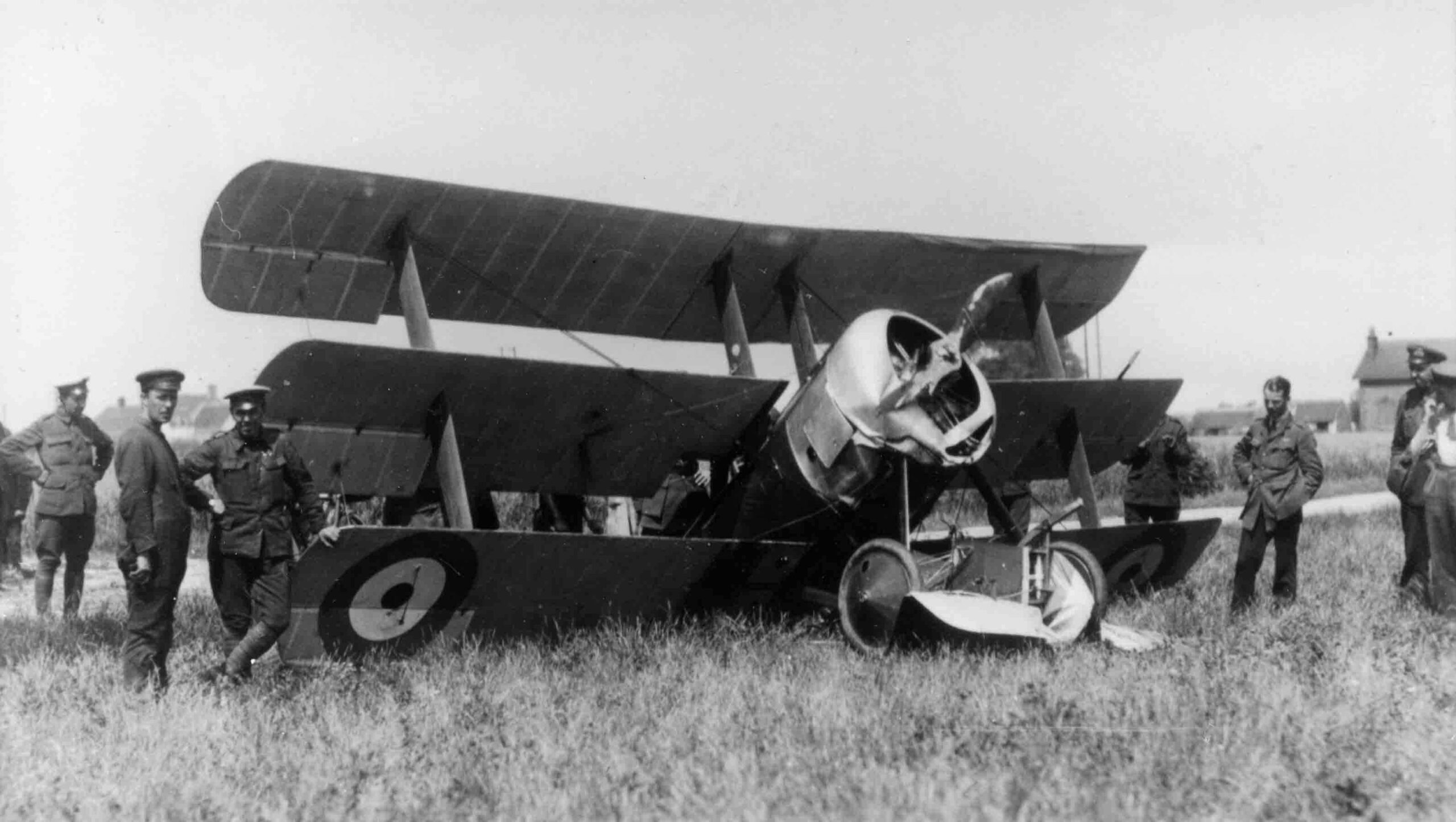
Clayton and Shuttleworth have completed their first order for 40 Sopwith ‘Triplanes’ and now the first of six with twin Vickers machine guns N533. On 12th July it arrives at St Pol.
Despite huge orders for more potent fighters including ‘Camels’, orders continue to flow for 80hp Sopwith ‘Pups’ which are proving useful in many roles including Home Defence and training in aerial combat. Last week Whitehead had an order for 150 ‘Pups’ bringing their total to 350, 116 of which have been delivered. On 13th July Standard Motors get an order for 250 bringing them to 500 of which 198 have been delivered.
Blackburn are building a few Sopwith ‘Baby’ floatplanes for the Norwegian Naval Air Service apparently in addition to 121 for the Admiralty. The first of these F100 makes its first flight in Norway on 13th July at Horten.
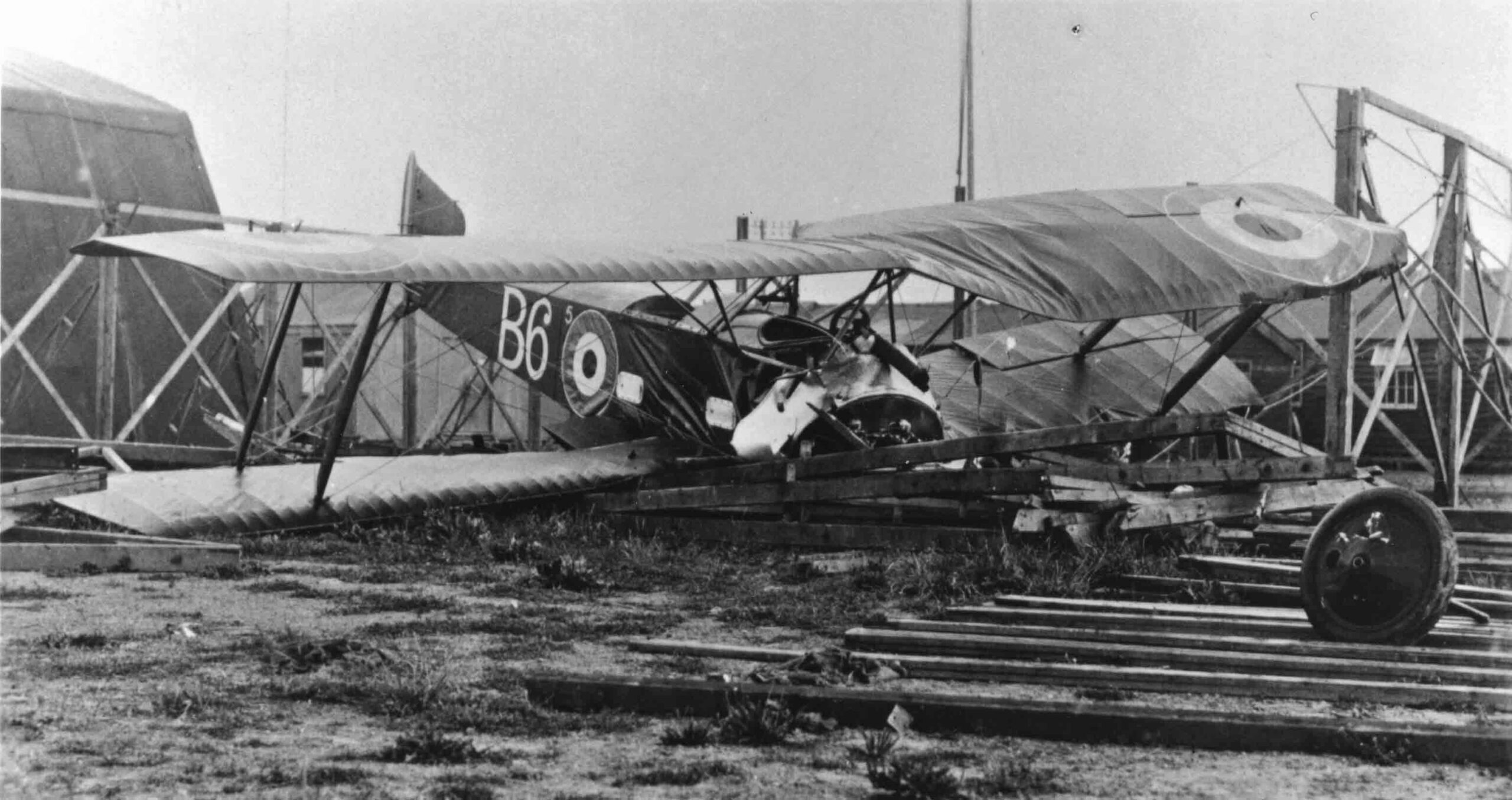
On 13th July ‘Strutter’ A8335 is sent down in flames killing the crew as was A8786 with the crew taken prisoner. A1028 crashes after combat and AA damage, A1038 is wrecked as is N5152 swinging badly on take-off and running full-bore into the frame of a Bessonneau hangar.(above) The pilot, not strapped in, is thrown out of the cockpit before the engine crushes it. ‘Pups’ A6203 & B1710 claim victories but the pilot of A6240 is downed and taken prisoner. N6475 breaks a wheel and noses over on landing. ‘Triplanes’ N5479, N6300 & N6308 share a victory. The pilot of N6305 is injured stalling after a take-off engine failure and the Deputy Escadrille Commander is killed in F12 when it crashes on take-off and catches fire. ‘Camel’ B3757 claims a victory and shares another with N6372, N6378 also claims one and shares one with N6376 whilst B3797is wrecked crashing on landing. ‘Baby’ 8123 forced lands off Whitstable and is towed to Westgate.
On 14th July ‘Strutter’ 7798 forced lands in trenches with a seized engine, A8314 is wrecked stalling on take-off. ‘Pup’ A6195 crashes and overturns, ‘Triplane’ N5492 is damaged by flak but ‘Camel’ N6370 claims a victory.
On 15th July ‘Strutter’ A1016 claims a victory but is then wrecked crashing with an engine failure. ‘Pup’ B1759 shares a victory with B1761 & B1704 which then crashes and overturns. ‘Camels’ N6343 & N6378 claim victories but the pilot of B3758 dies shot down in flames and N6374 is damaged overturning on landing.
In the Aegean seven re-engined F Sqdn ‘Strutters’ escorted by two ‘Pups’ attack an enemy camp near Sulva Salt Lake. Pups are starting to replace Baby floatplanes for escorting slower aircraft and the interception of attackers.
On 16th July the aileron controls of ‘Pup’ B1760 are shot away in combat, B1780 damaged by AA fire is forced to land whilst B1726 & B2155 & N6178 all crash on landing. ‘Triplanes’ N5429 & N5459 claim victories whilst N5454 & N5476 crash injuring the pilots, N5476 avoiding an aircraft landing cross wind. ‘Camel’ N6378 claims a victory.
On 17th July ‘Strutter’ A970 is wrecked in a forced landing, A1024 & A8303 also crash. ‘Pups’ 9899 & N6174 claim victories but B1713 is shot down, the wounded pilot taken prisoner. ‘Triplane’ N5373 shares a victory with seven others, N5377 shares one with four others, N5482 shares one with N6292 before overturning on landing, N5492 claims one, N5381 claims one before being wrecked in a forced landing as is French ‘Triplane’ SP13 after losing fuel pressure. (below) ‘Camel’ B3756 claims two victories, B3779 & N6332 are shot down one pilot dying of his wounds the other taken prisoner, B3822 is also lost and B3831 crashes on landing. The pilot of ‘Baby’ floatplane N1102 is killed when it crashes and sinks after a mid-air collision with a Curtis flying boat.
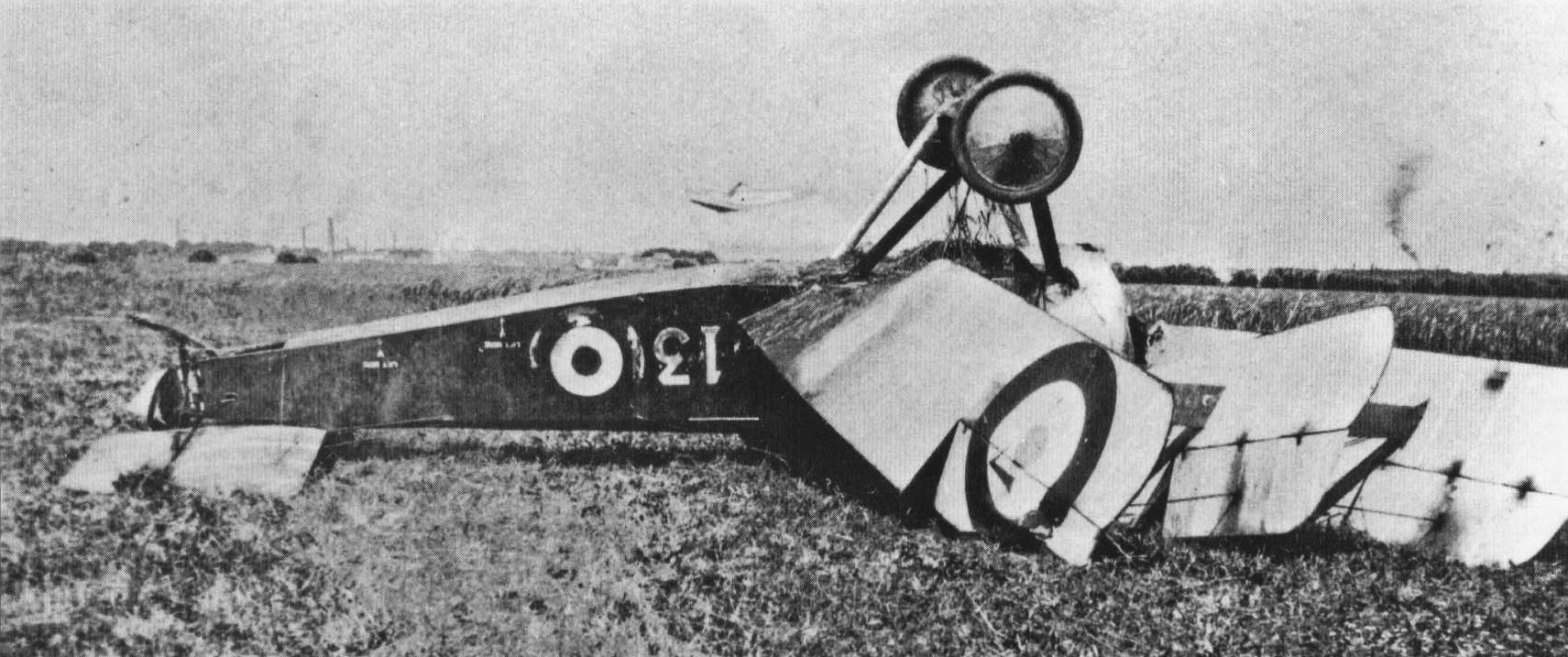
On 18th July ‘Pup’ N6187 claims a victory despite “impossible weather” and 9936 is wrecked at Cranwell.
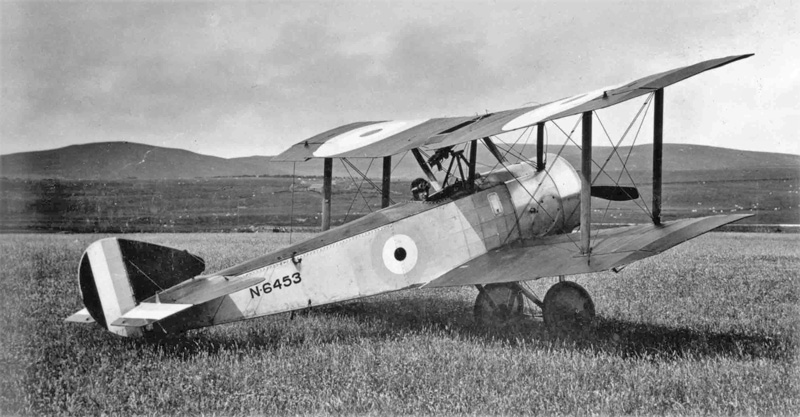
HMS Furious has now joined the fleet at Scapa Flow with her Beardmore-built Sopwith ‘Pups’. Having taken-off from her extended foredeck they are landing on the nearby thick grass of Smoogroo airfield.(above N6453 with a Lewis gun on an Admiralty tripod mounting) To return to Furious they are man-handled from a jetty of stones onto a raft of two large Wight seaplane floats and towed out.(below) Beardmore are now building an extra 24 sets of wings with the under-wing air bag attachments for retro-fitting to ‘Pups’ on ships and coastal stations.
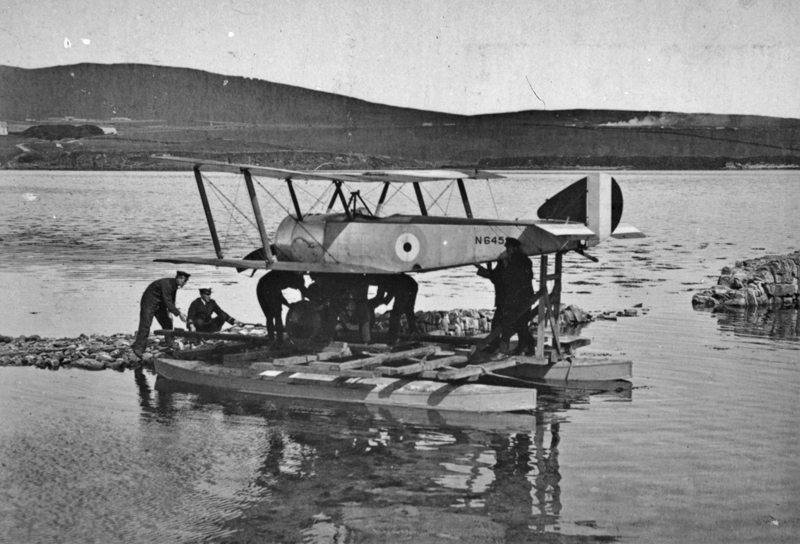
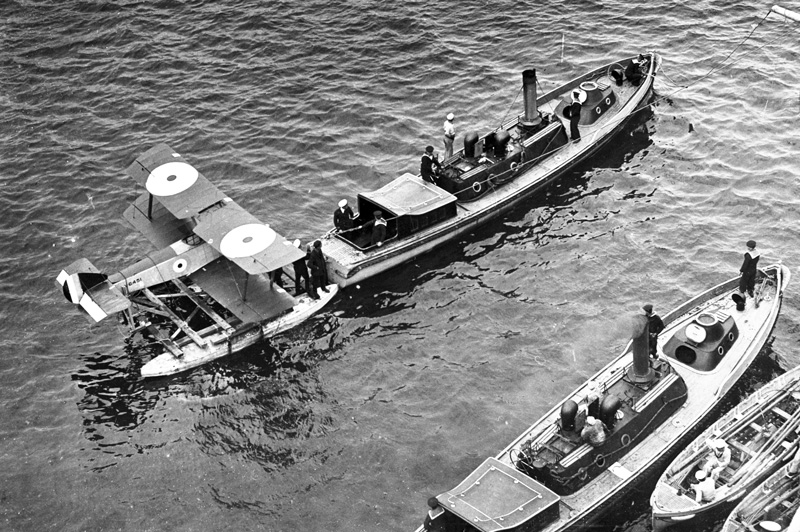
On 19th July there is bad weather and bad news for the RFC in France. Due to a lack of engines they will not even get ‘Strutters’ in lieu of the ‘Camels’ being held back for Home Defence and some of the ‘Camels’ they do receive may need borrowed engines from existing 130hp ‘Strutters’. They do now have the first two left-hand feed blocks for paired Vickers machine guns and are fitting one to a ‘Camel’ and one to the prototype Dolphin.
3(N)Sqdn is testing a nose and mouth mask attached by tube to an oxygen cylinder in Bentley BR1 engined ‘Camels’ B3807 & B3796. Staying at 22,000ft for fifty minutes pilots report no discomfort and one describes the effect of breathing the oxygen “comparable to an overcast sky changing to brilliant sunshine and I felt more alert” but it is too heavy and clumsy for small fighter aircraft. Meanwhile ‘Camel’ B3835 at Martlesham Heath now has a BR1 engine fitted with larger induction pipes for performance tests at various compression ratios.
In Kingston, Army and Senior Navy armament officers meet the Sopwith team around the almost complete third prototype Dolphin to consider a proposal for a joint Sopwith/Service venture to make it into a four-gun fighter.
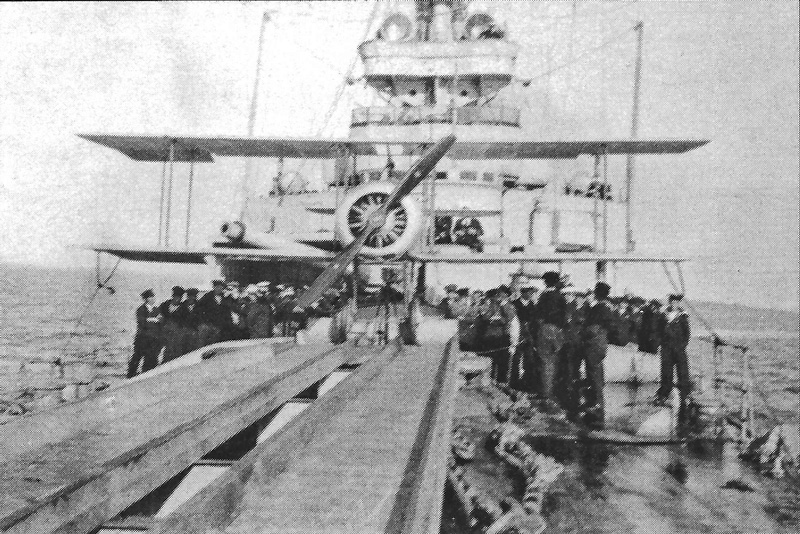
Photographs(above & below) show a Sopwith-Beardmore ‘SBIII Folding Pup’ with the very narrow fold-up-for-storage undercarriage attempting a take-off from the troughed ramp on the forecastle of HMS Cassandra on 19th July.
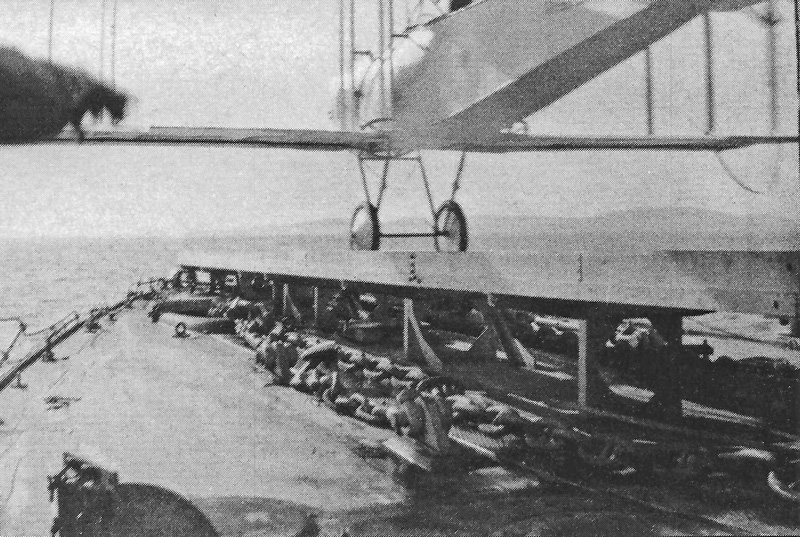
On 20th July the engine of ‘Pup’ B1742 is hit by AA fire and B1791 turns over in a cornfield after a misjudged landing. ‘Triplanes’ N5482, N5483, N5487 & N5492 each claim a victory as does N5429 when two enemy machines collide, N5475 overturns in a forced landing with flak damage to its propeller and N5366 also crashes on landing. ‘Camel’ B3760 shares a victory with N6375, N6376 & N6378 whilst B3806, N6360 & N6361 are shot down with the loss of three pilots and another dies at Upavon Central Flying School when B3799 stalls and spins in. ‘Baby’ N8142 is wrecked crash landing at Scarborough.
At Grain on 20th July the prototype Sopwith ‘T1’ torpedo bomber N74 arrives from Brooklands whilst ‘Pup’ 9922 makes an “entirely satisfactory” landing on the dummy wooden deck fitted with elaborate sprung wooden skids in place of wheels and a rather frail looking arrester hook. (Photos below believed to be 9922 with these skids)
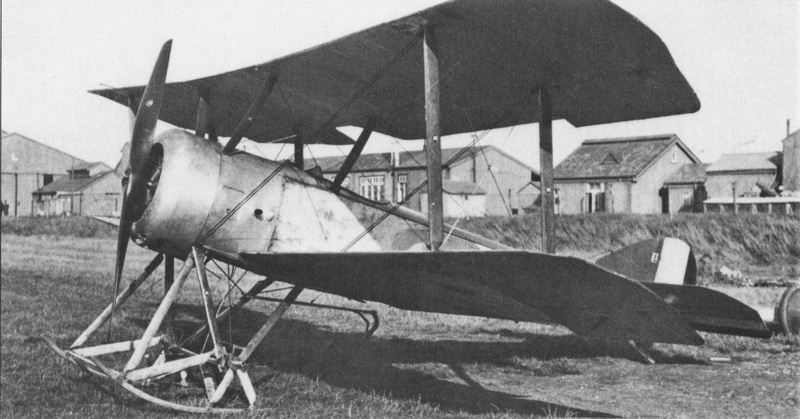
The skids are to provide more friction than wheels on landing. Also on skids, ‘Pup’ 9497 is involved today in “deck landing rail trials”, continuing to explore ideas for shipboard take-off and landings guided by rails or in troughs. Its skids have side horns intended to catch under fore and aft wires on decks to hold the machine down.
Ex-First Lord of the Admiralty the Right Honourable Winston Leonard Spencer Churchill, back from service with the army and an MP again, has been vociferous in Parliament on the failings of the Government to supply enough munitions, especially aircraft, to the armed forces. On 20th July he is sworn in as Minister for Munitions and a member of the War Cabinet. Flight journal is quick to congratulate the Prime Minister for his “courage to make what is certainly not an all-round popular appointment”. (See addendum below for full editorial comments)
On 21st July ‘Strutter’ N5208 is damaged at Dover, N5245 has been on air bag trial at Grain. ‘Pups’ A6217 & A7307 are wrecked on landing. ‘Triplanes’ N5483 & N5492 claim victories but N5425 is damaged forced landing after combat. ‘Camels’ N6355 & N6379 claim victories and N6378 shares one with three others. After a year in the Aegean ‘Schneider’ floatplane 3793 is now with HMS Peony at Port Iero.
By 21st July the last two of five ex-RNAS Sopwith ‘Triplanes’ N5387 & 8 are handed over to the French at Dunkirk as F14 & F15. F14 is the third to carry the SP12 aircraft number. F15 does not seem to have one.
At Stamford Bridge Athletic Grounds on Saturday 21st July the London District aircraft workers hold their Annual Sports Day in aid of the YMCA Fund for disabled soldiers’ and sailors’ hostels. Sopwith are well represented and the tug-of-war team beat Handley Page to win the Aircraft Manufacturing Company’s AIRCO Trophy and Medals.
On 22nd July ‘Strutter’ B2576 shoots an aircraft down in flames before being downed itself and the crew taken prisoner. On photo escort duties, A1036 claims a victory but is damaged in the combat as is A5245 whilst the crew of A1032 are killed. A8340 is wrecked after an engine failure. ‘Pup’ B1746 in combat with three Aviatiks sends one gliding eastward. The pilot of ‘Triplane’ N5478 is killed after shooting down an Albatros as are the pilots of N5361 and N6307, the latter breaking up hit by German AA fire. ‘Camels’ B3757, B3845 & N6378 of 8(N)Sqdn (below) and N6341, N6371 of 6(N)Sqdn each claim a victory whilst B3784 forced lands on a beach and N6376 crashes on take-off.
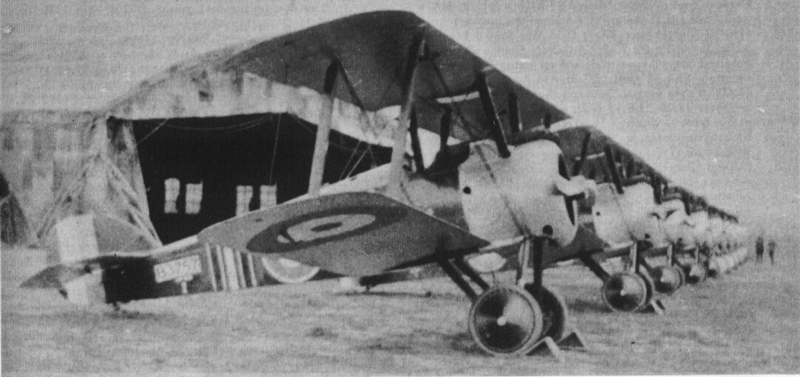
At home on 22nd July there is another hit and run attack on Harwich and Felixstowe by twenty-one Gotha bombers killing 13 people and injuring 26. There are 122 defence sorties involving every active Sopwith aircraft type but the Gothas are heading back across the North Sea within ten minutes and there are no interceptions. The Dunkirk ‘Camels’ also fail to catch them. ‘Pup’ B1723 has its cowling shot off by British AA fire over Shoeburyness. A6221 crashes caught by a gust at Joyce Green. ‘Triplane’ N5424 has (its own?) bullets hit its propeller at 18,000ft and forced lands at Chatham. One of six ‘Pups’ for the Belgian forces is photographed at Roulers (below) despite Sopwith still having had no firm contract for them.
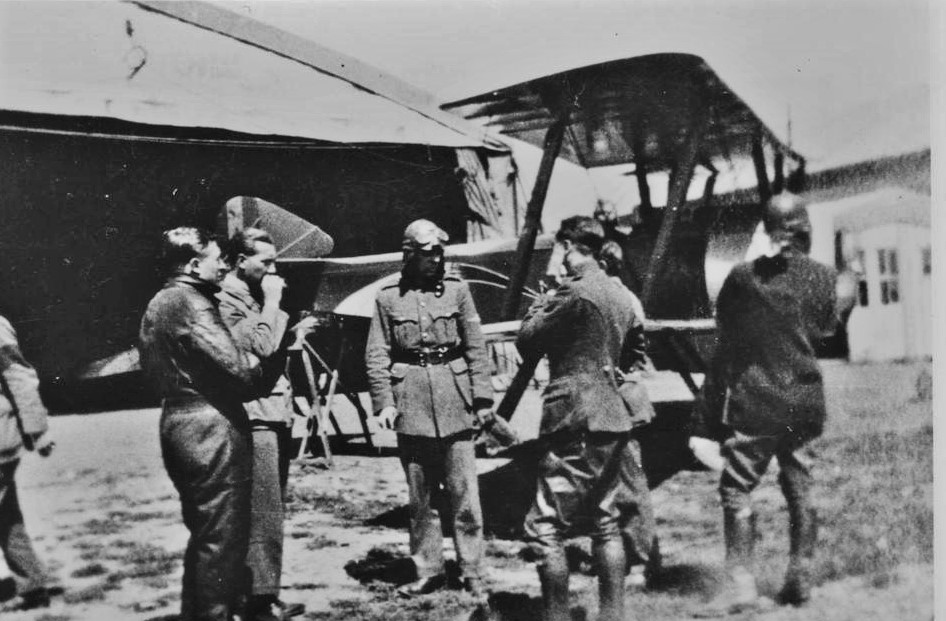
On 23rd July ‘Pup’ A637 is wrecked landing unable to see the ground in thick haze and N6168 is damaged in forced landing. ‘Triplane’ N5483 claims a victory as N5458 crashes near its aerodrome. ‘Camel’ N6334 claims a victory as does N6375 but is badly shot up doing so. At Turnhouse the pilot of B1785 is injured spinning in on landing.
On 24th July the weather is again very bad. ‘Strutter’ A8315 is wrecked landing as is A8326 swinging on take-off to avoid a possible collision. 66Sqdn ‘Pups’ B1731 & B1781 are wrecked landing in a cross-wind from test flights. ‘Triplane’ N5462 claims a victory but the pilot of N5364 is killed when his wings fold in a dive after being shot down. ‘Camel’ B3756 claims two victories as does B3813 with two more damaged, B3814 claims one and B3838 drives one down. The pilot of B3825 is killed in combat, N6368 gets lost in the mist and forced lands in the sea whilst B3809 crashes forced landing on a beach. RFC 45Sqdn start to replace their ‘Strutters’ with ‘Camels’. At home Whitehead Aircraft in Richmond get yet another order for 100 80hp “Pups” to bring their total to 450 as ‘Pup’ 9902 is wrecked on a training flight from RNAS Cranwell.
On 25th July in poor weather the crew of ‘Strutter’ A1020 are killed in combat whilst A8339 is wrecked on take-off after loss of fuel pressure. ‘Pups’ A6202, B1770, N5197 & N6180 all crash on landing two written-off and two pilots injured. ‘Camel’ B3818 shares a victory with B3820, B3841 shares a seaplane down with N6369 & N6370. The first of ten “Strutters’ going to Romania A8194 arrives at Martlesham Heath with a 110hp Le Rhône engine.
On 26th July there is an enormous and lengthy dogfight near Polygon Wood involving almost 100 aircraft at four levels from 5,000 to 17,000 feet. ‘Pup’ A6190 drives an aircraft down and ‘Camel’ N6358 claims a victory as do B3756 & B3814 but both are damaged in combat. Further north B3805 has its engine hit and forced lands on a beach whilst B3831 forced lands with an engine failure. At home ‘Pup’ N6442 taxies into a BE2 at Walmer whilst the pilot of new Home Defence ‘Pup’ A6244 is seriously injured crashing after an engine failure at Stowe Maries. This is significant because with the shortage of Clerget engines it is one of the first ‘Pups’ delivered into service with a 100hp Gnome Monosoupape engine like that first used by Sopwith in the ‘Tabloid’ floatplane to win the Schneider Trophy race in Monaco in April 1914. By co-incidence this same day ‘Camel’ B3811 arrives at Martlesham Heath for performance testing with a 100hp Gnome Monosoupape fitted by Sopwith Aviation.
On 27th July ‘Strutters’ A8295 & B2581 are wrecked landing with engine problems, N5153 is also badly damaged. ‘Pup’ B1760 claims a victory, B1703 is badly shot up, N6174 is recovered by a torpedo boat after a forced landing in the sea off Ostend with a cut engine, B1790 is wrecked after a propeller ground strike on take-off as is B1814 which runs into a ditch. 9946 crashes at Cranwell. In a pre-arranged trap 59 RFC and RNAS aircraft ensnare a large group of enemy fighters into another hour-long dogfight. Fl Sub Lt Reid in ‘Triplane’ N5483 “Black Roger” claims three victories whilst Fl Lt Collishaw scores his 33rd and 34th Triplane victories in his latest “Black Maria” the brand new two-gun N533(below). N5492 is shot down and the pilot killed whilst N5466 overturns landing in long grass. ‘Camels’ B3768 & N6358 claim victories, N6375 shares a victory with B3877, B3864 is damaged in combat whilst B3755 crashes after an engine failure. For three days there have been continuous patrols of groups of RNAS ‘Pups’ or ‘Camels’ protecting Royal Navy ships laying a 23 mile line of net mines and deep mines parallel with the Belgian coast between Zeebrugge and Ostend to restrict U-boat activity. On 27th July five German torpedo carrying seaplanes are spotted by five 3(N)Sqn ‘Camels’ (B3781, 82, B3805, N6364 & 77) who bring one down and drive the others back to Ostend.
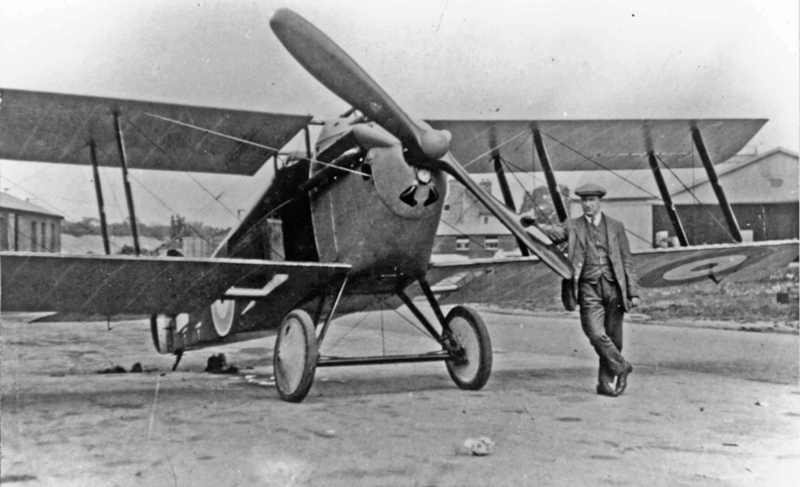
The second prototype Sopwith ‘Dolphin’ has re-appeared at Brooklands (above) with tall rectangular five-inch-wide radiators on either side of the cockpit in place of the inadequate wing root radiators. It also has two small cut-outs in the nose above the contoured oil tank and below the gun timing gear which is the latest Constantinescu hydraulic type. When it is delivered to Martlesham Heath for flight testing and performance measurement on 27th July the flank radiators have retractable metal shutters to give more control over the engine temperature (below) and the exhaust pipes have been replaced with individual exhaust stubs.
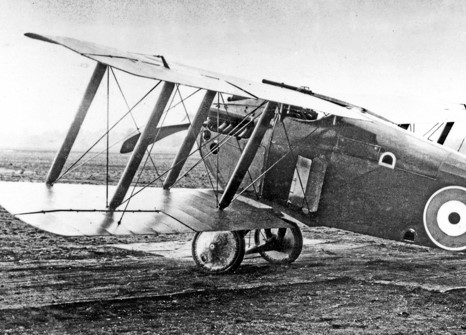
Meanwhile on 27th July Sopwith receive an order for 70 ‘Pups’ given serial numbers C3707 to 76 but to be delivered as spares. This is possibly an administrative formality to allow the delivery and payment for airframes and parts built for the 50 ‘Pups’ cancelled at short notice to make way for urgent Camel production.
On 28th July both crew of ‘Strutters’ A1031 & A8787 are killed, the first two in combat the others hit by ground fire. A8228 is wrecked landing with a damaged undercarriage and A8304 is wrecked colliding with ‘Camel’ B3871 on landing. ‘Pups’ B1724, B1757, B1760, B1767 & B1797 each claim victories, B1762 shares one with B2162 whilst the pilot of A6216 is shot down and taken prisoner. ‘Triplane’ N5487 claims a victory, N5377 shares one with N5462. Having claimed three yesterday, Fl Sub Lt E V Reid takes his 19th ‘Triplane’ victory in N5483 before he is shot down and killed. N5493 is “badly shot about”. ‘Camels’ B3838, B3845 & N6372 each claim victories as do B3756 & B3793 but are damaged in combat and B3821 shares a victory with B3833. N6358 claims a victory but is wrecked overturning in a forced landing with a wounded pilot, B3874 is shot down in flames and the pilot killed, B3823 is shot down and the pilot taken prisoner whilst the pilot of N6369 is killed crashing into the sea.
On 29th July ‘Triplane’ N5490 claims two victories, N5484 another whilst N5452 is shot down in flames by German flak from 4,000ft with the burned and concussed 18-year-old RNAS pilot taken prisoner. 130hp Blackburn-built ‘Baby’ floatplane N1421 is totally wrecked outside South Shields harbour on its delivery flight from Brough whilst the prototype 130hp Blackburn-built ‘Baby’ N1123 finally arrives at RNAS Grain on 28th July. It is the subject of many photographs including a rare flying image.(below) Sopwith-built ‘Baby’ floatplanes 8216 & 7 are to be reduced to spares after storage without engines at White City for over a year.
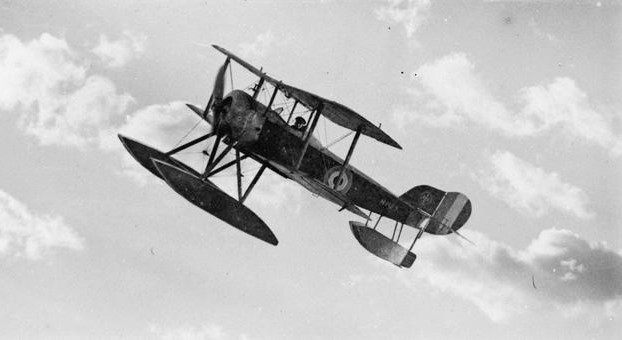
On 30th July there is a new experience for Sqdn Cdr Busteed when he makes an emergency landing at sea in ‘Pup’ 9922 with its sprung skids in place of wheels, it will soon be flying again. The weather in France is poor.
In France the intensive aerial activity over the last week has been in preparation for the third battle of Ypres which goes ahead on 31st July despite continuing poor weather. The British Second and Fifth Armies open with a determined attack soon capturing the first two German trench lines before stiffer resistance and counter-attacks. The plans for extensive air support are seriously reduced by very low cloud which turns to rain but 1(N)Sqdn are amongst those who risk ground fire to attack enemy troops, gun pits and airfields from 400ft or lower. ‘Strutter’ A8302 crashes taking-off and A8366 is wrecked after an engine failure.
With its enhanced facilities and only one type in production, Sopwith’s output in July is up a further 22% to pass 100 machines in a month for the first time with 104 ‘F1 Camels’. The total of new Sopwith designed aircraft from all suppliers in June is 276. The 172 machines from other manufacturers are 61 ‘Strutters’ from Hooper (17), Morgan (18) and Ruston Proctor (26); 65 ‘Pups’ from Standard Motors (40) and Whitehead (25) plus 4 ‘SB.III folding Pups’ from Beardmore; 7 ‘Triplanes’ from Clayton & Shuttleworth, the first ‘Camel’ from Clayton and Shuttleworth plus 15 from Ruston Proctor with 13 ‘Baby’ floatplanes from Blackburn and 10 ‘Fairey Hamble Baby’ floatplanes from Parnall (9) and Fairey (1). Wells Aviation in receivership have seven more ‘Strutters’ accredited to them but with no known delivery dates they have not been included. The monthly figures also exclude overseas manufacture of Sopwith designs.
Alongside the supply of scores of British-built ‘Strutters’ to Russia and a French squadron assigned to the Russian Army in Galicia, two-seat ‘Strutters’ are being built by the Dux company of Moscow and by V A Lebedev of St. Petersburg who now have an order for 50 with 140 more to follow. Russian-built ‘Strutters’ apparently have modified undercarriages of Russian design but owing to a chronic lack of engines, few are entering service. The most significant overseas manufacturers of Sopwith ‘Strutters’ are the French with orders of over 4,000 on nine manufacturers with 135 or 145hp Clerget or 135hp Le Rhône engines. By the end of July there are 385 French built ‘Strutters’ in service of which 243 ‘Sop 1A2’ two-seaters are workhorses for the French Army operating in six reconnaissance escadrilles and three or more artillery co-operation escadrilles. The 142 ‘Sop 1B1’ single-seat and ‘Sop 1B2’ two-seat bombers are in use with eleven bomber escadrilles (SOP 29, 66, 107, 108, 111, 123, 128, 129, 131, 132 & 134). Flying in mixed formations, the two-seat bombers navigate and provide some defensive cover. The internal bomb-racks in the French single-seaters carry four large bombs weighing a total of 330lbs rather than the 260lbs load in the smaller racks of British-built ‘Strutter Bombers’.
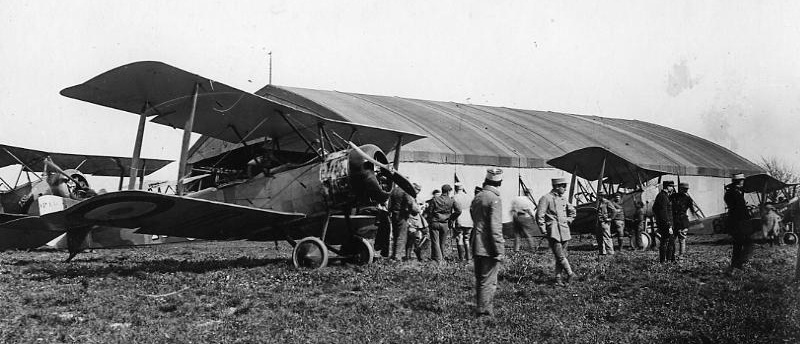
Above: ‘Sop 1A2’ French-built ‘Srtutter’ fighters
Below: Captured ‘Sop 1B1’ French-built single seat ‘Strutter Bomber’, note three bomb bay access doors
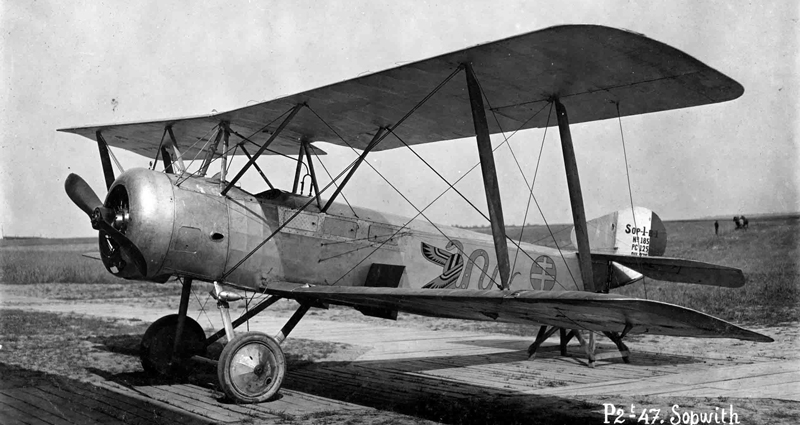
On 1st August a Sopwith Board Meeting formally seals even more applications for patent rights around the world for their key design features. The list of patent applications in the joint names of the Company and the inventor clearly illustrates the collaborative nature of Sopwith aircraft design. Thomas Sopwith himself is credited with the devising their split axle undercarriage, the Stutter’s air brake and swivelling gunner’s seat, the variable incidence tailplane mechanism, padded windscreen and a swivelling cable attachment bracket incorporating a tensioner. Fred Sigrist has devised the detachable fuselage joint arrangements secured by turnbuckles, a wing folding mechanism and simply constructed two-piece wooden struts and spars. Harry Hawker is credited with the wire-clamp-in-a-groove engine cowl attachment system and the simple method of attaching aircraft wings by inserting a steel rod from the front of the wing through interlocking extensions of the wing spars and the wing centre section spars or fuselage cross spars. Harry Kauper is recognised for his gun synchronisation mechanism.
On 1st and 2nd August there is no flying in France due to unfavourable weather. In Britain over the past few days two new Home Defence Squadrons have been formed with Sopwith ‘Pups’: 61 Squadron at Rochford and 112 Squadron at Detling.
At Scapa Flow, Sqdn Cdr E H Dunning continues to explore the practical use of his five Beardmore-built ‘Pups’ on HMS Furious. Having practised foredeck take-offs landing at Smoogroo airfield, the next step is to attempt to land back on the ship. On 2nd August with the ship making 26 knots into a 21-knot wind he flies ‘Pup’ N6452 along the port side of the ship’s superstructure, crabs to starboard until he is over the centre of the flying-off foredeck and cuts his engine. The deck party of other pilots race forward to manually sieze it and “with some difficulty” pull it down onto the deck. They hold it squarely into the wind whilst it is tied down.
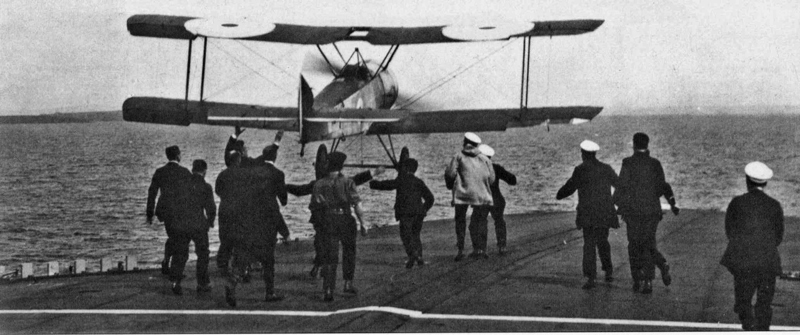
Dunning has become the first man to land an aircraft on a moving ship, his skill aided by the exceptional controllability and responsiveness of the ‘Pup’. He climbs out surrounded by those who have witnessed history being made. (below)
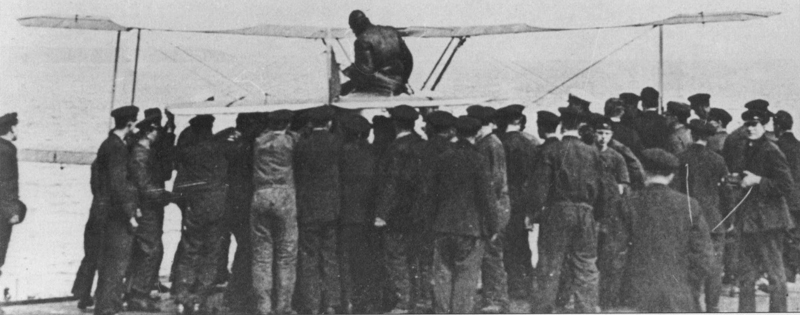
On 3rd August there is no service flying in France due to unfavourable weather. At Castle Bromwich ‘Strutter’ A8257 recovering from a spin is wrecked in a tree injuring the pilot. There are at most six ‘Pups’ in the Aegean and Greek Naval Captain Aristides Moraitinis in one of them downs a German seaplane on 3rd August. He was taught to fly in 1914 by the British team which went out to Greece with a Sopwith ‘Pusher’ floatplane to train Greek Navy pilots.
On 4th August flying is again restricted by low cloud and rain. ‘Strutter’ A8292 is wrecked in a forced landing in a storm. ‘Pup’ B2162 (below with extra top wing Lewis gun alongside a back-staggered DH5) claims a victory whilst B7197 is shot down and the pilot injured. ‘Triplane’ N6290 is damaged in a forced landing. ‘Camel’ B2304 is shot down the injured pilot being taken prisoner and B3831 is wrecked crashing with an engine failure soon after take-off. Clayton and Shuttleworth receive an order for a further 200 ‘Camels’ making 300 in total.
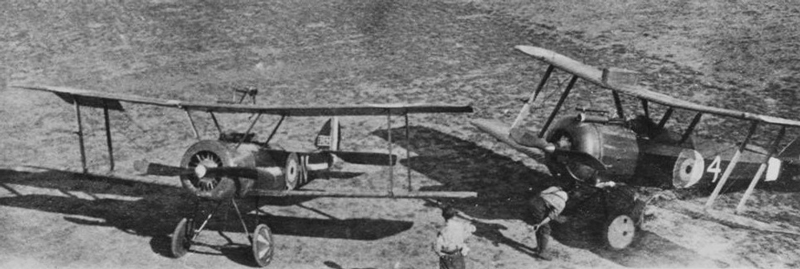
On 5th August ‘Strutter’ A957 is beyond repair after being hit by AA fire and A8792 is wrecked in a forced landing with engine trouble. The pilot of ‘Camel’ B3768 claims a victory, the pilot of B2304 is wounded and taken prisoner after it is hit in the fuel tank. The wounded pilot of shot-up B3792 manages a forced landing. Manston’s latest two-gun Triplane’ N535 with gun timing issues puts bullet holes in its own propeller.
On 6th August ‘Strutters’ 9414 & N5643 are badly damaged. ‘Camel’ B3838 crashes landing in the dark. At RNAS Grain the formal ‘Type Testing’ of the ‘SBIII Folding Pup’ get underway with Beardmore’s third machine N6102.
On 7th August ‘Strutters’ A1030 & A8261 are wrecked on practice flights crashing respectively on landing and taking-off. ‘Pup’ B1746 is wrecked when the engine cuts out on take-off and B2169 is wrecked overturning landing in a cornfield. ‘Triplane’ N6304 forced lands with an engine failure.
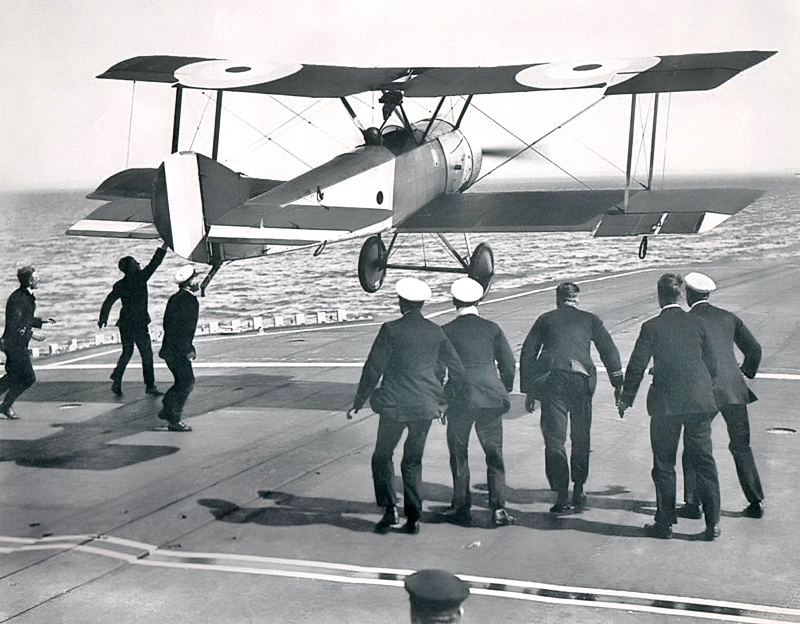
At Scapa Flow HMS Furious is underway again as Sqdn Cdr Dunning and his team continue test flights with the ‘Pups’. Again flying N6453, now with a Lewis gun on the tripod and rope grab loops under the wings and fuselage for the deck party, Dunning makes the world’s second landing on a moving ship at 2pm.(above) He is not happy when it rolls backwards into the deck hatch combing damaging the elevators. He orders the pilot out of N6452 which is ready to take-off and goes up for another run. This time he arrives over the foredeck slightly too high and touches down too far forward. Although the deck party rush to hold him back (below) he waives them away intending to go around again.
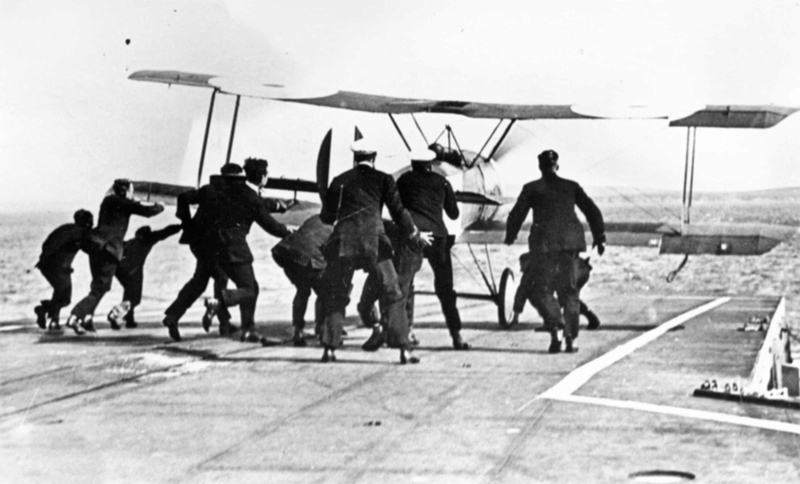
Opening up the engine it chokes, the aircraft stalls and falls over the starboard side of the ship.(below) Dunning is stunned and drowns before the ship can heave to and get a boat to him.
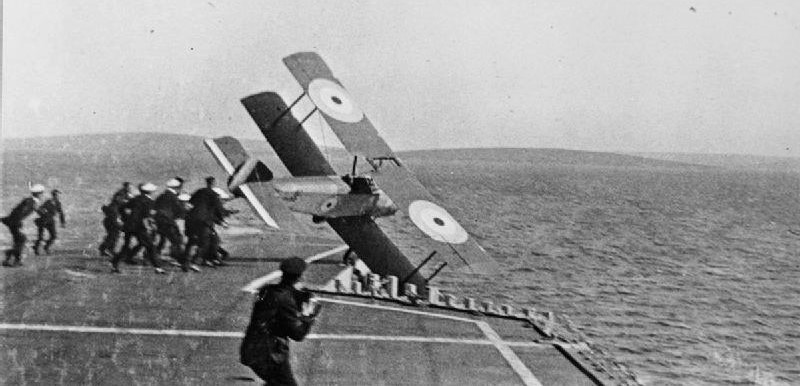
The stopped propeller is hardly damaged but the near vertical impact with the water has squeezed the cowling around the engine like a piece of foil. (below)
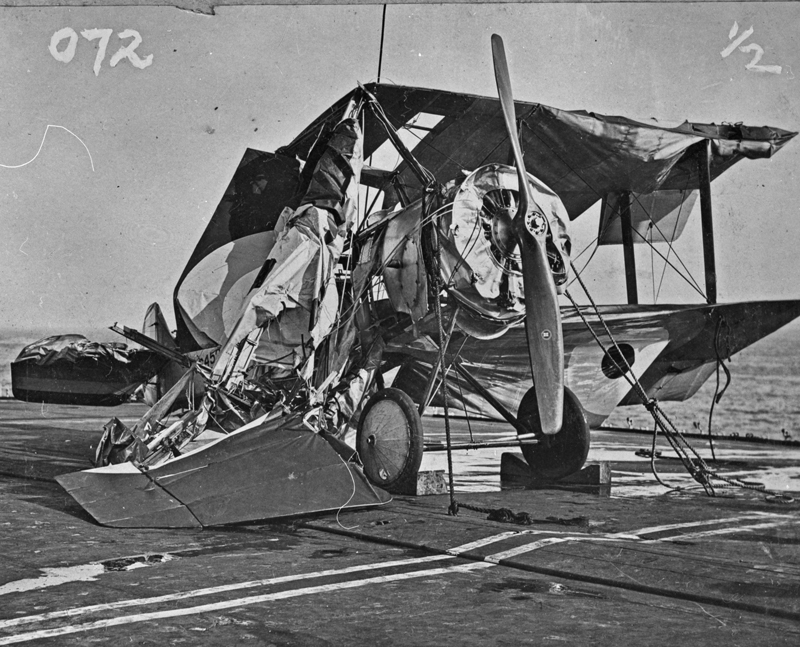
On 8th August ‘Strutter’ A996 is wrecked in a forced landing by a lost pilot. ‘Pups’ N6201 is badly damaged as is N6206 on landing. ‘Triplanes’ N5373 & N6303 claim victories but N5351 crashes. ‘Camel’ B3870 is shot down in flames killing the pilot, B3897 is shot up and forced lands, the propeller of B3849 hits the ground on take-off and it stalls from 30ft injuring the pilot, B3854 is also wrecked injuring the pilot.
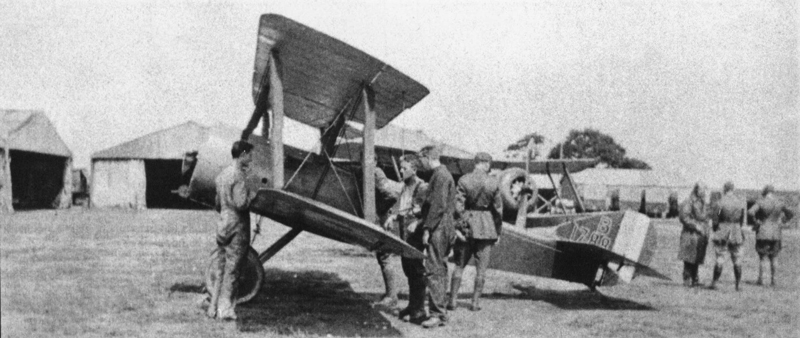
At home, unarmed ‘Pup’ B1788 with 64 Sqdn at Sedgeford (above with the distinctive cylindrical engine cowl of a Standard Motors built ‘Pup’) is typical of those now being used to help squadrons work up to operational effectiveness but today its pilot gets giddy in a spin, crashing and dying of his injuries. Killingholme ‘Baby’ 8148 is damaged beyond repair.
The RNAS continue to support the British Army on the Western Front and increasingly now with BR1 engined ‘Camels’. In the poor weather 3(N)Sqdn ‘Camels’ are becoming engaged in dangerous low bombing and strafing duties whilst 4(N)Sqdn are being sent off to attack specific enemy artillery spotting aircraft located by new technology which pinpoints the source of their air-to-ground wireless signals.
Following the decision to expand the RFC from 108 to 200 Squadrons through 1918 one of Winston Churchill’s first acts as Minister of Munitions is to approve the building of three large National Aircraft Factories recognising that this is too great a growth in demand to be met by their existing major aircraft suppliers and they already have more smaller suppliers than they can properly support. The first two NAFs are to be sited at Waddon beside Croydon airfield and on Ham Lands beside the Thames just a mile north of Sopwith’s factory in Kingston.
‘Camel’ B3835 at Martlesham fitted with the high-compression Bentley BR1 engine with larger induction pipes records 121mph at 10,000ft and 114.5mph at 15,000ft, some 10mph faster than the standard BR1 and climbs significantly faster reaching those altitudes in 8mins 22secs and 15mins 55secs. Meanwhile ‘Camel’ B3811 with a 100hp Gnome Monosoupape surprisingly reaches 110.5mph and 102.5 mph at those heights but with a slower climb rate and lower ceiling than the Clerget or Bentley engines is considered unsuitable for front line duties.
On 9th August ‘Strutters’ A8290 & A8338 are wrecked. ‘Triplanes’ N5373, N5380, N6300 & N6301 each claim a victory but the pilot of N6290 dies shot down in flames from 11,000ft and N5367 forced lands in water. The pilot of ‘Camel’ B3870 is also killed shot down in flames, B3808 crashes with an engine failure and B3839 crashes landing in high winds. ‘Strutter’ A8194, unusually with a 110hp Le Rhône engine, is the first of ten to go to Kingsbury to be packed and sent to the Romanian government.
On 10th August the observers in ‘Strutters’ A1004 & A1056 are wounded by gunfire, B2579 is wrecked after being hit by AA fire whilst the crew of A2419 are killed in a mid-air collision during gun practice. The pilot of ‘Pup’ A6201 is killed in combat, B1761 is hit in the fuel tank and N6178 crashes. ‘Triplane’ N534 claims a victory, N5449 is hit by ground fire and shelled for 8 hours after forced landing whilst N5372 crashes landing downwind. Lt Gribben in ‘Camel’ B3840 (below) claims two victories, B3768 claims one, B3805 is crashed on a test flight. B3807 & B3824 suffer engine failures.
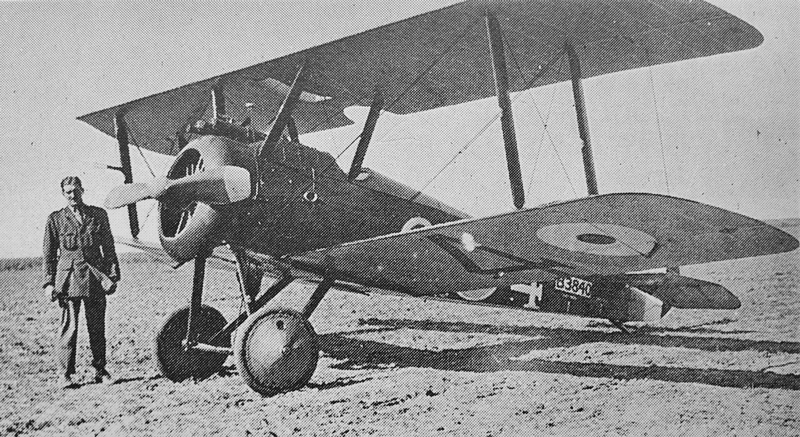
On 10th August after a gap of a whole month the fifth production Beardmore ‘SBIII Folding Pup’ N6104 is flight tested at Dalmuir. It is reported that the delay is due to engines being lost in a ship that was sunk crossing the Channel although Beardmore are also under Admiralty instructions to give greatest priority to building airships. At Grain the undercarriages of ‘SBIIIs’ N6102 & 3 have been fitted with hydrovanes ready for water landing trials.
On 10th & 11th August the previously cancelled Richmond Royal Horse Show is held at Hanworth Park “due to the generosity of Mr. Whitehead aircraft constructor of Richmond” the receipts going to help British War Horses. On 11th August a regatta is held on the Thames at Kingston to raise some £200 for the East Surrey Regiment Comforts’ Fund. “In the open fours the Sopwith Boat Club proved too good for the Erignes Rowing Club.”
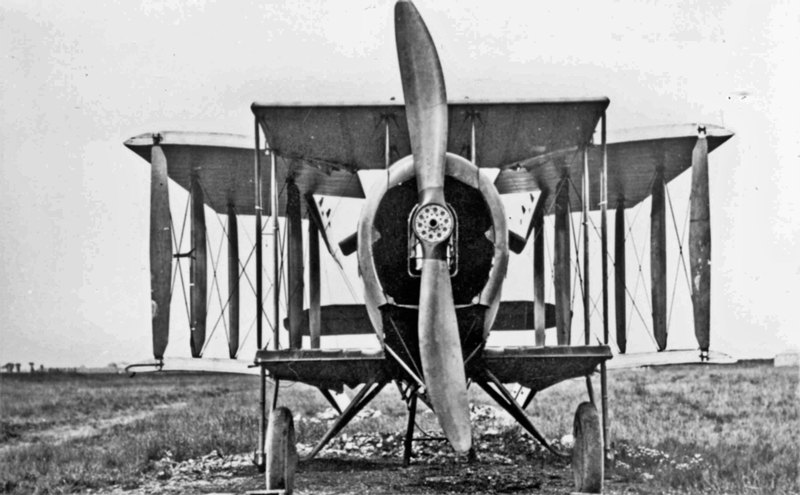
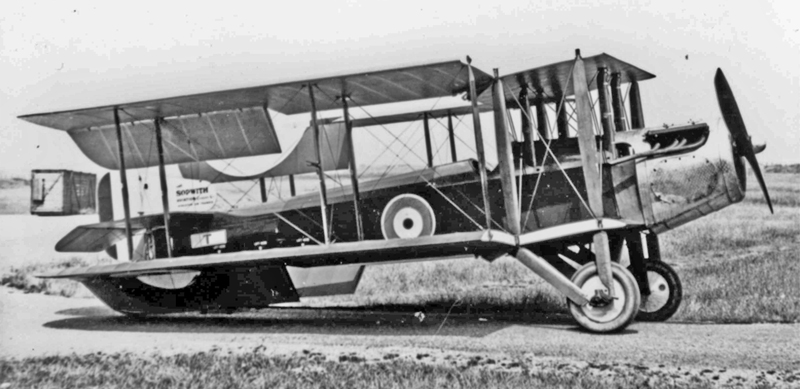
Since it was test flown at Brooklands in June the undercarriage on Sopwith’s prototype ‘T1’ torpedo bomber N74 has been modified to incorporate bungee cord springing on the stub axles. The latest photographs (above) show this, the large three-bay folding wings and the round radiator on its 200hp v8 Hispano Suiza engine. By 11th August the official trials at RNAS Grain since 20th July have proceeded through performance and air-bag tests to a dummy torpedo drop from 5 or 6 feet above the water at 60knots. Observers from the shore notice that the torpedo when released does not continue to fall in a horizontal position, on striking the water it makes a big splash, part of which, higher than the rest, appears to strike the underside of the tail, it bounces into the air but does not strike any part of the machine. The official report states “The dummy torpedo used on trials weighed 1004 lbs and was fairly close to the Mark IX torpedo in respect of weight and C.G. but the results obtained are of course not as satisfactory as with an actual torpedo. The torpedo was fastened with a single band 1” forward of the C.G. A shock was felt under the tail and spray came in over the cockpit. The tail was thrown up momentarily but the machine recovered its equilibrium almost at once. The release lever is very inconveniently placed and requires alteration. On landing the machine was found to be entirely in order.” These trials are successful enough for orders to be placed with the Fairfield Shipbuilding Co Ltd of Glasgow for 100 machines. They have never built any aircraft unlike Beardmore and other Glasgow engineering companies.
On 11th August ‘Strutter’ A5244 is wrecked forced landing after combat. ‘Pups’ N5182, N6438 & N6466 are badly damaged in accidents. ‘Triplane’ N5482 claims a victory before being hit and, after a forced landing, is destroyed by artillery. The pilot of ‘Camel’ B3932 is killed in combat whilst B2306 crashes from an engine failure. At Thasos in the Aegean, ‘Baby’ N1117 side slips and is wrecked in a nose dive.
On 12th August ‘Strutter’ 9724 is badly damaged. ’Pup’ A649 & N6478 share two victories with other ‘Pups’, N6200 after spinning crashes on landing. ‘Triplanes’ N5437, N5354 & N6308 each claim a victory. ‘Camels’ B3753 & B3789 crash on landing. ‘Baby’ N1328 is wrecked just a day after arriving at South Shields.
At 4.30pm on 12th August eleven Gotha bombers are spotted over the North Sea by ‘Camels’ on a routine patrol from Furnes who are unable to make an effective attack being short of fuel. Aiming for Chatham dockyard on the Thames estuary the Gothas are blown north to Clacton and make slow progress back into the wind. One with an engine damaged by the Camels breaks off to bomb Margate. Spotting numerous defence fighters they abandon Chatham and attack Southend. Many bombs land in the sea and some on Rochford aerodrome but 33 people are killed and 46 injured. Unladen and climbing to 14 or 15,000ft the bombers head back. The new home defence system is fully mobilised involving 121 aircraft including 51 ’Pups’, 29 ‘Camels’, 3 ‘Triplanes’ and a ‘Strutter’. Many patrol to protect the capital but almost all the aircraft who get near enough to fire at the Gothas suffer gun stoppages or run out of ammunition with little apparent damage. One Gotha has 1,100 rounds fired at it but struggles back to a crash landing in Belgium. ‘Pup’ N6440 climbs above the bombers and makes a diving frontal attack on the lowest one which flies straight down into the sea and turns over. Circling the wreck, the ‘Pup’ pilot throws his lifebelt to a man clinging on to the tail. Three further Gothas crash on landing in Belgium.
On 13th August ‘Strutter’ A1044 is hit by ground fire and the observer wounded whilst A8237, A8276, N5503 & N5637 are all wrecked on landing. ‘Pup’ B1797 crashes injuring the pilot. ‘Triplanes’ N5373 & N6303 suffer forced landings after engine failure. ‘Camel’ N3840 & B3889 each claim a victory, B3756 shares a victory with B3873, B3890 damages an enemy aircraft whilst N6356 overturns in a forced landing. At home ‘Camel’ B2308 crashes and B3842 is wrecked after an engine failure. ‘Pup’ B805, rebuilt at Farnborough with a 100hp Gnome Monosoupape, stalls from a climbing turn at the Gosport School of Special Flying, the pilot badly injuring his legs.

On 14th August Herbert Smith signs-off general arrangement drawing E.151 (extract above) for a Sopwith two-gun fighter combining features of the ‘Camel’ with the deep fuselage and high-set pilot of the ‘Dolphin’. “It will take 150hp AR, BR or Gnome, 130hp Clerget or 110hp Le Rhone engines”. He may not yet be aware of the 200hp Bentley and ABC engines secretly under development which could be the answer to meeting the very demanding Air Board Specification A.1(a) for a new high-performance rotary-engined fighter.
On 14th August ‘Pups’ 9899, A6210 & N5183 are badly damaged in crashes whilst N6183 makes a forced landing at sea. ‘Triplanes’ N5436, N5380 & N6299 each claim a victory, N5485 a possible one, the pilot of N536 is killed shot down by AA fire whilst N535 is damaged getting it out of a shed. The pilot of ‘Camel’ B3820 is killed in action whilst B3883 is crashed. With all six two-gun ‘Triplanes‘ now completed by Clayton and Shuttleworth, Sopwith-built N5445 arrives at Grain also with two-guns but under a humped cowl, with a deeper fuselage decking and a larger rudder but further development is unlikely with ‘Triplane’ production stopped in favour of ‘Camels’.
On 15th August all four crew of ‘Strutters’ A1079 & A8294 are killed in combat. Another 43Sqdn airman is killed and two wounded by ground fire as they attack artillery positions and strafe counter-attacking troops. There is another injury when A1022 & A1064 are wrecked as are A8231 & A8247 colliding on the ground taxiing in from landing. ‘Pup’ A6211 shares a victory with two others whilst the pilot of A6212 is wounded and N6192 overturns on a beach. ‘Triplane’ N5454 ‘Hilda’ claims a victory whilst N5485 & N5370 are wrecked after engine failure and N5381 wrecked on landing. ‘Camels’ B3845, B3882 & N6359 each claim a victory whilst B3925 puts a bullet through its propeller.
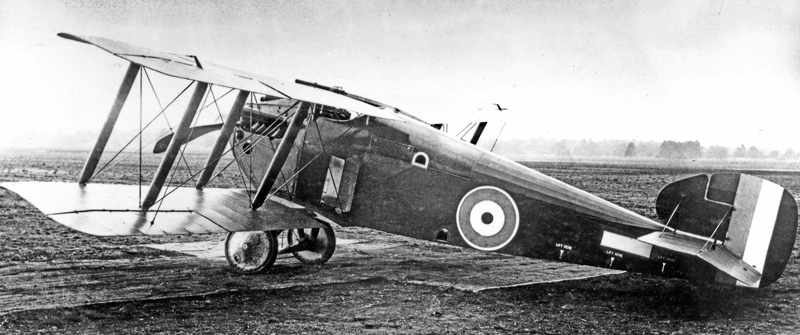
The test results are promising for the second Sopwith Dolphin prototype with its side radiators which has been at Martlesham Heath since late July. With its geared 200hp Hispano-Suiza engine it unsticks in 60 yards and pulls up on landing with engine stopped in 90 yards. It takes 8mins15secs to reach 10,000ft achieving 128.5mph there and 124mph at 15,000ft. It takes 18mins20secs to reach 17,000ft and is considered to have a service ceiling of about 25,000ft. “Controllability is good, the controls are light and it has neutral stability in all axes”, some of which may be due to its latest tail design with a larger fixed fin area.(above) The report recommends cutting away part of the top cowling to improve forward view and installing a cock to bypass one or other of the radiators if they get damaged.
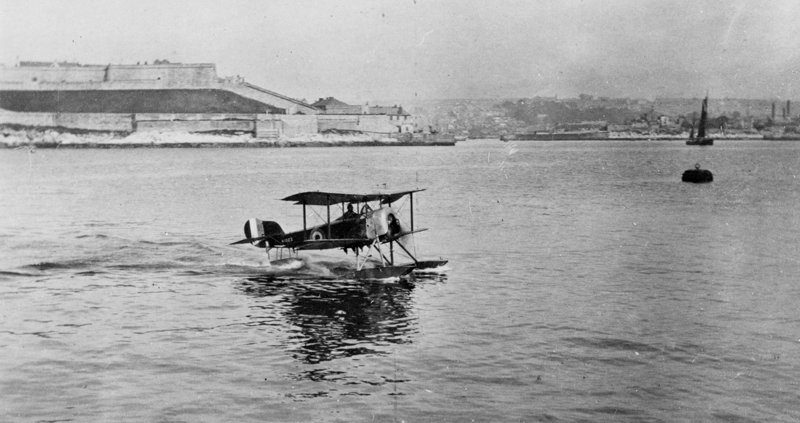
On 16th August ‘Baby’ floatplane N1023 based at Plymouth, Cattewater (above) drops a 65lb bomb on an enemy U-Boat 10 miles south of Lands End. In France the observer in ‘Strutter’ B2560 is wounded by ground fire and it crashes. After strafing Marcke airfield the pilot of ‘Pup’ B1732 claims to have shot down two Albatros taking off to intercept him. A6190 is wrecked in a forced landing after an engine fire. Sqdn Cdr Dallas claims his 16th ‘Triplane’ victory now in two-gun ‘Triplane’ N534 (below), N5437 & N6299 also each claim one whilst the pilot of N6304 is killed in combat. The pilot of ‘Camel’ B3756 is also killed in combat, the pilot of B3873 taken prisoner whilst B3890 is damaged by machine gun fire.
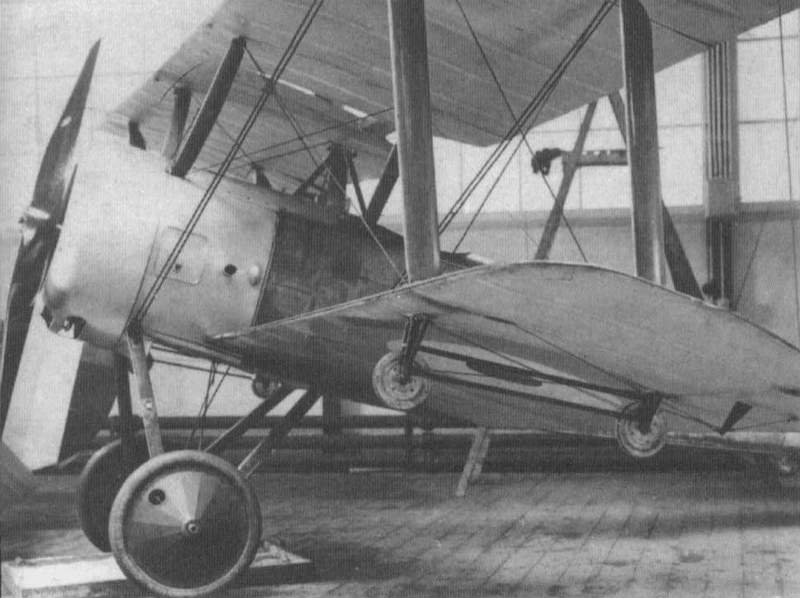
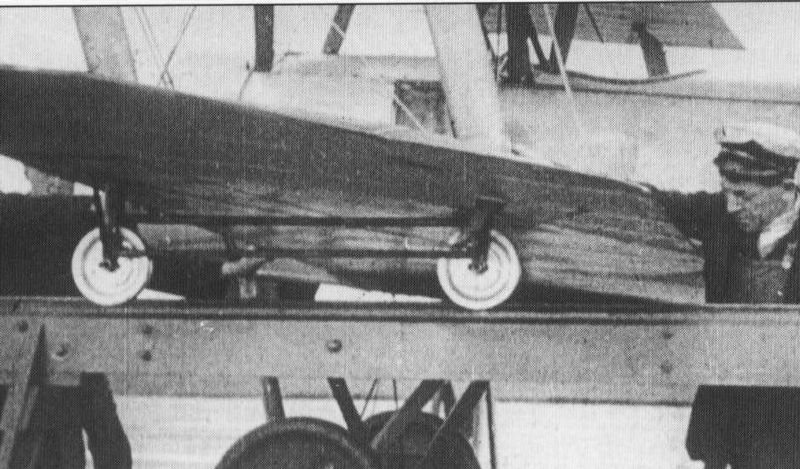
At Grain on 16th August they film the latest experiment with ‘Pup’ 9922. It has had the sprung skids removed and pairs of deeply grooved small wheels fitted under each wing.(above) Lowered onto trestle mounted rails with its undercarriage off the ground, the engine is started and it is flown off.(below) This method of launching is so obviously complex and perilous it may well be abandoned, especially as there have now been successful conventional take-offs from short platforms on ships although not in rough seas.
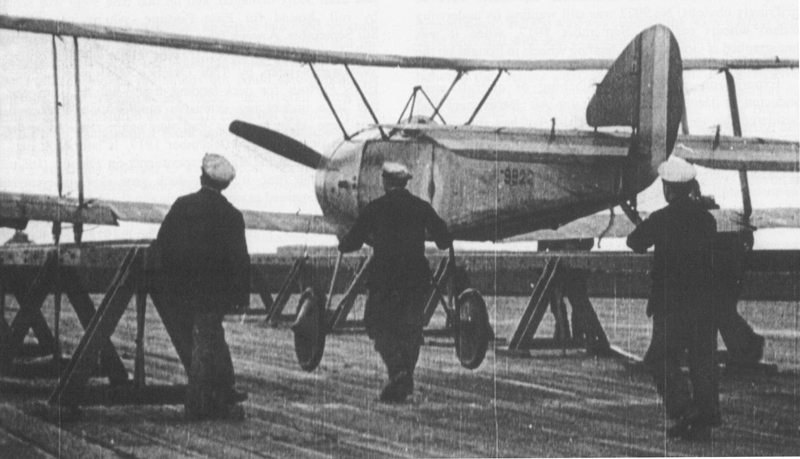
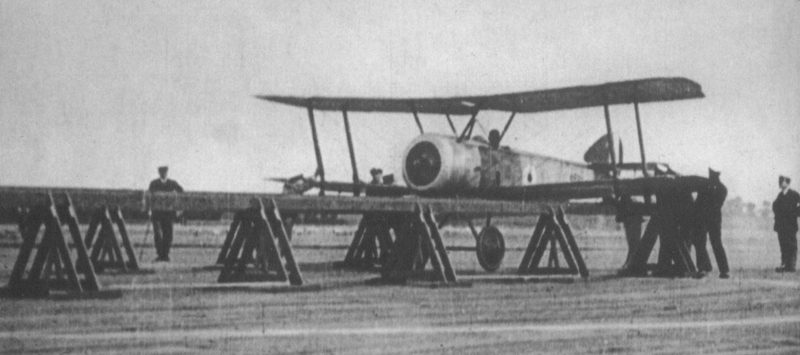
On 17th August ‘Strutters’ A2413 & A8224 each claim an Albatros, A8771 crashes with combat damage killing the pilot and wounding the observer whilst A1047 is wrecked by a propeller burst on take-off. ‘Pup’ B1733 claims two victories, B2176 claims one, the pilot of B1732 is taken prisoner, B1783 overturns landing into wind and N6190 also crashes on landing. ‘Camels’ B3833, B3882 & N6351 share a victory, N6364 claims another, B3757 & B3877 collide in mid-air killing both pilots, the pilot of N6334 is killed in combat and the pilot of B3783 is wounded. Westgate ‘Baby’ floatplane 3670 overturns landing in strong winds, is salvaged but is beyond repair.
On 18th August the pilot of Hooper-built ‘Strutter bomber’ A6901 is killed collecting it from Hendon whilst N5600 is wrecked in France. ‘Triplane’ N5354 claims a victory. ‘Camels’ B3889 N6363 & N6370 each claim a victory, the pilots of B2319 & B3938 are killed in combat whilst the pilot of B3871 is wounded by four bullets in the chest. The Sopwith tug-of-war team beat the home team at Whitehead’s second annual sports day at Hanworth Park.
On 19th August the crew of ‘Strutter’ A8298 are killed when it breaks up in flight probably hit by a British shell whilst A1013 is wrecked landing with damaged undercarriage as is A8784 “in a pancake landing from 20ft”. ‘Pup’ A649 is damaged in combat with three enemy aircraft whilst the pilot of A7345 dies of his injuries after stalling and nose diving on his first solo flight in a ‘Pup’ at Yatesbury. ‘Triplane’ N5421 shares a victory with two others, the pilot of N5464 is killed in combat whilst N5354 & N6359 are damaged in forced landings. ‘Camel’ B3813 claims a victory, B3845 shares a victory with two others, B2307 is shot down and the pilot taken prisoner, the pilot of B3788 is killed after spinning, B3931 has an engine break up in the air tearing off the cowl, B3817 crashes with an engine failure and both N6351 & N6359 are damaged in crash landings.
On 20th August the crew of ‘Strutter’ A8336 are killed in combat whilst A1037 is wrecked on landing. ‘Pup’ B1757 claims a victory whilst N5194 is completely wrecked. ‘Triplane’ N5355 is sent down by five enemy aircraft, the pilot taken prisoner dies of his injuries. N5469 crashes on take-off and N5455 is hit by another aircraft whilst stationary in mist. ‘Camel’ B3754 claims a victory, N6375 & B3833 share victories with others, pilot of B3876 is killed in combat, the pilot of B3813 injured after engine failure on take-off, B3918 crashes as does B2324.
On 20th August 350 more ‘Pups’ are ordered from Standard Motors bringing their total to 850 of which 250 are delivered and another 100 ordered from Whitehead bring them up to 550 of which around 150 are delivered.
On 21st August ‘Strutter’ B2583 claims a victory, the observer in A1056 is wounded in combat before it is wrecked whilst B2570 crashes after take-off. ‘Pups’ B1762 & B2176 each claim a victory, the pilots of B1775 & B2177 are killed in combat, B2156 is hit by shrapnel from an AA shell, B1759 is shot up in combat whilst B1798 crashes on take-off. ‘Triplane’ N5381 claims two victories, N5366 & N6295 each claim one, the pilots of N5425 & N6308 are killed in combat whilst N5379 crashes on landing and French ‘Triplane’ F13/SP13 kills the observer in an enemy aircraft. ‘Camel’ N5380 claims two victories & B3787 claims one. ‘Baby’ floatplane 8119 is wrecked cartwheeling in a downwind take-off.
Following Rutland’s success flying a ‘Pup’ from the 16ft platform on HMS Yarmouth, Admiral Beatty has this week requested the fitting of a flying-off platform to one ship in each of his Light Cruiser Squadrons to carry an anti-Zeppelin aircraft. On 21st August Fl Sub Lt Smart flies ‘Pup’ N6430 from HMS Yarmouth’s platform off the coast of Jutland when Zeppelin L23 is sighted. He manages to climb above the airship and dive to gain enough speed to overtake it. Opening fire at 250 yards he gets within 20 yards of the tail rudders before his shots ignite the airship and it falls “an incandescent mass” into the sea. He spots a destroyer and lands in front of it, his airbags keeping him afloat until he is rescued by one of HMS Prince’s whalers. (below)
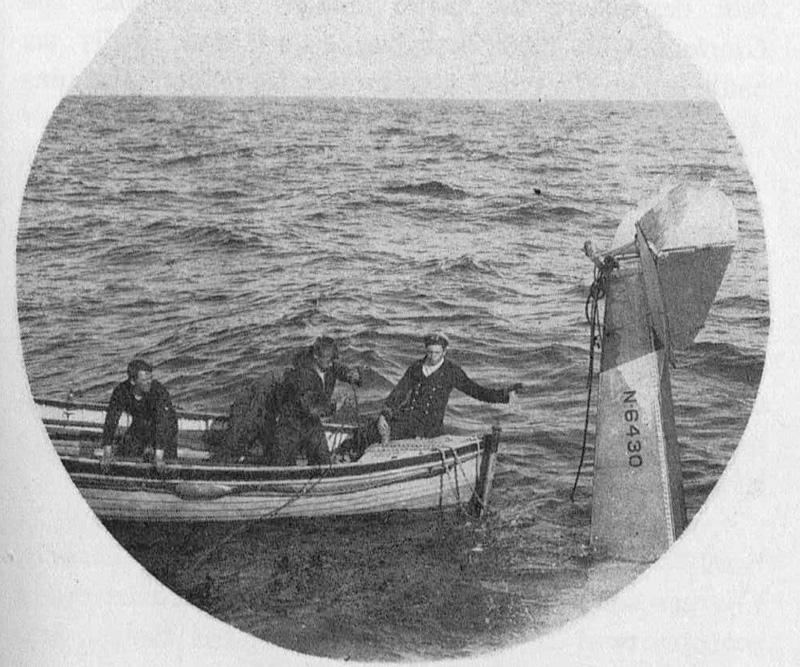
Overnight on 21st/22nd August eight of the latest Zeppelin airships set out to attack Northern England. Now operating at 20,000ft no interceptions are possible but all the airships had operational difficulties with high winds, frozen compasses and impaired human performance due to primitive oxygen equipment. Despite a reported 24,000lbs of bombs dropped, the only recorded bombs were on Hull killing one person.
On 22nd August ten Gotha bombers are spotted coming towards the Thames estuary. With such early warning the RFC Home Defence fighters are patrolling to defend the capital, the shore gun batteries are ready and RNAS Camels and Pups are up at the Gotha’s 14 to 16,000ft altitude. ‘Pups’ 9901 & N6440 jointly claim a Gotha which immediately goes down off Margate whilst ‘Camel’ B3834 “Wonga Bonga” (below) contributes to the destruction of another. ‘Baby’ floatplane 8246 crashes alighting beside the ditched Gotha. The raiders head south and a third is shot down off Dover by Manston ‘Camel’ B3844. From Dunkirk two ‘Camels’ and three ‘Pups’ attack the returning raiders without success, the other Dunkirk machines are occupied repelling 25 German fighters sent out to protect the Gothas.
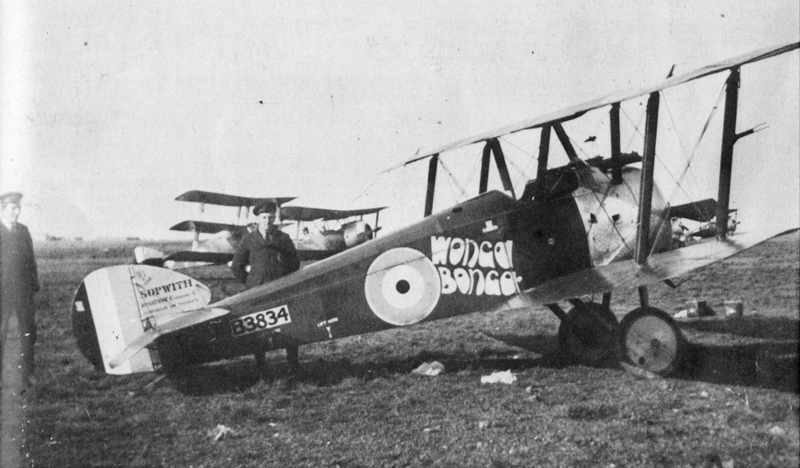
Over the Western Front on 22nd August the pilot of B1767 is taken prisoner after a forced landing with engine trouble. ‘Camels’ B3833, B3841, B3858, B3862, B3895 & N6347 each claim a victory, B3921 sets fire to a shed containing an enemy kite balloon, the pilots of B2317 & B2381 are wounded in combat and the pilot of B3768 is taken prisoner whilst B3919 crashes. ‘Baby’ floatplane 3746 “falls into the sea” off Yarmouth killing the pilot. At Cranwell ‘Strutters’ N5636 & N5605 are damaged colliding. At Martlesham Heath Sopwith-built ‘Camel’ B3751 and Ruston Proctor-built B2312 start tests to compare the performance of French-built and Ruston Proctor-built Clerget engines and to compare various propellers.
With at least five ‘Pups’ and the first ‘Camels’ now in the Seaplane Defence Flight at St Pol, they have largely taken over the patrols and interception of German floatplanes off the Belgian coast from the RNAS Dunkirk’s Sopwith ‘Baby’ floatplanes. However, the French Navy’s four original 100hp ‘Baby’ floatplanes at Dunkirk (ex RNAS 8128, 29, 85 & 4) are being reinforced with four 110hp & 130hp Blackburn-built machines (ex-RNAS N1106, 21, 1430 & 31). (Photographs below show the French machines in Dunkirk harbour with and without headrests, fitted with top-wing Lewis guns or a synchronised single Vickers gun)
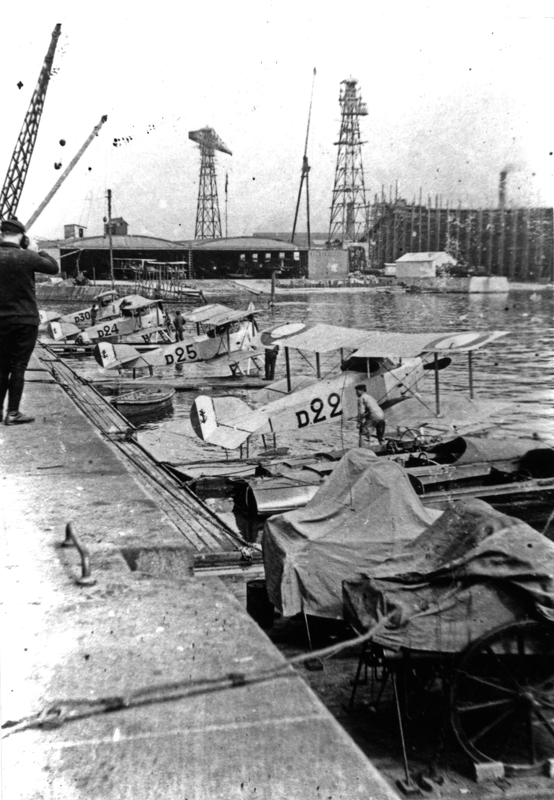
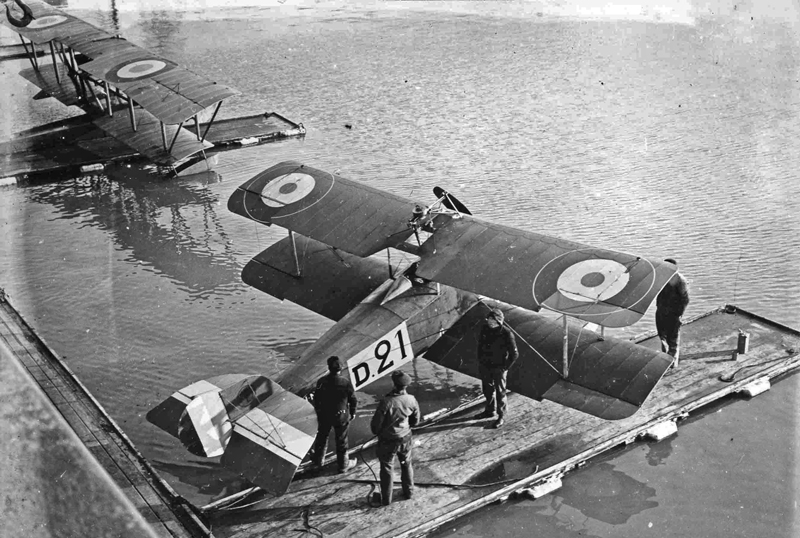
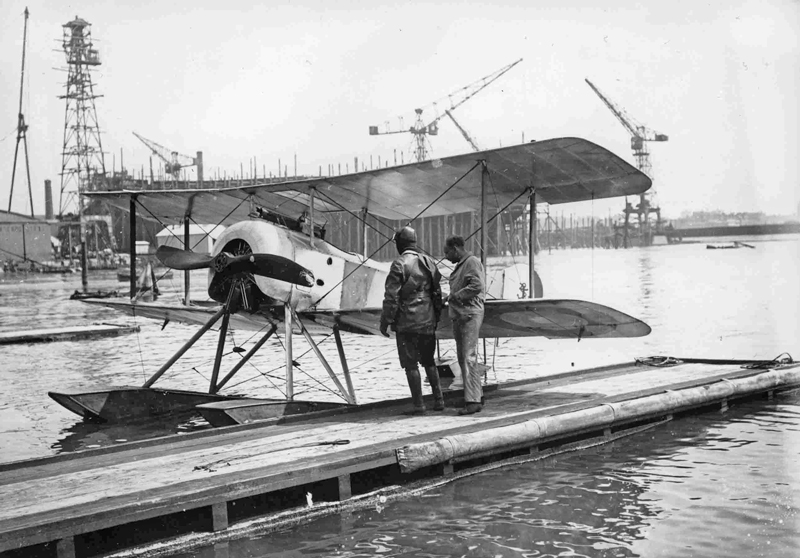
On 23rd August ‘Strutters’ A1048 & A1053 each claim an Albatros, N5093 crashes at Dunkirk. ‘Pup’ B1846 crashes taking off from a forced landing whilst the engine of A6182 is found to be out of alignment with its fuselage. The pilots of ‘Camels’ B3768 & B3915 are taken prisoner after combat. B3890 has a forced landing with engine failure.
On 24th August ‘Baby’ N1422 is crashed beyond repair at Killingholme and new Ruston-Proctor built ‘Camels’ B2336 & B2337 are returned to Lincoln having crashed with engine failures on delivery flights.
Very little flying is possible in France due to the weather but there is plenty of work for the air mechanics on the squadrons and at the RFC Depots who are coping with all manner of practical issues with their first Sopwith ’Camels’ not least the variable and sometimes totally unacceptable performance of British-built Clerget engines. Trenchard has demanded an explanation for new machines only reaching 18,000ft when the official figure is 21,000ft. Equally, recent tests with B3751 confirm a significant drop-off in performance in service even with French engines: after 35 hours flying time an extra 8 minutes to get to 15,000ft and a loss of 5mph at that height. Pitch variations in the Lang propellers are not helping, giving speed differences on the ground on the same engine of up to 80 revs per minute. Pending more left-hand feed blocks, the RFC are cutting away cowls over the guns to give free access to the right hand one and then fitting “Auster” windscreens. Modifications are being introduced to stop control cables fraying under the pilot’s seat and where they exit the fuselage. There are now two designs of undercarriage which are interchangeable but individual spare parts are not. Some aircraft are being retro-fitted with Constantinescu hydraulic gun-gear and some have arrived fitted with obsolescent Vickers gun barrels. The Navy are experiencing oil pump spring failures on their Bentley BR1 engined ‘Camels’ but Captain Bentley has been out to assess the problem and has immediately arranged the supply of better ones.
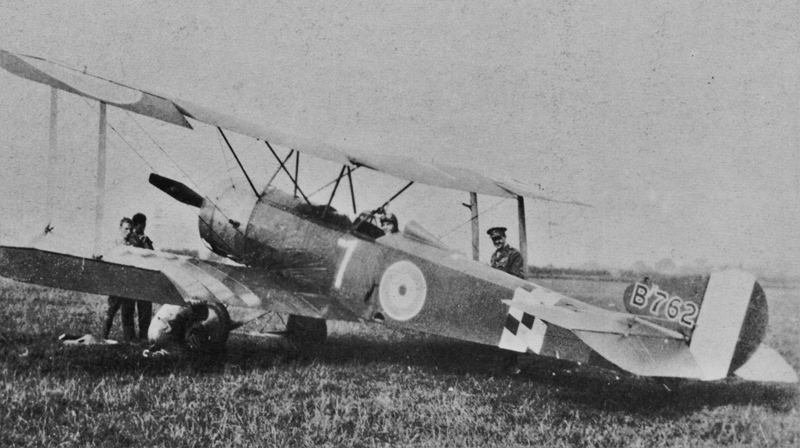
Through the summer, fifty-nine Sopwith ‘Strutters’ have been allocated to 37, 44 & 78 Home Defence Squadrons. At Suttons Farm, 78 Sqdn’s Cpt Honnett has had two-seat ‘Strutter’ B762 converted into a single seater with the pilot in the rear seat to give a better all round view. (above) It is unarmed so far but this arrangement provides the option of the pilot operating overwing or upward firing machine guns. Dubbed the ‘Comic Strutter’, B762 is now on test at Martlesham Heath. It is one of a few which have recently been built by the (Southern) Aeroplane Repair Depot at Farnborough from parts of other aircraft and allocated completely new serial numbers. The checkerboard bands, probably red, white and blue, are unofficial and unique to one flight of 78 Squadron.
On 25th August the pilot of ‘Strutter’ A6914 is injured crashing taking off from a forced landing near Kettering. In France ‘Triplane’ N6295 claims a victory whilst the pilot of N5367is taken prisoner after being shot down. ‘Camel’ B3889 shares a victory but the pilot of B3918 is wounded in combat. B3917 claims RFC 45Sqdn’s first ‘Camel’ victory but on his second day in office their new Commanding Officer embarrassingly crashes ‘Camel’ B3792 on take-off damaging several parked aircraft.
On 26th August with increasing numbers of aircraft in the skies, RFC Headquarters issues a list of squadron markings to be applied to all aircraft, including for the first time RNAS squadrons. 45Sqdn ‘Camels’ for example are to carry white “dumb-bell” marks on both sides of the fuselage and the top decking. Their ‘Strutters’ have previously simply displayed a black or white band behind the roundel to distinguish them from RNAS ‘Strutters’.
On 26th August ‘Pup’ A6184 crashes forced landing from an offensive patrol. ‘Triplane’ N6299 shares a victory with N6301, whilst the pilot of N5421 is injured and taken prisoner. New ‘Camel’ B2323 having already been returned to Lincoln due to engine failure, forced lands on re-delivery with a fuel shortage and a cracked propeller.
On 27th August ‘Camel’ B3875 claims a victory but B3781 crashes near St.Pol in bad weather. At RNAS Grain the standard 80hp Le Rhône engine in their dropping undercarriage ‘SB.III Folding Pup’ N6103 is being replaced with a 100hp Monosoupape Gnome. Sqn Cdr Busteed is now on HMS Furious at Scapa Flow continuing Dunning’s experiments with ‘Pup’ deck flying and he is photographed (below) in N6453 tethered from the underwing picketing points apparently using the elevators to hold the aircraft in flying attitude.
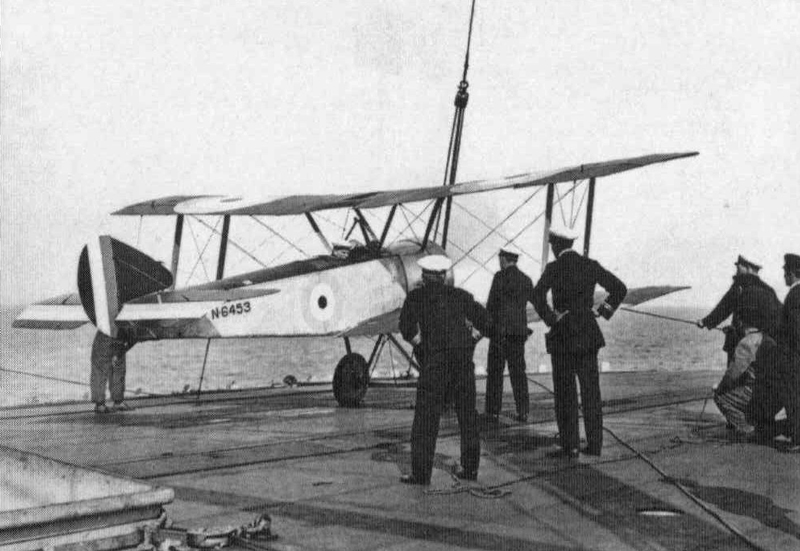
On 28th August British Caudron receive a first order for 100 ‘Camels’ and last week 100 more were ordered from Boulton and Paul. The total number of ‘Camels’ ordered is now an amazing 2,300: Sopwith (550), Ruston Proctor (550), Boulton & Paul (400), Clayton & Shuttleworth (300), Nieuport (200) plus 100 each on British Caudron, Portholme and Hooper. Nearly 400 of these have already been delivered.
On 28th August in France 54 Sqdn ‘Pups’ A6205 & B1704 are damaged when a gale collapses their hangar. The rain and strong winds continue through the following day cancelling all flying. ‘Baby’ floatplane 3781, delivered to Windermere eighteen months ago and in service at Calshot and Bembridge for the last seven months, is deleted from service. The experimental work at Orfordness now includes mapping by oblique photography. They use the equipment to make this composite time-lapse image of Cpt Brown looping their ‘Triplane’ and a ‘Pup’ being looped overs the islands and streams of the River Ore.
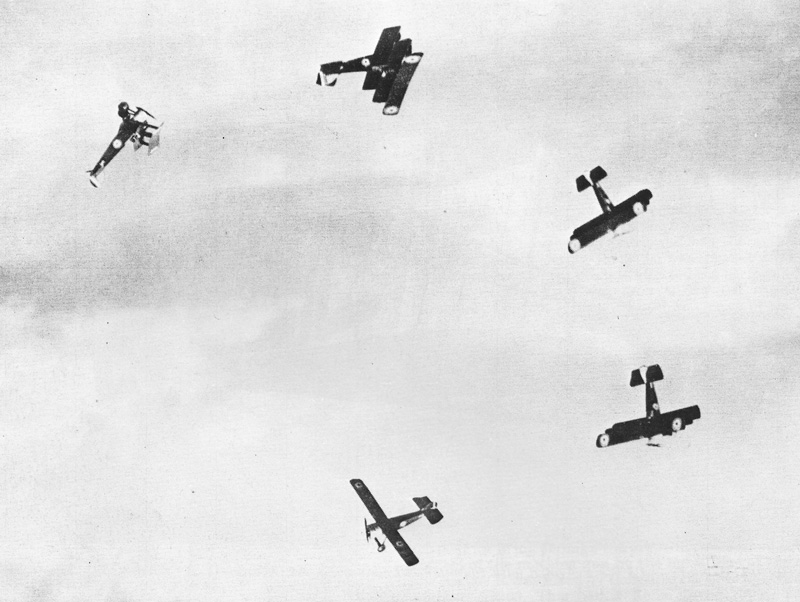
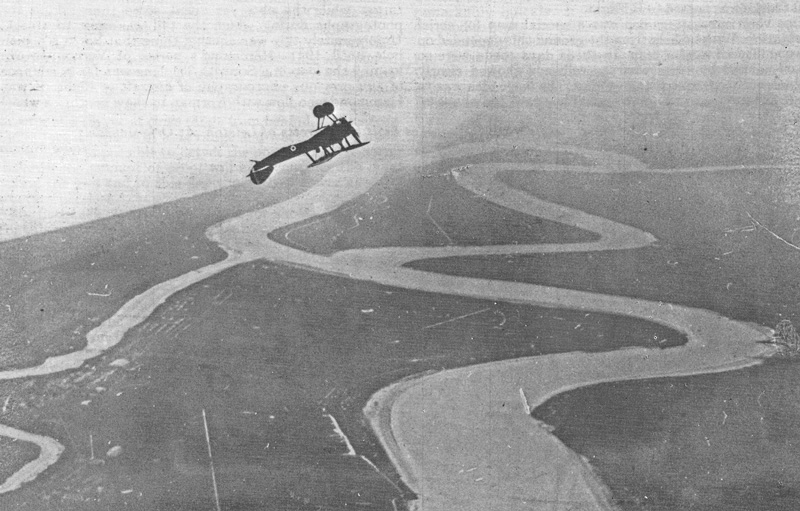
On 30th August in the Aegean ‘Strutter’ N5616 is wrecked in a forced landing after engine failure ending on its nose on a salt lake. At Upavon the pilot of ‘Pup’ B2171 dies after stalling and spinning. ‘Baby’ floatplane N1415 just arrived at Scapa Flow, is completely wrecked “falling into the sea” and injuring the pilot. In continuing bad weather in France, RFC 45 Squadron make there last ‘Strutter’ operational sortie when two go out on a photographic mission escorted by two of their new ‘Camels’ but the mission is abandoned due to low cloud. ‘Pup’ A648 hits stationary ‘Pup’ B1766 on landing and B1701 crashes on landing.
Ham District Council have been informed that “it is proposed to acquire, under the Defence of the Realm Act, about 30 acres of land abutting upon the River Thames at Ham, for the purpose of erecting thereon an Aircraft or Munitions Factory with the possibility of the area being increased to 40 or 50 acres”. On 30th August they urgently seek the assistance of adjacent local councils to use their influence with the Government in this matter. On 31st August a deputation from Ham, Twickenham and Teddington District Councils and Richmond Town Council meets Howard Frank, Director General of the War Office & Ministry of Munitions Lands Directorate and learn that the Ministry “propose to erect for a private firm a permanent factory on the site at a cost of some £100,000”. They “raise no objection to the Factory as a war measure but view with alarm the proposal to establish a permanent Factory on the site in question, having regards to the large sums of money, approximating £150,000, which has been contributed by the County Councils of London, Surrey and Middlesex, the Local Authorities and individuals for the express purpose of preserving the amenities of the River Thames”. They “urge that the works should be of a temporary character only and that the Government should give assurance that the Factory would be removed at the end of the War and the land returned to its present condition”. They were unable to obtain these assurances but the Ministry did state that it would consider any other sites convenient for the purpose which the Local Authorities might submit.
On 31st August ‘Strutters’ 9652 & A1048 are wrecked. The pilot of ‘Pup’ B1794 is killed in combat and the pilot of B1809 seriously injured by a flat spin after engine failure. ‘Camel’ B3889 is damaged in combat.
Sopwith’s output of 90 ‘F1 Camels’ in August is slightly down on July. These include the first with strengthened wings, B3915. Sopwith Works’ Records show the first production ‘2F1 Ships Camel’ N6600 has also been completed and sent to Brooklands but it is not yet delivered. The total of new Sopwith designed aircraft from all suppliers in August is 258. The 168 machines from other manufacturers are 41 ‘Strutters’ from Hooper (18), Morgan (22) and the last one from Ruston Proctor; 50 ‘Pups’ from Standard Motors (37) and Whitehead (13); 7 ‘SB.III folding Pups’ from Beardmore; the last 2 ‘Triplanes’ from Clayton & Shuttleworth, 49 ‘Camels’ from Clayton and Shuttleworth (4), Ruston Proctor (44) and the first from Portholme with 9 ‘Baby’ floatplanes from Blackburn and 10 ‘Fairey Hamble Baby’ floatplanes from Parnall (9) and Fairey (1). These monthly figures again exclude any Wells Aviation ‘Strutters’ delivered in their receivership and the manufacture of Sopwith ‘Strutters’ in France and Russia.
As previously noted there have been orders for 700 more ‘Camels’ during August and 350 more ‘Pups’. Surprisingly, Blackburn have had an order for 75 more 130hp ‘Baby’ floatplanes (N2060 – N2134) and Parnall have been ordered to convert the 75 of their order for 100 ‘Fairey Hamble Baby’ from floatplanes to landplanes.
After the wettest August in Flanders in living memory, conditions remain terrible for the troops on the ground and for flying. On 1st September the crew of ‘Strutter’ A2413 are injured spinning-in attempting to take-off on a line patrol and ‘Pup’ 9948 is badly damaged. Prototype ‘Camel’ N518 with a 150hp Bentley AR1 engine is at St Omer for service trials after 17hours flying at Martlesham Heath. ‘Schneider’ floatplane 3769 is wrecked after 21 months at Killingholme.
On 2nd September A648 ‘Camel’ B3921 shoots down a kite balloon.
On 3rd September ‘Pup’ B1760 claims a victory. The pilot of B1787 dies of his injuries after spinning-in on a practice flight, the pilots of A7333, B1754 & B1795 are shot down and taken prisoner, the wounded pilot of shot-up B1716 survives a forced landing whilst B735 is damaged bursting a tyre in a forced landing with engine failure. (‘Pup’ B1795 is the 61st victim of Manfred von Richtofen seen below sitting on its fuselage with Anthony Fokker.)
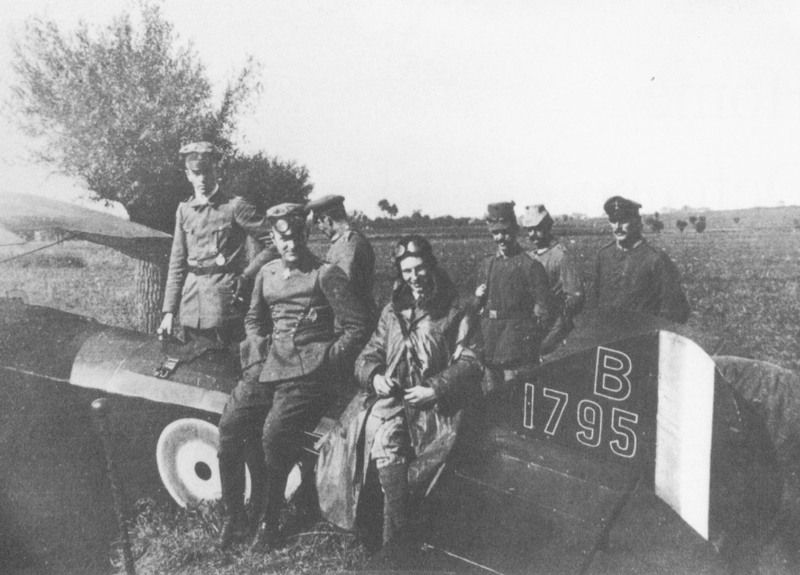
The pilot of ‘Triplane’ N5381 is killed in combat as is the pilot of F15/N5388, the only French ‘Triplane’ combat loss.(below)
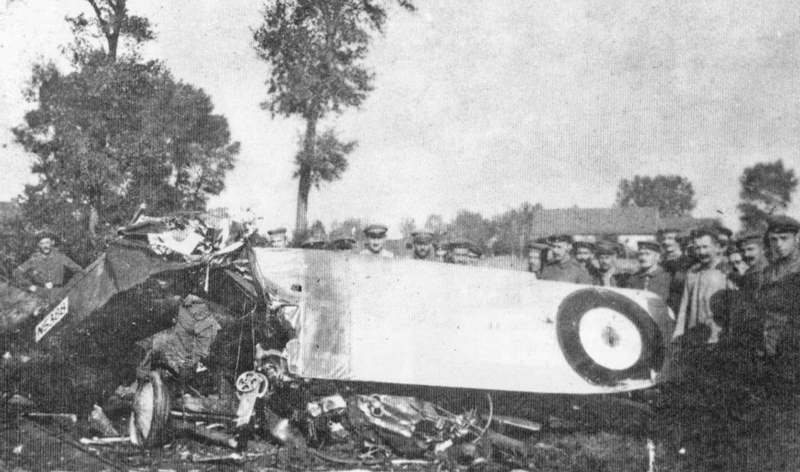
‘Camel’ B3782 claims two victories, B2327, B3787, B3867, B3871, B3875, B3879, B3898 & B3909 each claim a victory, B3884 shares one with three others. The pilot of ‘Camel’ B3917 is killed in action, B3796’s pilot is taken prisoner and B2306’s pilot is killed in a crash landing, N6348’s is forced to land with shrapnel wounds, B3872 is forced to land hit in the fuel tank whilst B3786, B3866, N6371 & N6373 all crash land.
In the last 11 months pursuing their prime roles in support of the army on the ground, 45 Squadron have claimed eighty-four “scores” in ‘Strutters’ of which twenty-eight were “kills”, significantly more than the other two RFC ‘Strutter’ squadrons in France (43 & 70 Squadrons). The cost to 45 Sqdn however has been high: sixty-four men dead or posted missing, nineteen wounded and six in captivity. This amounts to the loss of the squadron’s entire fighting strength three times over. Now fully re-equipped with eighteen ‘Camels’ and claiming seven victories on this one day their confidence and morale are recovering, despite two losses.
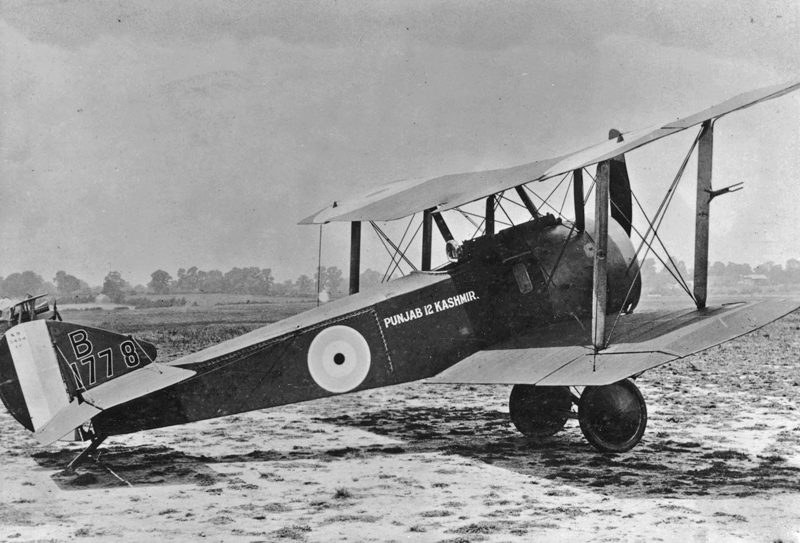
On 4th September ‘Strutter’ N5150 crashes on take-off. ‘Pups A6197, B1760 & B1777 claim victories, B1802 shares a victory with four others, A6172 is shot down as are B1838 & B2197 with the pilots taken prisoner. A7337 crashes on take-off and presentation aircraft B1778 “Punjab 12 Kashmir” (above) is wrecked overturning on landing. From Cranwell, 9908 is wrecked landing lost in a field and at Upavon on his second solo the pilot of A659 is injured gliding into the ground inverted. French ‘Triplane’ SP13/N5386 claims one of six Albatros it attacked. ‘Camels’ B3871 & B3884 each claim a victory, B3898 shares one with two others, B3864 is wrecked and the pilot killed whilst B3754 & B3866 forced land with engine failure and B3929 forced lands lost in mist.
On 4th September the deputation of local Councils meets the Comptroller of Housing and Town Planning at the Local Government Board placing before him their views on the proposed Factory by the Thames and submitting four alternative sites which, in their opinion, “are equally suitable for the Works without being detrimental to the amenities of their respective neighbourhoods”.
On 5th September ‘Strutter’ N5647 is badly damaged at Cranwell. ‘Pup’ A6203 claims a victory, the pilot of ‘Pup’ A658 is killed possibly after a wing collapses in mid-air, B1842 is shot up as is A7331 but by AA fire. ‘Pups’ A6200, B2180 & N6437crash on landing, B1831 is also wrecked. The pilot of ‘Triplane’ N5366 severely injured crash landing in mist, N5447 lands too fast and hits N6295. ‘Camels’ B2314, B3807, B3903 & N6377 each claim a victory, B3810 shares a victory with four others. The pilots of B3838 & B3863 are killed in action and the pilot of B3777 is taken prisoner whilst B3865 overturns forced landing on a beach.
‘Camel’ B3811 at Orfordness Experimental Station is testing oxygen cylinder breathing apparatus. The RNAS continue their experiments with guided ship-take-offs. Harry Busteed has now flown ‘Pup’ 9922 off the dummy deck at Grain with the wheels in troughs. The photograph (below) shows 9922, the troughs and the aircraft positioned for take-off with the tail up on a trestle and still fitted with underwing wheels from the last rails-on-trestles experiment.
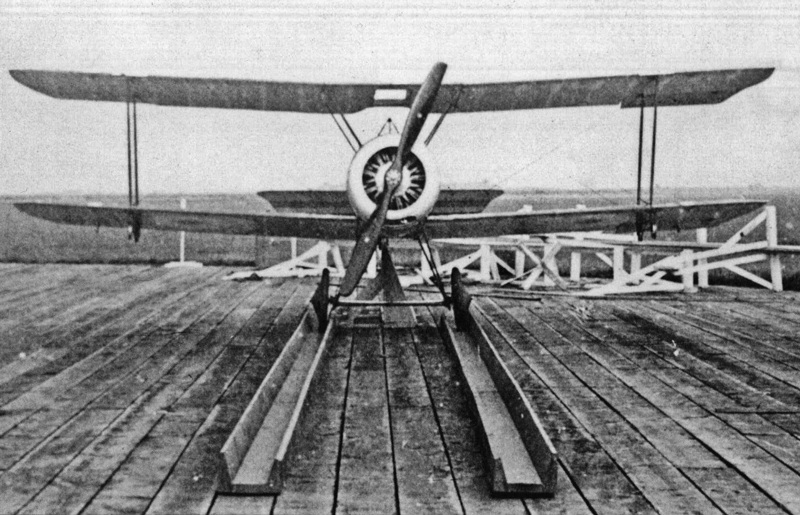
Despite large orders for ‘F1 Camels’ and ‘5F1 Dolphins’ the Sopwith Aviation Co. continue to invest considerable design and experimental effort in new aircraft projects. Sopwith are well underway with the detailed design of their proposed ‘Camel’ replacement the ‘7F1 Snipe’ whilst the prototype ‘3F2 Hippo’ two-seat fighter with back-staggered wings devised back in April alongside the single-seat ‘2F1 Dolphin’ is almost complete. In addition, a general arrangement drawing has now been approved for a very similar ‘2FR1 Bulldog’ two-seat fighter with more conventional forward-staggered wings. The drawing (below) shows it with five guns, two forward firing guns each for the pilot and observer and one to protect the rear.
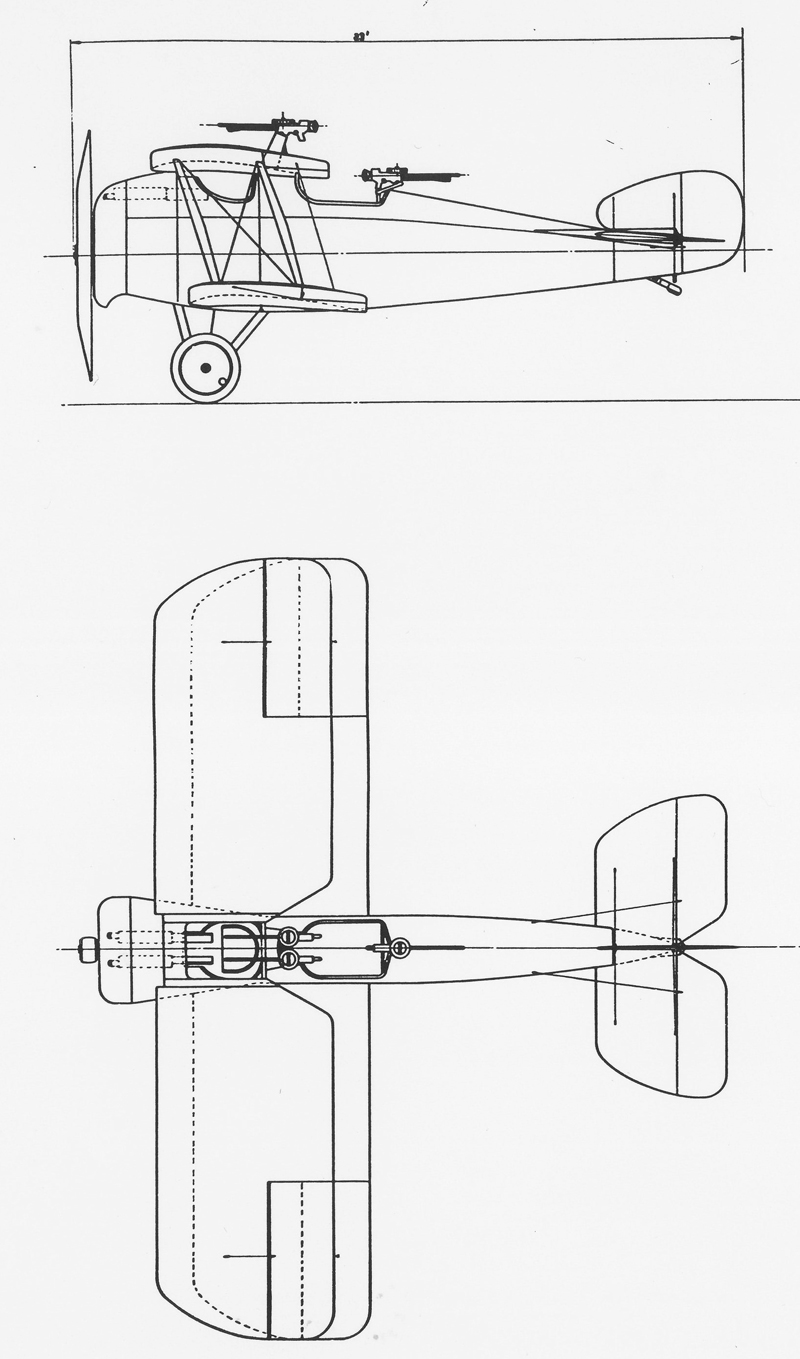
To avoid duplication of effort and wasting time and resources on unpromising types it is now mandatory to obtain a licence from the Air Board to build a prototype of any new design even as a private venture when no Government funding is involved. During August Thomas Sopwith has personally presented a third new two-seat design to Air Board officials in the hope of getting support. This “2B2 Rhino” makes use of the favoured 230hp 19 litre six-cylinder in-line BHP (Beardmore/Halford/Pullinger) engine and is a single-bay triplane with Strutter-like sloping cabane struts and Dolphin-like side radiators. The big engine, three wings, two-seats and a large internal bomb bay to take a quick-change bomb and bomb release gear pack makes for a bulky machine. (below) With the de Havilland DH4 well established in this light bomber category and a DH9 already flying with the BHP engine, Sopwith only gets a licence to proceed with a single private venture prototype of the ‘Rhino’.
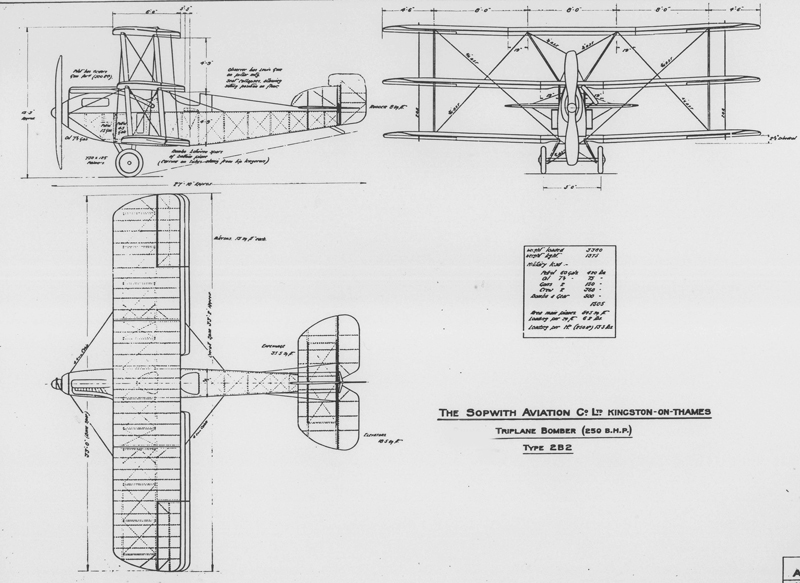
A new menace over England is the first night bombing raids, a hit and run effort on Dover on 2nd /3rd September and a five Gotha raid on Chatham Dockyards on 3rd/4th September with the tragic ill-chance of two bombs hitting a dormitory killing 150 naval recruits and injuring another 88. None of these raiders are intercepted but the CO of 44Sqdn at Hainault takes the bold decision to send up three ‘Camels’ proving conclusively that one of Britain’s latest day fighters can safely be flown at night. Encouraged by the minimal opposition, on 4th/5th September five Gothas raid London and four others range around Kent and up the East Coast killing 19 and injuring 71. 44Sqdn send up four ‘Camels’ including B3885. (below) One Gotha is downed probably by AA fire.
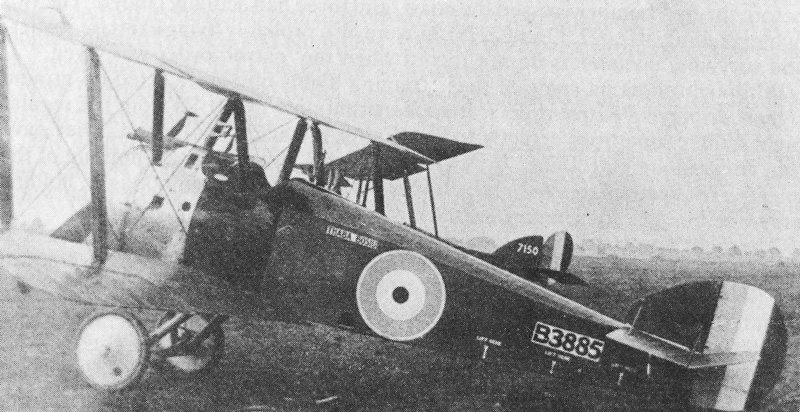
On 6th September, ‘Pup’ B1842, claimed yesterday by Lt Werner Voss, was badly damaged and has gone straight to the repair section at No.1 Aircraft Depot in France. ‘Camel’ N6342 claims a victory, B3884 shares a victory with four others, the pilot of B2340 dies of his injuries crashing taking-off on a test flight, the pilot of B2303 is injured in a forced landing whilst B3807 & B3940 crash on landing. ‘Baby’ floatplane 8166, which has been at Felixstowe 19 months (below), crashes on arrival at Killingholme.
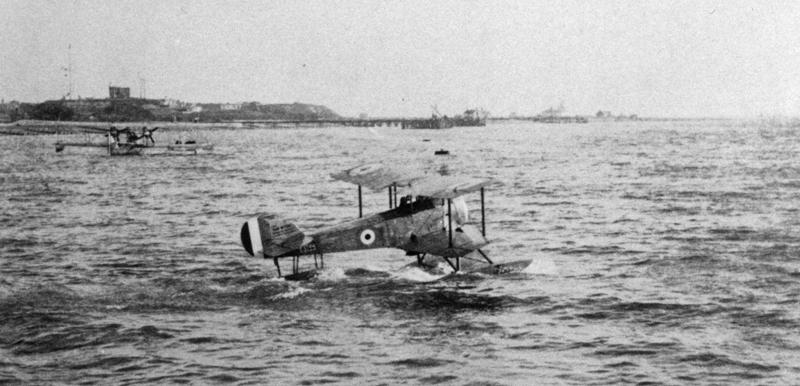
On 7th September, the Local Councils’ objections to the proposed National Aircraft Factory No.2 at Ham are taken to Minister of Munitions himself, Winston Churchill, who gives the following rulings: 1. Erect the factory on the site now chosen. 2. Make it of whatever materials are most convenient. 3. Classify it as a “temporary factory”. 4. Make arrangements for its removal immediately after the war. 5. Report how you will give effect to this.
Sir William Weir, in charge of aircraft production who had earlier proposed his own Glasgow company should run this factory, writes to Sopwith Aviation confirming that they can lease the factory to greatly expand their manufacturing capacity stating that: “It is the intention of the Government that you should immediately vacate this factory after the war” and “Nothing is to stand in the way of this factory being erected in record time.”
On 7th September, the crew of ‘Strutter’ 7999 are injured crashing after banking too low on take-off at Castle Bromwich. ‘Pup’ B1744 is damaged running into a ditch after the engine cuts-out on a test flight. ‘Camel’ B3814 suffers a forced landing whilst B3924 has been fitted with experimental air scoops at Manston.
On 8th September, flying is prevented by heavy ground mist and low clouds. On 9th September, the pilot of ‘Triplane’ N5477 is killed in combat. ‘Camel’ B3791 claims two victories, B2341 claims a victory plus a second shared with B3928, B3882 claims one, B3898 shares one with B6204, the pilot of B3916 is seriously wounded and crashes in a shell hole whilst N6351 also crashes. 9(N)Sqdn ‘Camel’ B3881 crashes landing after an engine failure and may well lose the painted head of comedian George Robey from its fin during repairs. (below)
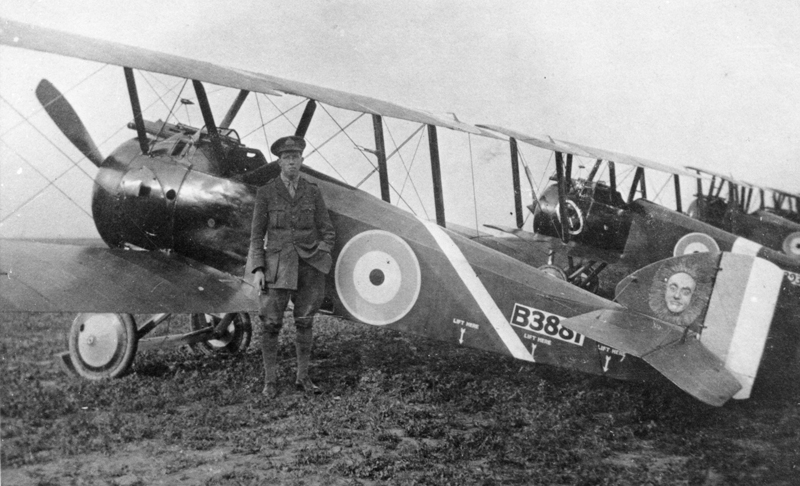
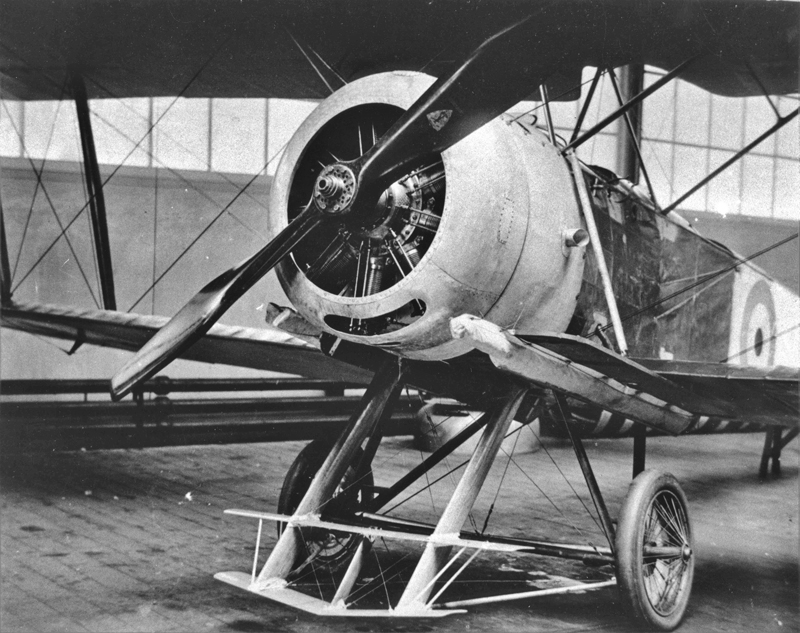
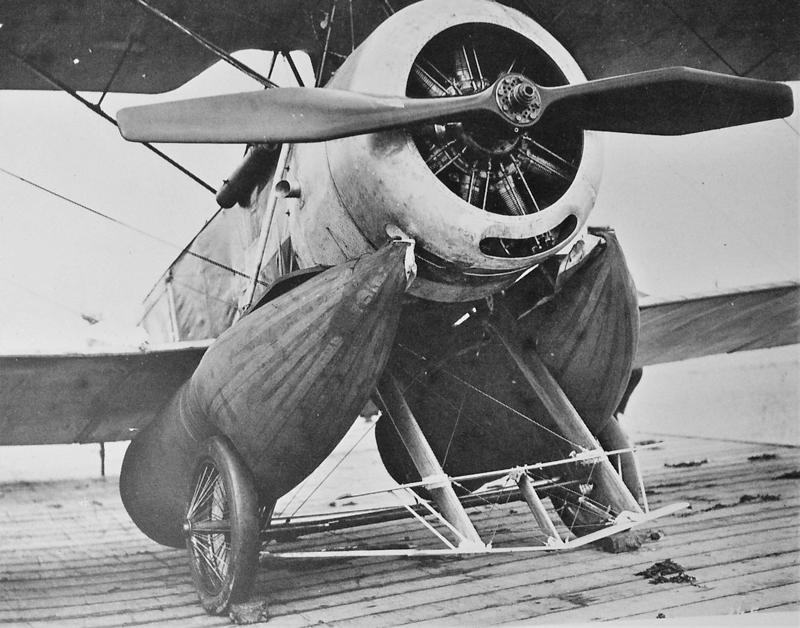
Probably as a consequence of ‘Strutters’ on anti-submarine work, 9390 has been fitted at RNAS Grain with an advanced looking a biplane hydrovane to hold the nose up during ditching and inflatable airbags to keep it afloat.(above) The tests on 9th September are successful and 9390 is pictured being towed in. (below)
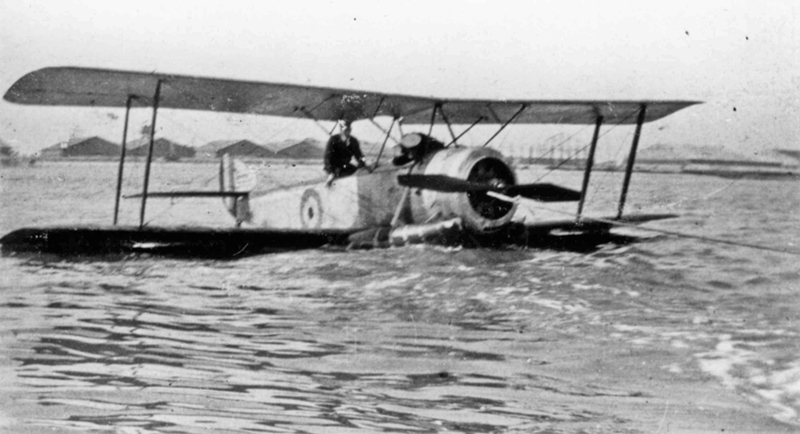
On 10th September, ‘Triplane’ N5436 claims a victory. ‘Camel’ B3342 claims a Fokker Triplane, B2323, B3841 & B3853 each claim a victory, B3785 shares the forcing down of an intact DFW C with four others, the pilots of B3787 & B3927 are killed in combat and N6342 crashes. At home ‘Camel’ B2332 suffers an engine failure on take-off at Wye diving in from 30ft whilst B2348 & B2355 are wrecked crashing on delivery from Lincoln. ‘Baby’ floatplane N1104 is wrecked at South Shields.
On 11th September, the pilot of ‘Strutter’ B2582 is killed and the observer injured hitting a tree on landing whilst B2573 is wrecked after the engine fails. ‘Pups’ A7344 & B1757 each claim a victory, A6188 shares one with three others, the American pilot of B2180 is killed in combat and B1799 is damaged in combat. HMS Furious’ ‘Pup’ N6450 ditches returning from an abortive Zeppelin sighting, the pilot being rescued by HMS Mystic which destroys the remains of the aircraft. ‘Triplane’ N5487 hits a ridge and overturns on landing. ‘Camels’ B3895, B2328, B3782, B3798, B3845, B3903 & N6364 each claim a victory, B3883 shares one with three others, the pilot of B6236 is killed in combat whilst B3896 hits a hangar and aircraft on landing.
On 11th September, the Director General of Lands at the Ministry of Munitions writes to tell the Local Councils who sent the deputation to him that he has been able to take instructions from the Minister about the proposed factory at Ham. “It has been decided in deference to the expressed wishes of the inhabitants to release the site adjoining the Thames and take in its place land close to the river adjoining Ham Road to which the principle objections do not apply. It is found necessary to erect a factory in close proximity to Messrs Sopwith’s existing factory, otherwise the loss of efficiency would be quite 50% which is a serious matter at the present time. The Minister has however, given instructions that the building to be erected shall now be of a temporary character.”
On 12th September, the pilot of ‘Pup’ B1836 is killed in combat whilst B1816 & B1824 are wrecked. In the Mediterranean theatre Fl Cdr C E Wood is killed in action over Macedonia in one of the first ‘Camels’ to arrive whilst ‘Baby’ floatplane N1030 drops a 65lb bomb on a U-Boat 20 miles out to sea from Otranto.
Commodore Murray Sueter‘s RNAS 6 Wing has been at Otranto on the heal of Italy since June with the express intention of making as dangerous as possible for German U-boats to move from their safe bases in the Adriatic out into the Mediterranean where they are attacking allied shipping with vital supplies and troops for the campaigns in Egypt, Palestine, Macedonia and Mesopotamia. In addition to his floatplanes, Sueter is keeping ‘Strutters’ with their quick start-up radial engines on stand-by for a rapid response to anti-submarine sightings.
Following Winston Churchill’s decision on the positioning of National Aircraft Factory No.2 at Ham the Ministry of Munitions waste no time in invoking the Defence of the Realm Act to compulsory requisition the 37 acres of land from Lord Dysart of Ham House who owns most of the land between the towns of Richmond and Kingston. This land had been Lamas Land with winter public grazing rights until 1902 when by Act of Parliament Lord Dysart donated Petersham Fields and Ham Common to the public and had the lammas rights cancelled on most of his land beside the Thames some of which is now being exploited for gravel extraction. The factory site (cross-hatched) is just a mile to the north of Sopwith’s factories in Kingston. (marked in red). The Ministry have selected building contractors Dick, Kerr & Co for the erection of the factory and they are urgently preparing plans for a final contract negotiation in one week’s time.
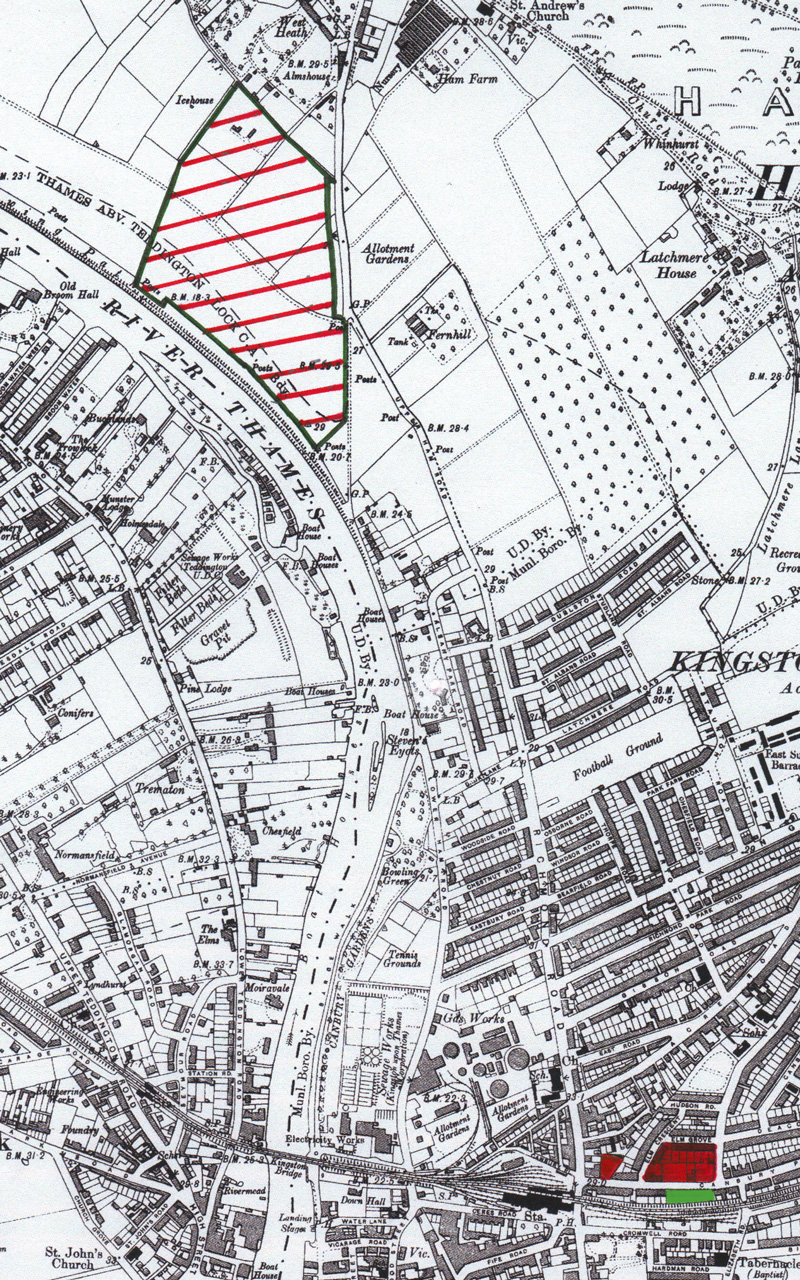
Co-incident with the news that they can lease National Aircraft Factory No.2 at Ham once it is built, Sopwith Aviation have submitted to Kingston Council a revised plan for the building on the south side of Canbury Park Road backing onto the railway line. (marked in green on the map) It is still to be a timber store at ground level but now stretches over the plots of eleven more recently purchased cottages. It is a substantial building with an upper floor devoted to a large central kitchen and four “Dining Rooms” for men, foremen, women and forewomen. The men and women have separate entrance doors and staircases.
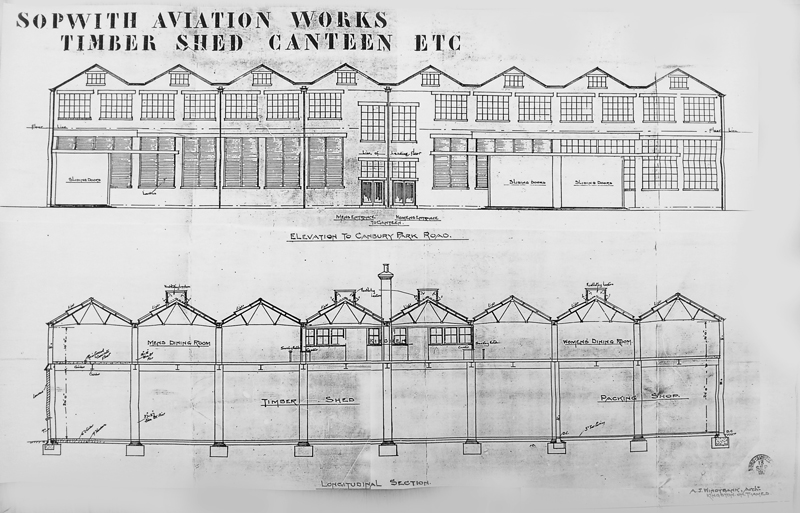
Meanwhile on 13th September at Brooklands the prototype Sopwith ‘3F2 Hippo’ makes its first flight powered by the new 200hp Clerget rotary engine. Thomas Sopwith is pictured sitting in the cockpit (below) but he claims to have stopped flying by the start of the war so the pilot on this first flight is almost certainly Harry Hawker. Note the high set positions of the pilot and observer/gunner fore and aft of the top wing spars and the extreme back-stagger of the wings and their interplane struts to achieve the correct balance.
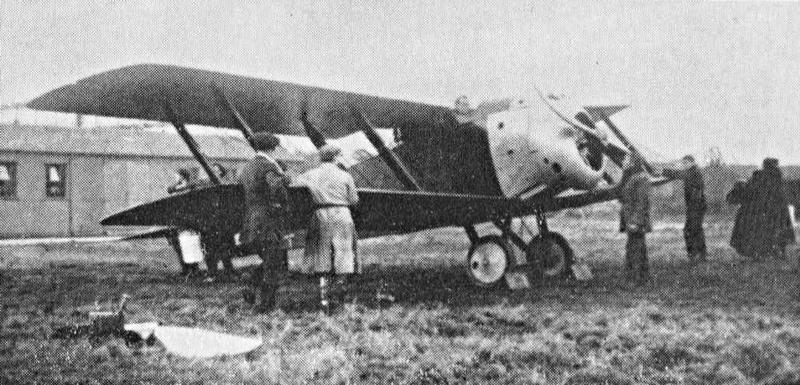
On 13th September both crew are killed on a photographic mission when ‘Strutter’ A8325 is hit by AA fire. The pilots of ‘Pups’ B1800 & B2161 are killed in combat. ‘Triplane’ N5429 is shot down and the wounded pilot taken prisoner. (photo below) The pilot of ‘Camel’ B3933 is wounded in action and taken prisoner whilst the pilot of B2352 is injured side-slipping on landing.
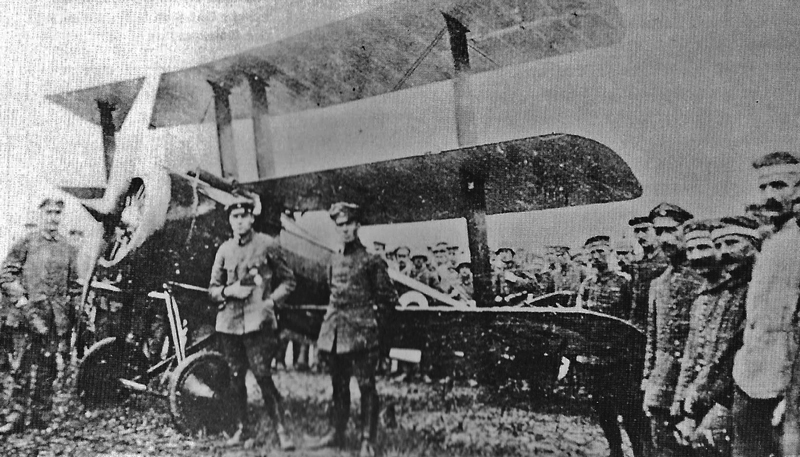
On 14th September the pilot is killed when ‘Strutter’ N5508 nose-dives in from a great height whilst the pilot of A8234 is wounded by shrapnel from an AA shell and wrecks the machine hitting a shell hole in the forced landing. ‘Camel’ B2327 claims a victory, B3898 shares a victory with two others, B2333 is hit in the fuel tank and the Indian pilot taken prisoner whilst B3829 is shot up and forced to land. At home, ‘Camel’ B2344 crashes en-route to Farnborough after repairs at Lincoln and ‘Baby’ floatplanes 8208 & 8212 are deleted after two months and ten months in service at Calshot. RNAS Grain ‘Strutter’ 9377 fitted with hydrovanes lands in Sheerness harbour, the second successful such test in five days.
Erroll Suvo Chunder Sen the Indian pilot of ‘Camel’ B2333 referred to above, was educated at the Rossall School in Lancashire where he joined the Officer Training Corps. This April at eighteen years of age he was awarded an RFC commission as a Temporary Honorary Second Lieutenant. He has spent two months at the School of Military Aeronautics at Reading followed by 25 hours of elementary flying training and 35 hours in front line aircraft before his posting to the Western Front. Today with a poor engine he is attacked when lagging behind the rest of his Offensive Patrol, is forced to land on German territory and is taken prisoner. His mother lives in Surbiton, Surrey.
On 15th September, the pilot of ‘Pup’ A638 is killed when the port wing breaks off at 900ft. ‘Camel’ B3833 claims a Fokker Triplane, B2345 B3880 B3893 N6356 & N6359 each claim a victory, B2341 claims a victory before another pilot takes it up and breaks a leg crashing after combat, B3793 shares a seaplane off Nieuport with B3794, the pilots of B2343 & B6250 are both wounded in action and taken prisoner whilst B2316 crashes on take-off
On Saturday 15th September, there is a Sopwith Aviation Workers’ Sports Day at the Old Kingstonian’s Sports Ground in Norbiton in aid of the Flying Services Fund. Over 3,000 turn out to watch what becomes a long day of sport with so many entries and elimination heats. There are races for ladies, veterans and boys and against other local munitions workers, a one-mile relay against teams from Vickers and Napier plus handicapped races against county and international champions. The 100 yards final is a dead heat between Club Secretary Vic Derrington and Jack Whitehorn, the Skating Rink door boy taken on by Sopwith when they leased it in 1912. Sopwith men’s Tug of War team beat Napier’s in the final and Sopwith ladies beat Bleriot ladies from Addlestone. There is “catch as catch can” wrestling, a “Chariot Race” with blindfolded runners guided by a “coachman”, apple bobbing and a hairdressing competition in which “the mere male has to undo his fair partner’s hair and re-dress it in five minutes”. The Sopwith Orchestra provides music for the dancing which followed well into the evening.
On 16th September, ‘Strutter’ A1042 is wrecked in a crash landing. The pilot of ‘Pup’ A673 is taken prisoner after being shot down. ‘Camel’ B3808 claims a victory and possibly two, B3883 shares a victory with B3892 & B3905 whilst B3753 & B3836 are shot down and the pilots taken prisoner.
On 17th September, ‘Camel’ B2322 collides with B3839 on take-off and B2372 is wrecked arriving in France.
On 18th September, ‘Strutter’ 9893 crashes at Cranwell. ‘Pup’ B1841 crashes on landing injuring the pilot, the pilot of ‘Triplane’ N5493 is killed in a mid-air collision with an RFC SPAD and ‘Camel’ B2338 crashes on landing.
On 19th September, in preparation for the major third offensive at Ypres both crew of ‘Strutter’ B2571 are killed in action when it is hit by an A shell. ‘Triplanes’ N5454 & N6299 claim a victory, as does N5490 but is hit and the pilot taken prisoner after a forced landing, N5459 shares one with N6292 whilst the pilot of N5446 is wounded in combat. ‘Camels’ B3871 & B3833 each claim a victory, N6374 is shot down in flames and the pilot posted missing whilst B2329 & B2371 crash on landing in the strong winds. At Turnhouse, the pilot of ‘Pup’ B2247 is killed when it loses its propeller on a training flight and spirals in.
On 19th September the Ministry of Munitions and Dick, Kerr & Co. negotiate a contract which is confirmed in a letter from the Director of Factory Construction on 20th September. Dick, Kerr are to make all drawings, to order and check all materials, engage labour, provide expert supervision and make no charge for these services except for the wages of staff actually employed on the job and office staff travelling expenses. They are to provide all heavy plant, small tools, scaffolding and stores required charged at prime cost and passing on the benefits of trade, customary and cash discounts. They are to insure all workmen. The letter goes on: “You agree to proceed immediately to erect and equip the factory shown on the drawings, with water supply, sewage disposal, electric lighting and power supply, heating and ventilation and the formation of an aerodrome with the best materials and workmanship that can be procured to the Ministry’s satisfaction under the direction and control of a representative on site and to use the utmost diligence and despatch and to do your utmost to complete the work within the space of 20 weeks from the date hereof”. Arrangements for certification of work and payment terms are defined with “correction of work found to be defective at your own expense”. “On satisfactory completion the Ministry will pay you a profit of 2½% on the net prime cost of the works.”
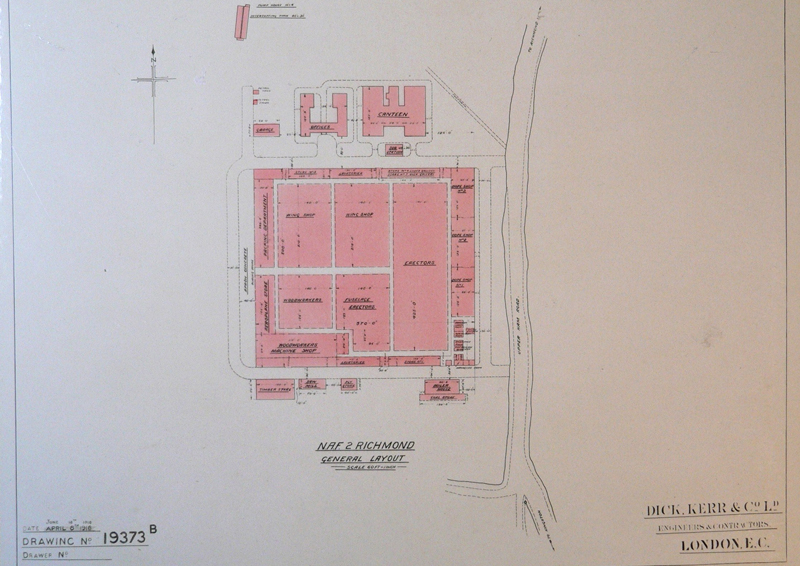
The drawing (above)shows a main factory building covering 8 acres on the north-east corner of the site, as far as possible from the River Thames. It has a separate canteen and office buildings and a boiler house for the steam heating. Dick, Kerr have recently designed and quantity surveyed a 30ft to the eaves final assembly shed for ‘Felixstowe F3’ flying boats at their newly acquires United Electric Car Co. factory in Preston. To proceed immediately with material ordering and site layout at Ham they have decided to replicate that structure end-on-end and in six side-by-side bays to create a single huge open-plan workshop.
On 20th September ‘Pup’ A6183 strafing enemy troops at low level in bad weather is hit by ground fire and the pilot is taken prisoner. The pilot of ‘Triplane’ N6292 is killed in combat, N5459 is also shot down and the pilot taken prisoner whilst N6303 forced lands with engine failure. ‘Camels’ B2327, B3791, B3871 & B3903 each claim a victory whist B3950 forces a two-seater down onto the ground and then strafes it with machine gun fire. The pilot of ‘Camel’ B6205 is killed in combat, B3906 & B6226 are shot down with wounded pilots, the pilot of B2342 is wounded in the thigh by AA fire, B2359 is also damaged by AA fire whilst B2314 crashes on landing.
On 20th September there is a meeting of the creditors of Whitehead Aircraft Ltd of Richmond upon Thames to agree the liquidation of the company and transferring its undertaking to Whitehead Aircraft (1917) Limited, which is being formed with new investors and a Share and Debenture Capital of £1,250,000 “to meet the great expansion of its business. Business will carry on as usual and creditors will be taken over by the new Company”.
On 21st September ‘Pups’ A6241, A7330 & B1828 each claim a victory, B1777 shares one with two others, the pilot of A7321 is killed in combat whilst the wounded pilot of A6188 is further injured in a crash. ‘Camel’ B3871 claims two victories, B3788 & B3791 each claim a victory, B3818 shares a victory, B3914 is hit in the fuel tank and the pilot taken prisoner, B3833 crashes damaged by gunfire, the pilot of B2345 sideslips banking on take-off and is seriously injured crashing through a hanger, B2347 crashes on take-off, B3875 crash lands as does B2320 with an engine failure. French ‘Triplane’ F13/N5838/SP13 claims an Albatros D. It is pictured (below) with F16 which has a disc behind the propeller to help adjust the gun synchronising gear.
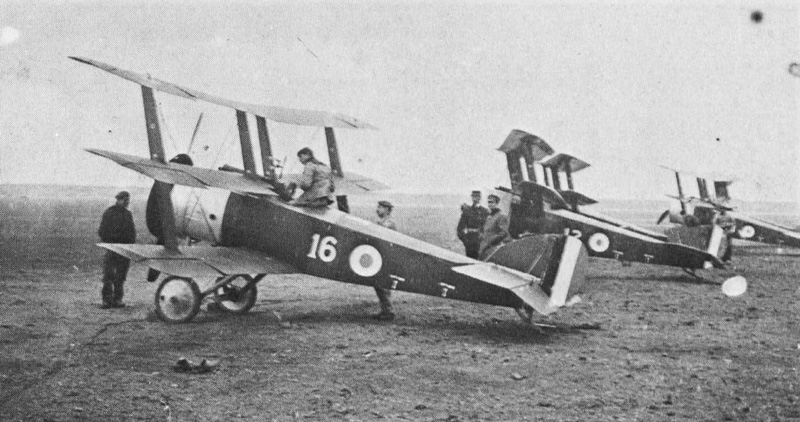
On 22nd September ‘Pup’ A7324 shares a victory as does A7335 whilst B1782 collides with B1834 during an air battle, one pilot being killed and the other taken prisoner. ‘Camel’ B2376 is badly shot up, B2328 crashes on take-off. Three ‘Camels’ escort DH4’s directing HMS Terror’s shelling of Ostend, B6213 shares a seaplane downed which is captured before the other two ‘Camels’ force down two of a further seven seaplanes sent out. Ostend docks are considerably damaged. At Croydon the trainee pilot of ‘Camel’ B6292 is killed in a spinning nose dive from 3,000ft. At Martlesham Heath they fly ‘Camels’ B3751 & B3835 with the longer-stroke, higher-compression 140hp Clerget rotary engines which “run as sweetly as a Bentley”. Developed by Gwynnes (below) these Clerget 9Bf engines are Ruston Proctor built.
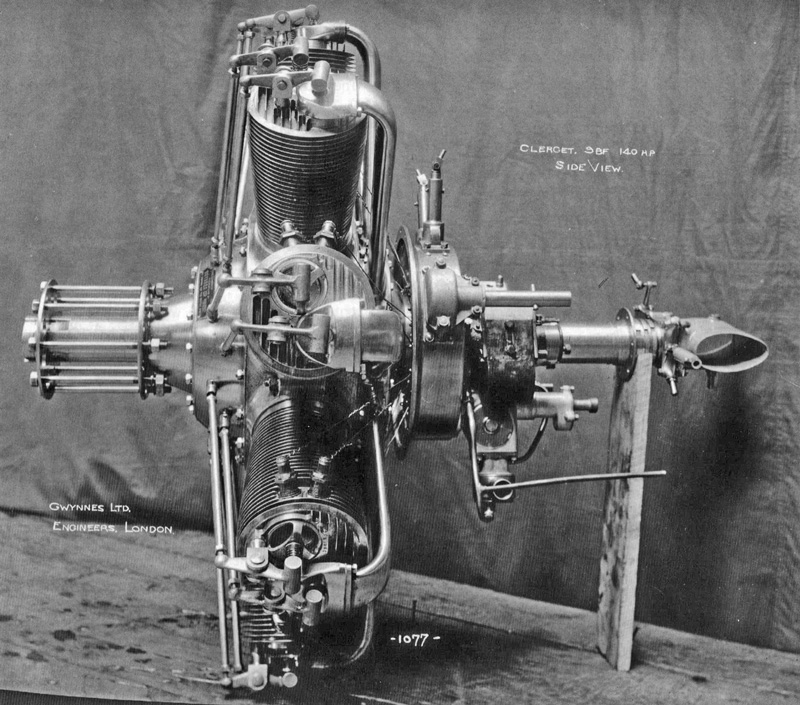
On 23rd September the pilot of 43 Sqdn ‘Strutter’ A8785 going out on Line Patrol loses control on take-off and crashes. ‘Pup’ B1760 crashes from a test flight. ‘Camels’ B3910, N6341 & N6377 each claim a victory, the pilot of B3894 is wounded in combat, B3895 suffers a forced landing and B3912 crashes.
On 23rd September the Dutch Luchtvaart Afdeling purchases ‘Pup’ N6164 and ‘Strutter’ 9376 which they had interned back in the spring, for £1,700 each. The Admiralty have made a good deal, the official listed price for a ‘Pup’ airframe is £711 and its 80hp Le Rhône engine £620. N6164 becomes LA41 and 9376 becomes LAS-42.
On 24th September ‘Pup’ B1792 claims a victory, B1802 shares one with three others, the pilot of B1826 is killed in combat, A6181 shot up is wrecked overturning on landing injuring the pilot. ‘Camels’ B3898 & N6370 each claim two victories, B3883 claims a possible one and shares another, B2305 & N6359 each claim one, B3889 & B2358 each share one, B6279 is shot down and the pilot taken prisoner, pilot of N6343 is hit in the thigh, B2361 is shot down, B3853 is hit by 114 bullets, B3843 gets a bullet through the propeller whilst B3907 crash lands.
In the evening three Gotha’s bomb London, another ten scattering bombs around the Thames estuary. Two hours later five or more Zeppelin airships head for the Midlands and the North East but cause little damage. Meanwhile with the aid of parachute flares German bombers attack the RNAS depot at St Pol, Dunkirk. Crucially they set the engine repair shop on fire with an incendiary bomb and hit the pump-house stopping the water supply for the fire hoses. A thousand men save material from adjacent buildings but the engine repair shop, saw-mill, machine-shop, spare engine shop and packing shed are destroyed as are the drawings and records offices. 140 engines are lost including 83 130hp and 10 110hp Clergets, 37 80hp Le Rhônes and 5 150hp Bentley BR1s.
On 25th September ‘Pups’ A6211 & A6238 each claim a victory, A6203 a possible one, B1827 shares one with two others but the pilot of 9927 is lost at sea chasing a Zeppelin airship and B1776 is shot up and wrecked in a crash. ‘Triplane’ N5446 crashes on take-off. ‘Camel’ B2374 claims a victory, B2358 shares one, the pilot of B3920 is injured and makes a crash landing and B3843 gets a bullet through the propeller. N6348 downs a seaplane as does B6240 but is hit in the fuel tank and forced to land at sea to be rescued by a destroyer. At home ‘Pup’ B1839 collapses its undercarriage in a heavy landing at Sedgeford and flips onto its back.(below)
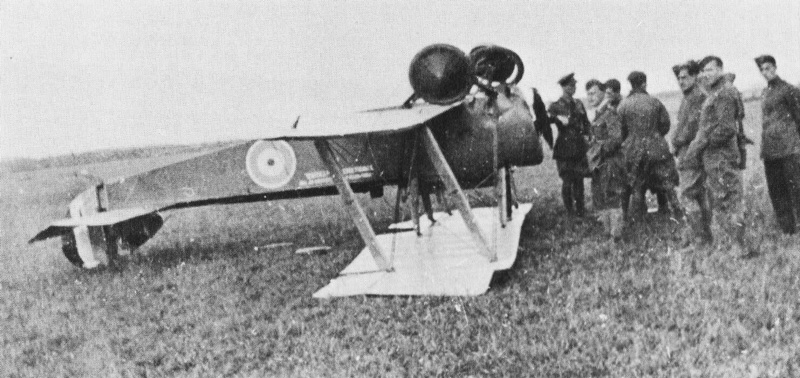
For the second night running three Gotha’s bomb London the other eleven returning after bombing coastal towns. The only interception is by Suttons Farm ‘Strutter’ A1040 which follows a Gotha for 15 minutes firing bursts from its Vickers gun and possibly hits a fuel tank as a Gotha is later reported missing over the North Sea. This may be the home defence force’s first night victory. ‘Strutter’ A1051 crash lands at Suttons Farm in the mist.
On 26th September ‘Pup’ A6242 crash lands with engine troubles. The French pilot of loaned RNAS ‘Triplane’ N5388 is killed in combat as is the pilot of N5440 whilst the pilot of N5421 is wounded and taken prisoner. ‘Camels’ B2327 & B2350 each claim a victory, N6359 claims a victory but is forced to land with AA damage, the pilots of B2358 & B2374 are killed in combat, the pilots of B3915, B5151, B6258 & B6275 are shot down and taken prisoner, B2263 is damaged by AA fire, B6237 is badly shot up and B2321 forced lands with engine failure.
On 26th September as the second ‘Dolphin’ is returned to Kingston from Martlesham Heath, the third ‘Dolphin’ is at Brooklands on company trials but is suffering magneto and engine problems. It is almost identical to the modified second machine except it has exhaust pipes, no cut-outs in the lower wings and provision for two upward firing Lewis guns mounted on the front tube of the top-wing interplane frame.
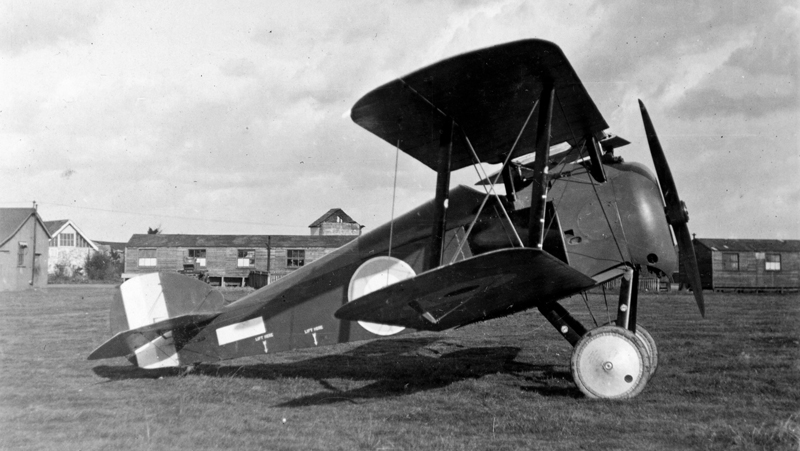
Sopwith’s design and experimental build team continue to produce new prototypes. The latest to fly at Brooklands (above and below) could be an ’F1’Camel’ at a first glance with its cowled 150hp Bentley BR1 engine and single-bay wing. Closer study reveals that this ‘7F1 Snipe’ also owes much to the ‘5F1 Dolphin’ and ‘3F2 Hippo’ it has now joined at Brooklands with a lowered upper wing and much deeper fuselage allowing the pilot sit up high with clear vision over the wing and through the tubular steel frame which replaces a solid wing centre section. It retains the Camel’s twin Vickers gun arrangement and forward stagger but both wings now have dihedral. The team are building two more experimental ‘7F1s’, one to accommodate the highly promising 230hp Bentley BR2 engine.
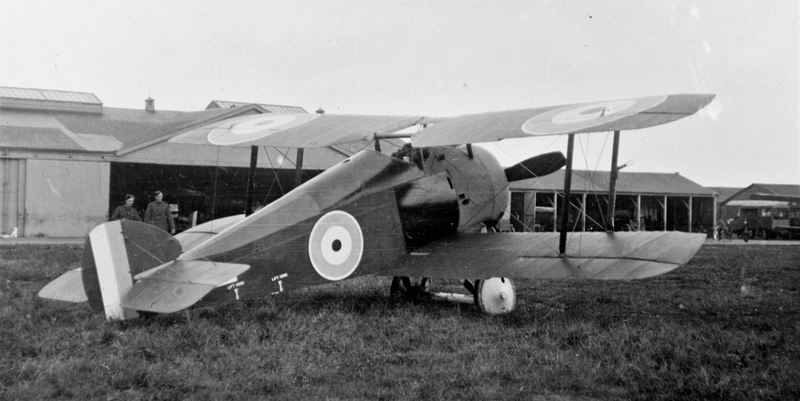
On 27th September ‘Camels’ B6227 & N6330 each claim a victory, the pilot of N6355 is killed in action as are the pilots of B3867 and B3934 when they collide at 15,000ft and fall into the sea locked together whilst B3926 crashes at Manston. Fairey ‘Hamble Baby’ N1453 (below) with a synchronised Lewis gun, full span flaps and distinctive Fairey fin shape has been wrecked and deleted from service after just three days at Calshot.
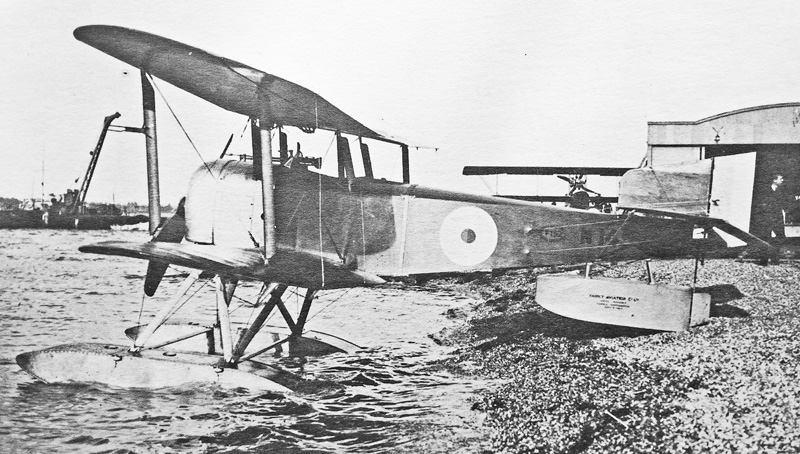
The German bombing of RNAS St Pol airfield is itself being retaliated by RNAS bombing of German airfields including today an apparently successful one on the Gotha bomber base at St Denis Westrem.
On 28th September ‘Camels’ B2368 & B3882 each claim a victory as does B2366 but is shot up and forced lands, B3818 shares a victory with four others, the pilot of B6209 is killed in combat whilst B6343’s is killed flying into the ground in a dive near Wantage and B2387 is wrecked on take-off. 44 Sqdn ‘Camels’ from Hainault now routinely fly at night to intercept German bombers but tonight’s raid is rendered ineffective by the weather.
On 29th September A6904 is one of the ‘Strutter bombers’ joining 20 (Australian) Training Squadron at Ternhill. ‘Pups’ A6228 & B1837 crash on landing whilst N6179 is Gotha damaged and forced to land, After very thick mist restricted flying all day ‘Camel’ B3921 by moonlight sets light to a shed containing an enemy observation Kite Balloon whilst B3922 is damaged landing. ‘Baby’ floatplane N1111 is completely wrecked at Seaton Carew. Overnight four Gotha bombers and three new four-engined Zeppelin Staaken R VI Giant bombers reach London killing 40 people and injuring 87, with some airfields fog bound only one Gotha was downed probably by AA guns.
The third prototype ‘F1 Camel’ which has had a 110hp Le Rhône engine in place of its Clerget since June is now flying at Martlesham Heath with the cockpit set back behind the wing and the fuel tank brought in front of it. This way to improve the pilot’s field of view is already being used by some 78(HD)Squadron ‘Comic Strutters’ and the arrival of their B762 at Martlesham in August may have been the inspiration for this ‘Comic Camel’.
In the Sopwith factory in Kingston on Saturday afternoon 29th September 51-year-old general labourer Samuel Grey is found dead in a gas filled testing room apparently having gone to sleep and fallen onto a gas tap.
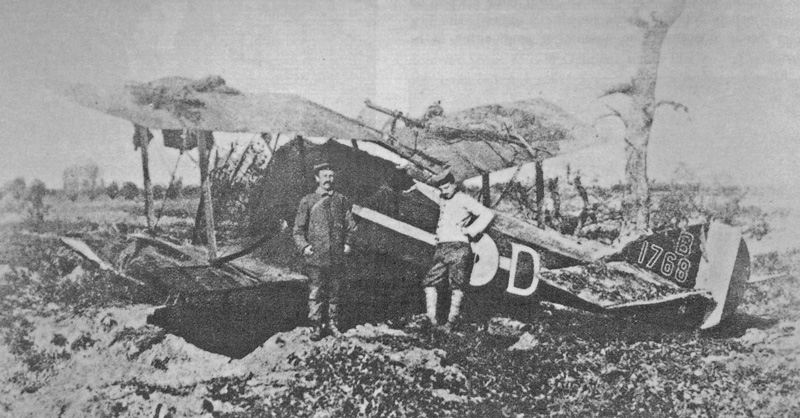
On 30th September ‘Strutter’ B2593 forced lands at North Benfleet. ‘Pup’ B2191 claims two victories, B1117 claims one as do B2162 and B2168 but then crash land, the pilot of B2185 is killed in combat, the pilot of B1802 dies of combat wounds whilst the pilot of unusual two-gun B1768 is taken prisoner after spinning down from combat with considerable damage. (above) Several RFC and RNAS ‘Pups’ have unofficially had a top wing Lewis gun added which does not have the rate of fire reduced by the synchronising gear. Earlier this month 66Sqdn gained official approval to fit a second gun to their ‘Pups’ with the proviso that “the work must be done by the Squadron and not when machines are likely to be required”. B1768 is one of those already modified but it clearly has not saved it. ‘Triplane’ N5431 shoots an Albatros into the sea near Lemnos in the Aegean whilst the pilot of N5466 is killed when a wing comes off during a practice flight. ‘Camel’ N3841 claims a victory, B3883 shares one with four others, the pilot of B2398 is killed in combat whilst B6283 is wrecked being hit by B2377 on landing. For the third night running German bombers attack London killing 14 and injuring 38. ‘Strutters’ and ‘Camels’ are among the 37 Home Defence aircraft which go up after them but none get close enough to do significant damage.
The Sopwith factory’s output in September has been a record 123 ‘F1 Camels’. With only 100 more ‘F1 Camels’ on order they are starting to build their 50 ”2F1 Ships Camels’ and are already well advanced with batches of components for the first of their 500 ‘5F1 Dolphins’ due for delivery in November.
The total of new Sopwith designed aircraft from all suppliers in September is a record 397, 399 if Sopwith Beardmore ‘SBIIIs’ are included. The 276 machines from other manufacturers are 42 ‘Strutters’ from Hooper (13) and Morgan (29); a record 95 ‘Pups’ from Standard Motors (46) and Whitehead (49); 2 ‘SBIII folding Pups’ from Beardmore; a record 95 ‘Camels’ from Clayton and Shuttleworth (17), Portholme (5), Ruston Proctor (62) plus two new manufacturers Boulton & Paul (10) and Hooper (1) plus 13 ‘Baby’ floatplanes from Blackburn and 29 ‘Fairey Hamble Baby’ floatplanes from Fairey (22) and Parnall (7). These figures again exclude ‘Strutters’ being built in Russia and the hundreds which are now pouring out of ten different French factories every month.
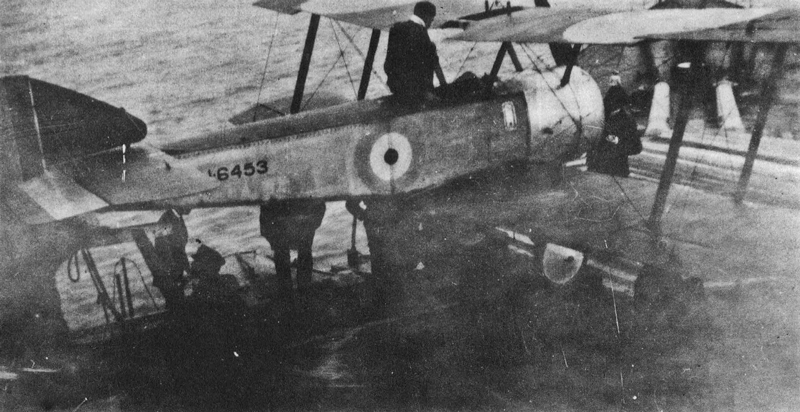
On 1st October Fl Cdr Rutland climbs aboard ‘Pup’ N6453 which sits tail-high on a short wooden ramp built on the B gun turret of battle cruiser HMS Repulse.(above) The ship is steaming at 24 knots and the 17mph wind is from 80 degrees to starboard. Guided by a flag and a “hollow bunting windvane” he has the turret turned 42 degrees to starboard into the 31½mph “felt wind” and takes off with 6 feet of ramp to spare.(below) He has proved that simply by turning a gun turret and its platform into wind, large capital ships can launch their own fighter defence against enemy airships and aircraft whilst maintaining their course and position in the battle line.
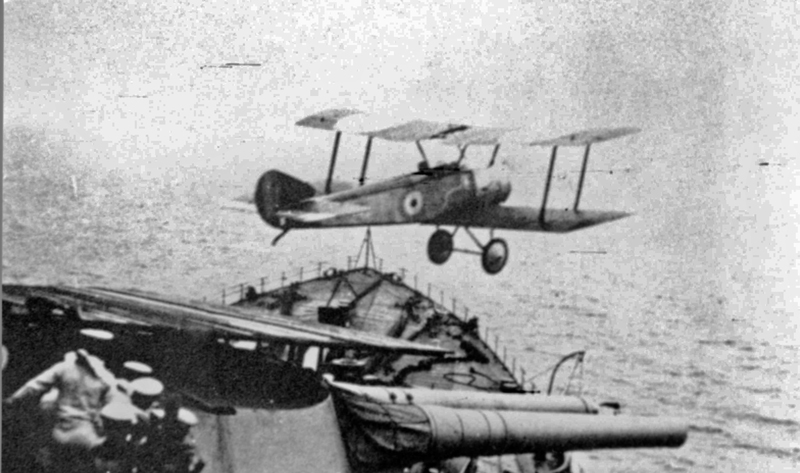
On 1st October ‘Strutter’ A1051 crashes as do ‘Pups’ B2189 & B5914 in forced landings. ‘Camels’ B2323, B2375, B3795, B3856, B6244 & B6366 each claim a victory, whilst B3903 shares one. Overnight the Germans bomb the RNAS Depot and airfield at St Pol with devastating effect destroying a bomb store, another 200 engines and an estimated 150 aircraft. Amongst those destroyed by fire or bombs are at least two ‘Strutters’, nine ‘Triplanes’ and twelve ‘Camels’ with two more ‘Triplanes’ damaged. For the fourth night German bombers attack London, 12 Gothas killing 11 and injuring 42, the weather is marginal at most airfields and no interceptions are made.
On 2nd October ‘Strutter’ 9894 crashes. ‘Camels’ B2818 & B3898 each share a victory whilst B3789 crashes and ‘Baby’ floatplane N1037 makes a forced landing at Hornsea.
The total number of new aircraft built in the Sopwith Works in Kingston during their 12 month financial year to the end of September was some 720, more than doubling the 338 built in 1915/16 which itself more than doubled the 164 in the 1914/1915 financial year. With more higher value aircraft, sales income has been increased this year by a remarkable 250% to around £I,100,000. There should once again be more than enough profits to self-finance their innovative private-venture prototypes and the expansion of plant and facilities in Kingston, even if some of the profit is subject to the Treasury’s 60% excess-profits tax.
Since he crashed the only Sopwith ‘Triplane’ N5431 in the Aegean, Fl Lt John Alcock has been building a hybrid aircraft of his own design from salvaged Triplane and Pup spare parts. His Sopwith Mouse/Alcock A1 Scout is almost ready for its first flight when it is confirmed that he was taken prisoner by the Turks on 30th September.
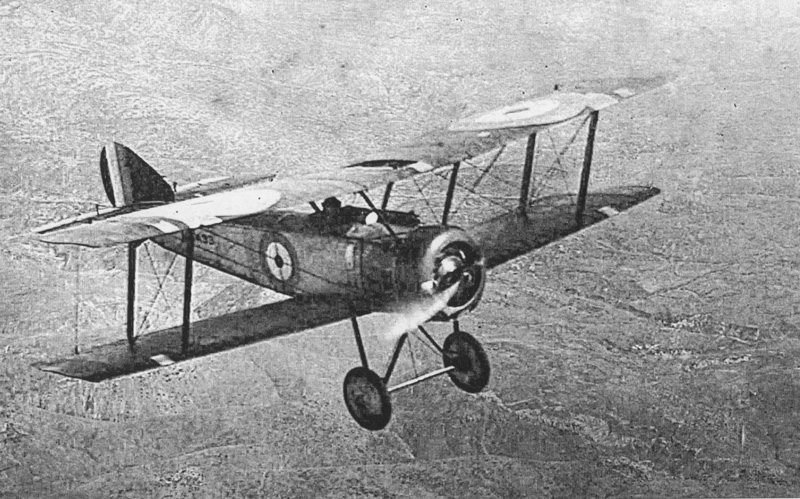
Whilst Beardmore-built ‘Pup’ N6433 is photographed (above) from another machine at 12,000ft over Bulgarian territory, the first ‘Camels’ (including B3769 below) have arrived in the Aegean to supplement their few ‘Pups’ intercepting enemy aircraft and escorting ‘Strutters’ on bombing and photo reconnaissance missions.
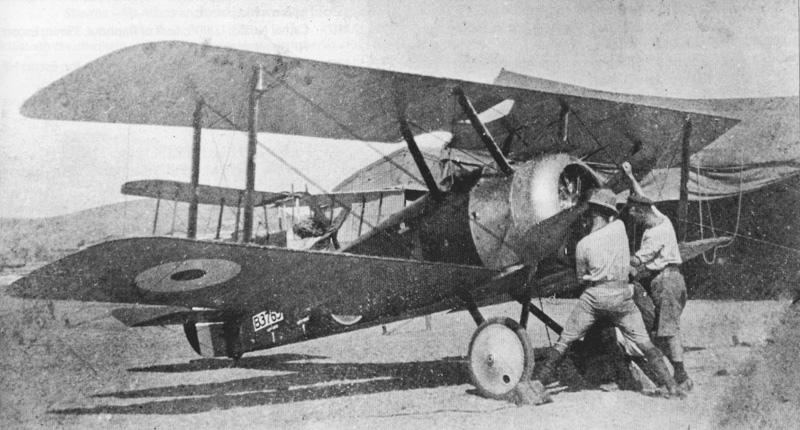
The Inquest jury returns a verdict of accidental death on the Sopwith labourer Samuel Grey after hearing that he had been joking with colleagues and the fanlights were open in the testing room when he was found asphyxiated slumped against an open gas tap. He often worked as late as 9pm on Saturdays cleaning after the Works closed.
The RFC report that weather in France on 3rd & 4th October is “very bad indeed”. In England, the pilot of ‘Camel’ B2339 from 73 Training Squadron at Turnhouse dies of his injuries after losing control and diving in.
‘Pups’ and ‘Triplanes’ are rapidly being replaced by ‘Camels’ on the Western Front but many ‘Pups’ are still with Home Defence Squadrons whilst more and more are joining training units including the new School of Special Flying at Gosport where their agility and viceless handling are in great demand. A group of ‘Pups’ from Gosport has recently been photographed paying a visit to Beaulieu along with a ‘Camel’.(below)

Amongst them is B2192 with its unique black and white striped paint scheme. It is one of the first Whitehead built machines with the 100hp Monosoupape Gnome engine revealed by the cut-away lower cowling.
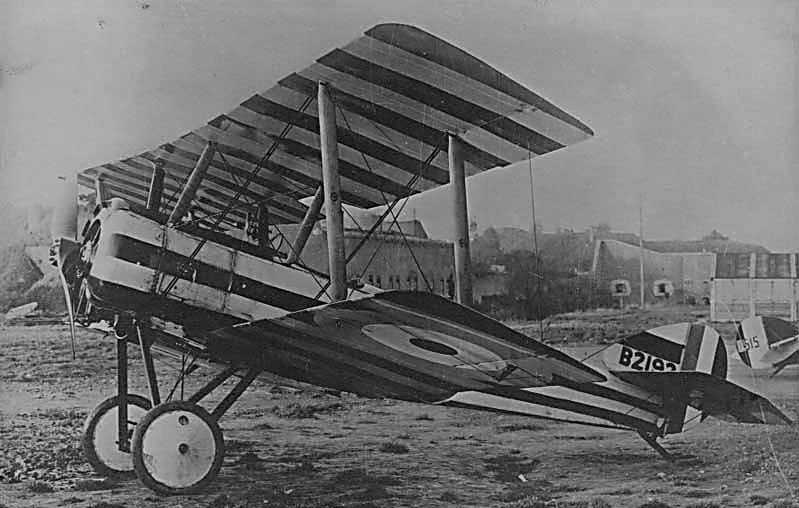
An unusual example of ‘Pups’ in training units is B1720 which has been with the new Wireless and Observers School at Brooklands for the last six weeks despite being unable to carry a wireless or an observer.
Flight journal reports that another aircraft manufacturing company has sprung up at Sunbury along the Thames between Kingston and Brooklands. “Scientist, engineer, metallurgist and author Sherard Cowper-Coles who’s father invented the armoured turret for battleships, has set up the Cowper-Coles Aircraft Co with the purpose of building an aeroplane composed entirely of metal. His ‘Sherardising’ process incorporating zinc into metal surfaces for rustproofing should be of great value in seaplane work.” Currently building conventional aircraft wings in a small workshop he has acquired a large house “with 370 ft frontage onto a backwater of the Thames where he will be erecting seaplane sheds, wharfage, landing stages and warehousing”.
On 5th October ‘Pup’ N6470 lands on its nose at Marsh Aerodrome in the Aegean. Over France ‘Triplane’ N5377 is shot down and the pilot taken prisoner. The pilot of ‘Camel’ B2397 is killed when he is hit by a French SPAD east of Ypres and submerged in mud and water, B3840’s pilot is injured overturning on landing at a new airfield at Warloy whilst B3871 also crash lands.
On 6th October at Rochford the pilot of ‘Pup’ A653 is concussed after colliding with an Avro 504 at low altitude.
On 7th October the pilot of ‘Pup’ B1835 is wounded and crash lands. The weather remains very poor in France.
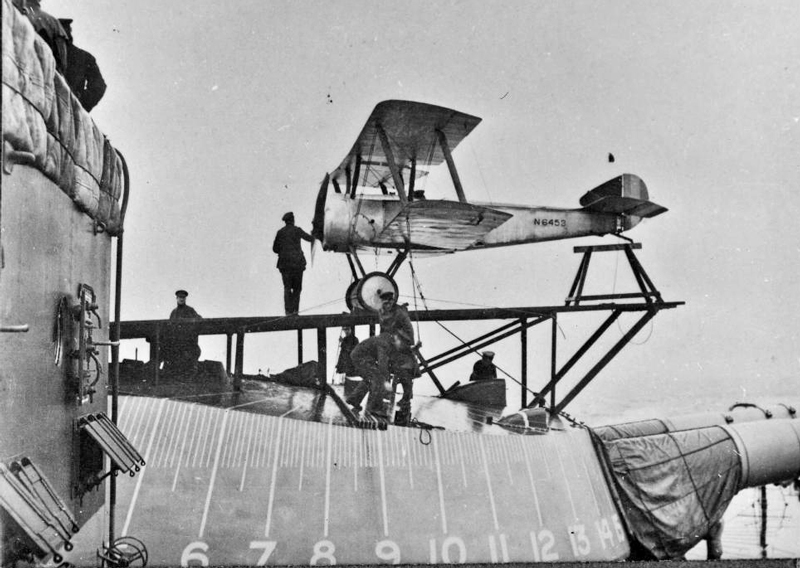
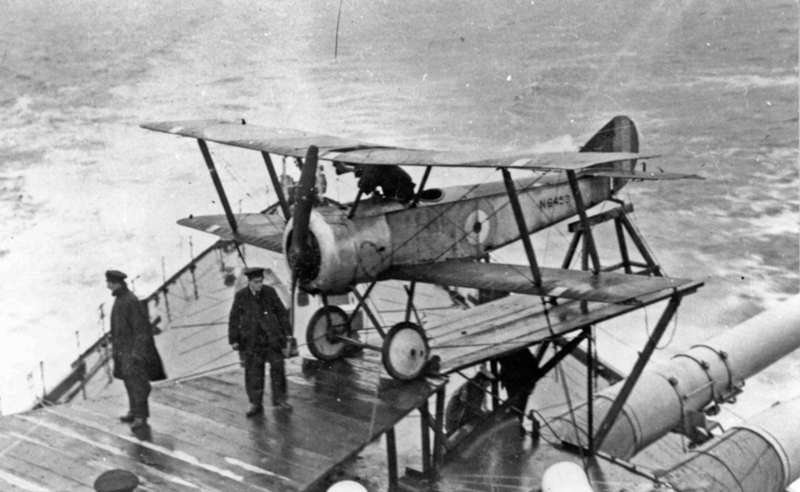
On 8th October Fl Cdr Rutland makes another successful experimental flight with ‘Pup’ N6453 from battle cruiser HMS Repulse this time from a short wooden ramp built on the Y gun turret at the stern of the ship. To launch into the “felt wind” with the minimum turret rotation this ramp runs not over the gun barrels but off the back of the turret. The photographs illustrate the process for short ramp launches which has been developed on the fixed ramps of ships like HMS Campania. A ball fitting on the end of the aircraft’s tailskid is located in a groove in the tail guide trestle which helps counteract the torque of the rotary engine and provides directional stability until there is enough airflow for the rudder to become effective. Whilst the engine is run up to full power the aircraft is held back by a quick release strop which comes up from the deck to a wire between the rear undercarriage struts. Its slip hook is released by a sharp pull on a lanyard on a signal by the pilot.
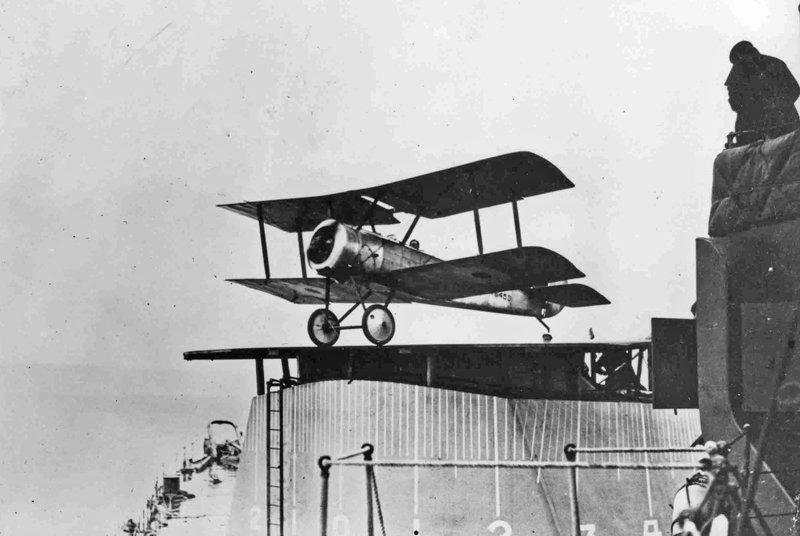
The Admiralty are impressed with this simple low-cost solution to defending the fleet against aerial attack and are considering a proposal that all light cruisers and battle cruisers should carry fighting aeroplanes “providing their gun armament is not interfered with”.
On 9th October & 10th October the bad weather continues to severely restrict flying in France. ‘Pup’ N5181 crashes at Manston whilst at East Fortune ‘SBIII’ N6101 breaks its folding undercarriage on landing.
The three RFC ‘Strutter’ squadrons in France (43, 45 & 70) have all now been fully re-equipped with ‘Camels’. Whilst performing invaluable reconnaissance, photography and bombing missions in their thirty-five operational squadron-months they have destroyed 41 enemy aircraft. French ‘Strutters’ are however still entering front-line operational service in large numbers. There are now well over 400 French-built machines operational in at least twent-two escadrilles.

This week French bomber escadrilles SOP 66 & SOP 111 (with their Swan motif and camouflaged rear fuselage and wings above) have had their single-seat Sopwith ‘1B1 Strutters’ replaced by Breguet 14 bombers. With 330lbs of bombs from their four place internal racks (below) they have been very active since April on daylight and night bombing of German installations including railway stations, army camps and Frankfurt.
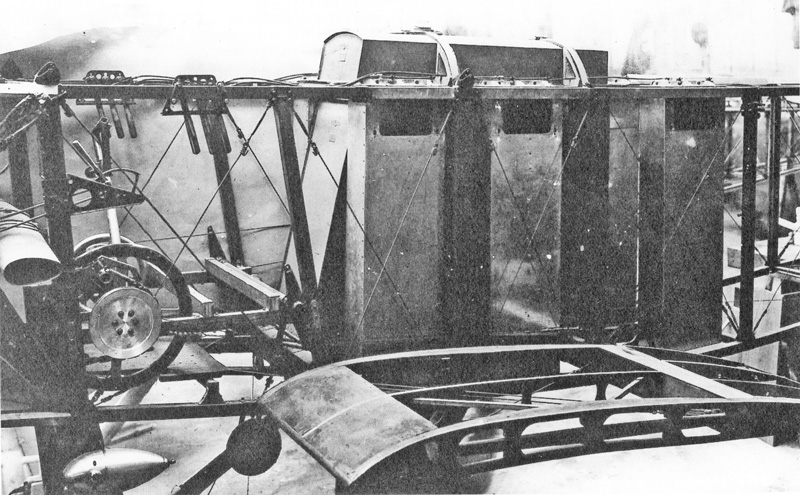
Nine other Sopwith ‘1B1’ bomber escadrilles with their ‘1B2’ two-seaters as escort fighters remain active whilst the number of army reconnaissance and artillery co-operation escadrilles in action with ‘Sopwith ‘1A2’ two-seaters is still growing. French-built ‘Strutters’ have more powerful 135 & 145hp Clerget and 135hp Le Rhône engines than even the upgraded British machines and some have smaller tailplanes which gives an additional 6mph and faster climb rates at lower altitudes but reduced performance above 7,000 ft.
On 11th October ‘Pup’ 9949 with a skid undercarriage is used to make experimental landing approaches to the foredeck of HMS Furious but actual landings are still banned following Dunning’s fatal accident.
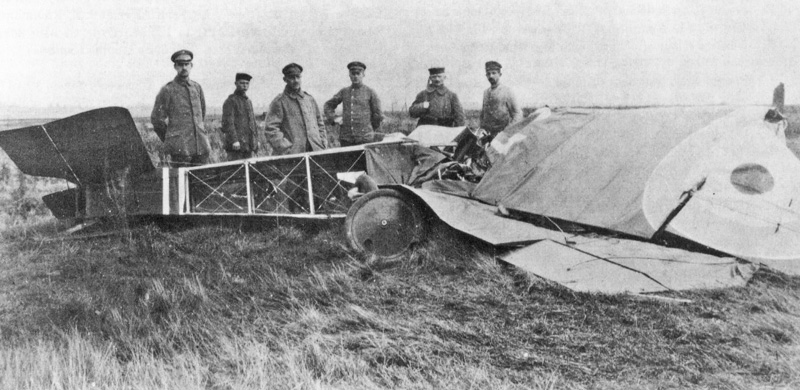
On 11th October American 2nd Lt A A Allen is shot down and killed flying RFC 46Sqdn ‘Pup’ B2180(above) whilst B1733 swerves on take-off wrecking the undercarriage and lower wings. The pilot of ‘Camel’ N6358 is shot down and dies of his wounds, the pilot of B6314 with a failed fuel tank strays over the lines in mist and is taken prisoner after being hit at 6,000ft by AA fire whilst B2395 is badly damaged crashing on take-off after an engine failure.
On 12th October there is massive aerial support for the latest ground offensive in the Ypres campaign but with continuing bad weather and heavy rain the attack is halted by mid-afternoon with troops bogged down in the flooded valleys. The pilot of ‘Pup’ B1836 is killed in combat, the pilot B1830 gets lost and is taken prisoner after forced landing east of the lines. The same happens to the pilot of A635 which is photographed by its captors intact displaying the latest 66Sqdn markings.(below) Meanwhile B1798 is badly shot up and B5911 crashes just outside the airfield with a choked engine. ‘Camels’ B2318, B2350 & B6206 each claim a victory but the pilots of B2375 & B2386 are killed in combat and B3918 crashes on take-off, spinning around and overturning. At home the pilot of 78(HD)Sqdn ‘Strutter’ A8249 is killed stalling on take-off on a practice flight from Sutton’s Farm.
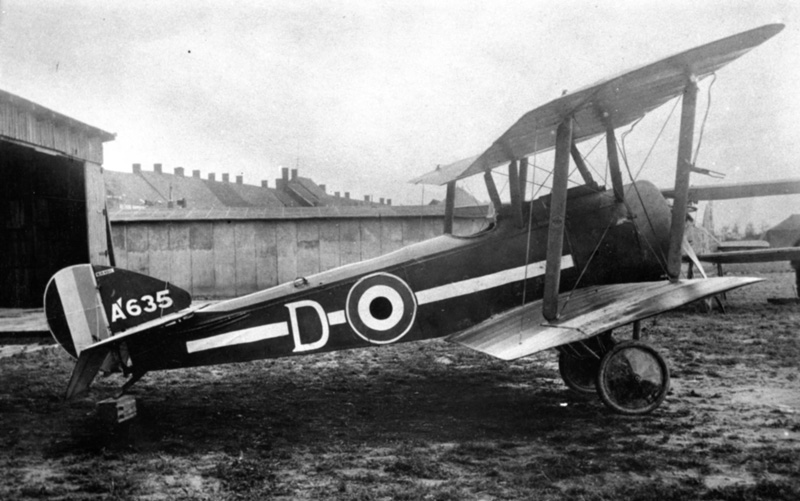
During the desperate situation on the Western Front ‘Camels’ are being used extensively in highly dangerous low-level ground strafing and bombing missions fitted with racks for four 20/25lb Cooper bombs. Now even ‘Pups’ have become bombers. Last week 66Sqdn ‘Pups’ were sent out at dusk carrying 25lb bombs to attack German airfields and claim to have set a hangar on fire. Now 54Sqdn machines are having bomb racks fitted to drop twenty-pounders over the lines “to annoy brother Boche as much as possible”. With no bomb sights and usually crossing the lines at 10,000ft this is a fairly random exercise: “We get rid of the bombs as quickly as possible and hope they do not fall on our own trenches.”
In further attempts to upgrade their ‘Pups’ as fighters, additional over-wing Lewis guns have been fitted to at least seven 66Sqdn machines and 54Sqdn are testing that on A6238. The test pilot’s log reads “pulled the machine about in the air and seemed all right” but there are concerns that this arrangement will weaken the wing centre section. The RNAS uses a fuselage mounted tripod for upward firing guns on their ‘Pups’.
The RFC have also been experimenting with the 110hp Le Rhône engines to improve the performance of their 80hp ‘Pups’. A test at Croydon in early September showed good performance but concerns about handling and landing with the extra engine weight. Nevertheless, at least four aircraft have been modified and this week B5908 has come to France for trials with 66Sqdn. They do not keep it.
On 13th October Oakley finally deliver to Hendon the first of the 25 ‘Triplanes’ ordered in late December 1916. Unusually N5910 has twin Vickers guns like those on ‘F1 Camels’. Two further machines are nearly ready.
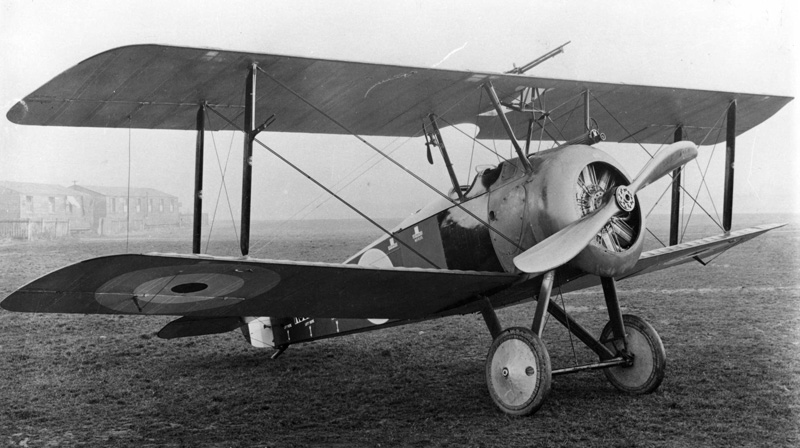
Meanwhile Sopwith’s first production ‘2F1 Ships Camel’ N6600(above) with its 150hp Bentley BR1 engine, single Vickers gun, over-wing Lewis gun, detachable rear fuselage and floatation bags has been delivered directly to RNAS Yarmouth from Brooklands. New aircraft from the final assembly and test sheds of Sopwith, Martinsyde and Bleriot/SPAD at Brooklands are now conveniently being taken into service at Brookland’s new No.10 Aircraft Acceptance Park.
In France on 13th October the pilots of 54Sqdn’s B1800 & B2161 are killed and their colleagues in A7344 & B5918 are taken prisoner during a fight with eleven enemy aircraft. The pilot of ‘Triplane’ N5354 is injured when he crashes side-slipping on take-off in gusty winds. ‘Camel’ B3893 claims a victory. During training at home the pilot of unarmed Le Rhône engined ‘Camel’ B3812(below) is killed stalling in a turn at Upavon, B5164’s pilot is killed spinning in at Shawbury and B2334’s is injured in a similar accident at Turnhouse.
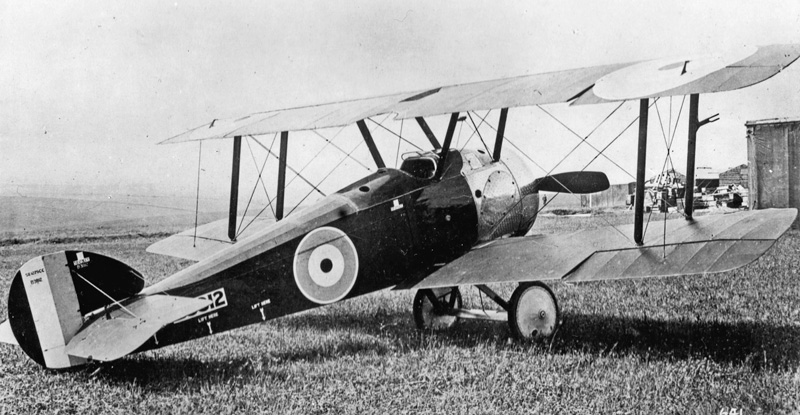
On 14th October ‘Pup’ N6177 crashes at Manston. ‘Triplane’ N5455 crashes on landing. ‘Camel’ B2318 claims a victory, the pilot of B6353 is injured stalling and spinning in whilst N6379 is wrecked overturning on landing. ‘Baby’ floatplane 8205 is wrecked at Calshot.
On 15th October ‘Pup’ B2220 is wrecked on landing. ‘Camel’ B6202 claims a victory, B3818 shares one with B3830, the pilot of B3880 is shot down in combat with 4 enemy aircraft and taken prisoner, B6297 is damaged by machine gun fire and B2326 crashes on landing.
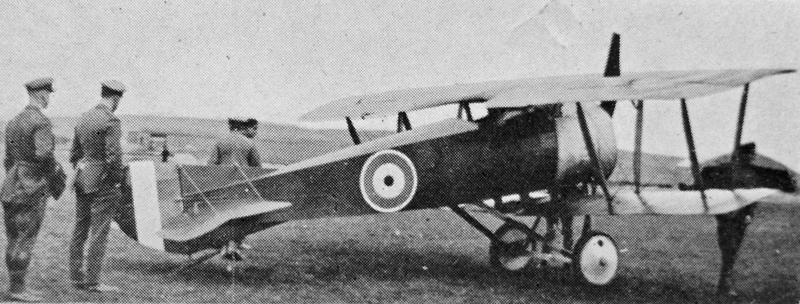
At Mudros in the Aegean on 15th October with John Alcock recently taken prisoner, his experimental Alcock A.1 Scout/Sopwith Mouse is flown by squadron-mate FSL Norman Starbuck.(above & below) They have taken the forward fuselage and lower wings of a Sopwith ‘Triplane’, the upper wings, tailplane and elevators of a Sopwith ‘Pup’ and married them to a rear fuselage and vertical tail surfaces of original design. It carries a single Vickers machine gun. It flies quite well powered by a 100hp Gnome engine and is soon to get a 110hp Clerget.
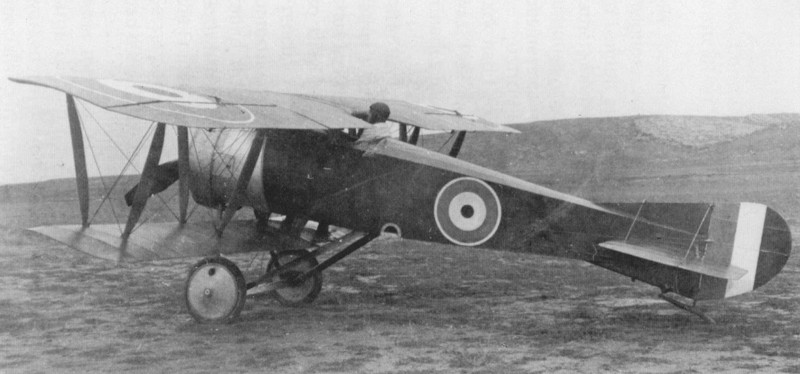
On 16th October ‘Camels’ B5158 & B6207 both suffer engine failures.
On 17th October ‘Pup’ B1793 is damaged in combat with three Albatros and claims a possible one destroyed. ‘Triplanes’ N5454 & N5455 each claim a victory. ‘Camel’ B3818 claims another victory, B6239 shares one with N6349 but the pilot of B5156 is killed spinning-in after take-off, B2323 forced lands with engine failure as does B3909 damaging a wing landing on a beach.
With 390 Sopwith “Schneider” & ‘Baby’ floatplanes delivered into service since February 1915, the first three Blackburn-built ‘Baby’ floatplanes N2060-62 from their latest order for another 75 machines are delivered this week, probably without any 130hp Clerget engines, straight into storage at Killingholme to be used as spares.
Admiral Sir David Beatty, Commander in Chief Grand Fleet has picked up on the proposals by Cdr Sueter for an attack on the German High Seas Fleet with torpedo carrying aeroplanes, the torpedo carrying floatplanes being slow and vulnerable and restricted by sea conditions. His plan requires at least 121 aeroplanes used in a surprise completely secret mass attack from decks fitted on eight merchant ships which would also carry fighter escorts.
Consequentially the order for 100 Sopwith ’T1 Cuckoo’ torpedo bombers on Fairfield Shipbuilding Co has been confirmed and an order for a further 50 placed on Pegler & Co of Doncaster who also have no aircraft building experience. At high-level Admiralty progress meetings despite recording that the ‘Cuckoo’ can only carry a 1,000lb torpedo which “does not have a bursting charge efficient enough for a crippling attack on a warship” and ways must be found to stop the torpedo freezing up, they are pressing for the prototype ‘T1 Cuckoo’ to be fitted with fuselage air bags and a single Lewis gun to be flown with a dummy torpedo from the deck of HMS Furious. However, since Dunning’s foredeck landings on HMS Furious there have been proposals for her to be fitted with an aft landing-on deck, despite warnings about eddy-currents from the funnel and superstructure and the elimination of her defence armament. This aft deck is approved on 17th October which will take HMS Furious out of service for some months.
Following the successful flights of a ‘Pup’ from ramps on the gun turrets of HMS Repulse, the same meeting decides that all light cruisers and battle cruisers should carry fighting aeroplanes for defence against aerial attack “providing their gun armament is not interfered with”. This heralds a major expansion in shipboard flying although ‘Pups’ have routinely been flying from the ramps of specially modified ships like HMS Campania, Vindex and Manxman for over six months now.
On 18th October ‘Pup’ B1792 claims a victory and shares another one with A6215. ‘Triplane’ N5454 claims a Goths bomber sent out of control into a vertical dive over Passchendaele whilst N5465 & N5479 share a DFW C. ‘Camel’ B2399 claims a victory, B2429 forced lands with a wounded pilot and N6376 crashes on landing. At home, Croydon based ‘Pup’ A650 breaks up in the air and the pilot is killed and Cranwell ‘Pup’ 9925 swerves and turns over after an engine failure on take-off.
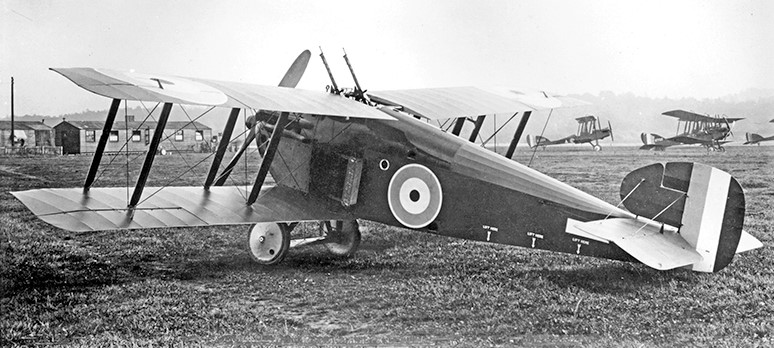
The third prototype Sopwith ‘Dolphin’ (above & below) has exhaust pipes but no lower wing cut-outs. The flank radiators have perforated outer faces and plywood shutters and there are oval cooling slots in the nose of the engine cowling. There are changes to the fuel system but the most obvious difference is the two extra upward firing guns on the centre section frame. Sopwith are now satisfied with these modifications and it is flown to Martlesham Heath on 18th October.
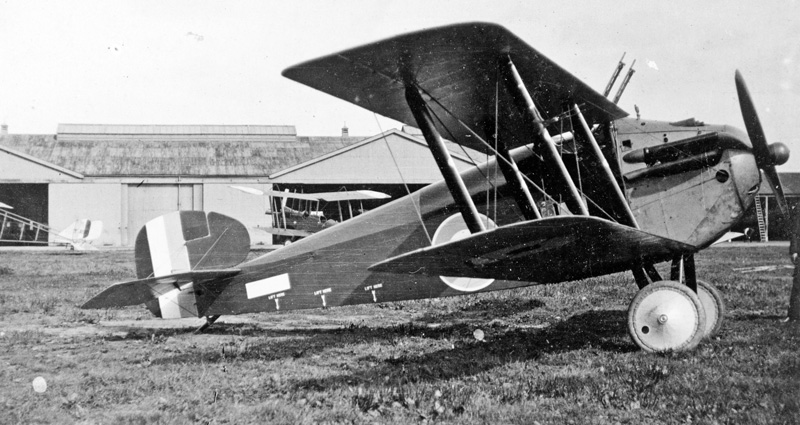
Martlesham meanwhile have been modifying the second prototype to improve forward and rearward vision flying it without the engine top decking and with lowered decking immediately behind the pilot. As a result the fourth prototype which is otherwise similar to the third is having the rear decking lowered and the engine top decking over the guns reduced whilst it awaits its engine. These modifications are urgently being incorporated into the production machines which are already starting to appear in the Sopwith assembly shop in Kingston alongside the last of their ‘2F1 Ships Camels’.
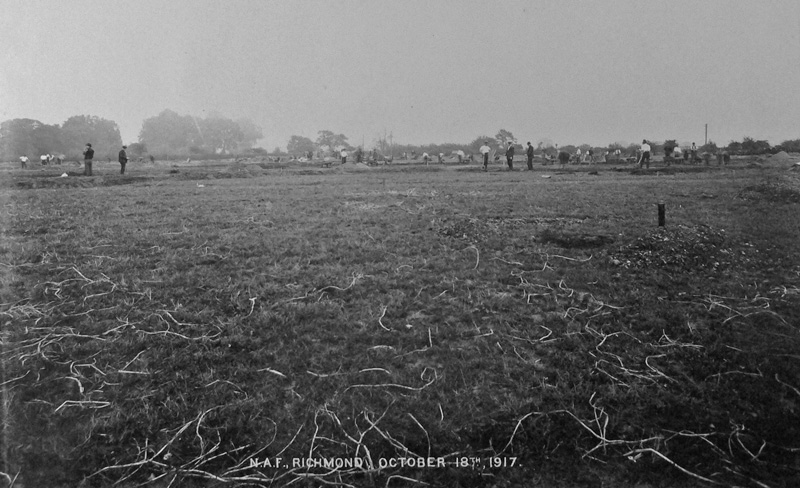
On 18th October just a month after negotiating the contract with the Ministry of Munitions, Dick, Kerr & Co submit their first photographic record of progress with the building of National Aircraft Factory No.2 at Ham between Kingston and Richmond.(above) They already have a significant workforce preparing the foundations. With no adjacent railway they are to bring bulk materials by barge up the Thames to a wharf on the site.
On 19th October the pilot of Turnhouse ‘Pup’ B2247 is killed when it loses its propeller and spirals in whilst B1808 out on balloon practice from Rochford forced lands on the rail lines on Southend Pier shorting out the electric railway. ‘Camel’ B3770 is completely wrecked colliding with a Henri-Farman.
On 19th October a raid by eleven Zeppelin airships aimed at northern England turns to a fiasco when they are blown south by strong winds and get hopelessly lost bombing Birmingham and as far south as London’s Piccadilly Circus where one random bomb causes most of the 36 deaths and 55 injuries that night. Swept along by variable winds at different altitudes, four airships crash in France whilst a fifth crashes way off course in Germany.
On 20th October ‘Pup’ B1719 is wrecked crashing on landing. ‘Triplane’ N5454 claims a victory. 70 Sqdn ‘Camels’ drop twenty-two 25lb bombs from 400ft during a 45 single-seater attack on Rumbeke airfield which is accompanied by strafing runs at 20 feet or less. There is much damage to machines and buildings on the ground and seven enemy aircraft are shot down. ‘Camels’ B2399, B6313, B6344 & B6346 each claim a victory, B2349 shares one with B2356, B2396 shares one with B2423, B2318 destroys an aircraft on the ground and claims another which stalls and crashes on take-off as does B6366. Two RFC machines are lost: the pilot of Camel B6352 is shot down and dies of his wounds whilst B2370 is hit in the tank and the pilot taken prisoner. The pilot of B6315 is injured and B3887 shot up overturns on forced landing. In other combats B2327, B5182 & B6412 each claim a victory, whilst B3919 is shot up and the pilot injured. The pilot of B6297 is injured crash landing whilst B2426 & B6393 (below) crash on practice flights. . At St Pol Seaplane Defence Flight ‘Camels’ N6348, N6368, B3784, B3793 & B3807 are destroyed by a 500kg bomb which leaves a 37ft wide 20ft deep crater.
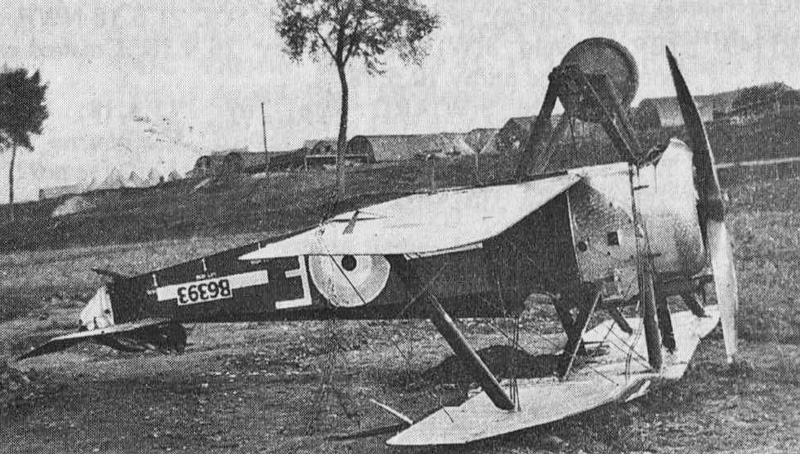
On 21st October ‘Triplanes’ N5387 & N5449 each claim a victory. ‘Camel’ N6370 claims two victories, B6202 shares two with B6203 & B6289 whilst B2388, B2423 & B6344 each claim a victory, B3937 scores a victory before the pilot is killed in action, N6363 scores one before the pilot is wounded, the pilot of B6346 is killed in a stall returning from a patrol whilst the pilots of B6335 & B3919 are wounded in combat.
On 22nd October the pilot of ‘Pup’ B1782 dies when it breaks up after colliding with B1834 who’s pilot is taken prisoner circling under enemy aircraft, the pilot of B5955 is injured crashing from a spinning nose dive and N6472 collapses its undercarriage caught by a gust of wind. The pilot of ‘Camel’ B2422 is killed hit by AA fire, B6406 is damaged by AA fire whilst B2311 suffers an engine failure and forced landing. The trainee pilot of Upavon ‘Camel’ B3814 dies of his injuries after stalling with a choked engine at 100ft.
On 23rd October the pilot of ‘Camel’ B2365 is injured crashing with an engine failure and B6290 overturns on landing. Westgate based ‘Baby’ floatplane N1203 drops two 65lb bombs on a U-Boat 25 miles out to sea.
On 24th October The pilot of ‘Pup’ A6182 is wounded when it is shot up and also probably hit by AA fire. ‘Triplane’ N5465 claims a victory but the pilot of N5476 is killed in combat. ‘Camel’ B6365 and at least one other each claim a victory whilst B2442 & B3808 both crash on landing. At Seaton Carew ‘Baby’ floatplanes N1112, N1423 & N1435 are damaged in a gale whilst in the Aegean N1201 is salvaged after forced landing in Kharos Bay.
That same day B3811 is ignited in fire-proofing tests at Orfordness Experimental Station whilst at Martlesham Heath tests with B3862 & B2312 confirm the poor performance of their Ruston Proctor-built Clerget engines. Wells-built ‘Strutters’ A5253, 60 & 61 have emerged from an RFC storage depot in Islington to be taken on by the RNAS Gunnery School at Eastchurch and have unusually been fitted with 100hp Gnome engines. A5262 has joined them there but it has a more standard 130hp Clerget engine.
On 26th October the pilot of ‘Pup’ N6466 from Manston is killed after colliding with a Triplane. ‘Camel’ squadrons are active at low level supporting a new ground offensive despite heavy rain, B6313 claims two victories, B5406 claims a victory but the pilot is wounded, B5152 is downed and the wounded pilot taken prisoner and the pilots of B2327 & B6356 are wounded by gunfire. B6260 crashes on take-off and B6235 crash lands after engine failure.
On 27th October ‘Pup’ B5916 crash lands shot up by AA fire. ‘Triplane’ N5454 claims a victory, the pilot of N5455 is wounded in combat, N6299 forced lands with engine failure whilst the seventeen month career of the original ‘Triplane’ prototype N500 comes to an end when it is burnt. ‘Camels’ B6372, B2367 & B6362 each claim two victories, B3921, B3936, B6230, B6272 & B6354 each claim a victory, B2361 shares one with five others, B6202 shares one with B6225 whilst B6313 & B6364 each claim a possible victory. That makes thirteen, possibly fifteen, enemy aircraft shot down by ‘Camels’ in one day but the pilots of B2349, B2382, B3945, B6374 & N6371 are all killed in combat, B5178’s is wounded in combat and taken prisoner, as is B2361’s pilot after being shot down. B2444 & B6208 are shot down and the pilots injured, the pilot of B2463 is wounded in combat and B6374 is shot down in flames. B6249 has the controls shot away at 11,000ft but the shocked pilot regains some control at 500ft and escapes to the front line trenches after crashing in no-man’s-land. The pilot of B5170 is seriously injured side slipping on take-off and B2403’s is injured after take-off hitting B2444 which is landing. B2356 also crashes on take-off whilst B3845, B3866, B6251 & N6378 all suffer crash landings.
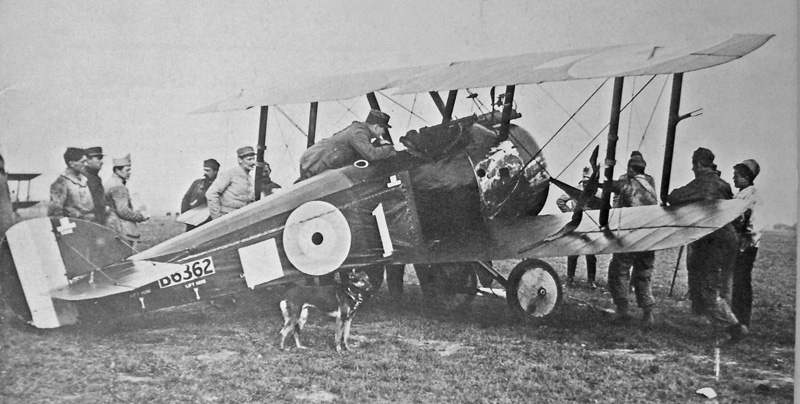
This has been an intensive last day on the Western Front for 28 Squadron’s ‘Camels’ including B6362(above) being inspected by French pilots before leaving for Italy. It has 28Sqdn’s white square marking behind the roundel and on the right top wing, its squadron aircraft number ‘1’ on the side and left top wing and the Squadron Commander’s pennant trailing from the nearest wing strut. Three days ago an Austro-German offensive was launched against the Italian Army in a final bid to shatter Italian opposition and a wide gap has been opened up in Italian defences. To avoid an Italian defeat French and British divisions from the Western Front are to be sent to Italy supported by 28Sqdn ‘Camels’ and 43Sqdn RE8s.
On 27th October the first Oakley-built ‘Triplane’ N5910 with its twin-guns moves on to the War School at Manston whilst N5911 & N5912 arrive at Hendon. Oakley has taken over ten months to deliver these and the Admiralty is cancelling the remaining twenty-two on order, although some may be supplied as spares.
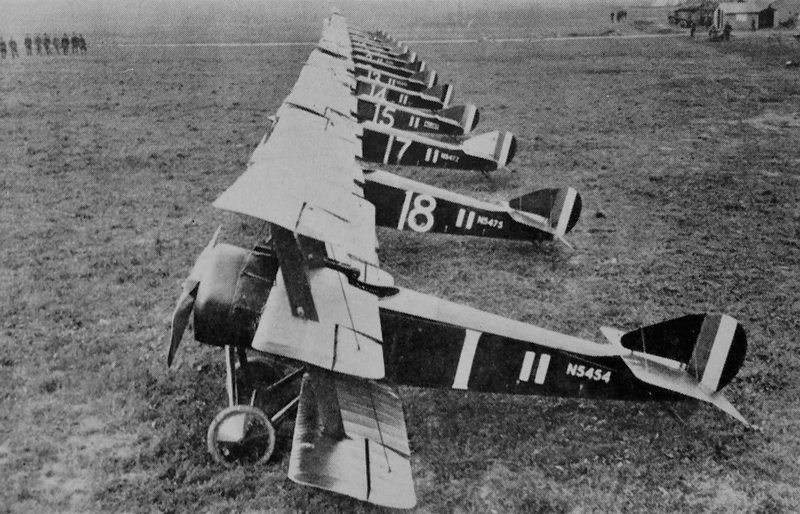
Meanwhile the first four of the six surviving French Sopwith ‘Triplanes’ have now been taken on by 1(N)Sqdn of the RNAS and are included in this line-up (above) on 28th October at Bailleul. The first ten French aircraft F1 to 10 were specially built by Sopwith whilst Clayton & Shuttleworth-built F11 to F15 were to have RNAS serial numbers N5384 to N5388. However the French St Pol (SP) numbers marked on the aircraft are causing confusion and aircraft are getting erroneous markings. (F9/SP14 & F5/SP11 have been mistaken for F14 & F11 and wrongly given their N5387 & N5384 serial numbers. F11/SP9 which should have its original N5484 number has been given new “experimental” RNAS serial number N541. F13/SP13 has correctly come back to the RNAS as N5386 (6th from the front) but still carries its French tail stripes and smaller French ‘13’. F3/SP10 & F6/SP15 are also about to come to the RNAS but not to 1(N)Sqdn, and have been allocated new serial numbers N543 & N541.)
On a foggy 28th October ‘Pup’ A7324 shares a victory with B1727. ‘Camels’ B6217 & B6230 each claim a victory but the pilot of B6315 dies of his injuries stalling in a turn after take-off, B2446 & B6237 also crash on take-off, whilst B2389 & B6336 crash on landing. At home, ‘Pup’ 9938 is involved in parachute dropping experiments.
The RNAS Dunkirk has lost 61 pilots through sickness, injury and transfers home in the last five weeks. With only 19 replacements available they are cutting the number of air patrols protecting the fleet off the coast of Belgium.
On 29th October the pilot of shot-up ‘Triplane’ N5455 is wounded. The pilot of ‘Camel’ B2357 is shot down and killed whilst the pilot of B2350 is killed when it breaks up in a dive and B2388 crashes on take-off. Hornsea based ‘Baby’ floatplane N1411 crashes and is a total loss, as is 8194 after just 17 days at Lee-on-Solent.
After its crash landing back in August the last of the two larger Hispano-Suiza engined Sopwith Triplanes’ N509 is finally deleted from service. However the fourth prototype Hispano-Suiza engined Sopwith ‘Dolphin’ has been delivered to Martlesham Heath(below) and today has been flown on to St Omer. It has a lowered top decking behind the pilot to aid rearward visibility but is otherwise similar to the third machine.
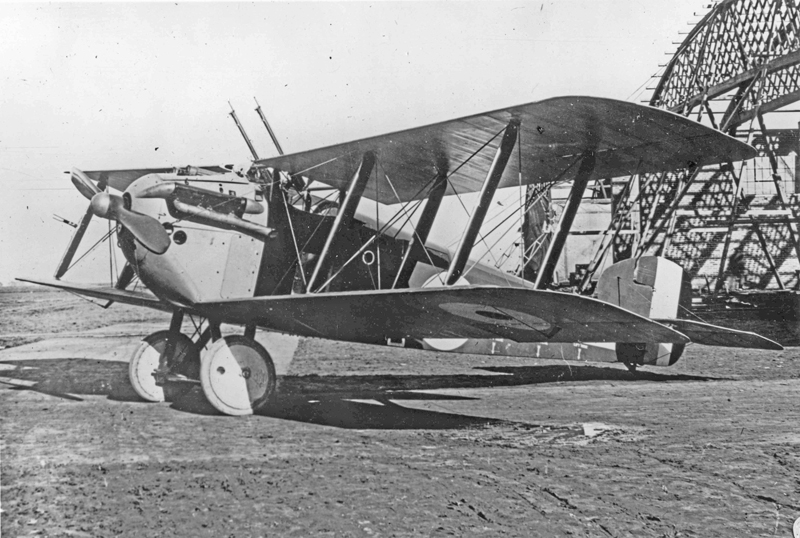
On 30th October the weather in France is “unfavourable for aerial work”. On 31st October ‘Triplane’ N5454 claims a victory but N6300 suffers an engine failure and forced landing. ‘Camels’ B6365 & B6366 each claim a victory, B6354 shares one with B5182, the pilot of B2425 is killed in combat spinning into the ground from 14,000ft, B2371 crashes on take-off, B2352 crashes on landing and B3794 makes a forced landing in Dunkirk harbour but the pilot and aircraft are saved by monitor HMS Eugene.
‘Camel’ B2425 is the first casualty for 3 Squadron in France. They write to RFC HQ: “The majority of pilots report that the seating position in their Sopwith Camels does not give them sufficient field of view and this difficulty is removed by adding a second cushion. May authority be given for permission for the issue of 18 cushions.”
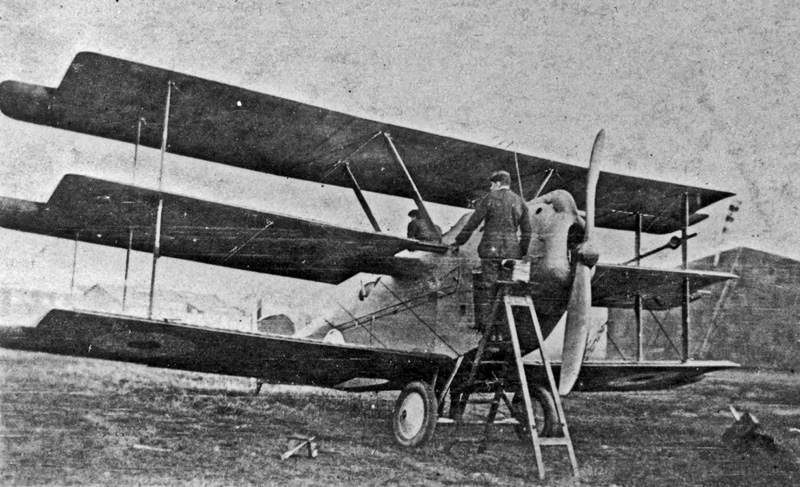
An extraordinary sight at Brooklands is the first prototype Sopwith ‘2B2 Rhino’ on flight trials.(above & below) A large triplane bomber with a deep fuselage to accommodate bomb stowage beneath the pilot and the tall slender six-in-line BHP 230hp engine, it has widely splayed cabane struts to single bay wings and ailerons with protruding horn balances. The rear cockpit has a pillar for a Lewis gun. The wheels appear very small. With the small Dolphin-like side radiators the engine is overheating and it is nose heavy so it will be is getting some modifications.
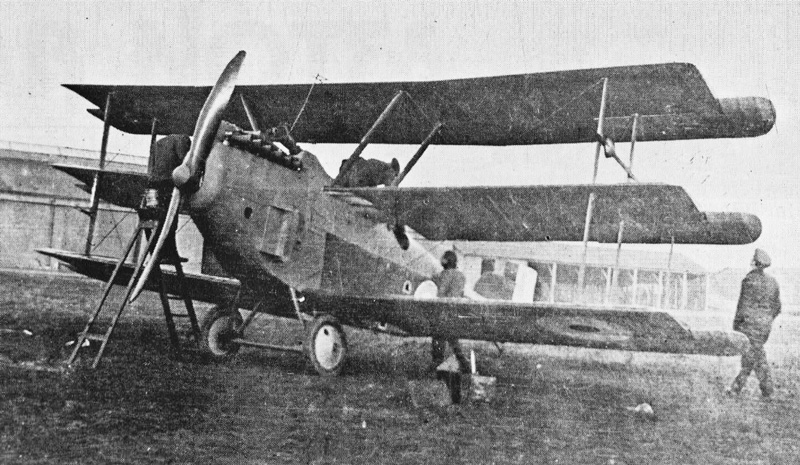
On 31st October Sopwith finally get the order for six ‘7F1 Snipes’, three “experimental” and three “prototypes” together with a letter from the Technical Department of the Air Board suggesting that they should consider a design to meet the new Specification A.1.(a) using the new seven cylinder ABC Wasp radial engine the first of which is ready for testing and expected to deliver 185hp. They are already designing a version of the ‘Snipe’ with the promising new 230hp Bentley BR2 radial engine to try to meet the same Air Board specification.
The Sopwith factory’s output in October has been a record 129 machines: 95 ‘F1 Camels’ and the first 34 ‘2F1 Ships Camels’. With only 20 more ‘Camels’ to build, production is now focussed on the 500 ‘5F1 Dolphin’ order.
The total of new Sopwith designed aircraft from all suppliers in September is a record 467 including Sopwith Beardmore ‘SBIIIs’. The 338 machines from other manufacturers include the last 21 British-built ‘Strutters’ from Hooper (6) and Morgan (15); 93 ‘Pups’ from Standard Motors (56) and Whitehead (37); 17 ‘SBIII Folding Pups’ from Beardmore; 176 ‘Camels’ from Boulton & Paul (46) Clayton and Shuttleworth (36), Hooper (12), Portholme (10), Ruston Proctor (72) plus 12 ‘Baby’ floatplanes from Blackburn and 19 ‘Fairey Hamble Baby’ floatplanes from Fairey (11) and Parnall (8). These figures again exclude hundreds of ‘Strutters’ being built in overseas. This month more British-built ‘Strutters’ have gone to Russia whilst five, A5977 to A5981, have been sent to Japan. During October 100 ‘Camels’ have been ordered on another new manufacturer Marsh, Jones & Cribb of Leeds.
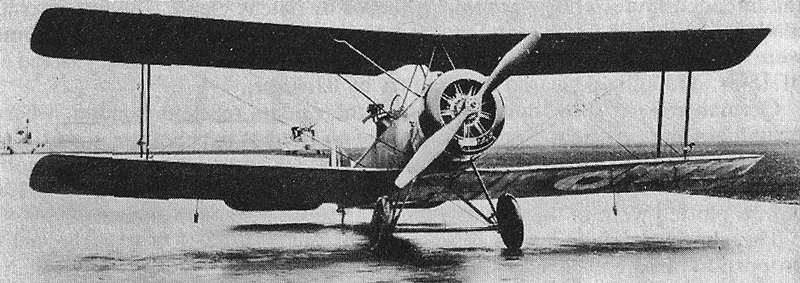
Overnight 31st October/1st November twenty-two Gotha bombers set out to bomb London, at least half of their bomb loads being the new much vaunted incendiaries. Only ten Gothas reach London and casualties of 10 killed and 22 injured were very light for such a major effort, the incendiaries being a dismal failure with none of the expected conflagrations. The other Gothas bombed Kent and some were blown north by freshening winds. Amongst the fifty home defence sorties are eleven 44Sqdn ‘Camels’ now equipped for night flying with red and green navigation lights port and starboard, signalling lamps on the top and bottom of the fuselage for communicating with other aircraft and searchlight and AA batteries, and brackets under at least one wing tip for Holt Flares to light up the ground coming in to land. RNAS ‘Strutter’ N5617(above), also now fitted with small navigation lights on the interplane struts and underwing Holt flare brackets, fired a drum of ammunition at a bomber before it disappeared into the darkness and later shot at a group of five Gothas. There are debut outings for three of 78Sqdn’s self-converted single-seat ‘Comic Strutters’ A5238, A5259 & ex ‘Strutter Bomber’ A6906(below) with front seat faired over and pilot in the bomb-bay but unable to reach the Vickers gun if it jams. The fighter interceptions and a possible AA hit have no immediate results but five Gothas crash at or near their home bases.
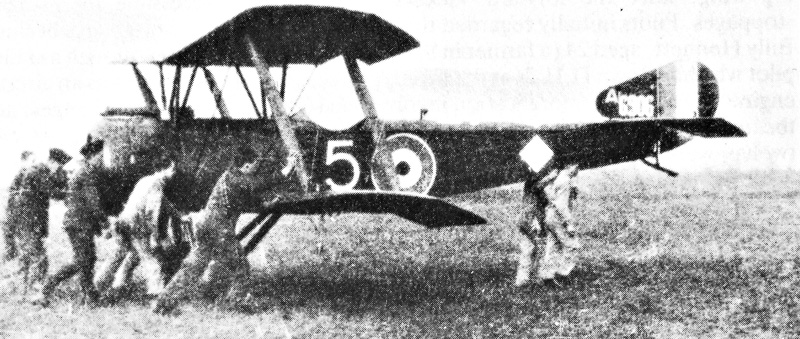
On 1st November as low cloud and mist sets in over the western front, ‘Camel’ B6366 claims a victory but the pilot of B2305 is killed when it spins into the ground. Hornsea based ‘Baby’ floatplane N1467 is forced to land three miles out to sea by an engine failure but is towed in to Bridlington.
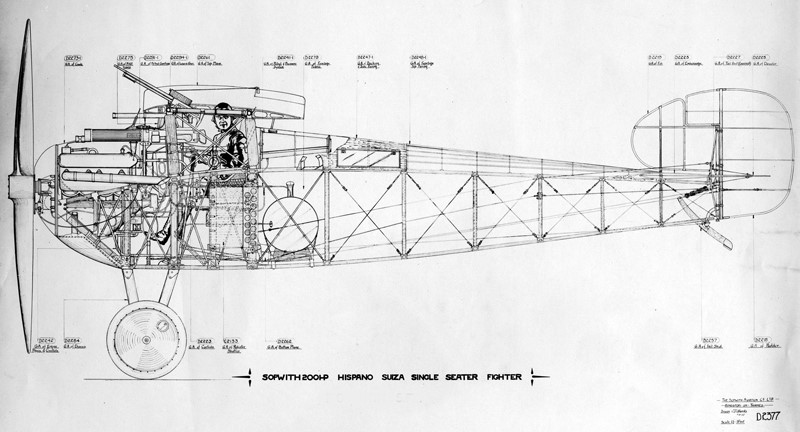
With the first production Sopwith ‘Dolphins’ about to go to Brooklands for testing and on to the customer, Sopwith draughtsman J D Stranks has been tasked with producing the general arrangement drawing which indexes the drawing numbers of the constituent sub-assemblies. He signs drawing D2377(above) on 1st November having added unusual detail including a pilot and grain on the wooden parts. Another version of the same drawing on the same date has more formal printed lettering, less detail and no pilot. These drawings show why pilots are concerned about getting trapped in a Dolphin’s cramped high cockpit if it overturns.
Meanwhile another Hispano-Suiza engined Sopwith machine the ‘T1 Torpedo carrying aeroplane’ N74 is making history. In preparation for the secret massed torpedo attack on the German Fleet next year, the Navy needs to prove that ‘T1s’ can get off the deck of a ship, loaded with a 1,000lb torpedo. N74 has been rushed up from Grain to Rosyth and was embarked on HMS Furious three days ago. On 2nd November HMS Furious leaves harbour “on flying exercises”. The ship’s log simply states “2.43pm Despatched torpedo aeroplane. 2.53pm Torpedo carrier attacked ship. Stopped and picked up torpedo. 3.36pm Proceeded into harbour.” This is probably the first flight of a wheeled torpedo carrying aircraft from a ship at sea and one of the final outings for HMS Furious before she goes back to Armstrong’s shipyard in Newcastle to be fitted with a rear landing-on deck.
On 2nd November Farnborough’s report on sand bag strength testing of Sopwith ‘Pup’ B5941 concludes that the load factor of 6.6 is not sufficient for the installation of the heavier more powerful 110hp Le Rhône engine. This is bad news for the RFC in France who are about to get B5259 with one of very few yet fitted. It will be returned.
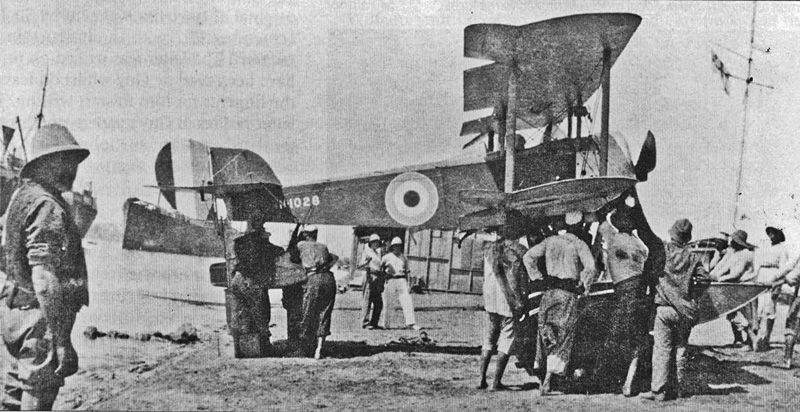
The East Indies & Egypt Seaplane Squadron’s HMS Ben-my-Chree has been replaced by HMS Empress from the Aegean. Having loaded up with two ‘Hamble Baby’ and four ‘Baby’ floatplanes at Port Said, including N1028(above), she arrives off the coast of Gaza on 2nd November as part of the concerted attack on the retreating Turkish Army’s communications and supply lines. N1038 is hoisted out but it overturns with two primed 65lb bombs aboard and for safety is sunk by gunfire after an escorting French destroyer has rescued the pilot. Three other machines attempt to bomb a railway bridge ten miles inland in very bumpy conditions. HMS Empress moves on to Haifa Bay to attack the olive oil factory. ‘Baby’ floatplane N1036 drops warning bombs and sees the workers disperse before three others bomb the factory, however N1210 goes down in the bay after an engine failure. Under fire from the shore the pilot attempts to burn it before swimming to climb onto a float of rescuing N1036 but, too low in the water, its propeller is broken attempting to take-off. The two injured pilots are saved by a destroyer and N1036 is sunk by gunfire. Meanwhile N1129’s tail float is damaged on landing and it capsizes making four ‘Baby’ floatplanes lost and two pilots injured in a single day.
A few Blackburn-built ‘Baby’ floatplanes are being transferred to the Norwegian Naval Air Service. F100 first flew after erection at Horten in Norway on 13th July. In the last ten days three more F102, F104 & F106 have made their first flights at Horten. To be operated from fiords by fighter flights they may be fitted with skis in winter.
Sopwith ‘Baby’ floatplane 8134 was successfully converted to have a wheeled undercarriage a year ago and N1321 was converted in August this year, both are at the Gunnery School at Eastchurch. Subsequently the order for 100 ‘Fairey Hamble Baby’ floatplanes on George Parnall & Co was revised for the last 74 to be ‘Hamble Baby Convert’ landplanes with wheeled undercarriages. The first six of these N1986 to 91 are now going to the RNAS Central Supply Depot for onward shipment to Otranto in Italy. There is apparently no immediate demand for the rest as this week the next four N1992 to 95 are being delivered into storage at Killingholme.
On 3rd November ‘Camels’ B2318 & B2404 are wrecked in forced landings in the mist in France. The fuselage of AA damaged Standard-built ‘Pup’ B5917 is found to have “constructional defects” and is “badly trued-up”.
On 4th November ‘Pup’ B1701 claims a victory, B1796 shares one with B1701 whilst B1712 is damaged on landing. ‘Camel’ B6202 claims two victories, B3856 & B6376 claim one each, B3936 crashes and B2362 forced lands.
On 5th November ‘Pup’ A6197 is damaged landing in a crosswind. ‘Camel’ B6354 claims a victory as does B6341 but is damaged in the combat, the wounded pilot of B5175 is taken prisoner whilst B3919 collides with B5666 on the airfield.
On 6th November ‘Strutter’ N5081 is hit by AA fire and the crew taken prisoner. ‘Triplane’ N5384 sinks into soft sand landing on a beach after an engine failure. Despite the rain, low mist, wind and cold the RFC are assisting the Canadians’ final push into Passchendaele with close offensive patrols shooting up defenders on the ground. The pilots of 65 Sqdn ‘Camels’ B2408, B2414 & B2441 are all taken prisoner after drifting east and crashing after being badly shot up by ten enemy aircraft. A 3 Sqdn patrol of ‘Camels’ B5160, B6355, B6382 & B6392 are also caught out by the strong westerly winds and poor visibility and land to find out where they are. One could not restart and burnt his machine before going on the run, the other three attempt to fly back across the lines but are eventually driven down by lack of fuel and terrible conditions only to also be taken prisoner having mistakenly flown not west but south. At home the pilot of Westgate-based ‘Fairey Hamble Baby’ N1327 is killed in a flying accident whilst ‘Camels’ B4608 & B4613 are both wrecked in crashes.
On 7th November ‘Strutter’ N5232 drops two 65lb bombs on a German U-boat in the Adriatic sea 20 miles north-east of Otranto. In France ‘Camels’ B3921 & B5409 each claim a victory, the pilot of B2485 is injured whilst B2379 & B3892 crash on landing. At Sandbanks in Dorset Calshot-based ‘Baby’ floatplane N1436 is caught by a gust of wind on take-off and is wrecked.
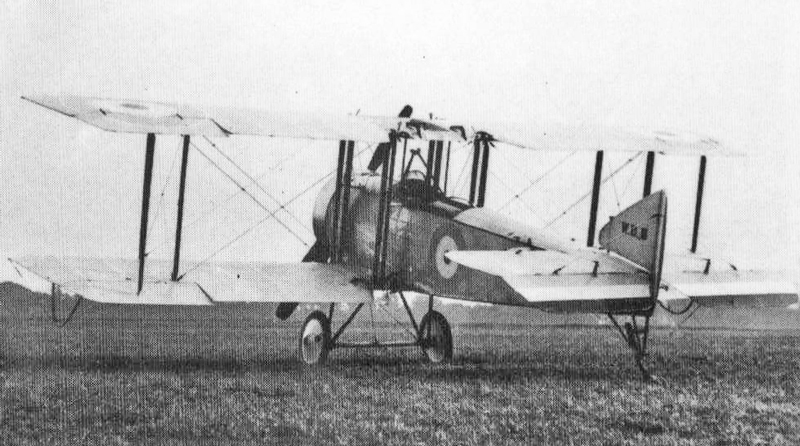
The ambitious plans for Sopwith-Beardmore ‘SBIII Pups’ to be stored on ships with undercarriages folded up have not been pursued. Only two were delivered before they switched production to the jettisonable-after-take-off undercarriage saving 50lb weight, reducing head resistance and simplifying ditching on the sea. Both of those now have the jettisoned undercarriage although N6101(above) retains the damage protection hoops under its wingtips required with the very narrow fold-up undercarriage. The other N6102 was seen at Grain last month(below left & right) with the much cleaner lighter interplane struts at the wing-fold replacing the twinned ones and a jettisonable undercarriage fitted with broad white fairings on the legs of the V-struts. It has since been experimentally fitted with a hydrovane to keep the nose up during ditching and has successfully ditched in Sheerness Harbour after dropping the undercarriage on the foreshore.
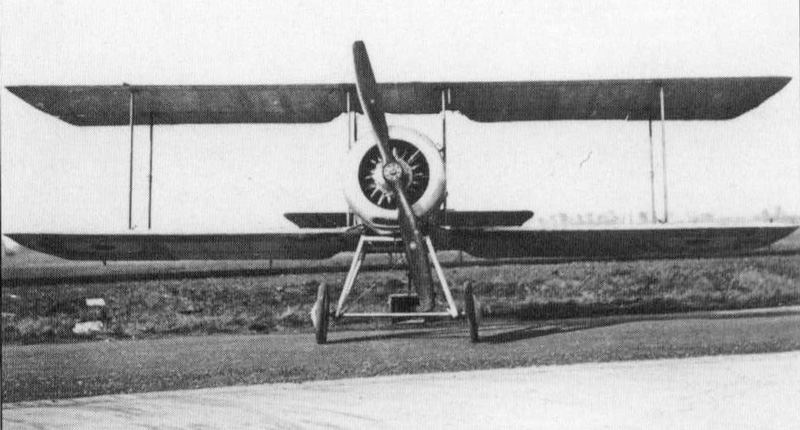
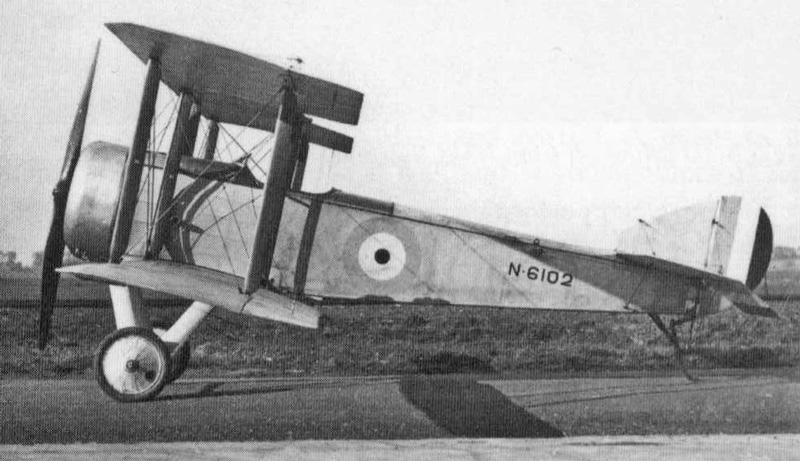
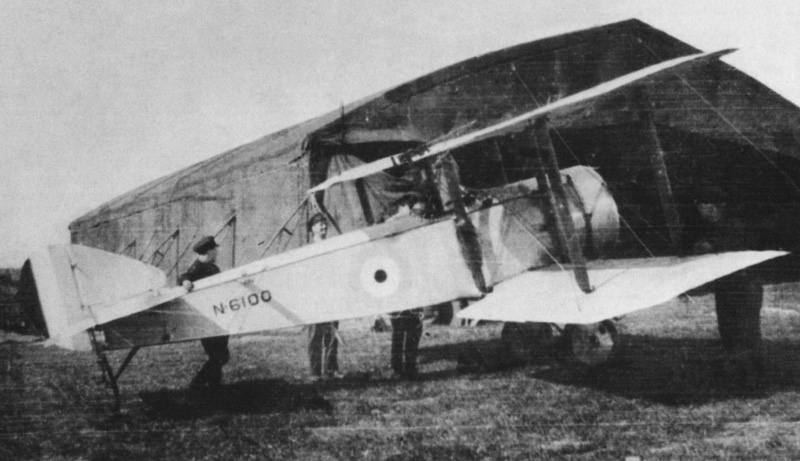
The first production machine N6100(above) also now has single folding wing struts, the dropping undercarriage and carries an over wing Lewis gun. Six more of these early twin wing strut machines which were test flown but are otherwise unused N6104,5,6,7,8 & 10 arrived at Rosyth last week and are not going to get any of these modifications, they have been deleted from service for use as spare parts. One exception is N6109 which has been modified and flies off the deck of seaplane carrier HMS Pegasus on 7th November taking a four second 70ft run against a “felt wind” of 23knots, not dissimilar to recent measured launches of standard ‘Pups’. The other twenty of the first order which have been delivered with these weight saving practical changes are mostly gathered at Donibristle and Rosyth but have yet to start operating from ships.
These 80hp ‘SBIII Pups’ and modified standard ‘Pups’ are already looking rather outclassed by the first of the more potent ‘2F1 Ships Camels’ with their two machine guns and 150hp Bentley BR1 engines. By 8th November ‘2F1 Camel’ N6604 is aboard HMS Nairana and N6608 & 9 are aboard HMS Vindex. The photograph(below) of a ‘TF1 Camel’ leaving Vindex shows the aileron deflection required to counter the engine/propeller torque and the ball on the end of the tailskid which is engaged in the slot in the trestle tail-guide at the start of the take-off run for the same purpose. With so few ships yet with take-off platforms, most ‘2F1 Ships Camels’ are going to RNAS shore stations, four are already at Yarmouth and six are at Manston.
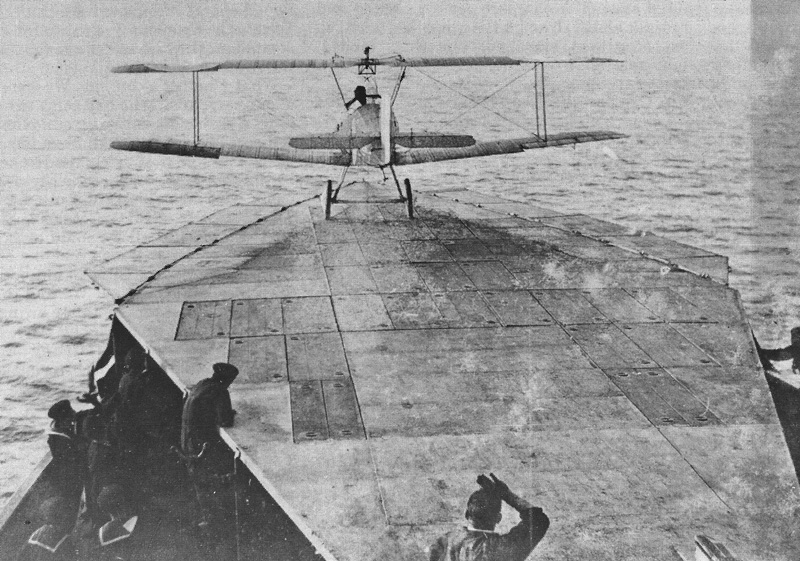
On 8th November ‘Camel’ B6282 claims two victories, B2443, B2444, B5173, B5182, B6423 & B6340 claim one each whilst B3839 & B5660 crash on landing. ‘Hamble Baby’ N1469 flying from Hornsea spots a white streak 4½ miles east Scarborough and thinking it is a periscope drops two bombs from 500ft with no obvious result.
On 9th November ‘Pup’ B1757 in combat with three enemy aircraft is hit in the engine and the pilot taken prisoner. ‘Camels’ B2447 & B3929 each claim a victory, B2396 shares one with B2423, the pilot of B6290 is taken prisoner and the aircraft captured after getting lost in clouds and forced down whilst B6386 crashes on landing.
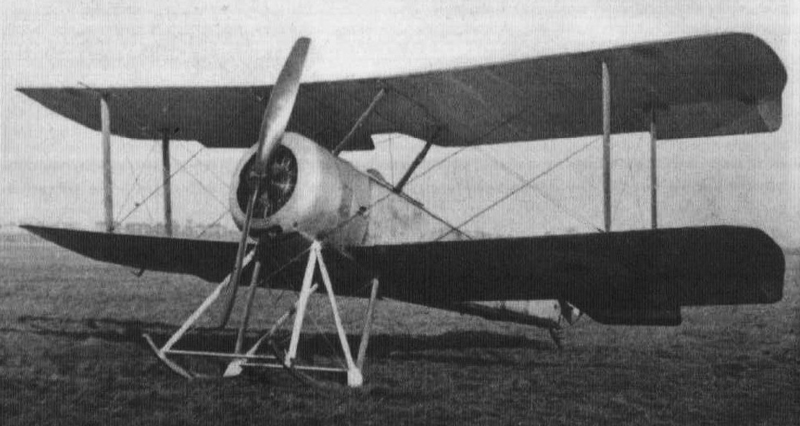
On 9th November following tests with sprung skids, ‘Pup’ 9922 is successfully tested on RNAS Grain’s dummy wooden deck by Sqdn Cdr Busteed with lighter-weight rigid skids.(above) The wheeled undercarriage V-struts are extended with blocks below the axle to maintain ground angle and an extra strut supports the front of each skid. They are testing options for better control of aircraft during cross wind take-offs from ships and the planned landings on HMS Furious’ rear deck.
On 10th November the pilot of ‘Pup’ B1828 dies of injuries sustained crashing on a practice flight.
On 11th November ‘Camel’ B3841 claims a victory but the pilots of B2434 & B2373 are both killed in flying accidents and B2387’s pilot is injured after hitting an infantryman in a forced landing.
On 12th November N5465 claims a final victory for 1(N)Sqdn ‘Triplanes’ and B5651 a first for their ‘Camel’ replacements when they share a Pfalz DIII down in flames. ‘Camels’ B2354 & B2447 each claim a victory, B5659 shares one with B6341, B6210 shares one with a Nieuport but the pilots of B2417 & B6341 are killed in action, B3791’s is killed in a take-off stall, B6274’s is killed in a collision with B6396, B2413’s is wounded in combat, B2437’s is severely injured spinning after an engine failure on take-off, B2393’s is injured crashing into the pilot’s hut on landing, B2405’s is taken prisoner after being wounded in the chest and abdomen by ground fire whilst B2420 is damaged in combat and B5405 forced lands in a shell hole with engine failure and cannot be salved due to shellfire. In the Aegean ‘Strutter’ N5086 hits an enemy aircraft’s engine and sees flames but runs out of ammunition before ensuring a victory. Meanwhile RFC 28 Squadron’s ‘Camels’ arrive in Milan for assembly before flying on to Verona.
On 13th November ‘Pups’ A6203 & B1792 each claim a victory whilst A6192 crashes into another machine on landing. ‘Camel’ B3883 shares two victories with B3884. B3856, B6238 & B6282 each claim a victory, B4612 is wrecked in a forced landing in misty darkness, B2439 crashes with a choked engine on take-off whilst B2460 & B4610 crash on landing. After 21 months at Yarmouth ‘Baby’ 8149 still goes out on a hostile aircraft patrol.
On 14th November ‘Pup’ N6443 flies off the gun-turret ramp of HMS Repulse whilst at anchor. Whilst practising landings the pilot of ‘Camel’ B6262 is killed in a collision with a BE2. B5409 is damaged in combat.
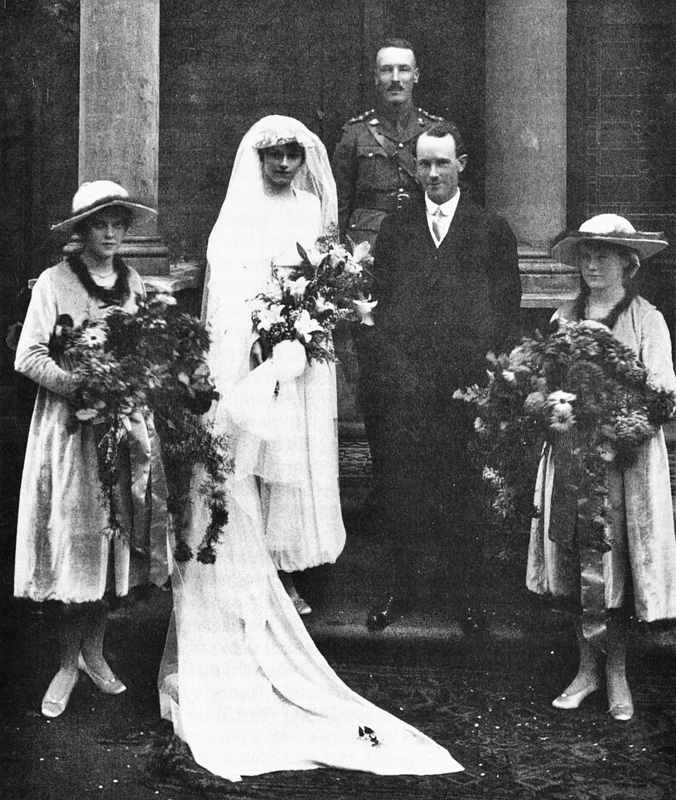
On 14th November 28-year-old Harry Hawker marries 22-year-old Muriel Alice Peaty in St Peter’s Church Ealing after his brother Cpt Bert Hawker, given leave from duty in France, had hustled him back from testing an aircraft at Brooklands and got him into unfamiliar formal clothes and hat. Harry and Muriel had met in Richmond Park in April 1915 when, initially turned away, he returned in his Gregoire and helped her get her stranded little car going after she had run out of petrol and topped it up from a petrol can which unbeknown to her only contained water. Soon after he invited her to drive his 27/80 Austro Daimler and rapid Sunday car drives to Brooklands became a regular outing. Harry has “saved petrol from all quarters” for their motor touring honeymoon in the West Country and fitted a stand with a large gas bag on top of the Gregoire which only lasts for about ten miles but gives the impression they are cleverly avoiding the severe petrol restrictions.
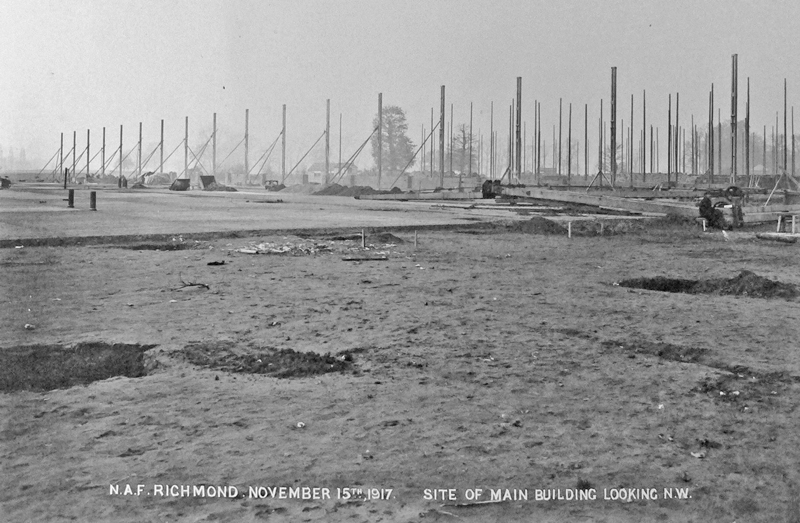
On 15th November Dick, Kerr & Co submit their second photographic record of progress with the building of National Aircraft Factory No.2 at Ham between Kingston and Richmond upon Thames.(above) Eight weeks after negotiating the contract with the Ministry of Munitions, the concrete floor and a forest of 30ft high steel columns are already in place for some of the six bays of the eight acre factory.
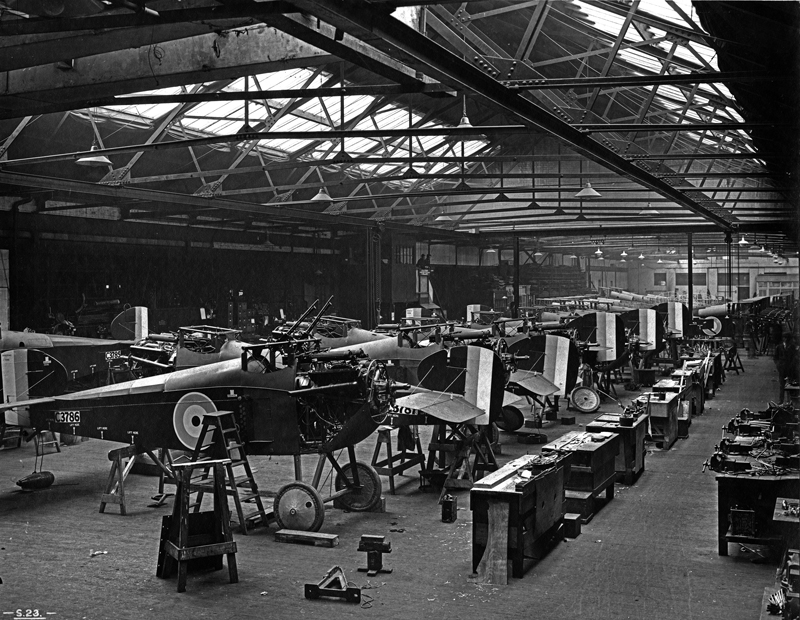
Already this month the Sopwith factory in Kingston have finished their last fifteen ‘Camels’ and the aircraft assembly shop in Canbury Park Road is jam-packed with ‘Dolphins’.(above) With 500 ‘Dolphins’ on order and another order for 200 in the pipeline, they are aiming to deliver no less than 50 in this first month and rapidly build-up to 100 a month. There are over forty machines visible in these photographs taken in a shop which would be a hive of activity six days a week. The ninth production machine C3786 at the front is almost complete; finish painted, engine and side radiators installed, fully rigged tail assembly and fitted with its four guns.
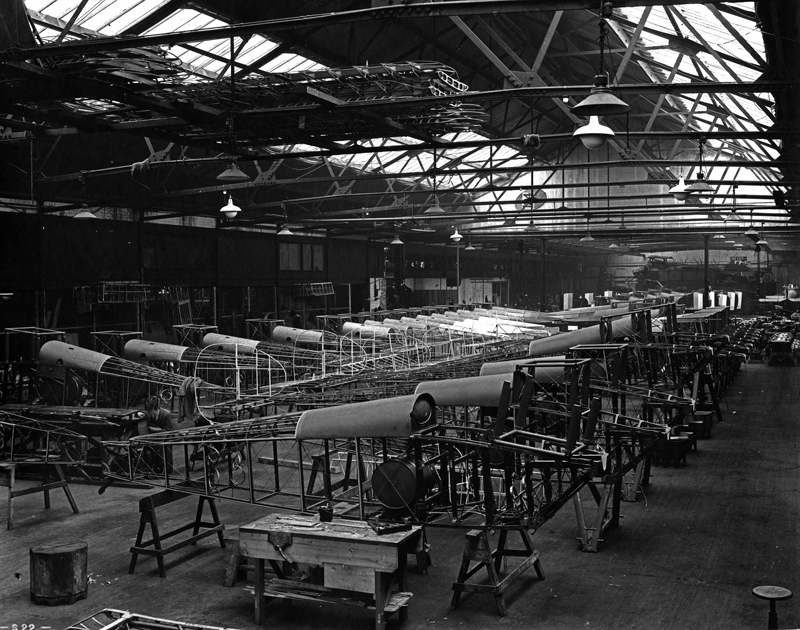
In the centre of the assembly shop(above) bare fuselage frames from the rear workshops are being fitted out with fuel tank and header tank under the plywood top deck behind the cockpit and having the top wing centre frame, tailplane and steel tube fin, rudder and elevator frames attached before fabric covering, doping and painting. The wings also produced elsewhere in the factory, are piling up(below) waiting to have their linen covering stitched on, doping and painting before travelling with the completed fuselages by lorry to the Sopwith sheds at Brooklands for final assembly and testing.
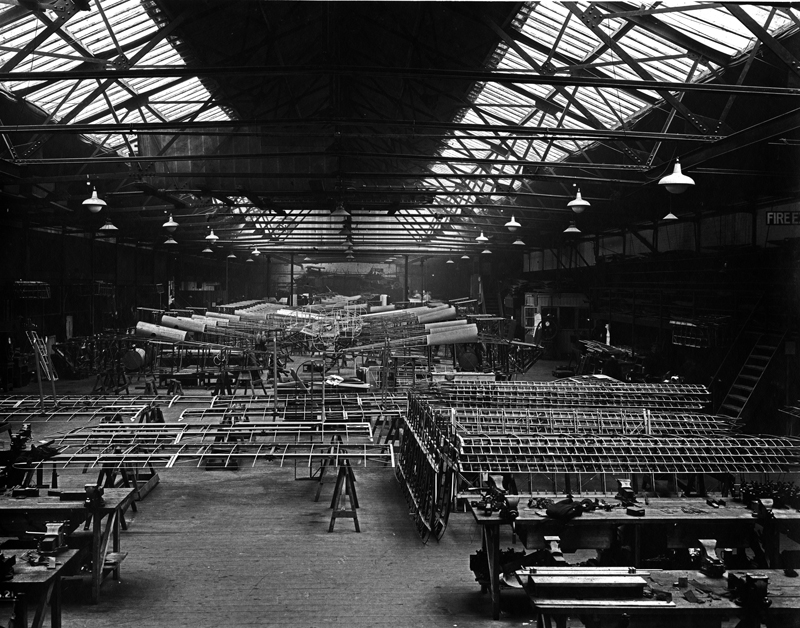
On 15th November ‘Triplane’ N5484 is wrecked crashing on the airfield. ‘Camel’ B6398 claims two victories, B2430, B2411, B2418, B3929, B5182, B6202, B6320, B6419, B6423, B6427 each claim a victory and N6341 shares one with N6351. The pilot of B2444 is killed in action, B2502’s is injured spinning after an engine failure, the pilot of B2458 is taken prisoner whilst B5409 & B6430 are shot up and damaged.
On 16th November ‘2F1 Ships Camels’ N6605, 07 & 15 arrive at Cranwell on their way to Rosyth and Donibristle.
On 17th November the pilot of Upavon ‘Camel’ B3803 is killed stalling in a turn whilst B2471 & B3821 crash on landing. N6367 achieves the first ’Camel’ victory in the Aegean getting on the tail of an Albatross about to attack a DH4, firing and chasing it down from 12,000ft before it stalls into the ground.
On 18th November the pilots of ‘Camels’ B4606 & B4611 are killed crashing on practice flights and B6266’s is injured whilst B2456 crashes soon after take-off, B2329 crashes on landing and B5224 is wrecked. ‘Baby’ floatplane N1446 from Seaton Carew sights a periscope off Scarborough and with the submarine clearly visible drops a 65lb bomb from 800ft before firing a red Verys light to warn a convoy. The aircraft leads armed trawler Minus towards the spot but suffers an engine failure, is forced to alight and has to be towed to Scarborough.
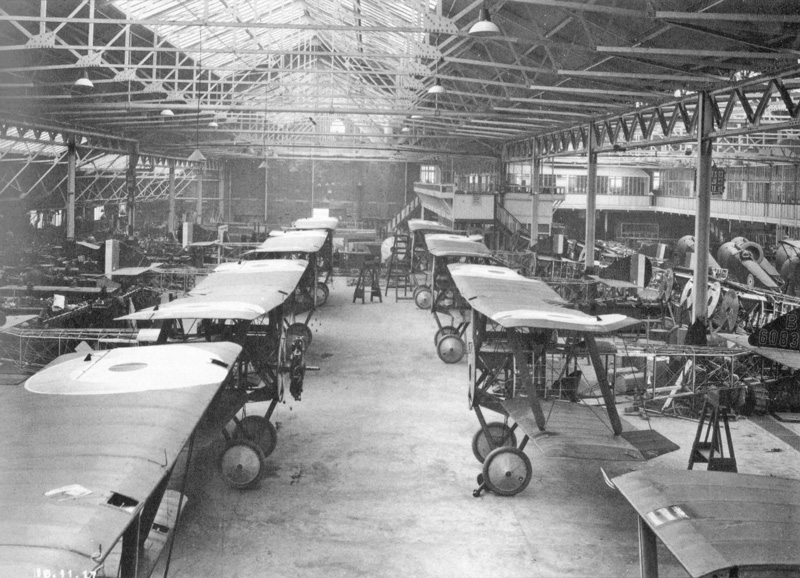
Standard Motors have built over 400 Sopwith ‘Pups’ in Coventry and production is exceeding 50 a month when these photographs are taken on 18th November. The tidy lines of ‘Pups’(above) surprisingly have finished wings fitted before the fuselages have been covered and painted and only one yet has an engine. The photo(below) shows a less orderly array of assembled fuselages at different stages of fitting out ready for final assembly. Also in this picture are some two-seat RE8s which Standard Motors are building at around 20 a month.
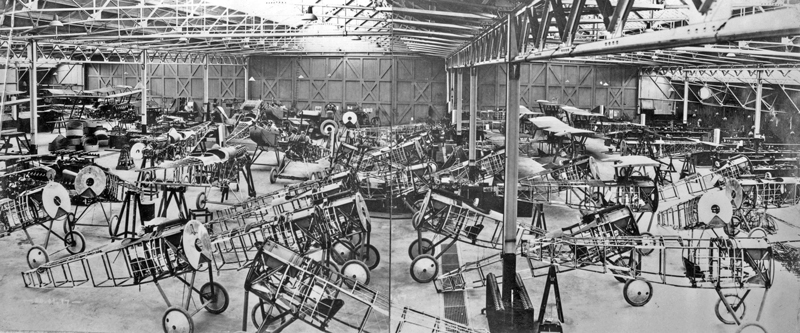
On 19th November the only ‘Triplane’ in the Aegean N5431 claims another victory sending an Albatros DIII nose first into a marsh from 12,000ft. ‘Strutter’ N5233 from Otranto drops two 65lb bombs on a German U-Boat 25 miles out in the Adriatic.
The six ‘7F1 Snipe’ prototypes have now been allocated serial numbers B9962 to 67. The second machine B9963 is on test at Brooklands and will be going to the Royal Aircraft Factory at Farnborough in the next few days. There are reports that it is fitted with a prototype 200hp Bentley BR2 engine but that may not yet have happened. Meanwhile a third prototype ‘Snipe’ B9965 with a 150hp Bentley BR1 engine crashes on the sewage farm at Brooklands in thick fog on the 19th November(below) and is going to have to go back to Kingston for major repairs.
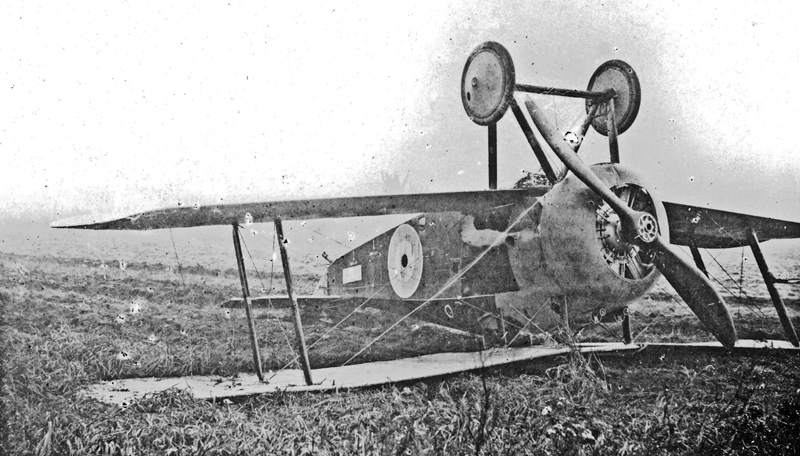
On 19th November the Sopwith Board meeting approves a final dividend for 1916/17 of 6% on the 2,400 £1 Preference Shares held by Thomas Sopwith and the 1,200 each held by three of his seven sisters.
On 19th November the fourth prototype ‘Dolphin’ which arrived with 19Sqdn at Bailleul (Asylum Ground) four days ago is test flown for comparison with their also Hispano-Suiza engine SPAD SVIIs. Lt de Pencier reports it “easy to fly and land. Nice bus”.
On 20th November Sopwith’s first production ‘Dolphin’ C3777 is tested not at Brooklands but at No.7 Aircraft Acceptance Park at Kenley ten miles south east of Kingston. It has all the modifications built into the fourth prototype but has back-stagger on the top wing reduced to 12ins and streamlined steel tube undercarriage Vees in place of ash ones. It is going straight on to Martlesham Heath Aircraft Establishment for evaluation as will C3778 & 9 over the next few days. (below)
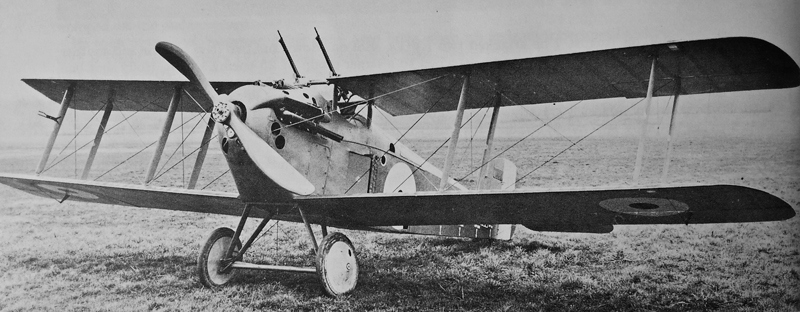
On 20th November the pilot of ‘Pup’ A6188 is wounded by ground fire on a bombing mission and injured in the crash landing, B2186 is also shot up and crash lands whilst the pilots of B2164 & B2166 are both injured at Scampton stalling from 50ft. ‘Camel’ B3818 claims a victory but the pilots of B2421, B5159 & B6373 are killed, B2457’s is wounded in combat and B3824‘s & B6385’s are both shot down and taken prisoner. B2455 is shot down whilst B6405 forced lands in German lines with damage but the pilot gets away chased by cavalry. B2314 & B2423 are wrecked after engine failures, B2491, B3875, B5181 & B5207 are damaged by enemy fire whilst B2498 & B5169 crash. With three pilots killed and two taken prisoner it has been a terrible day for 3Sqdn who went out at dawn despite low clouds and mist to bomb airfields to restrict German aerial defence against the major infantry and tank advance aiming to breach the Hindenberg Line opposite Cambrai.
On 20th November it is confirmed that ‘Strutter Bombers’ N5620 & 21 and ‘Hamble Baby’ floatplanes N1214, 15, 17 & 18 have been lost in transit to Mudros, ‘Baby’ floatplanes N1427, 28 & 29 have been lost in transit to Port Said and ‘Hamble Baby’ floatplanes N1976 & 80 lost in transit to Otranto in SS Perrier.
On 21st November ‘Camel’ N6372 suffers a forced landing, B3875 crashes on take-off and B5712 is wrecked.
On 22nd November the pilot of ‘Pup’ B1747 is taken prisoner after flying into the ground with wires broken in combat with five enemy aircraft. ‘Camels’ B6340 claims a victory and B2492 reports a possible victory. The pilot of B5210 suffers an engine failure and dies of his injuries from the forced landing, the pilots of B6267 & B2366 are taken prisoner after being hit by ground fire, B2457’s pilot escapes to safety after a forced landing on the German side of the lines, B3760 also forced lands, B2395 crashes and B5180 is damaged by enemy fire. Many of these events are the result of very low-level support for the desperate ground fighting on this second day of the Cambrai offensive, often flying into the hazy clouds of smoke and exploding shells of the battle area, trying to strafe and bomb effectively in the chaos and confusion whilst avoiding AA fire and other aircraft.
On 23rd November in another day of low patrols over the Cambrai battlefield by the ‘Camels’ of 3 & 46Sqdns the pilots of B2369 & B5153 are killed in action, B2326’s pilot dies of his wounds after being taken prisoner, B5208’s pilot is wounded whilst B2316, B2497, B2513, B5208 & B5410 are all forced to land shot up by ground fire, B2515 is damaged in combat and B5410 crashes. Overhead 70Sqdn ‘Camel’ B2452 claims a victory, 65Sqdn ‘Camel’ B5221 shares a victory with B2413 & B2394 but the pilots of ‘Camels’ B2415 & B2409 are killed in action, the latter already hit, colliding with B5222 who’s pilot is taken prisoner after going down out of control. B2493’s pilot is wounded forced landing in a shell hole and buried by artillery fire and B5240’s pilot is wounded in action. Naval ‘Camels’ B6243 & 6300 each claim a victory, B6230(below) shares one with N6342, B6229 is damaged by flak, B6228 forced lands with engine failure but B6298’s pilot is killed crashing on a test flight, B6347’s pilot is killed crashing on landing and B6388 is wrecked on landing.
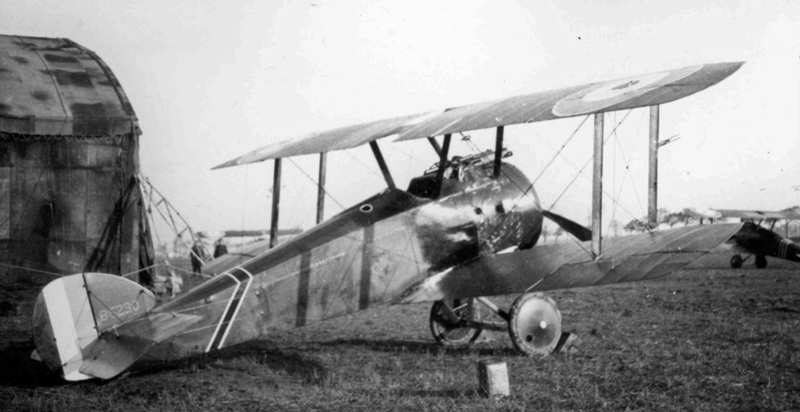
On 23rd November the second prototype ‘7F1 Snipe’ B9963 arrives at Royal Aircraft Factory at Farnborough. There are reports that it is fitted with a prototype 200hp Bentley BR2 engine but that may not yet have happened. The 49hr bench test of a Humber-built BR2 engine completed in mid-October showed it to produce 234hp despite being only slightly larger diameter than the 150hp BR1 with just 20mm extra bore and 10mm extra stroke and the exceptional power to weight ratio of 2.16lb/hp. It has aluminium pistons and aluminium cylinders with internal metal sleeves for lightness and maximum cooling. Its crankcase and detachable cylinder heads are machined to fine tolerances from solid blocks of metal four times their final weight of only 28lbs and 5lb 5oz respectively. It seems so good that the RFC in France consider it suitable for every type of aircraft they need except bombers. Orders are being placed for huge numbers of BR2s and Sopwith have been asked to fit one in this prototype Snipe.
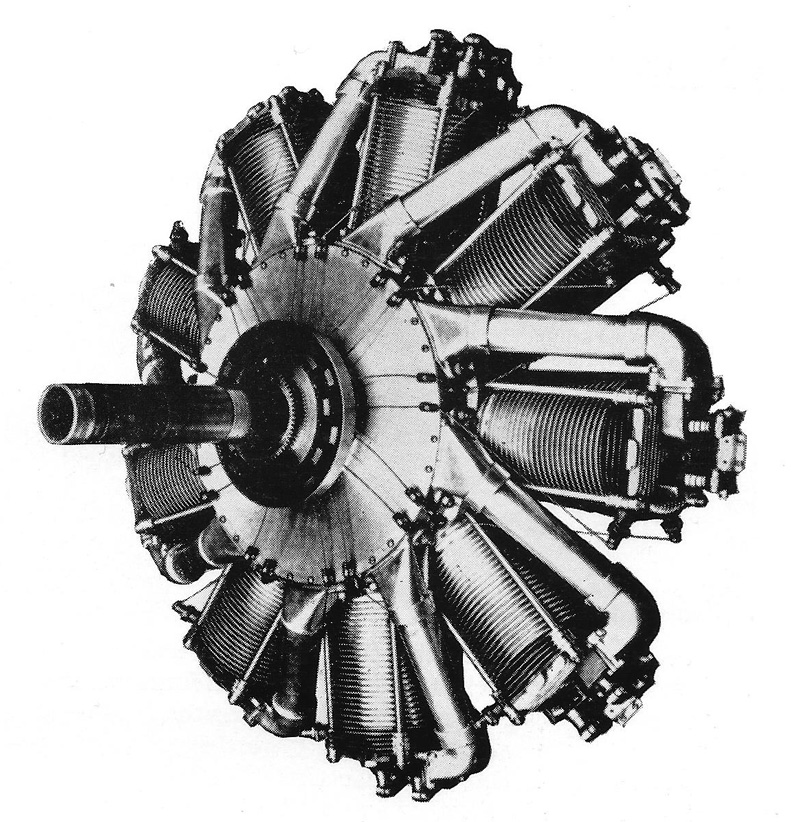
Other prime candidates for BR2s are Sopwith’s two-seat fighter prototypes aiming to replace the ‘Strutter’. The reverse-stagger Sopwith ‘Hippo’ prototype has a 200hp Clerget engine but these engines have not been ordered in any quantity. Now a similar engined Sopwith ‘Bulldog’ two-seater has appeared from the Experimental Shop in Kingston. The ‘Bulldog’(below at Brooklands) has conventional stagger single-bay wings and follows other recent Sopwith designs with the pilot between the top wings and both crew able to see over them. Twin pillars in the rear observer/photographer/gunner’s cockpit can carry pivoted Lewis guns with a flap in front of the forward one to provide some wind protection.
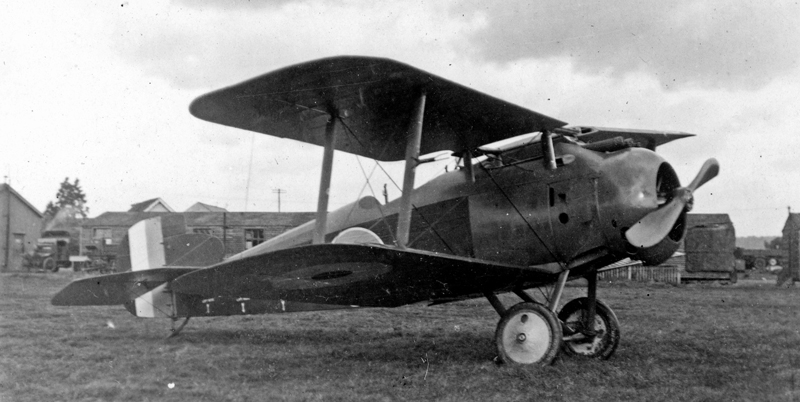
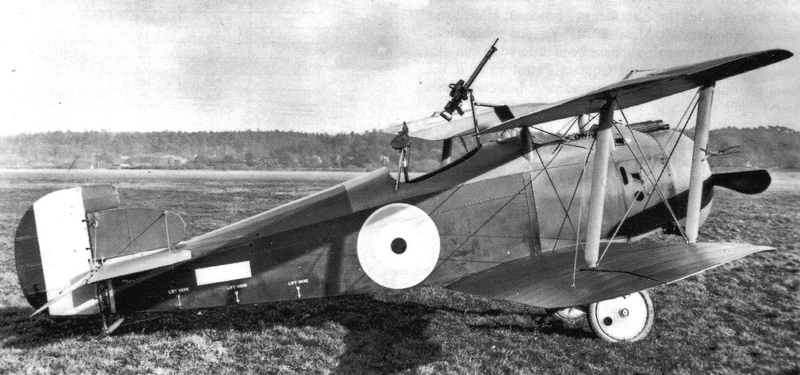
Another powerful air-cooled engine is the ABC Dragonfly designed by Granville Bradshaw of ABC Motors Ltd at Hersham in Surrey. Potentially over 300hp, the development of this 9-cylinder static radial engine design has been handed to Vickers at Crayford but is yet to be tested. The smaller 7-cylinder 185hp ABC Wasp radial is equally promising but also unproven. Through November Sopwith have been working on the design of a compact ‘Snail’ fighter with the ABC Wasp engine. When informed of a potential order for four machines, Sopwith reply that they have applied for a licence for six as “we were given to understand by the Controller of Aeronautical Supplies that he would like us to experiment with two additional machines with a three-ply fuselage”. The Air Board Technical Department has now recommended that the order be increased to six but on 24th November upgrades the already demanding requirement for this three-gun single-seat fighter from 2½ hours endurance at 15,000ft to 3 hours. It is to reach 135mph at that height with a ceiling of at least 25,000ft and take no more than ten minutes to climb from 10,000 to 20,000ft. “It must be able to dive vertically without exceeding 250mph and be very handy to control, with an excellent view for the pilot almost as important as performance and handiness.”
The Sopwith design team are also working on an urgent requirement for an armoured ‘Trench Fighter’ version of the ‘Camel’ and are to get an airframe from another contractor as production is finished in Kingston.
On 24th November the pilot of ‘Camel’ B5240 is wounded in combat and B2459 crashes on landing in high winds which continue with low cloud through 25th November restricting flying. At home Pup’ N6473 has come to grief flying from Cranwell.(below)
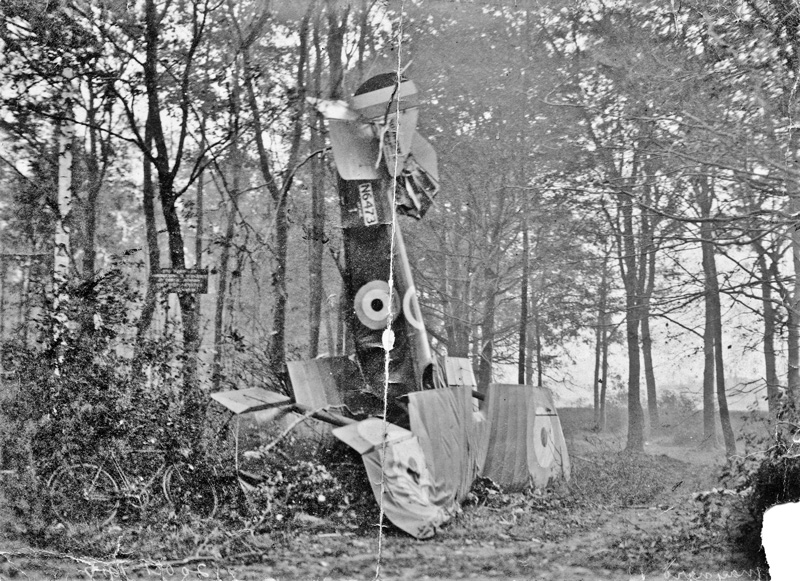
On 26th November ‘Camel’ B6405 forced lands hit by ground fire and B2500 crash lands. At Upavon the pilot of B3804 is killed stalling from 100ft with a choked engine. ‘Triplane’ N5431 claims another victory in the Aegean.
On 28th November ‘Camel’ B6426 claims a victory but the pilot of B2427 is killed in combat, B2452’s is interned after a forced landing in Holland whilst B5248 is damaged crashing onto its nose turning cross wind after landing. At Lopcombe Corner the pilot of ‘Pup’ B5995 is injured when the engine chokes in a turn and it sideslips-in.
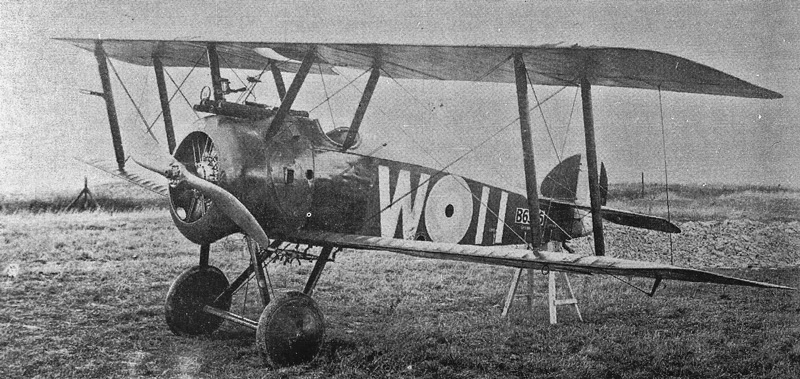
German photographs(above & below) show ‘Camels’ captured last week. Both pilots are prisoners of war. 3Sqdn’s B6385 with under fuselage bomb racks appears intact. B2458 with its hastily applied 65Sqdn white bar markings has a distinctly droopy top wing possibly from damage to wing struts or wires.
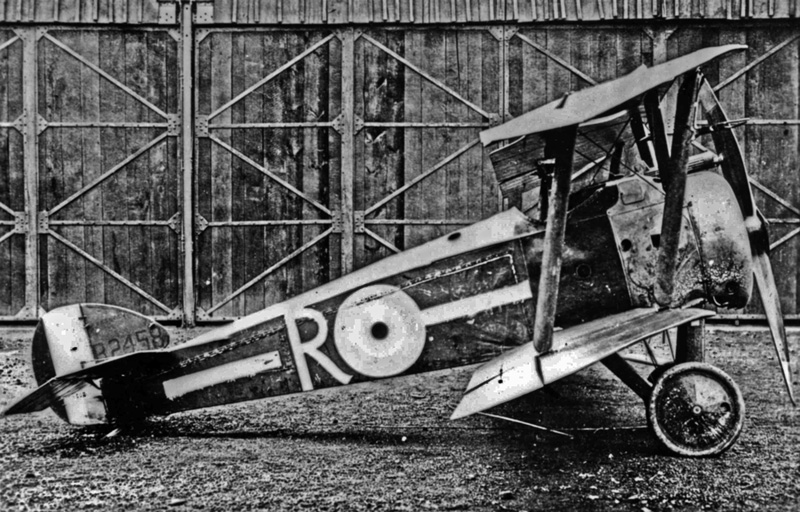
The Belgian Flying Corps (Aviation Militaire Belge) 1st (Thistle) Fighter Squadron has now received its first two ‘Camels’ B5710(tail marked Sk1 below left) & B5711(below right) via the reception and repair unit at Calais/Beaumarais. These are new Clayton & Shuttleworth built machines.
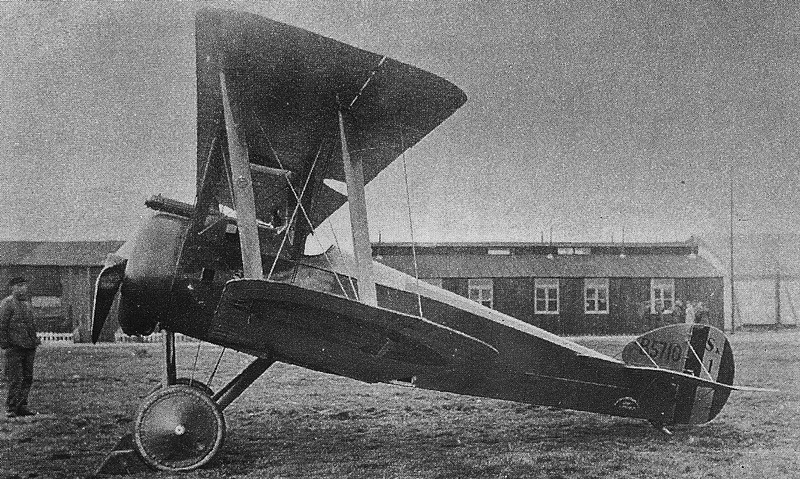
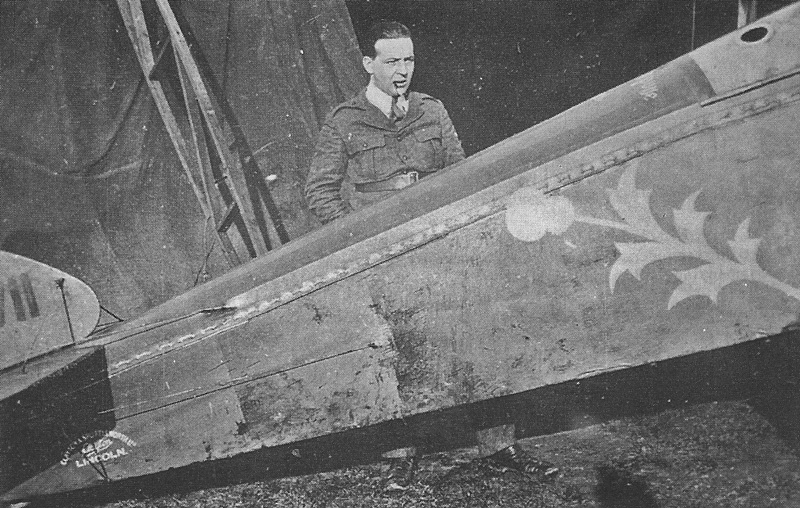
On 29th November 28Sqdn ‘Camel’ B6313 claims a victory in Italy on the first day of operations having only arrived at their base at Grossa yesterday. They are to be joined by 66Sqdn in the next week. Both will immediately be busy with a daily routine of groups of three ‘Camels’ on general offensive patrols from dawn to dusk at 10,000ft over the Piave and Asiago battle fronts where the Austro-Hungarian pilots have gained aerial supremacy helped by German fighter units. In France, ‘Camels’ B6409 & B6420 each claim a victory whilst B2432 crashes into a tree on take-off, B2392 crashes on landing and B3761 overturns on landing. ‘Strutter’ 9744 joins the ‘Camels’ & ‘Pups’ of the Seaplane Defence Squadron at St Pol. Many ‘Strutters’ are still in service with the RNAS not least in the Aegean where 2 Wing have received even more, mostly ‘Strutter Bombers’.(below) N5086 from Stavros recently hit an enemy aircraft’s engine and saw flames but ran out of ammunition before ensuring a rare victory.
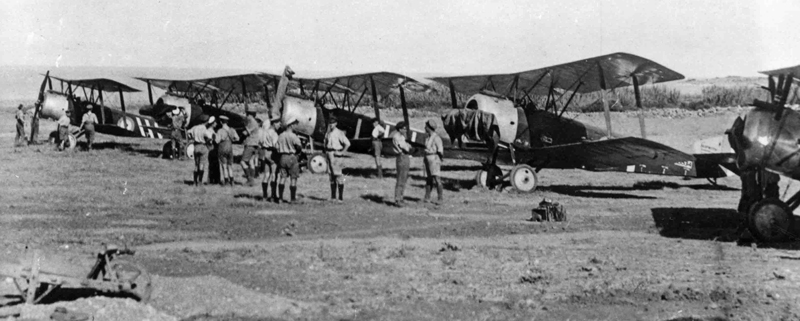
On 30th November ‘Camel’ B2501 claims two victories. B2451, B2454 & B3814 claim one each whilst B6344 claims one in Italy. The pilot of B5177 is killed when the wings fold up on a practice flight, B3789’s pilot dies of his injuries after a spin, B2512’s pilot dies of his wounds after being taken prisoner, B2496 & B6336’s pilots are also taken prisoner during the low bombing raids, B5220’s is wounded by AA fire and crashes on landing whilst B2433 crashes with engine trouble and B3872 loses a left wheel on take-off and crashes on landing.
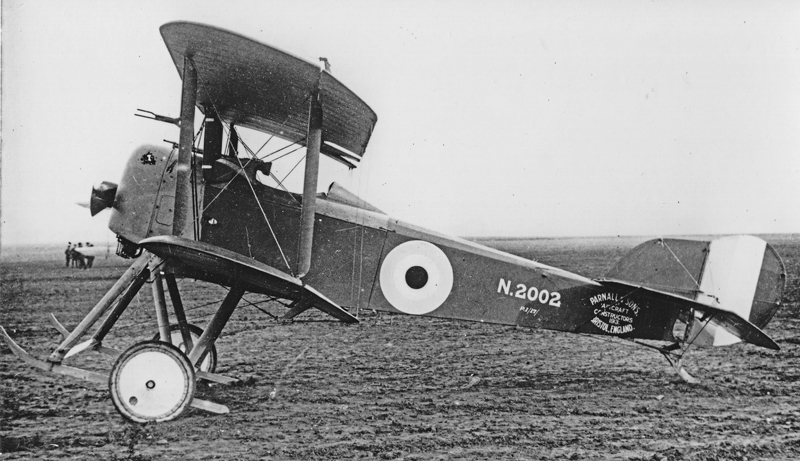
Whilst most are being shipped to Otranto or going straight into holding storage at Killingholme, Parnall are delivering eight of their ‘Fairey Hamble Baby Convert’ landplanes to the RNAS Flying School at Cranwell. They include N2002 posed(above) with a gun, pilot’s head fairing and Sopwith style rounded fin and rudder rather than the rectangular Fairey version. The standard float struts give it a very wide undercarriage and supports for old fashioned looking skids to prevent overturning. With a 130hp Clerget and full span flaperons Cranwell’s student pilots will be able to make interesting comparisons with their 80hp ‘Pups’ and 150hp ‘2F1Camels’.
The Sopwith factory has delivered 67 aircraft in November; their last 5 ‘F1 Camels’, the last 15 ‘2F1 Ships Camels’ and the first 47 ‘Dolphins’.
The total of new Sopwith designed aircraft from all suppliers in November exceeds 500 for the first time with 552 including Sopwith-Beardmore ‘SBIIIs’. The 485 machines from other manufacturers include 119 ‘Pups’ from Standard Motors (57) and Whitehead (62); 26 ‘SBIII Folding Pups’ from Beardmore; 1 ‘Triplane’ from Oakley; 282 ‘Camels’ from Boulton & Paul (79), British Caudron (their first 5), Clayton and Shuttleworth (37), Hooper (19), Portholme (17), Ruston Proctor (125) plus 27 ‘Baby’ floatplanes from Blackburn and 30 ‘Fairey Hamble Baby’ floatplanes from Fairey (9) and Parnall (11 floatplanes and 10 ‘Convert’ landplanes). These figures again exclude Sopwith’s prototype machines and hundreds of ‘Strutters’ being built overseas.
New orders for Sopwith aircraft in November include a first order for 50 ‘Camels’ on Beardmore, a further 100 ‘Camels’ from Ruston Proctor and a further 200 ‘Dolphins’ from Sopwith Aviation.
On 1st December B2191 claims a last ‘Pup’ victory for 46Sqdn before switching to Camels. ‘Camels’ B2364 & B2454 crash on landing. Still active after nearly two years in the Aegean, 100hp ‘Schneider’ floatplanes 3772 & 3793 move to Mitylene.
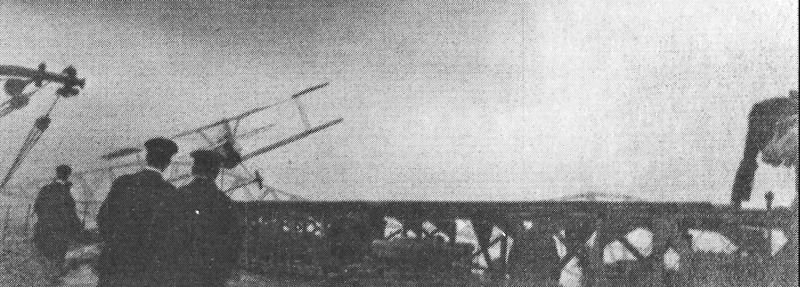
The Navy are determinedly continuing their experiments with launching aircraft from fixed troughed ramps on capital ships’ decks despite many pilots’ advice. On 1st December Beardmore-built ‘Ship’s Pups’ N6443 & N6448 attempt take-offs from HMS Renown with the arches of the Forth Bridge in the distance. Caught by the wind or interference with the sides of the trough, there is little the pilot can do to control N6448(above) and it ends up capsized in the sea before the pilot is rescued(below) and it sinks. Then N6443 is recorded as ditched after a take-off implying it did get into the air.
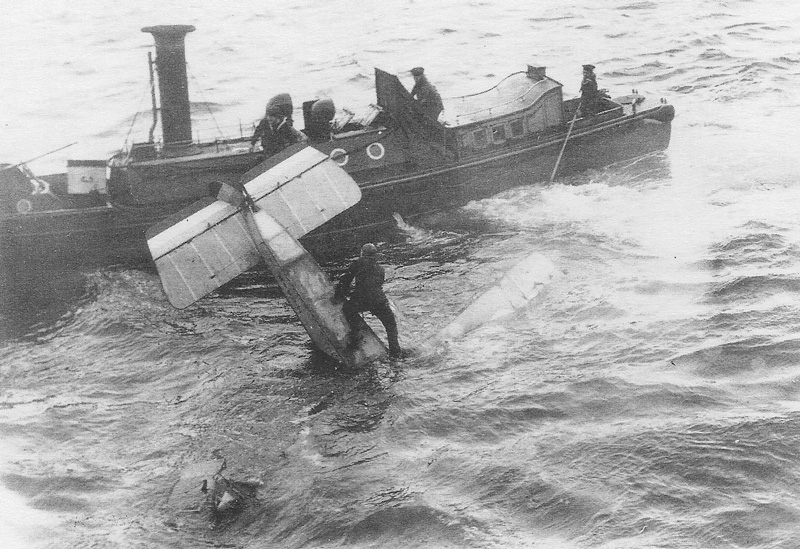
Sopwith-Beardmore “SBIII Folding Pups” are also now being allocated to HMS Renown and HMS Nairana. N6115 is photographed with wings folded on one of their trough ramps.(below)
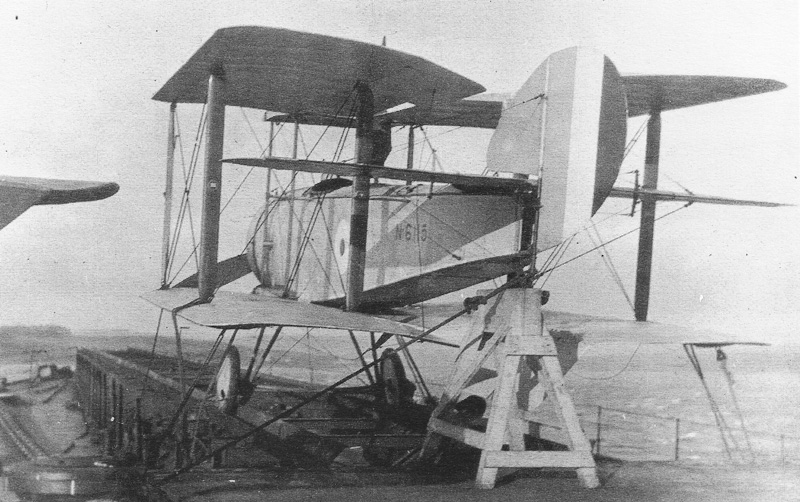
On 2nd December ‘Camel’ N6365 claims a possible victory in the Aegean whilst B2338 suffers an engine failure.
On 3rd December ‘Camel’ B6313 claims a victory and forces a kite balloon down before setting fire to it on the ground. Calshot and Lee-on-Solent ‘Baby’ floatplanes 8210 & N1024 are both deleted recently “wrecked”.
On 4th December Cranwell ‘Strutter’ N5632 is damaged in a crash. The pilot of Chattis Hill ‘Pup’ B6018 is injured after it collapses in mid-air and spins in, N6180’s pilot is injured crashing into a cemetery near Dover, B5974 forced lands on route to repairs, B6001 ground loops and overturns whilst N5188 forced lands on a beach with engine failure. ‘Triplane’ N5380 is also crashed returning to Dover. ‘Camels’ B6398 & B6419 each claim a victory, B6357 shares a victory with N6335 whilst B6358 claims a kite balloon but then forced lands lost in fog and out of fuel. After two years in service 100hp ‘Baby’ floatplane 8145 is salvaged after capsizing in Dover harbour and the pilot of another, misreported as 8182, is picked up by a torpedo boat after crashing into the sea off Grain.
On 5th December ‘Strutter’ N5210 is recorded wrecked at Lemnos. ‘Camels’ B2447, B3821, B6229, B6357 & B6428 each claim a victory whilst B2518 shares one with B2435, B5663 shares one with B6320, B6278 shares one with B6340 whilst B6391 shares one with B6357, B6407 & N6335. The pilot of B5173 dies in a mid-air collision with B5407, B2470’s pilot is killed shot down in flames, B6234’s pilot is taken prisoner and B2370’s pilot is injured crashing on take-off. B2396 & B3810 crash after engine failure on take-off, B2501 is wrecked stalling on take-off whilst B6413, B2379 & B5212 also all crash.
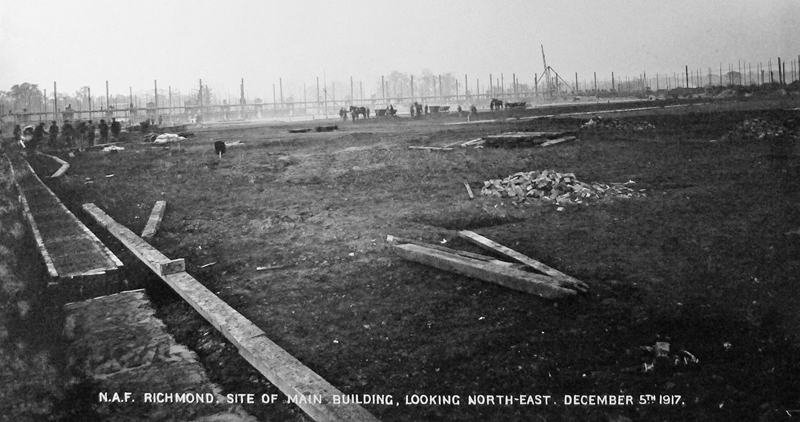
On 5th December Dick, Kerr & Co submit their third photographic record of progress with the building of National Aircraft Factory No.2 at Ham this time looking north-east on a misty day(above). It includes three cart horses pulling pairs of small tipper wagons. The first brick outer curtain walls are up to windowsill level on the north side.
Overnight on 5th & 6th December after five weeks of bad weather, two still secret Staaken Giant and nineteen Gotha bombers set out to attack London. The Giants and sixteen Gothas reach Britain and most of the bombs fall on Kent. Three Gothas get as far as London where the incendiaries again do not create the expected conflagrations. Eight people are killed and 28 are injured. Among 34 home defence sorties are six ‘Camels’ and four of 78Sqdn’s converted ‘Comic Strutter’ night fighters: A6906, A6907 A5259 & A8781. There are no successful aircraft interceptions but two Gothas crash-land in Britain hit by AA fire.
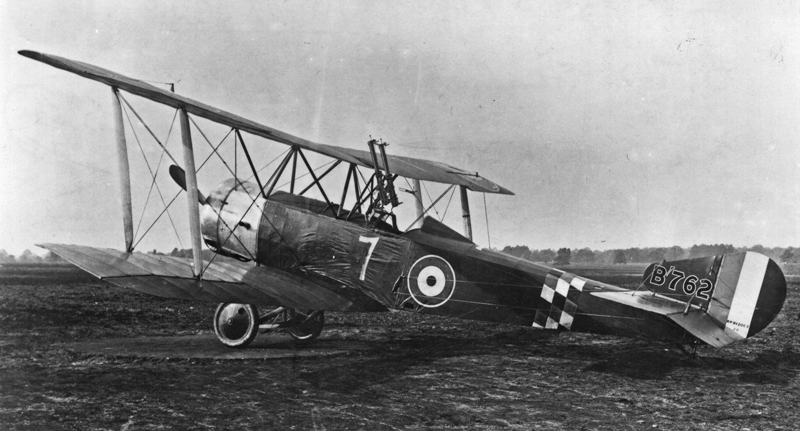
78Sqdn’s first converted ‘Comic Strutter’ B762 has been fitted with twin upward firing Lewis guns(above) although most have a single Lewis gun (below) and some retain their forward firing Vickers gun.
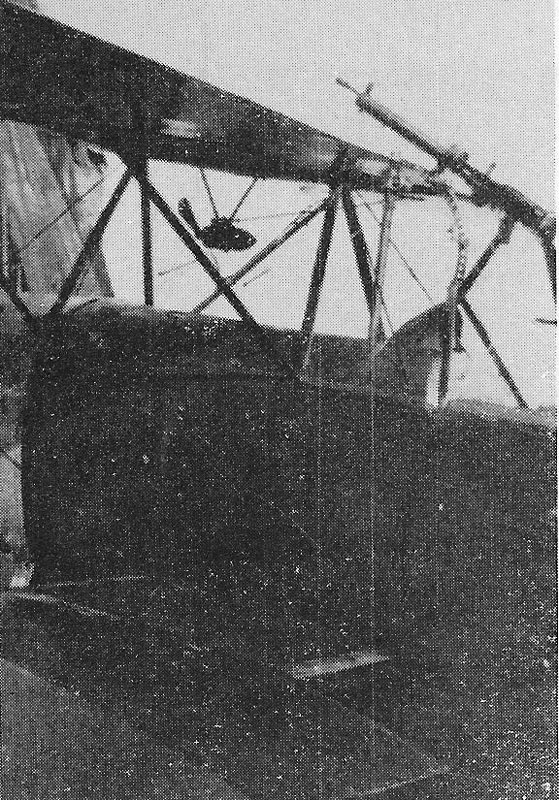
On 6th December ‘Pup’ 9497 continues skid landing trials on the dummy ship’s deck at Grain. The pilot of ‘Pup’ B6019 is injured when it collapses in the air and spins-in. ‘Triplane’ N5380 has crashed returning to Dover from 12(N)Sqdn. ‘Camels’ B6370 & B6398 each claim two victories whilst B6386, B6389, B6428 & B6431 each claim a victory, B6228, B6317, B6318 & B6340 each share a victory with other aircraft and B6418 claims a possible victory. The pilot of B2464 is killed shot down on a special mission, B6350 overturns taking-off in the strong winds whilst B3931 is damaged landing when lost on its delivery flight to Grossa in Italy. The four naval squadrons score eleven of today’s twelve ‘Camel’ victories, including three by 8(N)Sqdn seen lined at Mont St Eloi.(below)

On 6th December there is confirmation of the order for four 185hp ABC Wasp radial-engined Sopwith ‘8F1 Snail’ single-seat fighters plus two built with plywood fuselages. There are also proposals to fit an ABC Wasp in a ‘Pup’.
On 7th December a trainee pilot is killed in ‘Pup’ B2246 in a spinning nose-dive from 200ft. ‘Camel’ B2593 claims a victory, the pilot of B5577 dies of his injuries whilst B2448 & B5176 both crash. This brings an end to the battle of Cambrai and a re-think about the wisdom of routine low-flying attacks on German infantry which has seen the loss of so many highly-trained courageous and valuable pilots.
On 7th December Maj Sanday reports that twelve of his 19Sqdn pilots have tried the fourth prototype ‘Dolphin’ B6871 although the weather has ruled out any lengthy testing. The pilots are “delighted with it” and the view is “perfect”. “It seems to handle perfectly at all altitudes. It is stable and can be flown hands-off for long periods although it seems to feel the effects of strong and rough winds during the first 2,000ft rather more than the Spad.” 19Sqdn is to be the first RFC ‘Dolphin’ Squadron starting to receive the new machines later this month.
Sopwith have been asked to fit a ‘Dolphin’ with an ungeared Hispano Suiza V-8 engine which increases the power from 200 to 300hp. To be known as a ‘Dolphin II’, this machine is for the French who are considering large-scale production of the type for themselves and American fighter units. The engine has not arrived and Sopwith are sending the aircraft to Paris to have a French engine fitted under the watchful eye of Sopwith’s Paris office.
On 8th December ‘Pup’ N6443 is possibly the first to fly off the turret ramp of HMS Repulse. ‘Camels’ B2363, B6370, B6388 & B6420 each claim a victory but the pilot of B4604 is taken prisoner whilst B6365 forced lands and is reported missing in action but the pilot eventually gets back. The pilot of B4604 is the first lost in combat in Italy crashing injured and taken prisoner whilst B2363 claims a victory and B2303 shares one with B6406.
On 9th December the pilot of ‘Pup’ B2239 is injured crashing with a stalled engine and B1822 crash lands. In Italy ‘Camel’ B5172 claims a victory but the pilot of B2445 is injured crashing just outside the airfield. In the Aegean ‘Camel’ B6254 attacks enemy two-seater over Imbros and hits the observer before running out of ammunition.
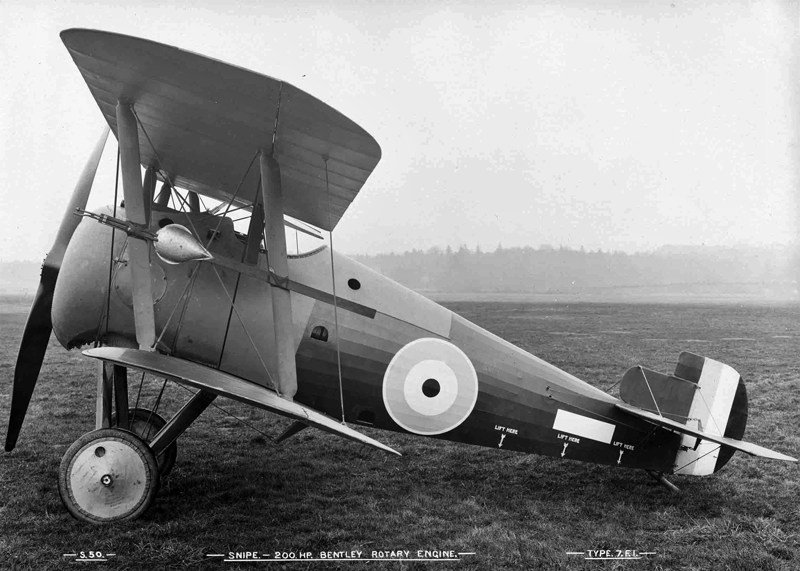
Prototype Sopwith ‘Snipe’ B9965 has been repaired after crashing at Brooklands on 19th November. It has been fitted with a 230hp Bentley BR2 engine and is back there on test.(above ) This machine still has single bay wings but now with outward sloping cabane struts. It has a round faired fuselage right back from the engine, smaller fin and balanced rudder and is photographed with a direct reading airspeed indicator across the port wing struts.
On 10th December the Fl Cdr pilot is killed and the observer injured when ‘Strutter’ N5618 side-slips to a crash landing at Gliki air station on its way to Salonica “to visit RFC Headquarters and do some shopping”. ‘Camels’ B2451 & B6406 each claim a victory whilst B2433, B3818 & B5299 each share one with other aircraft, B6357 reports sending an aircraft nose diving possibly in flames but it could have been a reflection of the sun. B2389 crashes.
On 10th December Martlesham Heath report on the first 16 hours flying of ‘Camel’ B6329 with a 150hp Monosoupape Gnome engine.(right) “The engine has given no trouble and there is no vibration at full speed.” The four position selector for engine throttling is “very satisfactory” except for position 1 where there is a jerk as the engine runs on just three cylinders per two revolutions, position 2 gives five cylinders, 3 gives seven cylinders and 4 the full nine cylinders firing per two revolutions. The petrol pump “automatically to a certain extent” cuts down the petrol flow at the slower speed settings but if there is too much pressure in the fuel tank the engine will start to run rich. “An adjustable pressure relief valve has been fitted but it is more economical to cut down the petrol at slower engine speeds with the fine adjustment.” “The performance of this machine is about the same as the best performance of the 110hp Le Rhone and 5.7:1 compression Bentley BR1 engined ‘Camels’ with a full military load and with its complete absence of vibration is a great improvement on the 130hp Clerget ‘Camels’.
In France, Trenchard has run out of patience with the poor performing 130hp Clerget engines and demands that 80Sqdn comes to France in January with ‘Camels’ with 110hp Le Rhône engines. He goes on to demand that three existing ‘Camel’ Squadrons should have Clergets replaced by Le Rhônes by the end of February.
On 11th December ‘Camel’ B6320 has its wheels and axles shot off strafing trenches and crash lands. Prototype Sopwith ‘B1’ bomber N50 crashes on landing at Grain and is scheduled to be fitted this month with a 200hp Bentley BR1 (sic) engine in place of its 200hp Hispano Suiza.
On 12th December the pilot of ‘Strutter’ A5955 from 62 Training Squadron at Dover is killed flying low and hitting a house. ‘SBIII Folding Pup’ N6111 is wrecked. ‘Camels’ B2311, B2499 & B6299 each claim a victory whilst B2416 shares two victories with B2487, the pilot of B2417 is killed, B2446’s dies of his injuries whilst B3842 is damaged beyond repair in a crash landing and B5424 crashes soon after take-off with the pilots foot jammed under the rudder bar, he escapes uninjured. Also this day, the very first production ‘Camel’ N6330 is shot down after 7 months in RNAS service and the pilot is taken prisoner
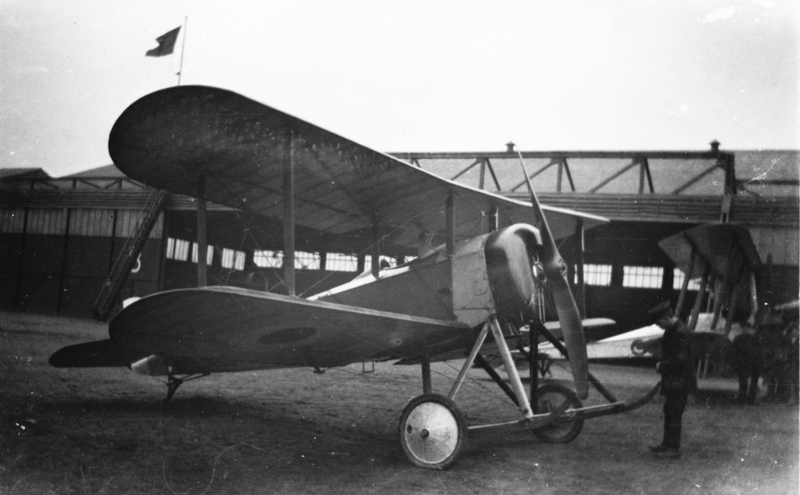
Photographs have emerged of one of the eight Parnall-built ‘Hamble Baby Convert’ landplanes now at Cranwell N1997 clearly showing the wide undercarriage, forward skids, headrest and full span flaperons. (above and below)
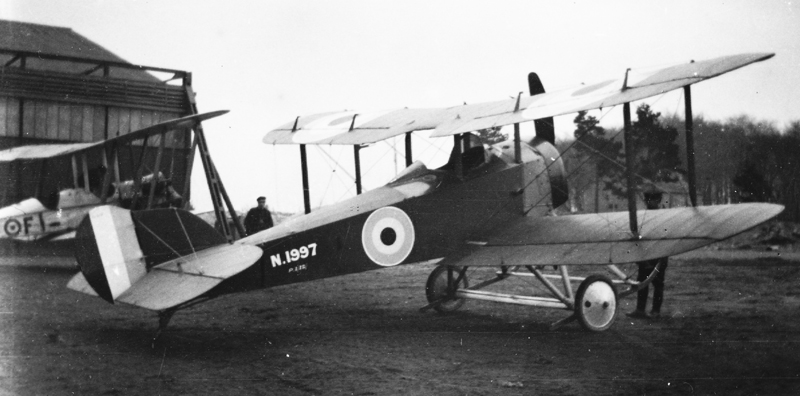
On 13th December the pilot of ‘Camel’ B5209 is taken prisoner after several forced landings with a failed fuel pressure pump. The pilots of B2536 from Gosport and B5678 from Cranwell are killed in crashes.
On 14th December ‘Camel’ B6326 claims a victory whilst in Italy B6406 is forced to land with engine failure and B5401 overturns in a crash landing. Recently crashed ‘Strutter’ N5175, like Cranwell’s 9398 & N5630, is deleted from service “as obsolete” rather than be repaired.
On 15th December ‘Ships Pup’ N6445 is lost overboard from HMS Princess Royal in a heavy squall. ‘Pup’ B5341 crashes after an engine failure. ‘Camels’ B2392, B2450, B2520 & B6424 each claim a victory. The pilot of B2519 is injured after an engine failure, as is the pilot of B2517 which crashes landing from a night raid and the pilot of B5420 which crashes avoiding another aircraft on the airfield whilst B6273 ends on its nose after an engine failure on take-off. The pilot of B5401 is injured crashing in Italy.
The first of only two RNAS ‘Dolphins’ C3686 is now the first Dolphin in France with 1(N)Sqdn whilst the first RFC ‘Dolphins’ are arriving with 79 Sqdn at Beaulieu in the New Forest and others are heading for 19Sqdn in France. The thorough testing of ‘Dolphins’ at Martlesham Heath has been plagued by Hispano Suiza engine problems. The third prototype has suffered a broken con rod but is now at Orfordness on gunnery trials whilst C3777 is awaiting a replacement for a broken reduction gear and C3778 is also unserviceable with engine issues.
Despite the rejection of the Hispano Suiza powered ‘B1’ bomber in favour of the DH4, the Sopwith experimental team are building a second very similar machine ‘B2’ B1496 which is due for completion in January. The experimental team in the old skating rink in Kingston are always busy. The 200hp Clerget-powered ‘3F2 Hippo’ two-seat fighter first tested in September has been strengthened and has a new set of two-bay back-staggered wings. Tests at Brooklands of the similar ‘2FR2 Bulldog’ which has single-bay forward-staggered wings (below) have found it difficult to fly and not to have as good performance as the ‘Hippo’. It is also now to be modified with new wings.
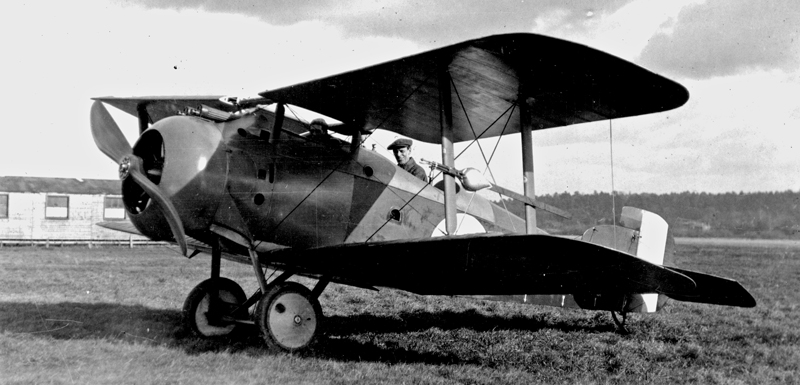
On 16th December ‘Camel’ B5171 claims a victory but after yesterday’s victory B2450 makes a forced landing in a shell hole. B2360 crashes on landing. In Italy B3931 shares a victory with B5223 whilst B2461 forced lands.
On 17th December a pilot flying ‘Strutter’ N5229 or ‘Baby’ N1464 dies of his injuries crashing at Padua. ‘Camel’ B5204 crashes on landing. ‘Triplane’ N5361 is to go into the War Museum Exhibition at the Royal Academy.
After recent heavy losses during ground strafing, a top level meeting on 17th December discussing new aircraft types for the Aeronautical Programme through to the summer of 1919 suggests that 15 Squadrons of BR2 engined single-seat armoured fighters will be required and that “5 Squadrons of possibly a modified Camel be completed by summer 1918 as a temporary measure”. Sopwith are already designing modifications for an armoured Camel and have started designing an armoured version of the BR2 engined ‘Snipe’.
On 18th December the repaired BR2 engined prototype ‘Snipe’ B9965 arrives at Martlesham Heath.
By 18th December the last two RFC ‘Pup’ squadrons in France have re-equipped with ‘Camels’, the only ‘Pups’ remaining in France being a few with the Seaplane Defence Flight. Despite its replacement in front line service, in the last few days Whitehead Aircraft of Richmond have received an order for 200 more ‘Pups’ bringing their total to 750. This brings total orders for ‘Pups’ including 100 ‘SBIII Folding Pups’ to 1946 aircraft although at least 70 of those have so far been delivered unassembled as spares.
On 18th December ‘Camel’ B9166 claims two victories, B2418 claims one possibly two and B6426 claims one. The pilot of B2410 is killed in combat and the pilots of B2388, B6271 & B6425 are taken prisoner. B6413 is hit by AA fire and crashes with a wheel shot off, B2463 & B5247 both land-out lost and crash on re-landing, B5223 crashes on take-off whilst B5652 & B5666 both also crash. At home the pilots of B2378 & B6268 are killed spinning in.
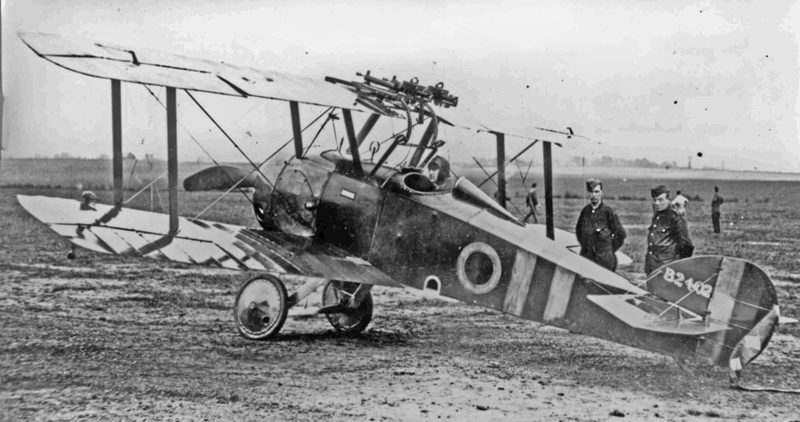
Overnight on 18th & 19th December one Staaken Giant and fifteen Gotha bombers set out to attack London but again many bombs are dropped on Kent. The Giant and six Gothas get as far as London. There is considerable property damage, 14 people are killed and 83 are injured. Among 47 home defence sorties are eight of 78Sqdn’s converted ‘Comic Strutter’ night fighters, one of which writes-off its undercarriage on landing. Also on duty are seven 44Sqdn ‘Camel’ night fighters including ‘Comic Camel’ B2402(above) Capt Murlis Green in the possibly similar modified B5192 at his fourth attempt uses its two upward firing Lewis guns to become the first to disable a Gotha at night. It ditches off Felixstowe and explodes whilst being towed in. Other ‘Camel’ pilots also experience gun jams and being tossed into spins in Gothas’ slipstreams but may have scored hits as two Gothas are destroyed by fire on landing and five are damaged.
On 19th December the pilot of ‘Strutter’ A1014 is killed in a flying accident and his observer injured. Two more of 12(N)Sqdn’s two-gun ‘Triplanes’ N543 & N544 are deleted as “damaged beyond repair” leaving them just one of the six two-gun ‘Triplanes’ that were built but they do have some ex-French ‘Triplanes’ in service and now have a few ‘Camels’. ‘Camel’ B5179 claims two victories, B3890, B6351, B6390 & B6407 each claim one, B2447 shares one with B6426, the pilot of B5403 is injured crashing on landing, the pilot of B3946 loses his goggles and breaks a tail skid on landing, B6208 crashes into a plough in a forced landing and B2363 crashes landing in heavy mist. In Italy the pilot of B6425 is taken prisoner crashing after his controls are shot away at 3,000ft by AA fire.
This week’s Sopwith Board Meeting approves a gift of £100 to Mr l J Fowler for “materially increasing the production in the Company’s Kingston Works” and an increase to the salary of Company Secretary & Organising Manager Mr H P Musgrave to £1,000 p.a. plus a back-paid commission of ¼% of the net profits of the Company.
Although there may be some final adjustments to the Sopwith Aviation Co Ltd accounts for the financial year to 30th September 1917 before the January Annual General Meeting they are obviously pleased with the outcome with continued rapid business growth and high profits. The value of sales of aircraft and parts is showing an extraordinary year-on-year increase of 250% reaching around £1,100,000. With the addition for the first time of income from royalties the total company income could be over £1,150,000. It seems that profit will be around 25% which, even after paying 60% Excess Profits Tax on the majority, should leave more than enough to continue to entirely self-finance the rapid growth of the business and pay dividends on the 32,000 company shares to Thomas Sopwith and three of his sisters.
The biggest single difference in the accounts this year is a nine-fold increase in sub-contract costs which now amount to 36% of the total manufacturing costs. Most other costs including wage and salary bills have risen by 2 to 2.2 times the previous year suggesting an internal company growth of that amount bolstered to 2.5 times the previous throughput by this significant sub-contracting. A large increase in commission payments mirrors the growth in sales. General Manager Reg Cary’s commission on sales passes the salary being taken by Thomas Sopwith himself whilst Fred Sigrist gets half that commission, still a large amount. Harry Hawker and Chief Designer Herbert Smith are among those who have had significant bonuses through the year. They are now to also receive a back-paid commission of 1% and ½% of the 1916/17 profits.
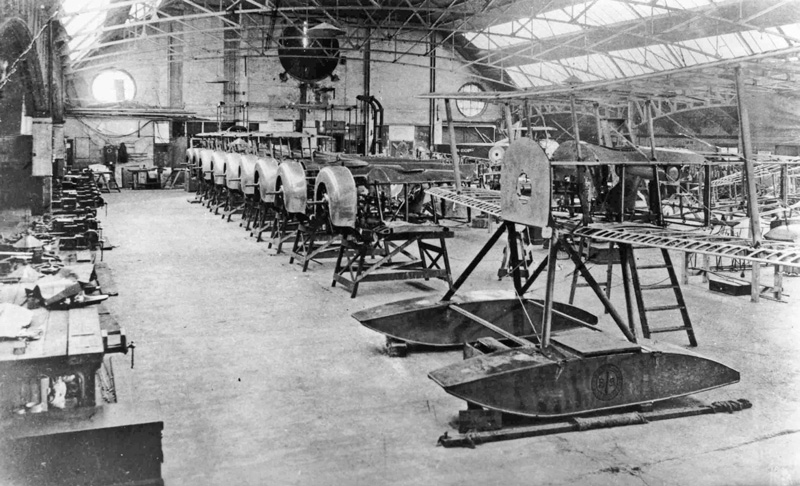
The Blackburn Aircraft Co factory in the Central Hall ex-roller skating rink in Leeds is still turning out Sopwith ‘Baby’ floatplanes(above & below), although they are coming to the end of their Admiralty orders for 186 machines with just thirty to deliver in the New Year. Photographs show the wide curved roof and two-seat BE2s being assembled back to back with the floatplanes. There are now enough ‘Baby’ floatplanes built for six delivered new into storage at Killingholme in mid-October to be deleted from service and broken down for use as spares.

‘Baby’ floatplanes are not very easy to move around, a Blackburn-built machine possibly N1639 is pictured(below) being man-hauled up the slipway at Dundee on a launching trolley. It has a synchronised machine gun.
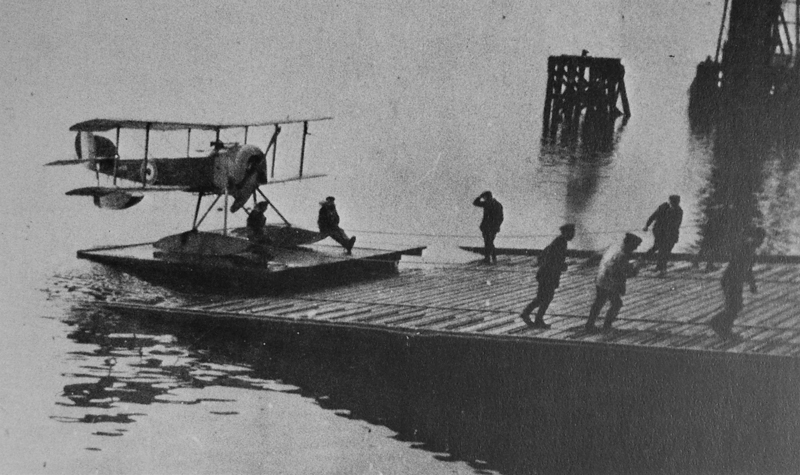
On 20th December the pilot of one of the ‘Camels’ recently delivered to the Belgians dies of his wound after being hit by AA fire. ‘Pup’ N6109 has had another unsuccessful attempt to fly from the troughed ramp on HMS Renown.
On 21st December ‘Strutter’ N5167 is deleted after crashing on landing at Cranwell. ‘Pup’ B2214 is crashed and wrecked. N6468 is now fitted with a skid chassis and deck landing gear whilst prototype ‘Pup’ 3691 is to go to the USA for Lady Drogheda’s exhibition of British Armament. ‘Camel’ B2310 crashes after getting lost in fog.
On 22nd December ‘Camel’ B6251 claims two victories, B6299 claims one and another possible, B3910, B6231 & B6384 each claim one, B2465 shares one with B2520 whilst B6351 shoots a kite balloon forcing the observer to bale out. A pilot is killed in a ‘Camel’ at the Central Flying School and B9166 makes a forced landing.
On 22nd December after a review of air raids and the best night fighters, 6 Brigade’s Higgins reluctantly concedes that the latest two-seat pushers still come nowhere near the speed and climb rates of the tractor fighters, “of which the only one approaching the ideal is the Sopwith Dolphin”. He lists modifications being made to a Dolphin at the Sopwith factory to make it more suitable for night flying with minimum impact on performance. These include 4o dihedral, more wing incidence, an adjustable incidence tailplane, protective hoops above the top wings and stronger landing wheels. He dismisses 130hp Clerget ‘Camels’ “which lose height badly in turns above 14,000ft” but recommends 110hp Le Rhône ‘Camels’ being crucially “less sensitive to throttle adjustments”.
Overnight on 22nd/23rd December there is another bombing raid on Britain. The starboard engine of a Gotha stops on the stormy sea crossing. With severe vibration the crew jettison the bombs and land on a farm south of Margate before setting fire to the aircraft with a single signal cartridge. Three Giant bombers also set out. One diverts to bomb Boulogne in the bad weather and the other two claim to attack shipping dropping bombs harmlessly into the sea off Ramsgate. Eighteen home defence sorties are flown including six ‘Camels’ from Hainault and four of the ‘Comic Strutters’ from Sutton’s Farm.(below) Unsurprisingly there are no interceptions.
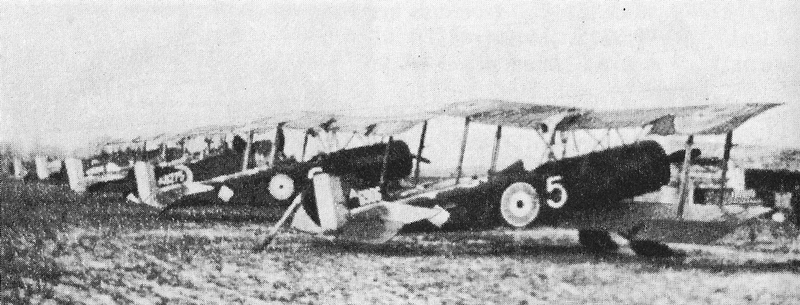
On 23rd December 220hp Bentley BR2 engined prototype Sopwith ‘Snipe’ B9965 is crashed after just five days at Martlesham Heath. A preliminary report is written pending its repair. After warning that the tests were done with no ammunition on board and with speeds taken from an uncorrected air speed indicator, it quotes figures of 125pmh at 12,000ft, 119mph at 15,000ft taking 7mins to reach 10,000ft and 24mins to reach 15,000ft. In rebuilding this machine Sopwith can consider incorporating significant changes to the design which allow full use of this much more powerful engine including two bay wings and different tail surfaces.
On 23rd December ‘Camel’ B6426 claims a victory, whilst the pilot of B6201 is killed in a spinning nose dive after losing control in mist and cloud. B2392 & B5653 also crash whilst B6366 makes a forced landing.
On 24th December over Macedonia the pilot of ‘Strutter’ N5618 is fatally wounded in combat but manages to crash-land the machine and save his wounded observer. The pilot of ‘Camel’ B9165 is killed after losing control at low altitude whilst B3935 overturns on landing.
On 25th December very little flying is possible in France due to snow and mist and there are no reported incidents.
On 26th December despite snow storms and high winds ‘Camel’ B2447 shoots a two-seater down in flames. In Italy, B2303 shares a victory with several Italian fighters, B5183 & B6345. B6364 shares a victory with an Italian fighter whilst the pilots of B2400 & B5407 are injured crashing after engine failures.
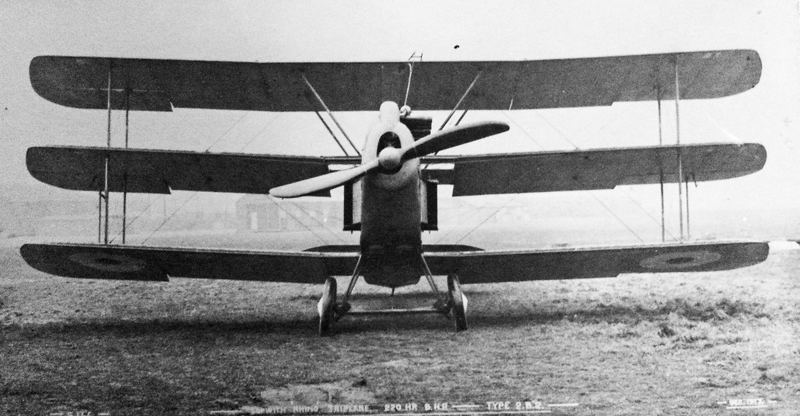
The 220hp BHP-engined two-seat ‘2B2 Rhino’ triplane bomber is back at Brooklands(above & below) with the nose heaviness corrected, without the extended ailerons and showing off its six stub exhausts and flank radiators with their blanking flaps. Flight tests are “very promising” but it is still overheating and awaiting even larger radiators.
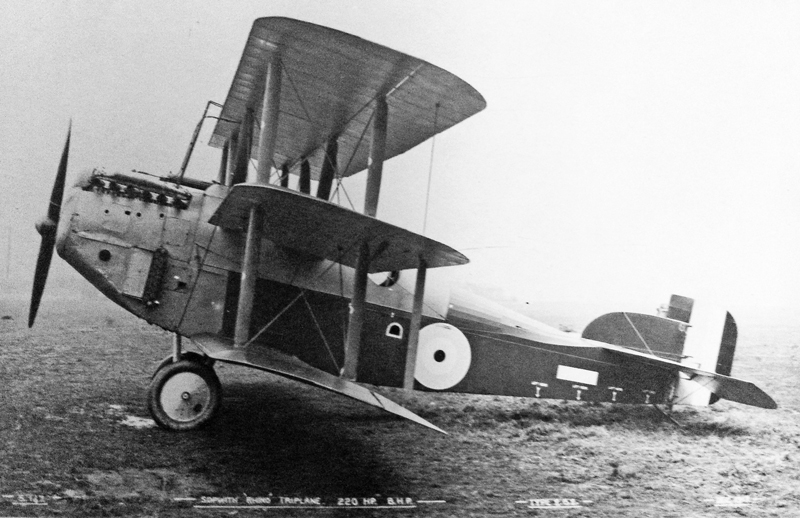
‘Pup’ B5259 named “Monkey”(below) is one of the very few with a 110hp Le Rhône engine. Rejected by the RFC in France as not safe for combat use it has arrived at 56 Training Squadron at London Colney. The extra size of the Le Rhône is accommodated in a crudely fabricated segmented cowling. The headrest and overwing Lewis gun indicate that it could be used for their daytime home defence duties but recent German raids are all at night.
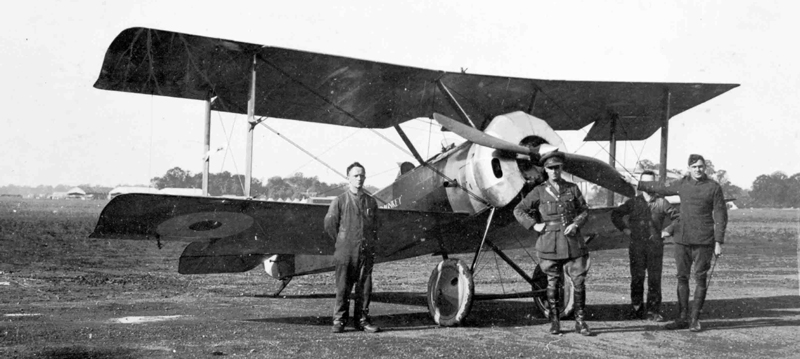
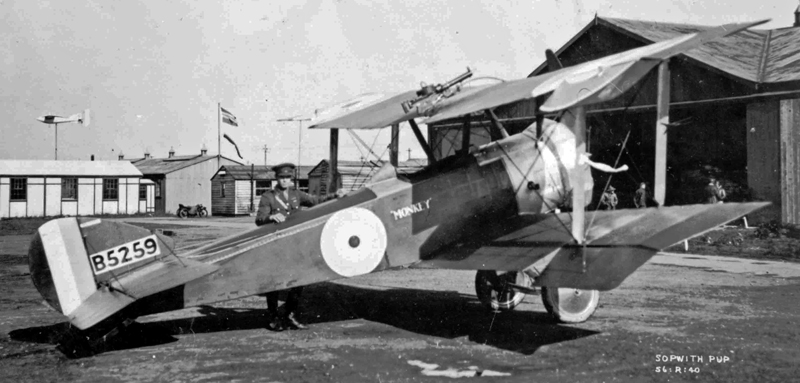
On 27th December ‘Camels’ B2499 & B6426 each claim a victory, B6228 shares one with B6379, a 94Sqdn pilot is killed and B5557’s injured choking the engine on take-off and spinning into trees.
On 28th December ‘Camels’ B2311, B6319, B6426, B6447 & N6356 each claim a victory whilst B2429, B2438 & B2487 each share a victory with others. B2495 claims a possible victory before engine failure and a crash landing, B5418 also crashes after engine failure, B2360 breaks an axle on landing and goes on its nose, B2368 crashes on landing whilst B6350 is overturned by a strong gust while taxiing. At Shawbury the trainee pilot of B5154 is killed spinning-in. In Italy ‘Camel’ B2461 shares the collapse of a kit balloon in flames with B6313 & B6362. In their first month of action in Italy 28Sqdn & 66Sqdn ‘Camels’ have destroyed thirteen enemy aeroplanes and two kite balloons and driven down six other enemy aircraft for the loss of two aircraft. Four days ago 45 Squadron became the third ‘Camel’ squadron in Italy when they arrived at Istrana aerodrome.
On 29th December the pilot of ‘Pup’ B877 is injured hitting a tree with a choked engine and the pilot of ‘Camel’ B2888 is killed diving after losing control in clouds. In Italy B2461 shares a victory with B6362.
The second ‘Dolphin’ C3785 is delivered to the RNAS. After initial testing some three months ago, modifications to the 220hp Clerget ‘Hippo’ two-seat fighter with back staggered wings has been delayed with so many other prototypes being rushed through the experimental shop, not least its direct competitor the ‘Bulldog’ with which it may have been sharing an engine. However the ‘Hippo’ has now been strengthened and got a new set of wings and has finally arrived at Martlesham Heath for official tests.
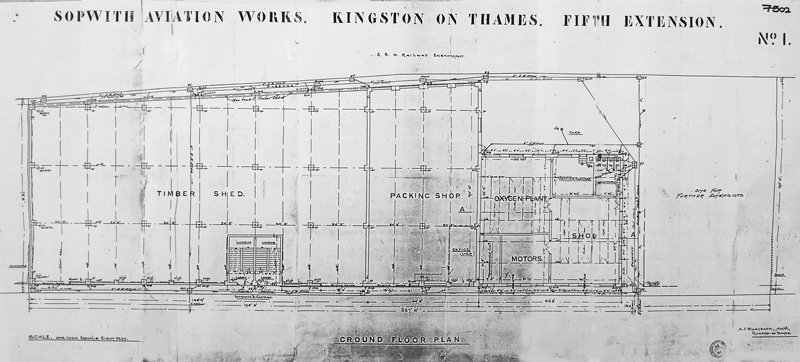
On 29th December architect A J Windybank submits a revision to the plans for the fifth extension of the Sopwith Factory in Canbury Park Road, Kingston backing onto the London and South Western Railway. It notes that the large Timber Shed/Packing Shop building with canteens on the first floor is under construction but adds a motor garage, small workshop and oxygen plant room on the west end. It also references a similar sized plot alongside as “for further development”. Sopwith Aviation have bought and are demolishing 26 cottages to construct this factory expansion along the south side of Canbury Park Road.
On 30th December the pilot of ‘Camel’ B2532 is killed crashing after a succession of forced landings with engine problems. In Italy ‘Camel’ B2461 shares a victory with B6364.
On 31st December ‘Pup’ 9925 overturns on landing at Cranwell and B2230 crashes near Hounslow. ‘Camel’ B2526 crashes in France whilst in Italy B6412 claims a victory, B2430 shares a victory with B6238 whilst B3862 makes a forced landing.
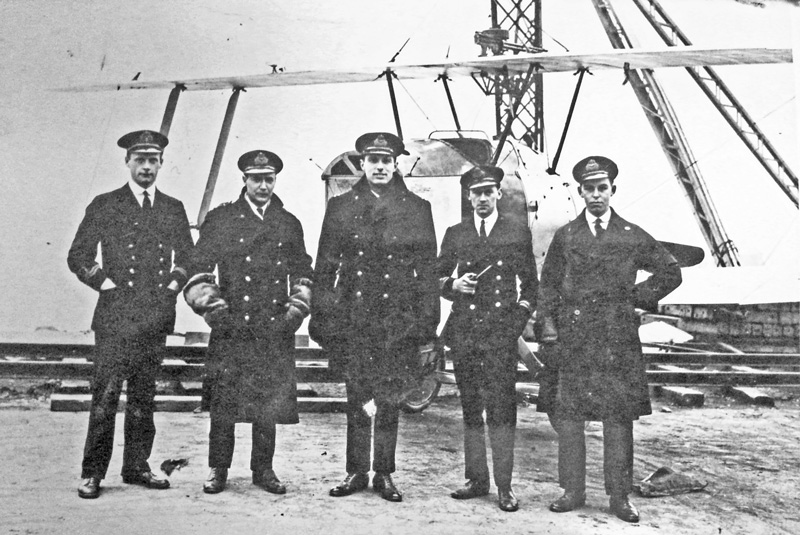
The photograph(above) of a ‘2F1 Ships Camel’ suspended from a derrick at Rosyth fully rigged but without its rear fuselage detached clearly shows the two turnbuckle re-attachment clips on the top longerons. N6606 & N6612 are the first ‘2F1 Ships Camels’ to go aboard HMS Pegasus(below), a sister ship to HMS Nairana. They are converted mail steamers with a large seaplane hangar and derricks at the stern and a sloping flying-off platform for the ‘Camels’ over the bow coming right back through the foremasts with a lift to the hangar below.

On 31st December both of these ‘Ships Camels’ make initial flights from Pegasus’ platform and both do exactly the same thing: “As soon as the tail skid leaves the guide rail the tail drops and the aircraft turn sharply right and flies off the one point (11¼o) off the stem.” These deck runs are 41 & 35 feet into a combined ship and wind speed of 21 & 25 knots and lift off takes two seconds or less.
HMS Pegasus has since 2nd September recorded 18 ‘Pup’ take-offs and since 7th November 4 ‘Folding Pup’ take-offs typically taking 3 to 4 seconds with runs of between 45 and the full 70 feet. On the only two ‘Pup’ runs under 40 feet it is noted that the tail drops appreciably before picking up.
The Sopwith factory has delivered 74 aircraft in December all ‘Dolphins’, bringing their total output for 1917 to 849 machines, more than twice their 374 in 1916 and bringing the total number built in Kingston so far to 1,462. These totals now include the prototypes built in 1917 including two Camel floatplanes, B1, T1, Hippo, Rhino, Bulldog, four Dolphin and four Snipe.
The number of new Sopwith-designed aircraft from other suppliers in December is 380 bringing the total number of contractor-built machines in 1917 to 2,902, three and a half times the number built by Sopwith themselves.
The 380 machines from other manufacturers in December include 132 ‘Pups’ from Standard Motors (55) and Whitehead (77); 26 ‘SBIII Folding Pups’ from Beardmore; 1 ‘Triplane’ from Oakley; 206 ‘Camels’ from Boulton & Paul (65), British Caudron (6), Clayton and Shuttleworth (26), Hooper (19), Portholme (11) & Ruston Proctor (79). There are also 11 ‘Baby’ floatplanes from Blackburn in December, the last 4 ‘Hamble Baby’ floatplanes from Fairey plus 4 from Parnall and 22 ‘Hamble Baby Convert’ landplanes from Parnall. These figures again exclude ‘Strutters’ still being built in large numbers overseas.
The doubling of Sopwith’s own output and this high-volume contractor manufacture brings the number of Sopwith aircraft built in 1917 to 3,751, more than six times the 594 built in 1916 and 72% of all the 5,200 Sopwith-designed aircraft built since the company was formed late in 1912.
The contractors to have built the most Sopwith machines are Ruston Proctor with 350 Strutters and 398 Camels, Standard Motors with 478 ‘Pups’ and Whitehead with 350 ‘Pups’. None of the other 18 has yet reached 200.
New orders for Sopwith aircraft in December include 200 more ‘Pups’ from Whitehead and 500 more ‘Camels’: 200 from Ruston Proctor, 150 from Boulton and Paul, 100 from Clayton and Shuttleworth with 50 from Portholme. These bring total ‘Pup’ orders to 2,066 including 100 ‘SBIII Folding Pups’, total ‘Camel’ orders so far to 2,908 and total ‘Dolphin orders so far to 1,104. From those total orders 1,061 ‘Pups’, 1,525 ‘Camels and 979 ‘Dolphins’ are still to be delivered going into 1918.
Of the 5,200 Sopwith-designed aircraft built so far many hundreds of ‘Pups’ and ’Camels are in service going into 1918 but only 22 of the 156 ‘Triplanes’ survive and just 227 of 1,383 British-built ‘Strutters’. Only 17 of the 236 ‘Schneider/Baby’ floatplanes originally built by Sopwith have survived but 206 of the 299 ‘Baby’ and ‘Fairey Hamble Baby’ more recently built by Blackburn, Fairey and Parnall are in service. These little workhorses are scattered around twenty-two RNAS stations in the UK, France, Italy, Egypt, Macedonia and the Aegean.
This concludes the diary of the Sopwith Aviation Company through 1917
Similar diaries for 1918, 1919 and 1920 can be found on this website under “Sopwith day by Day”
Photographs & drawings courtesy of Brooklands Museum, RAF Museum, Fleet Air Arm Museum, National Archives, Cross & Cockade and private collections of Mike Goodall, Philip Jarrett and others

